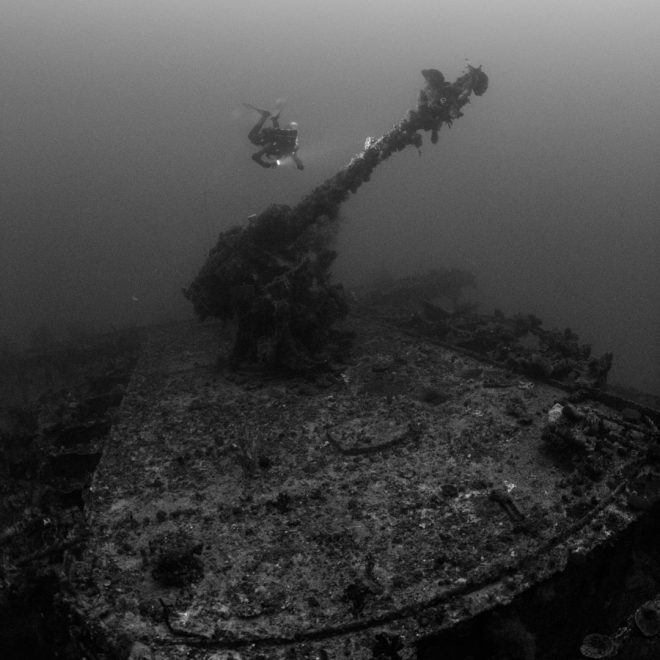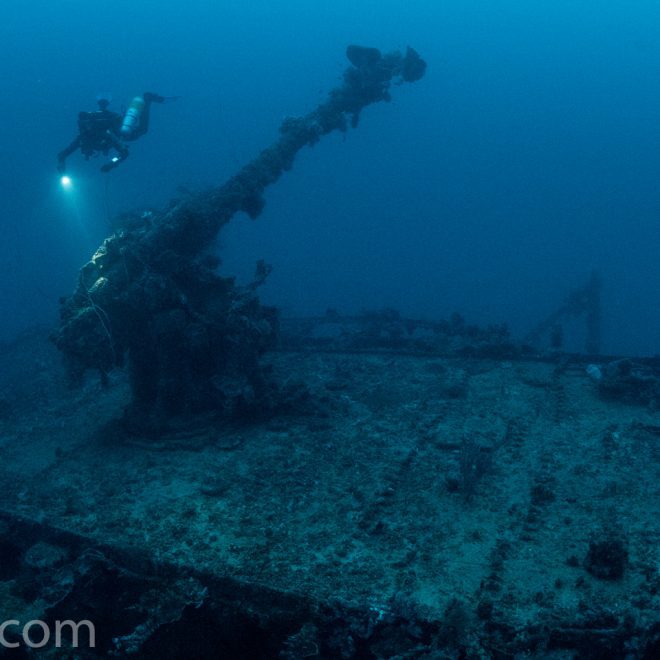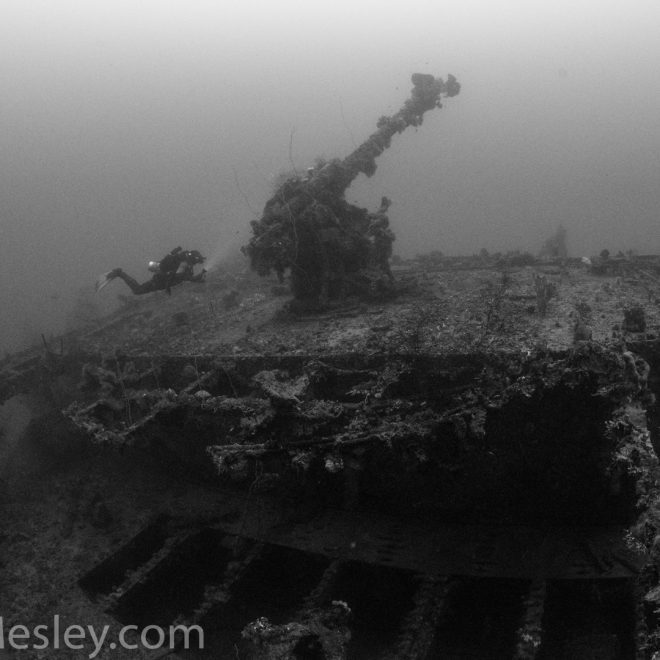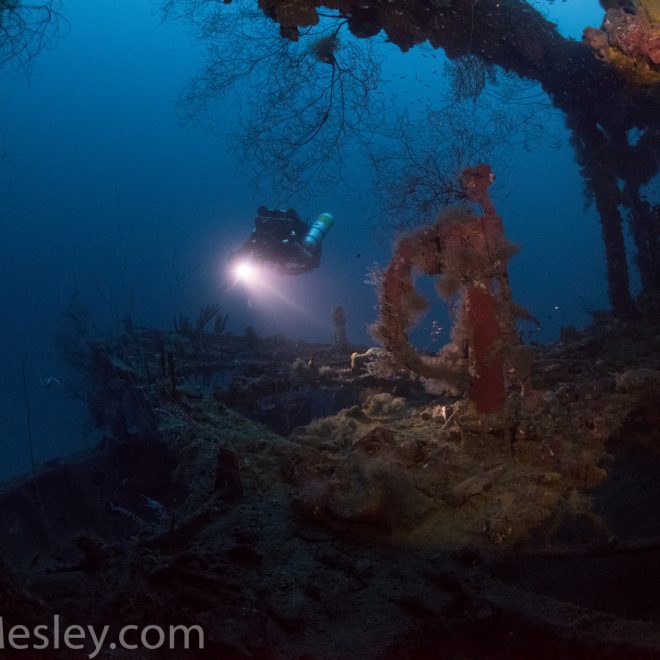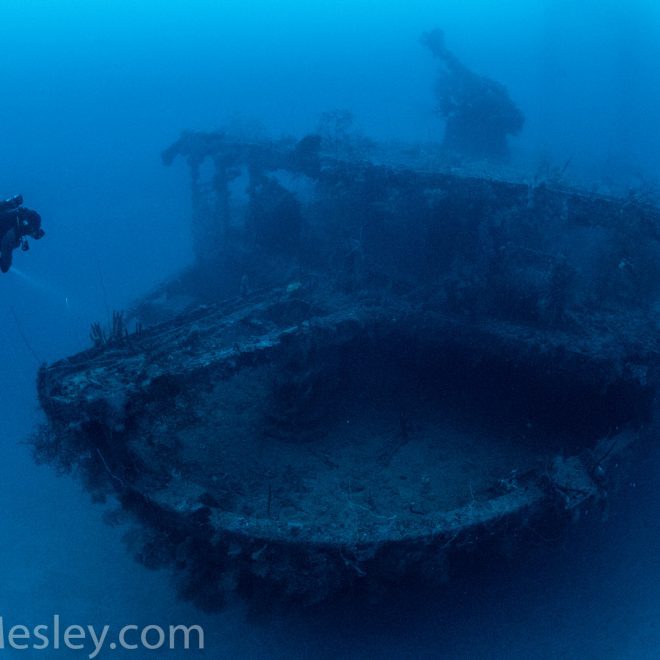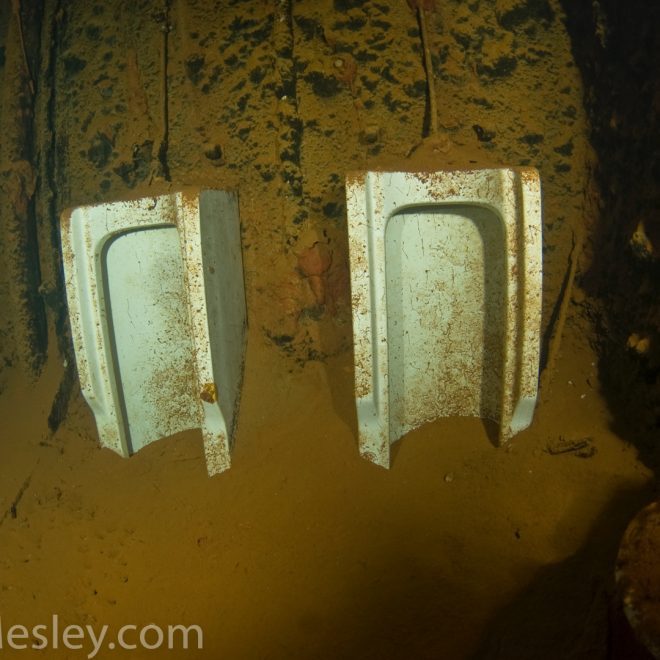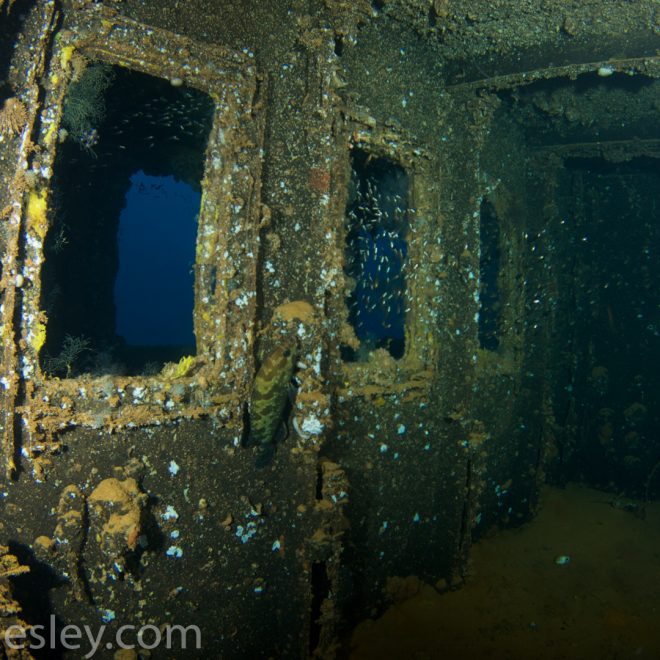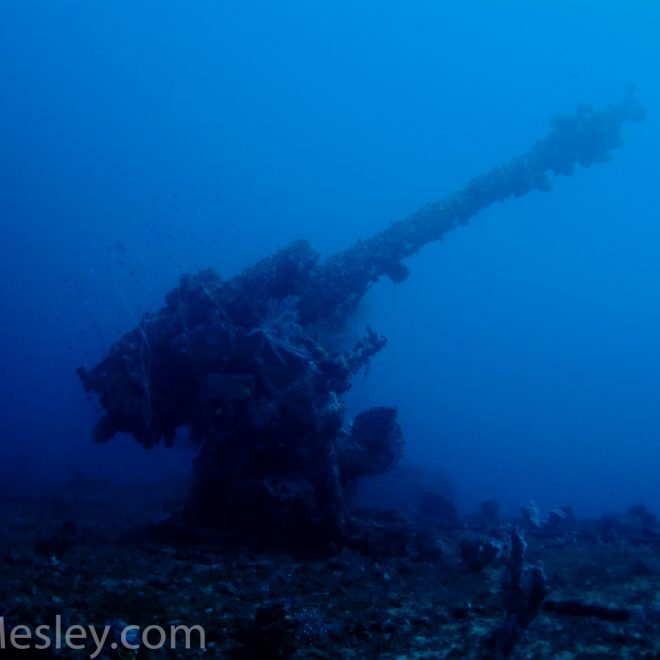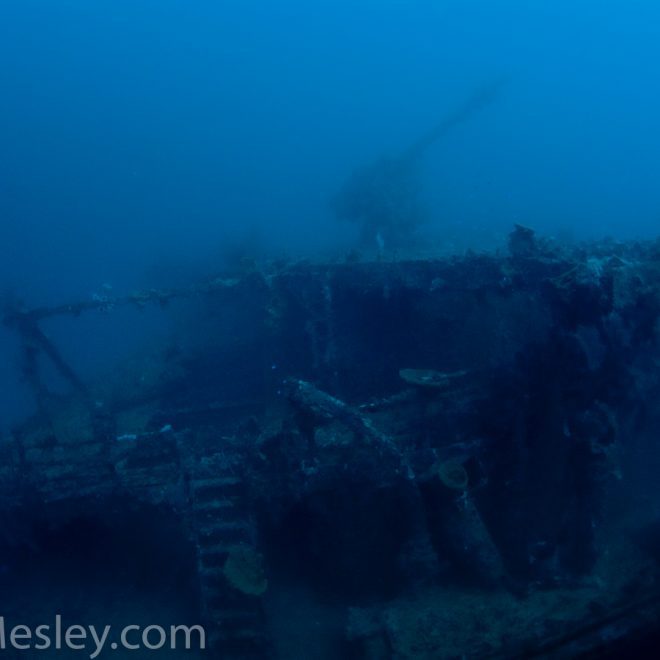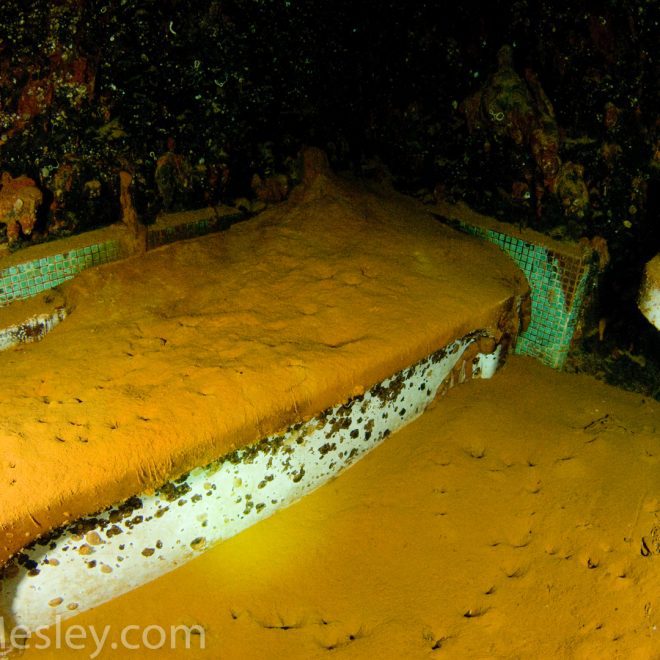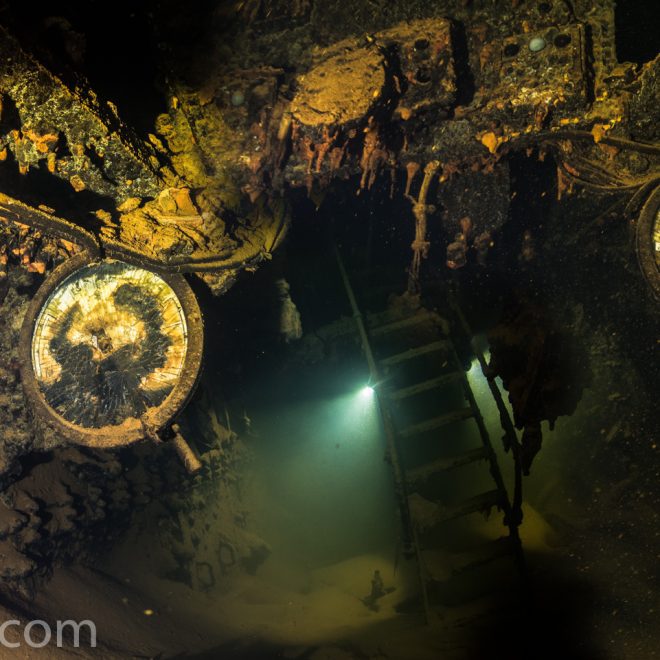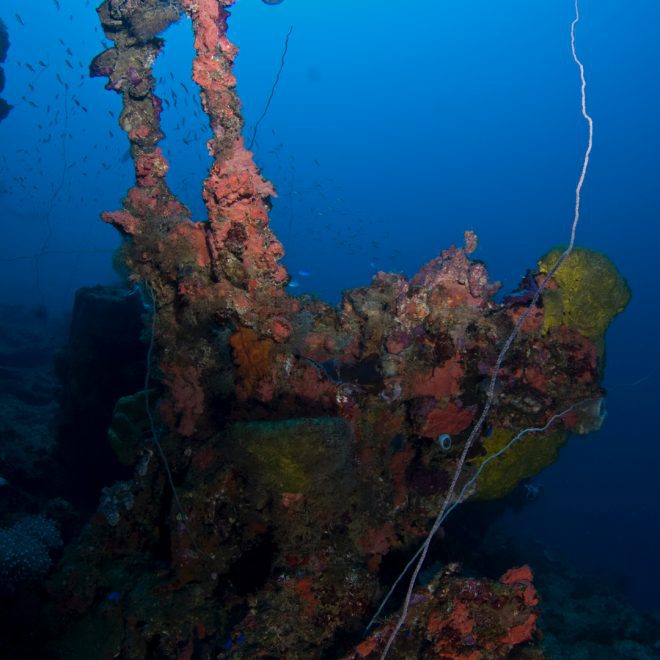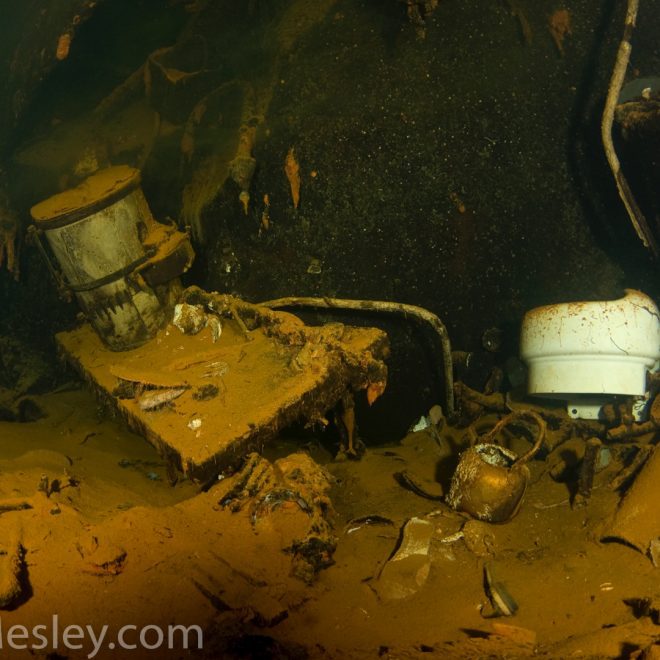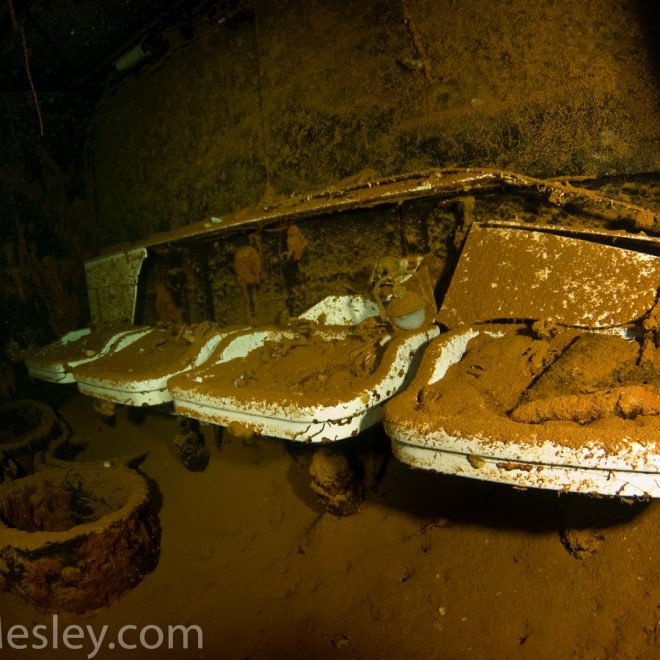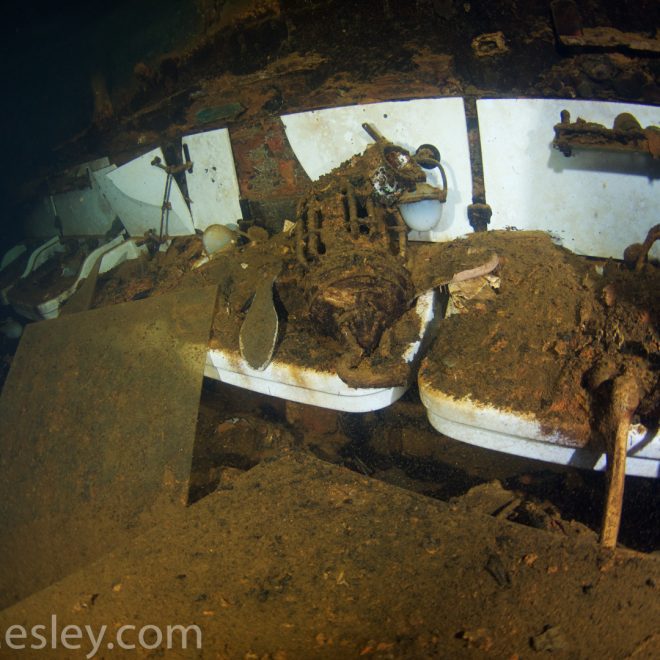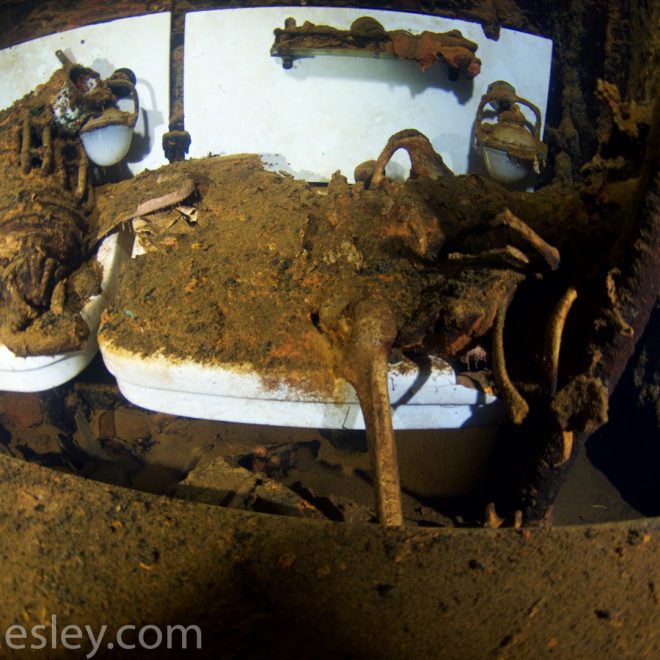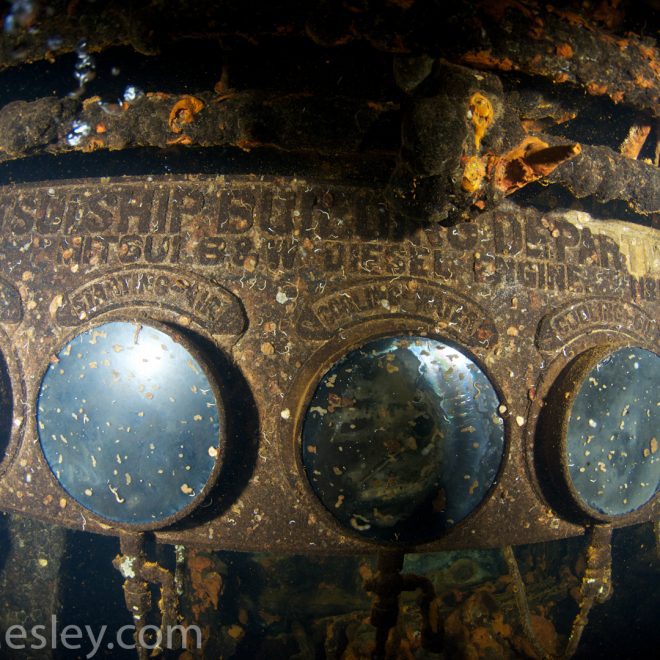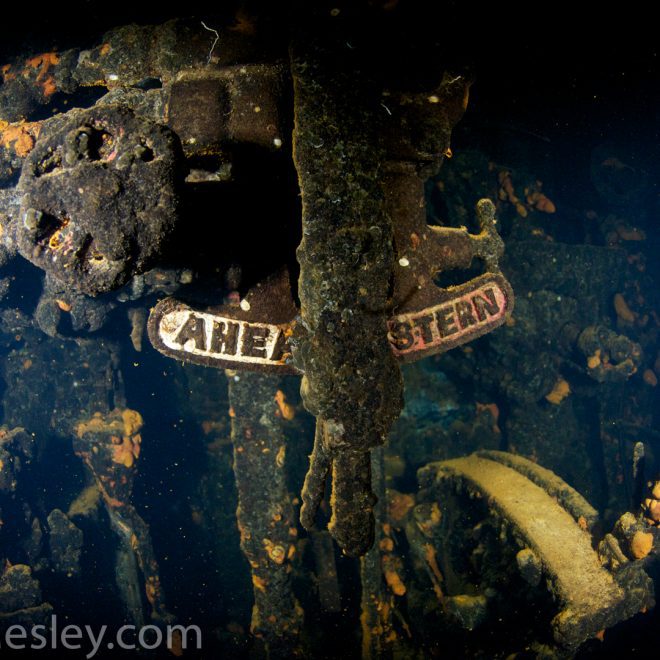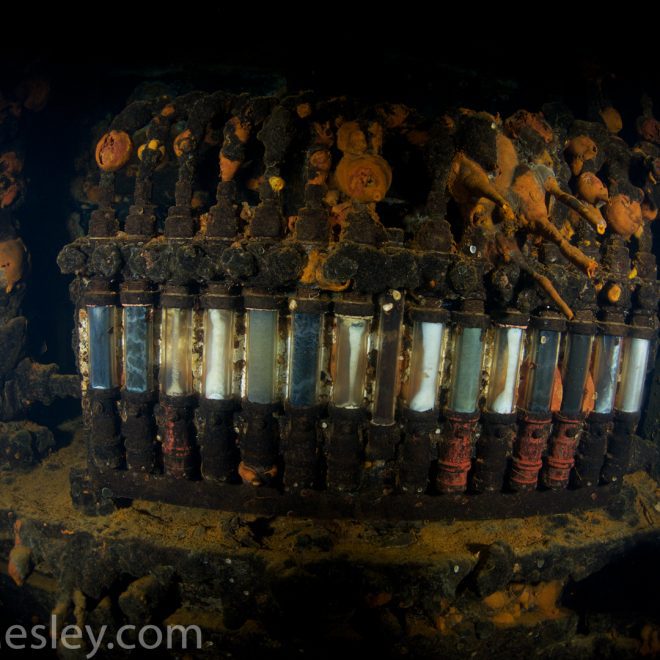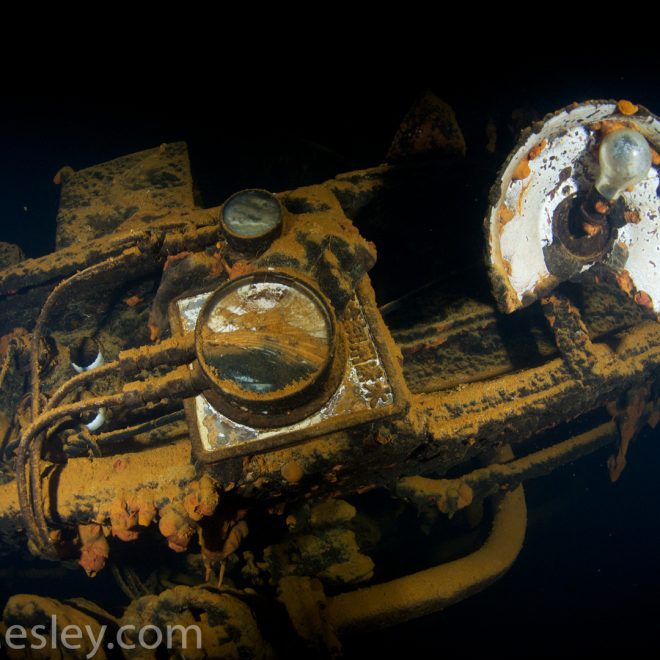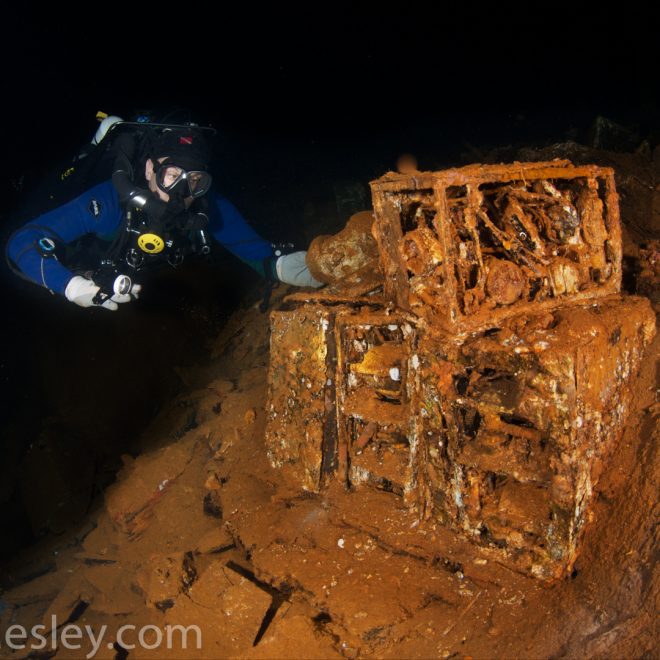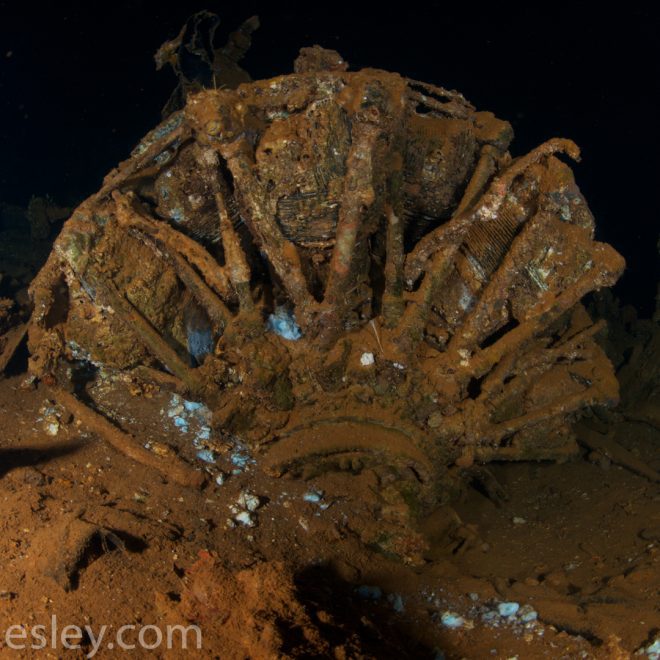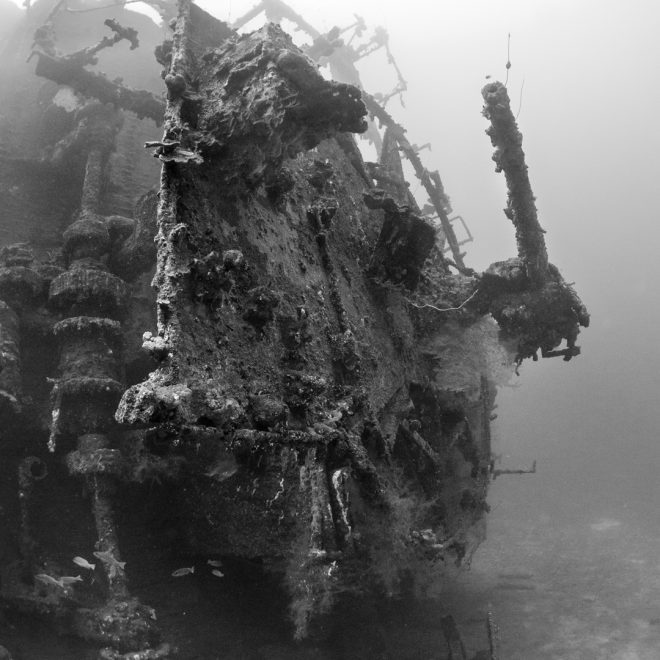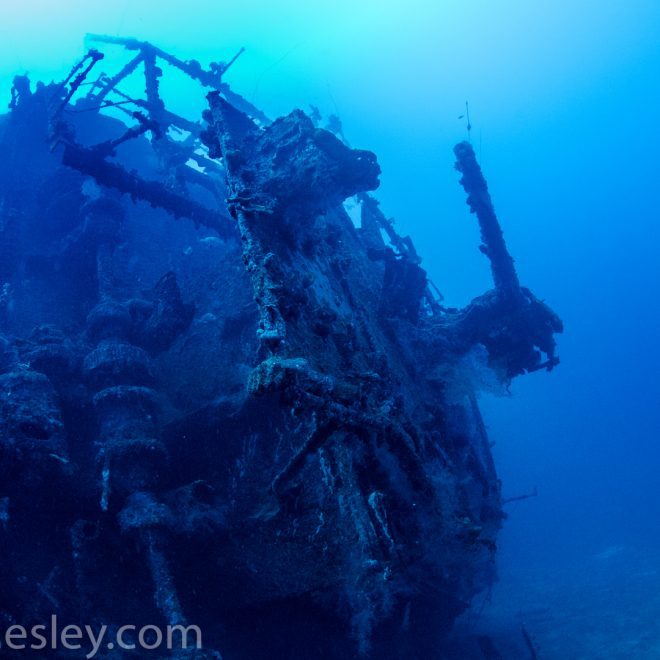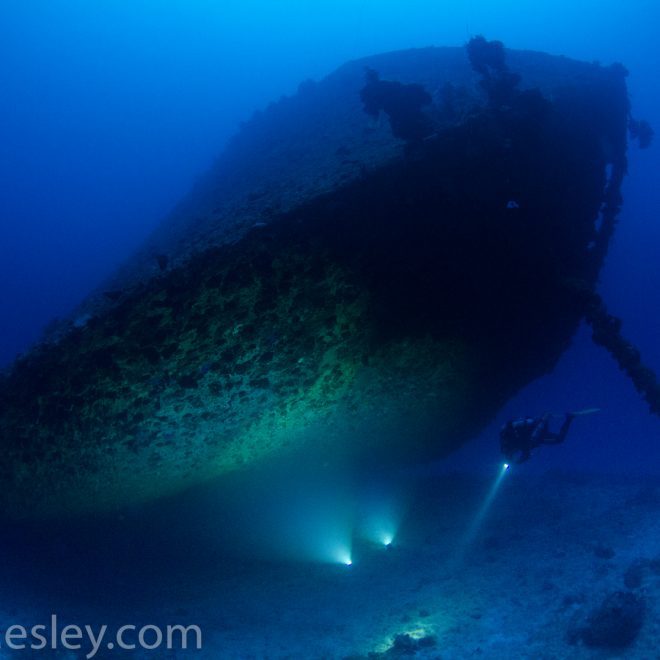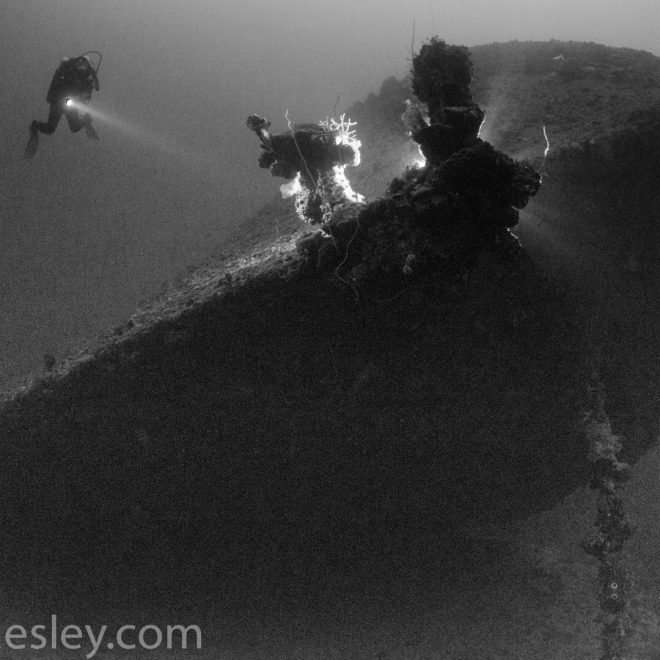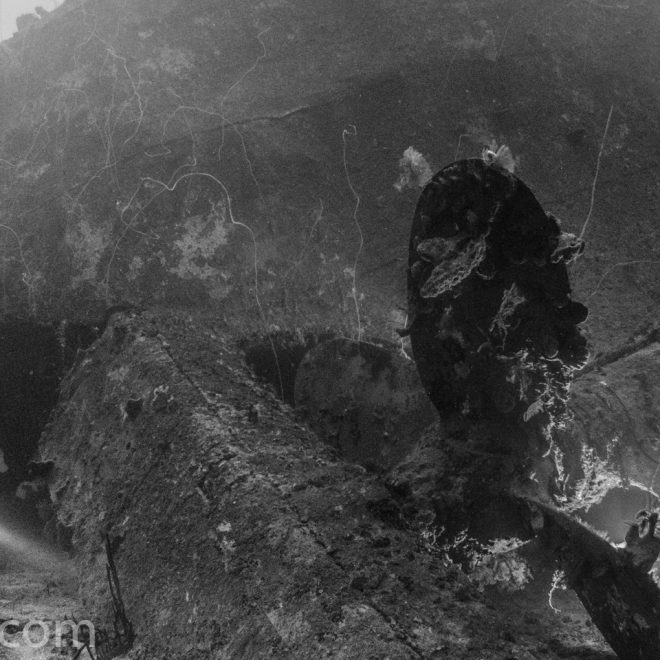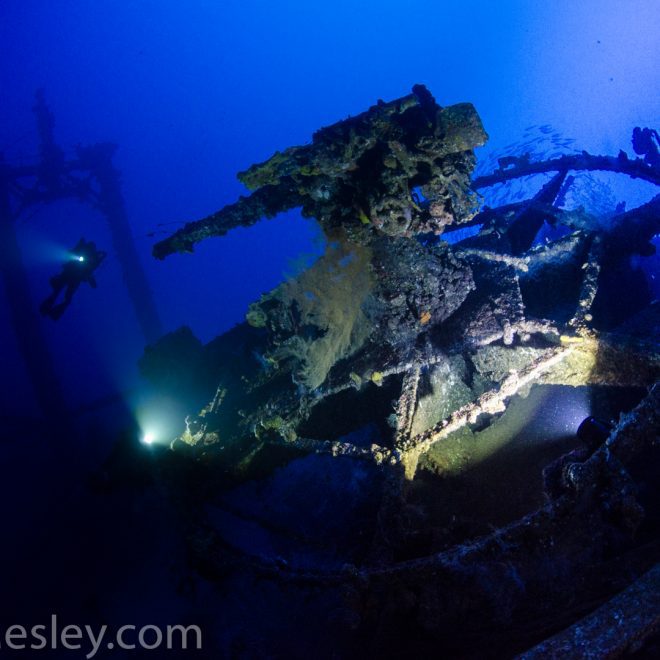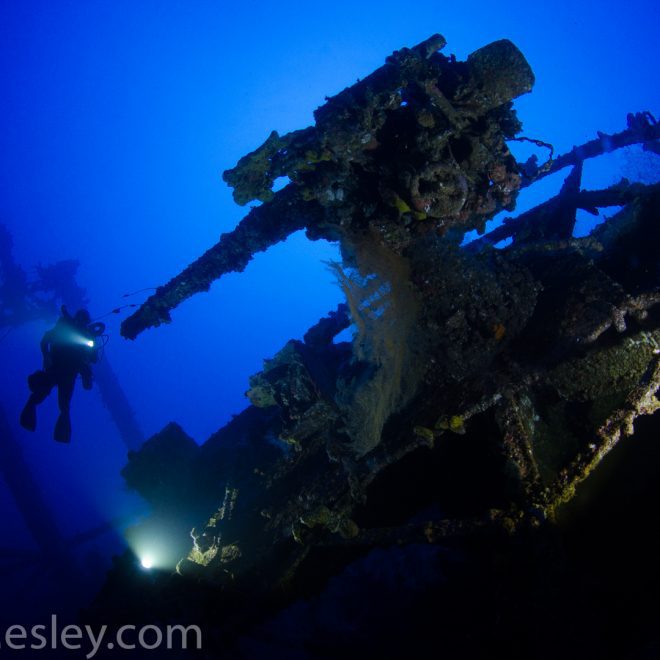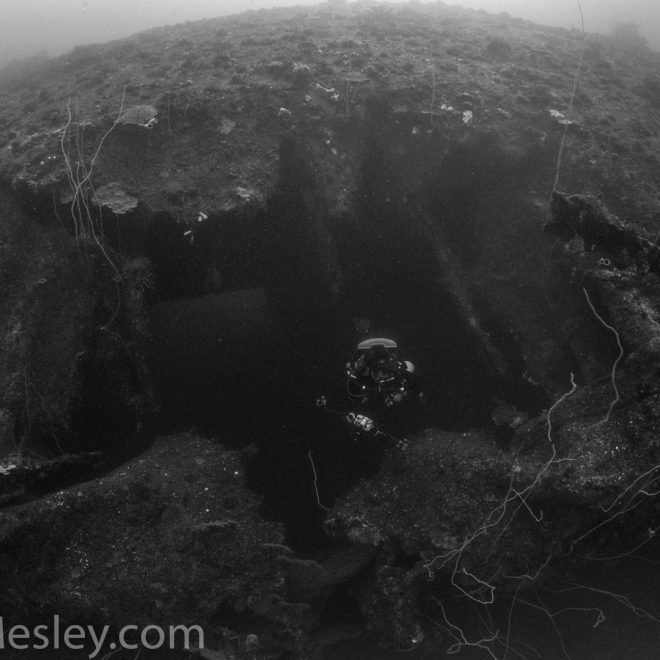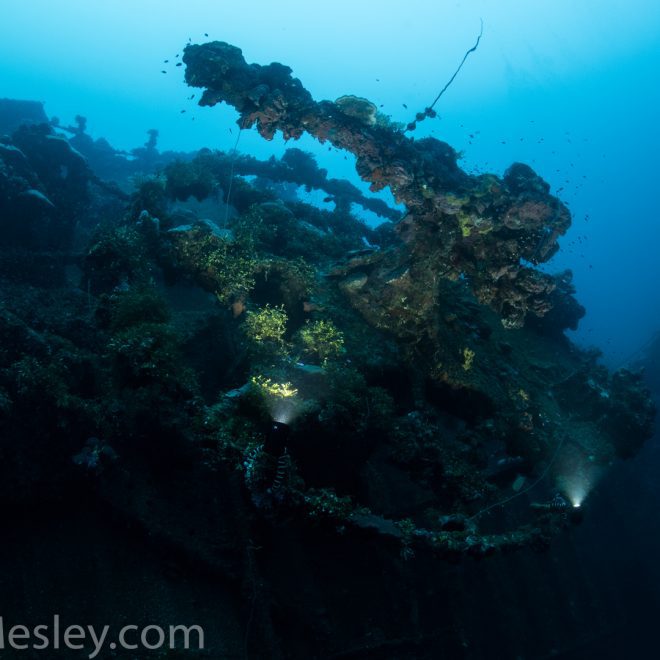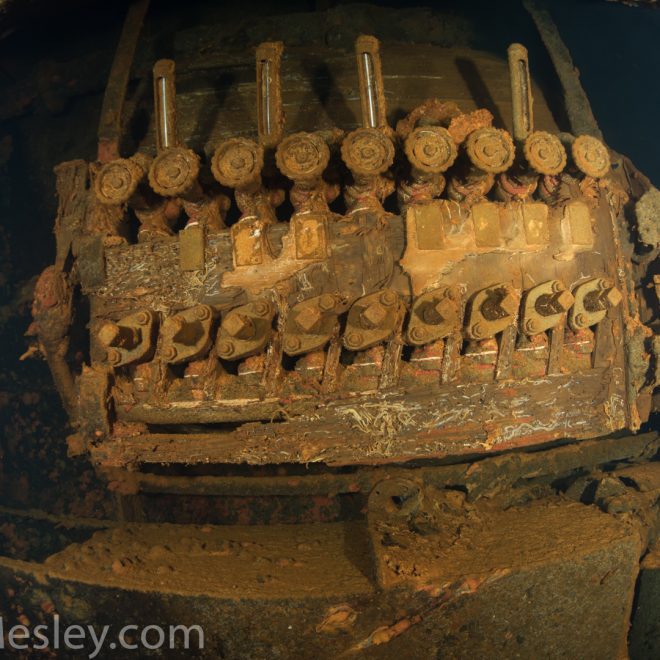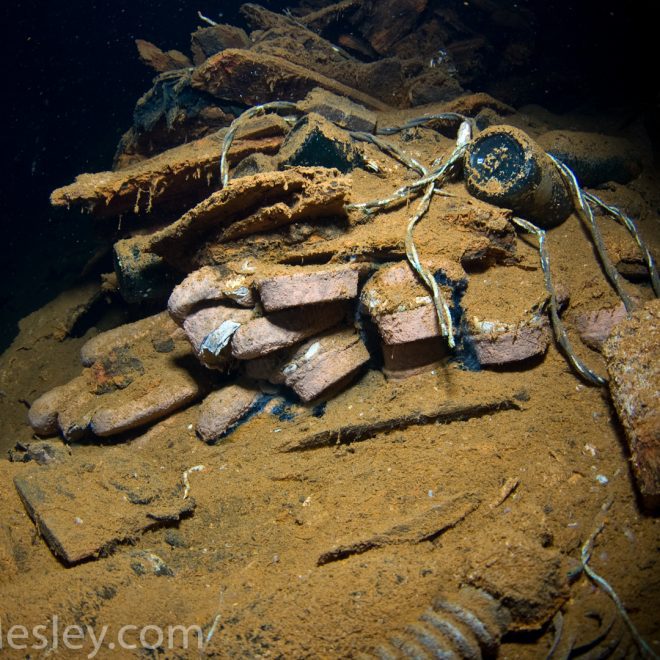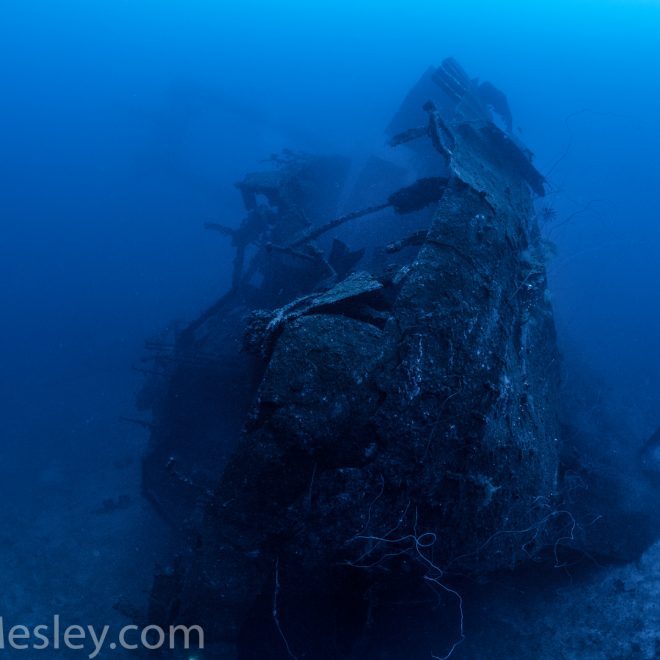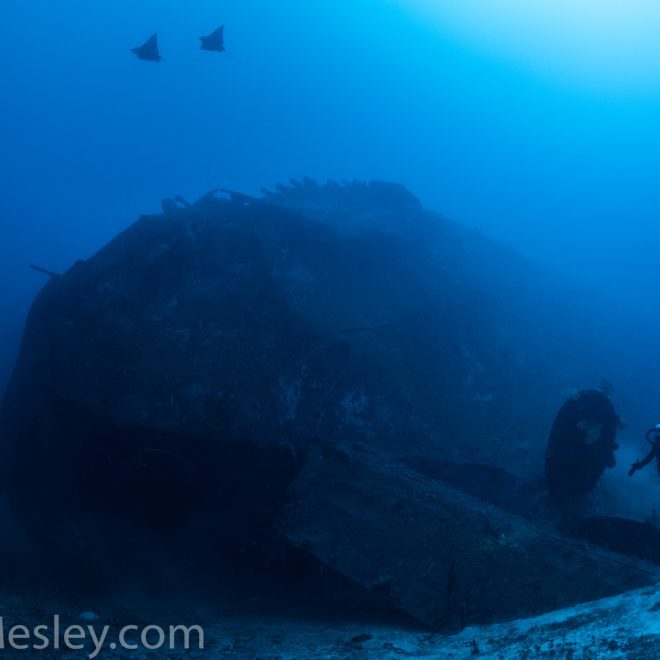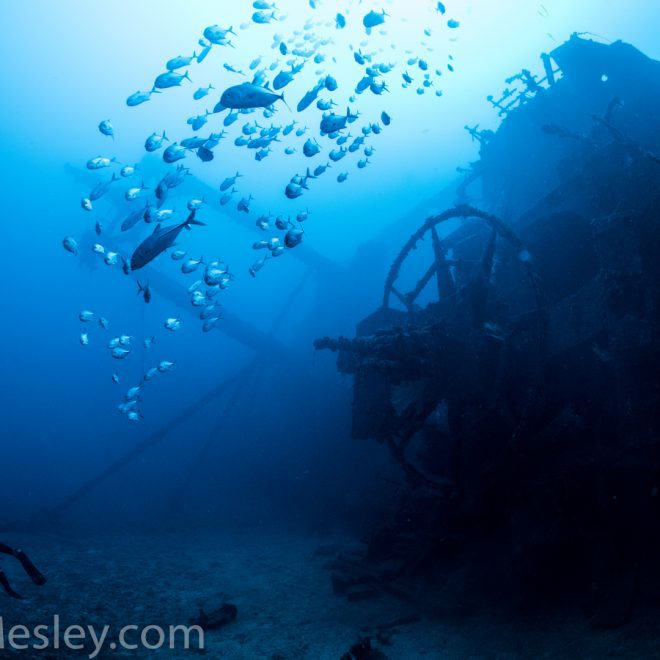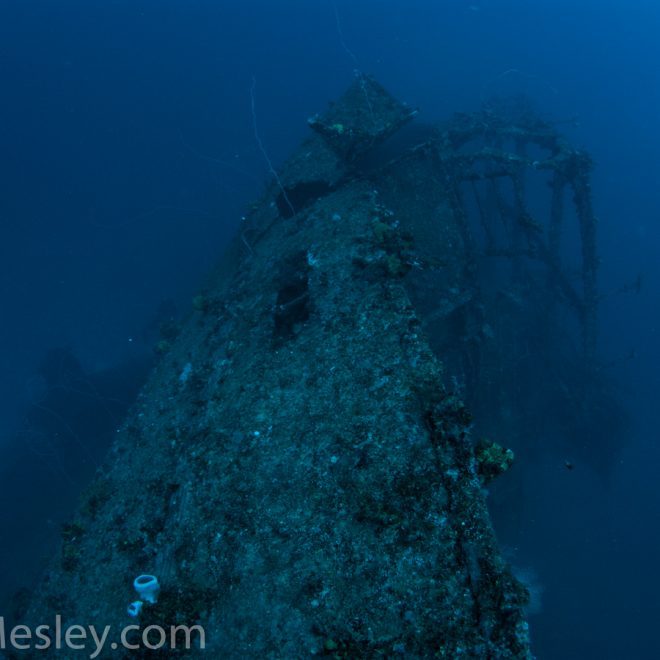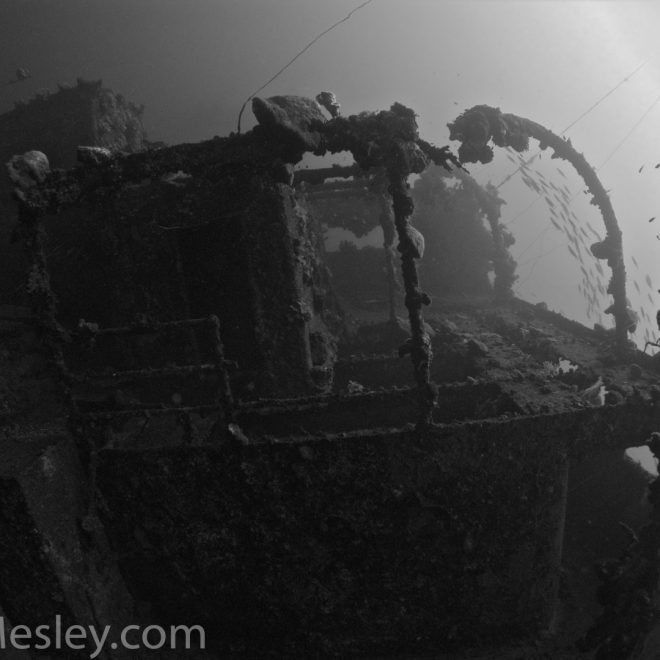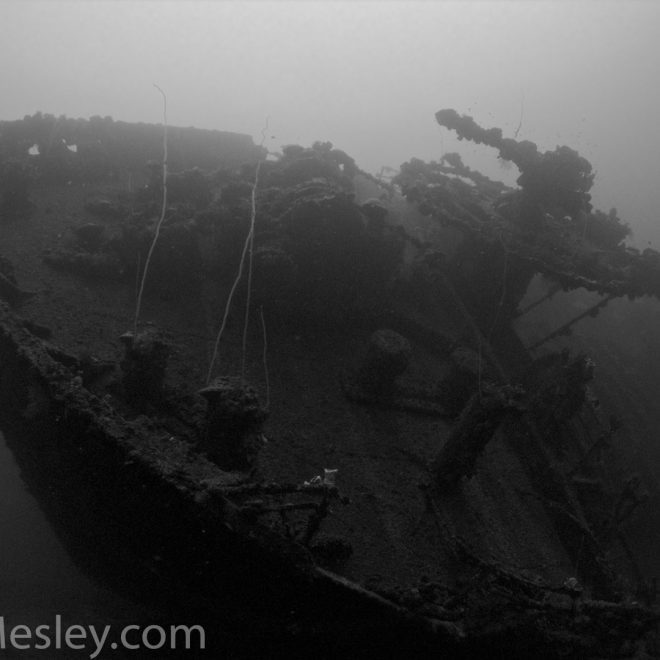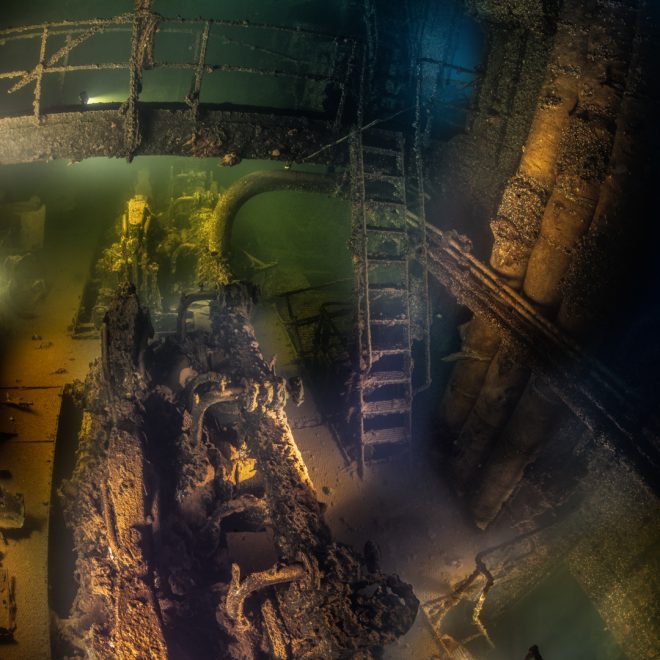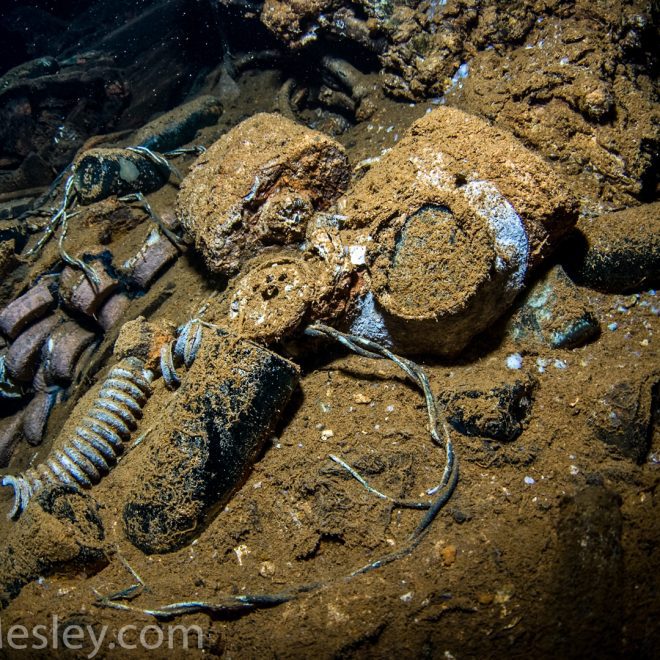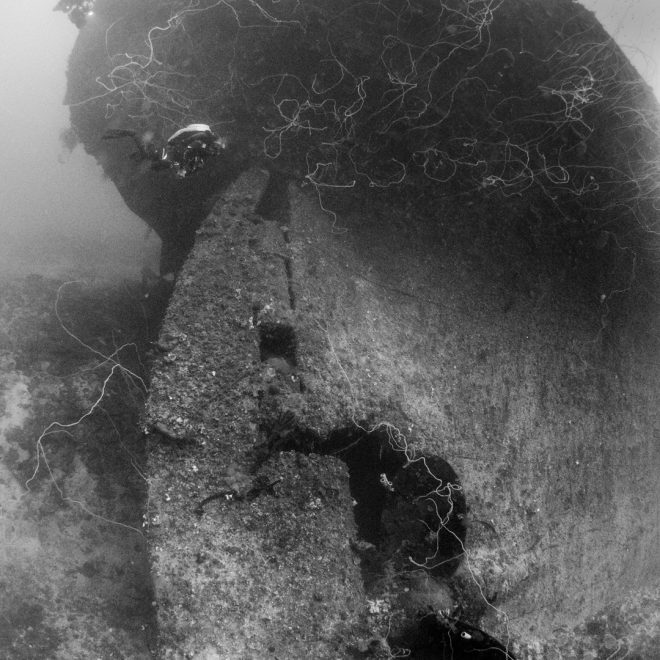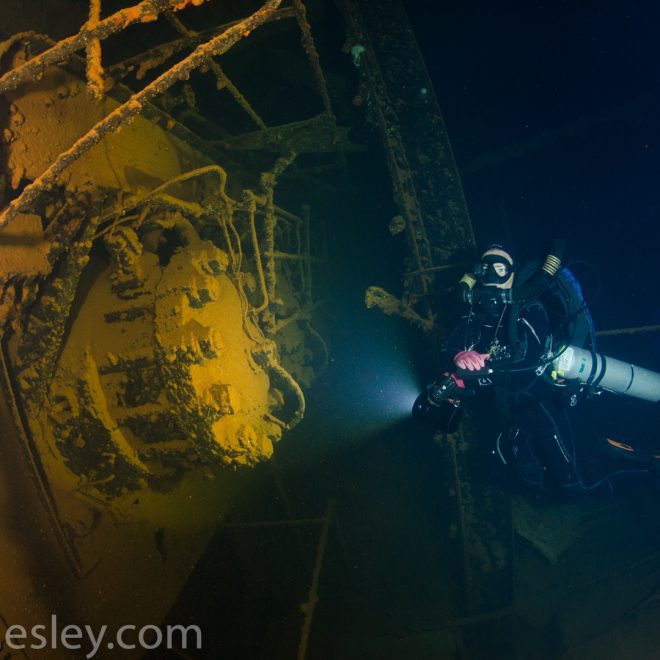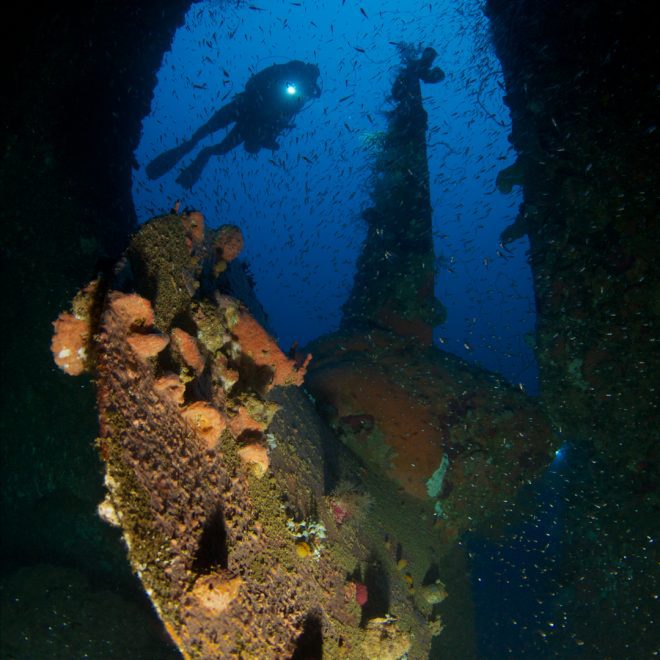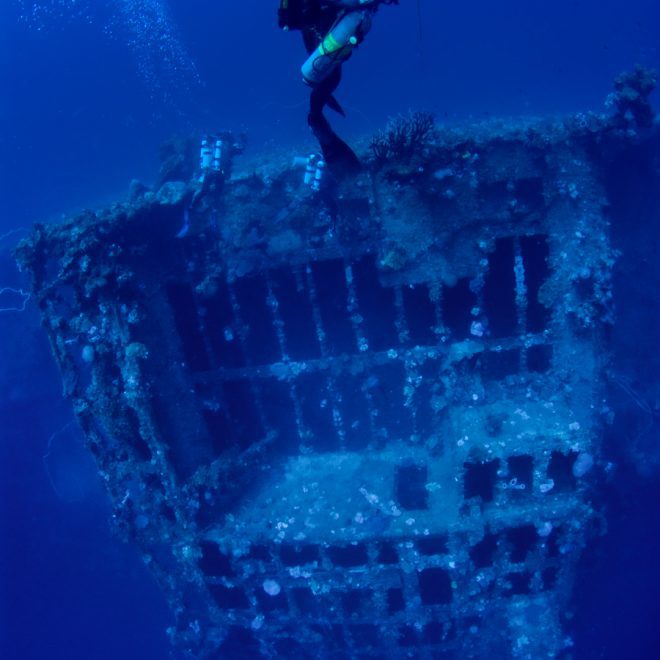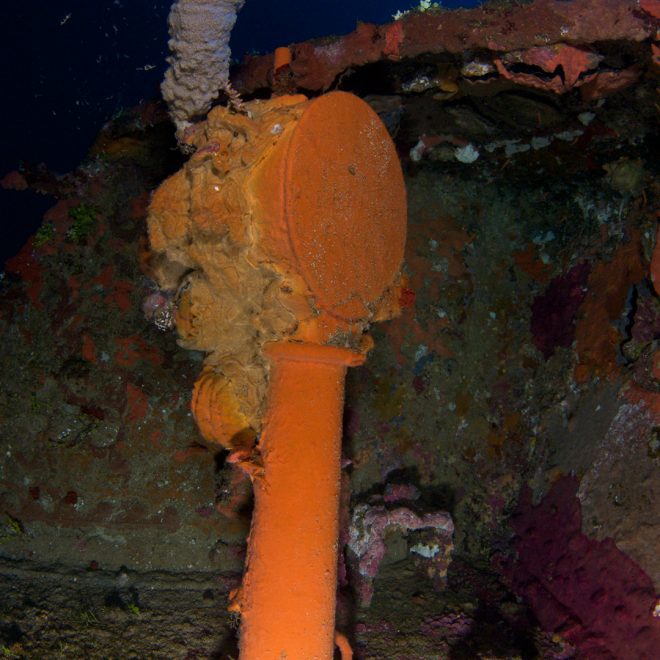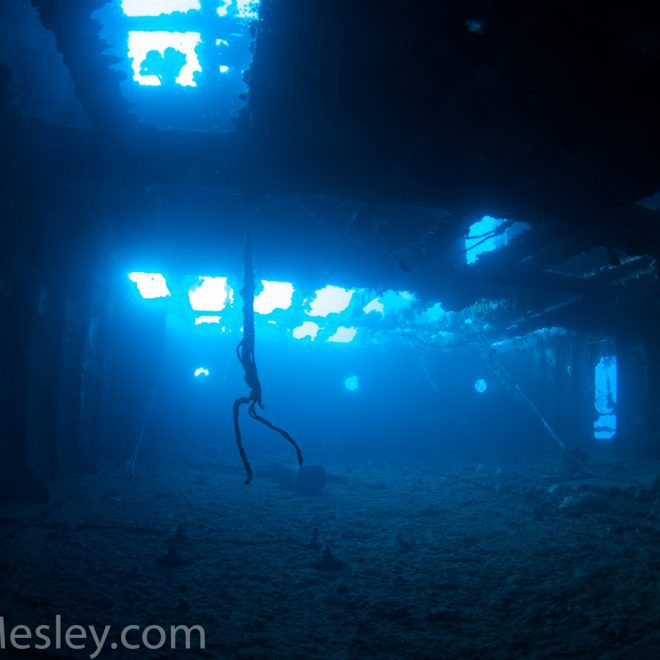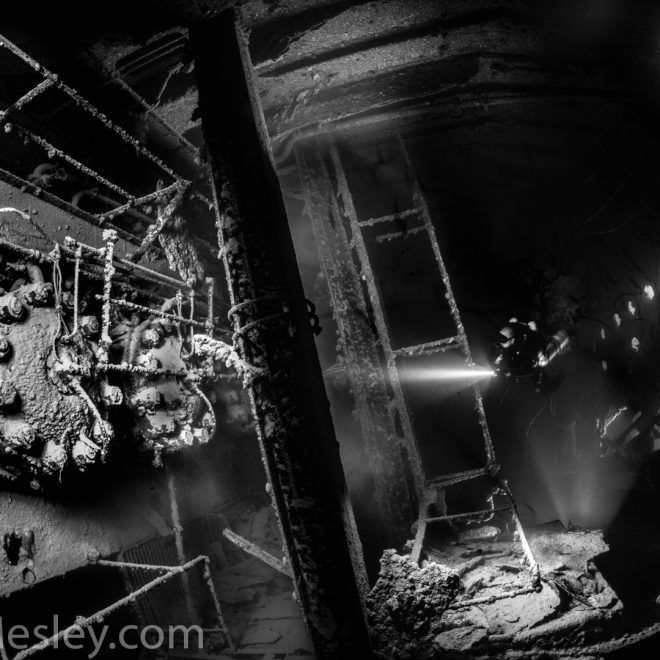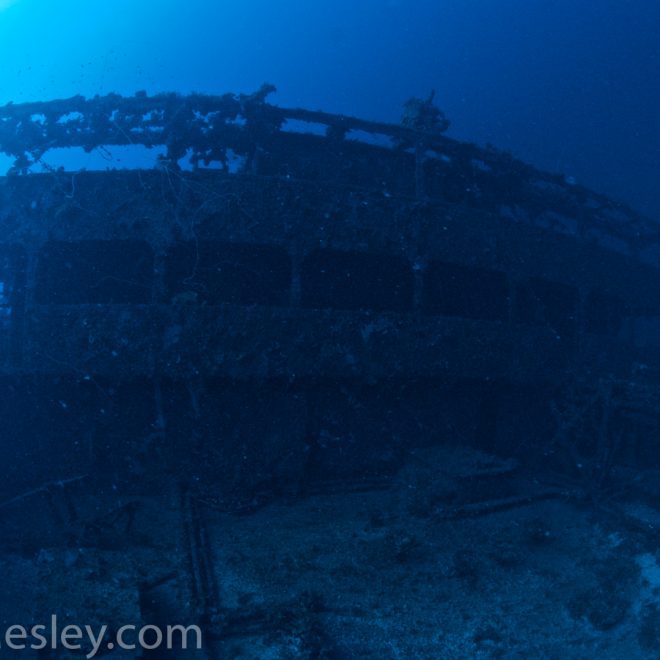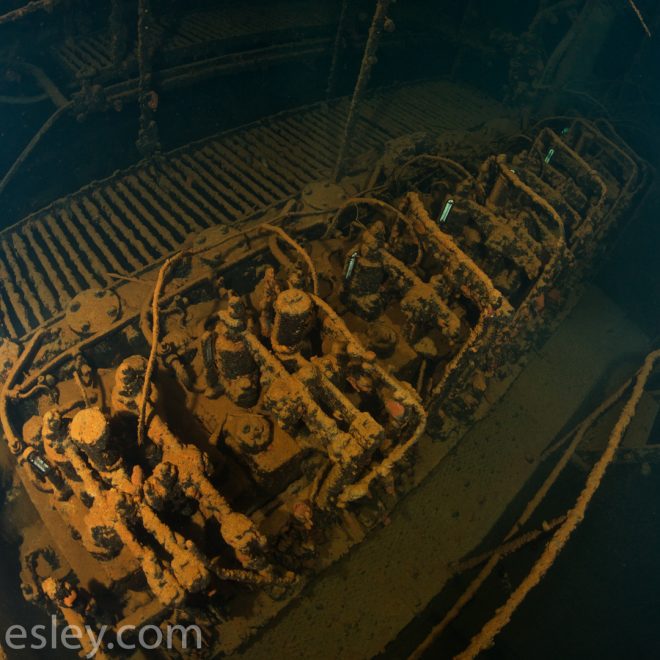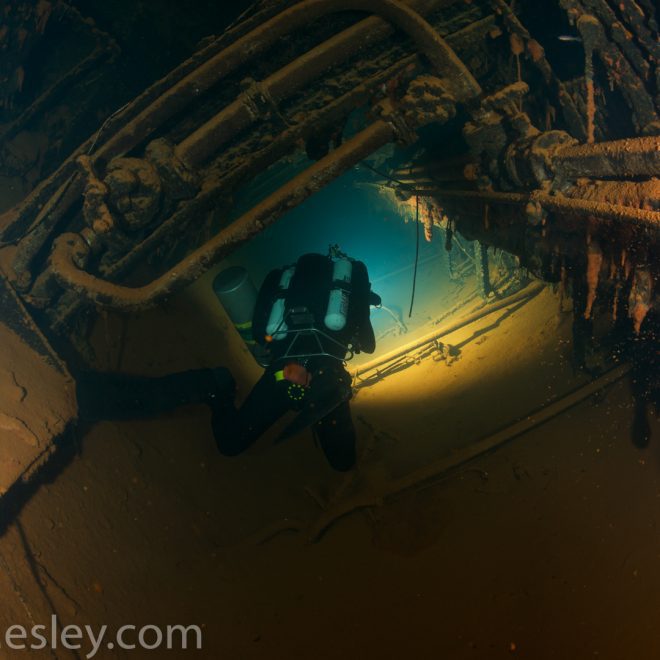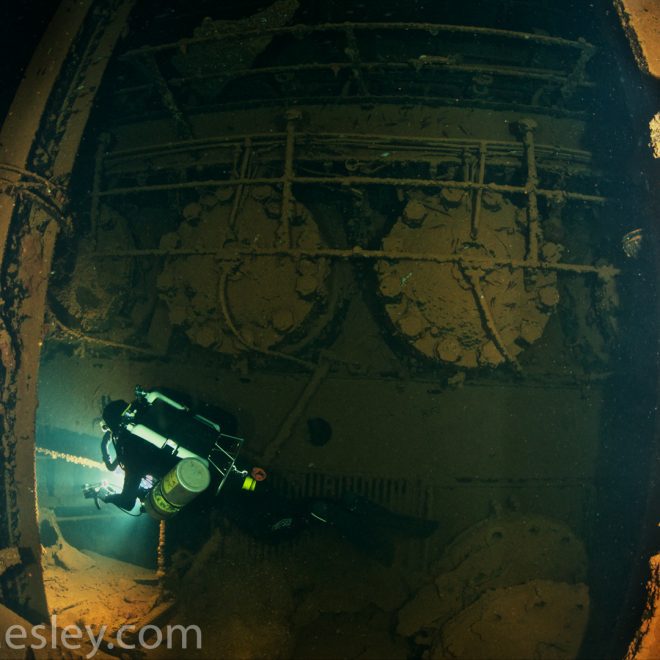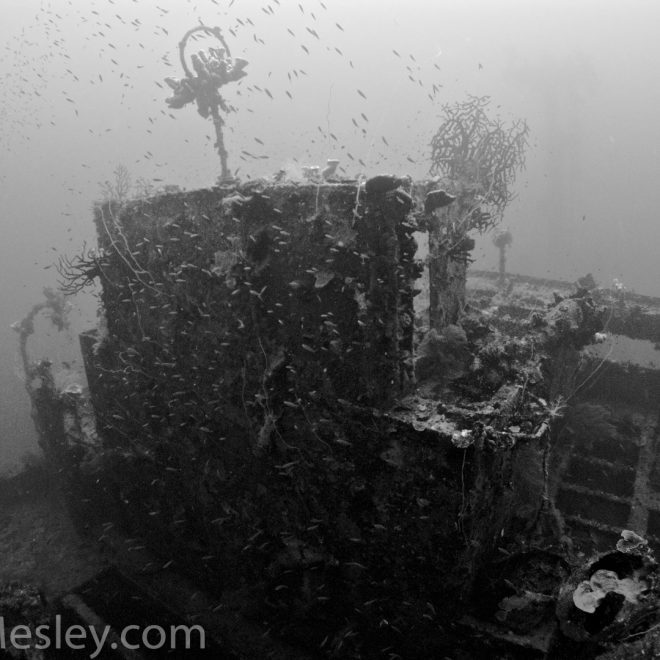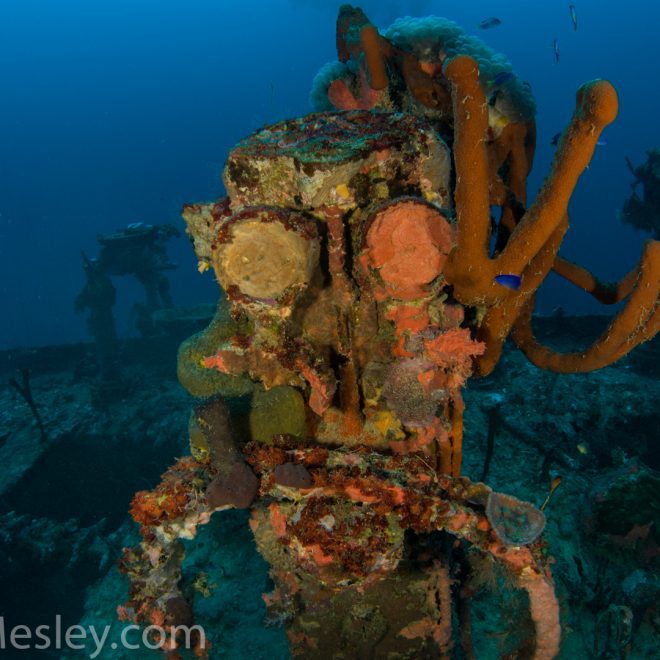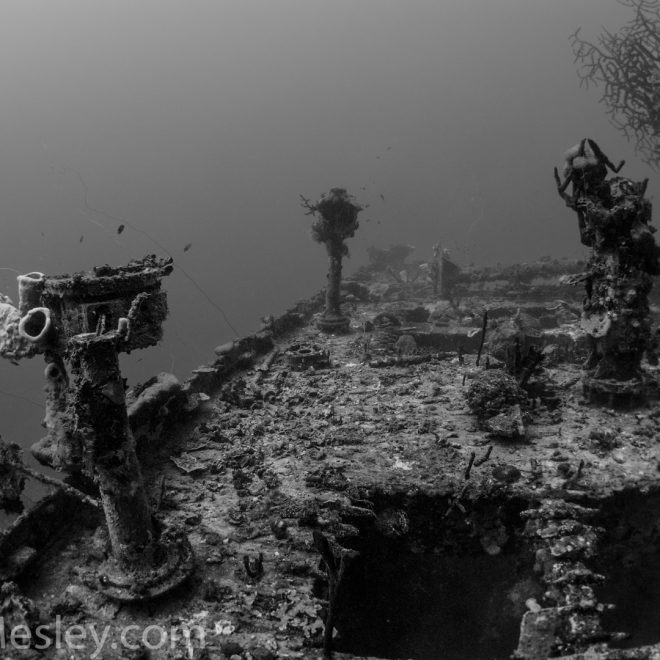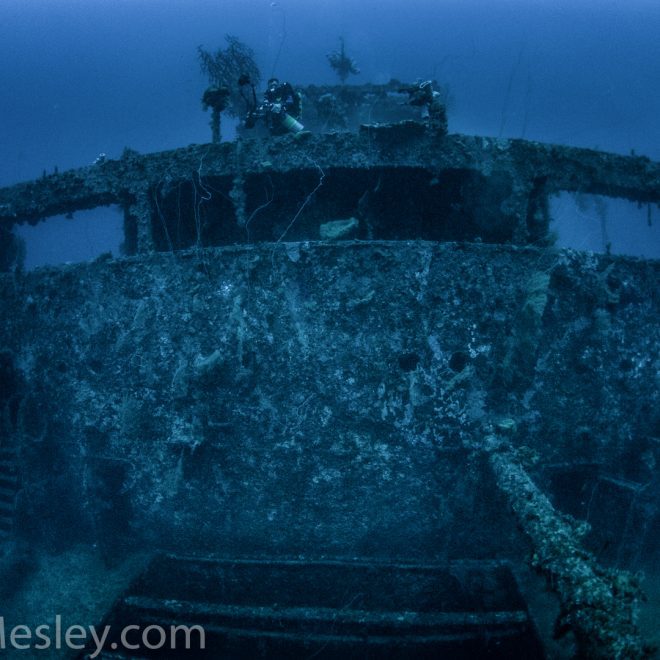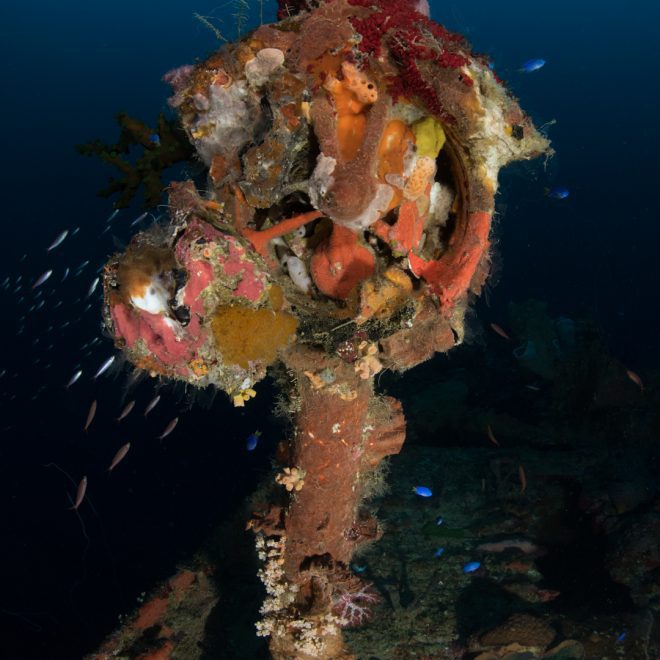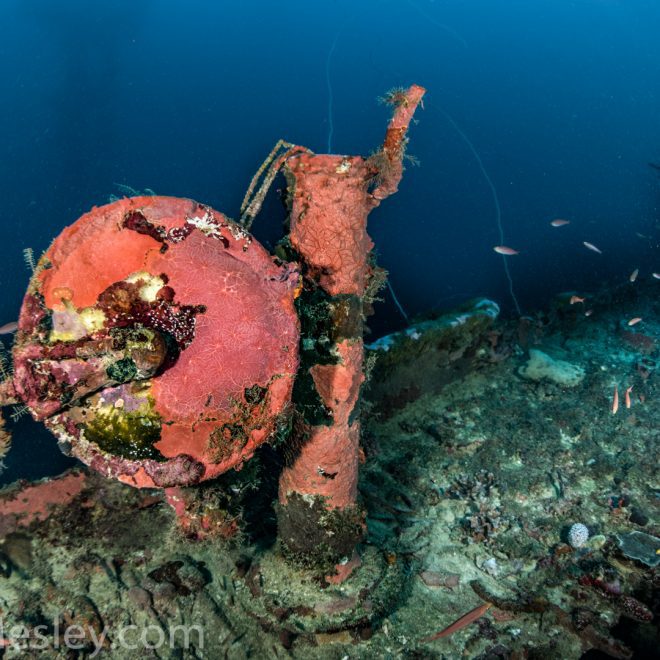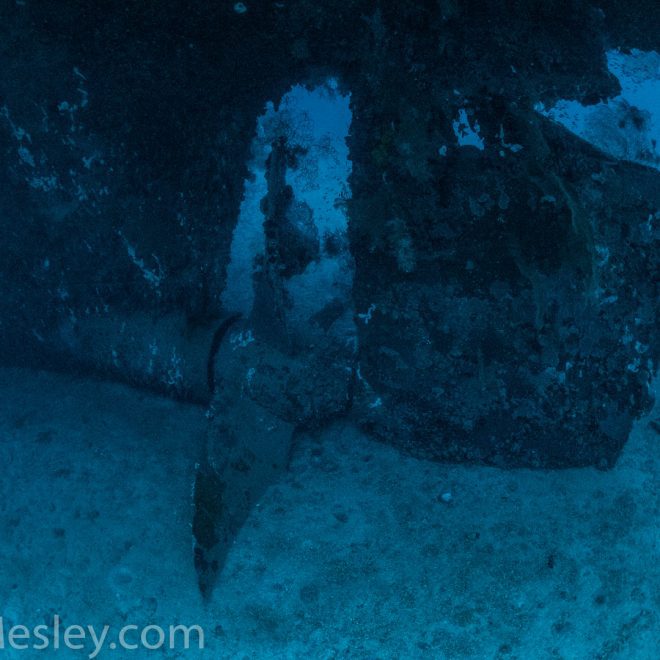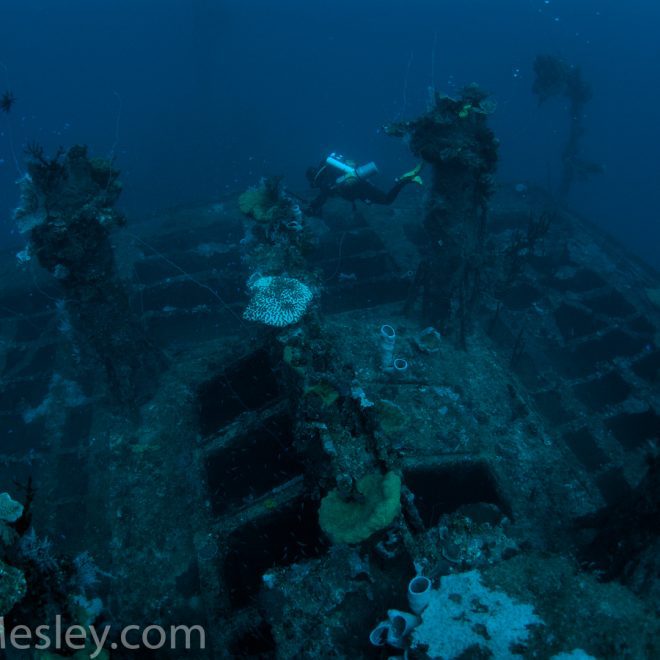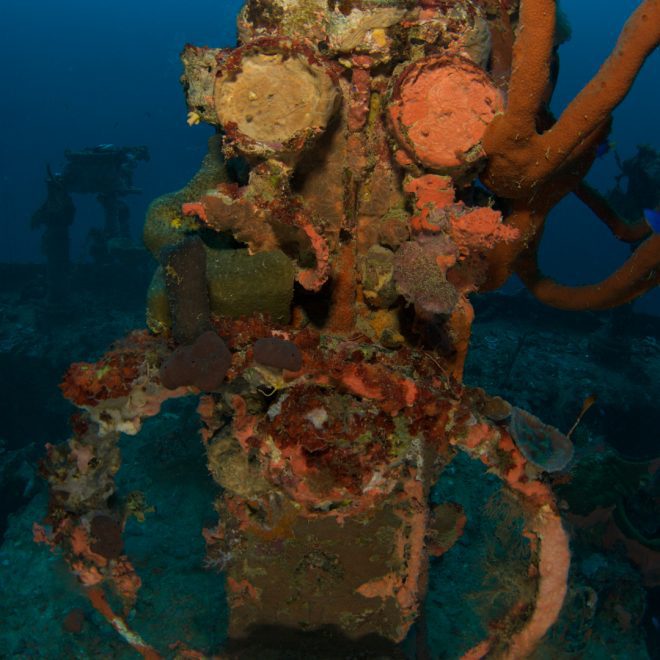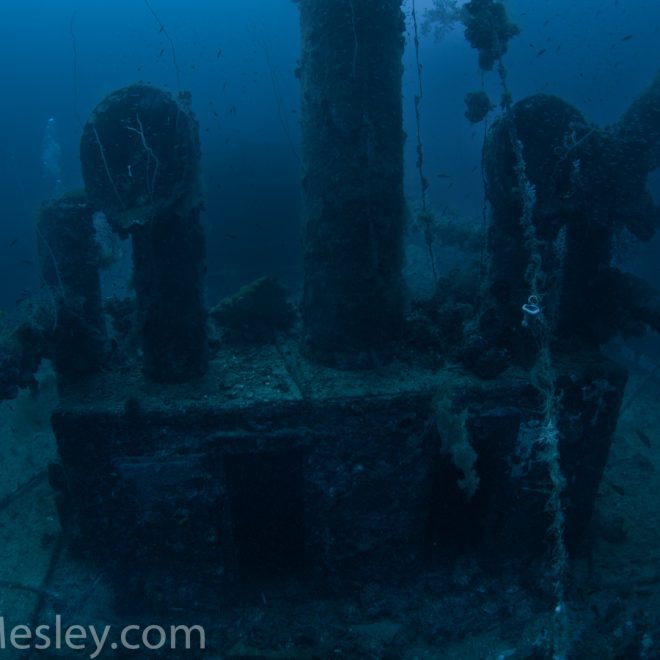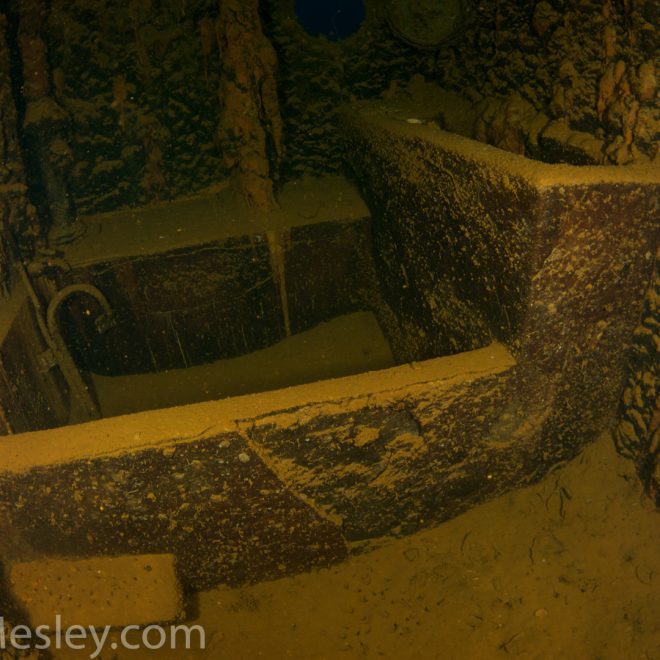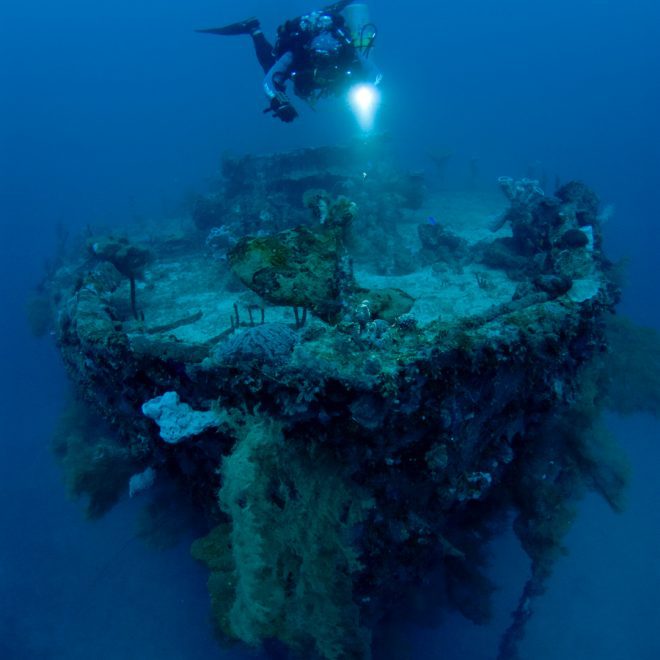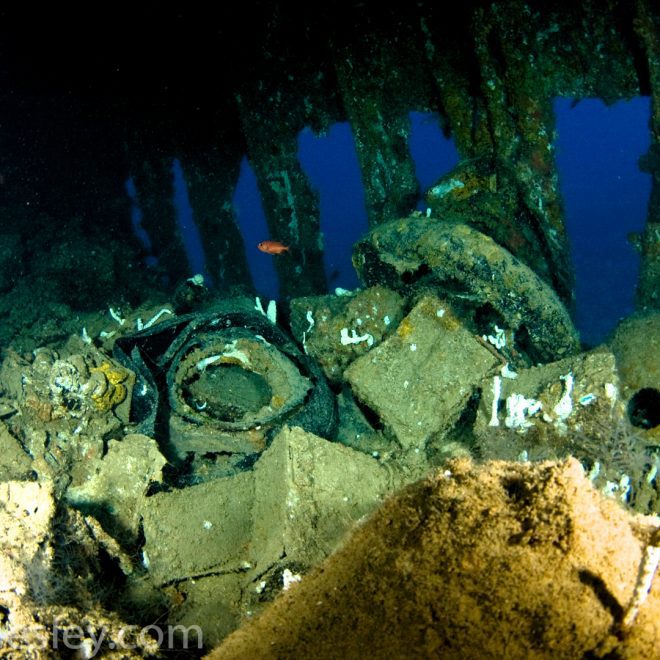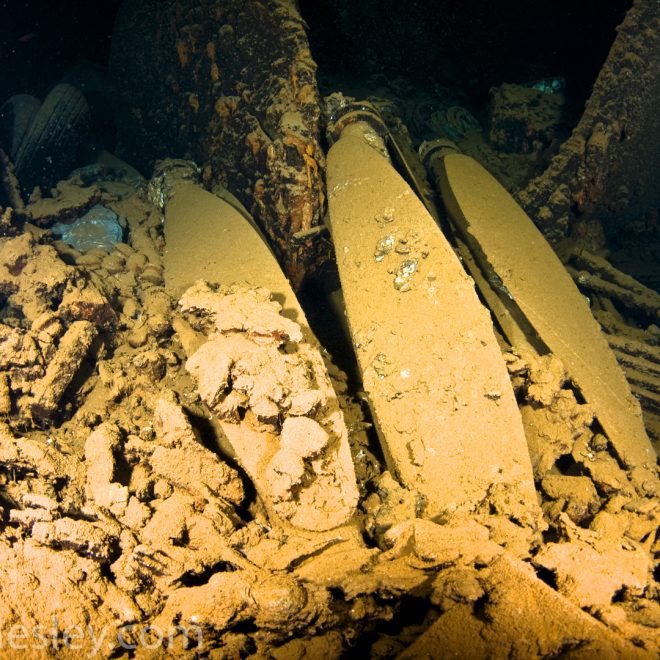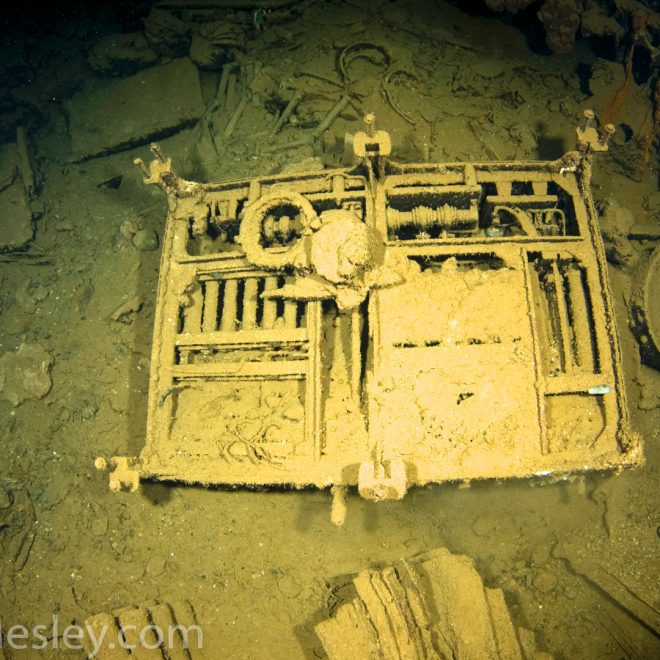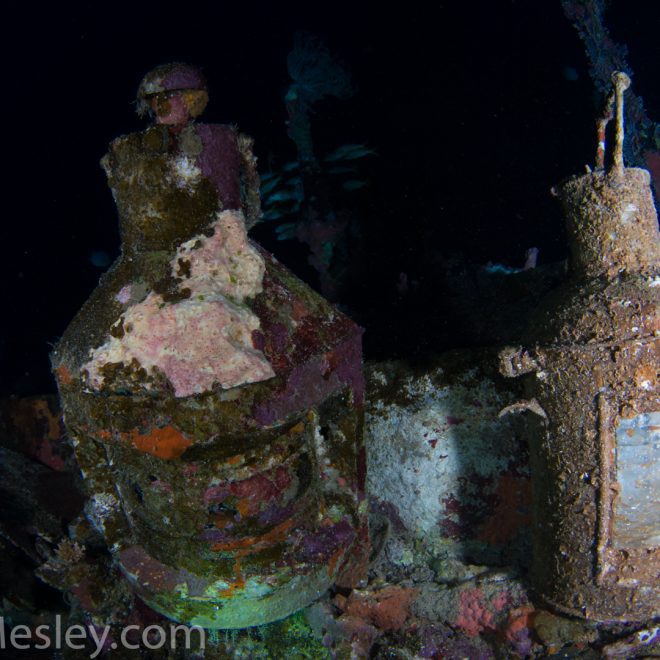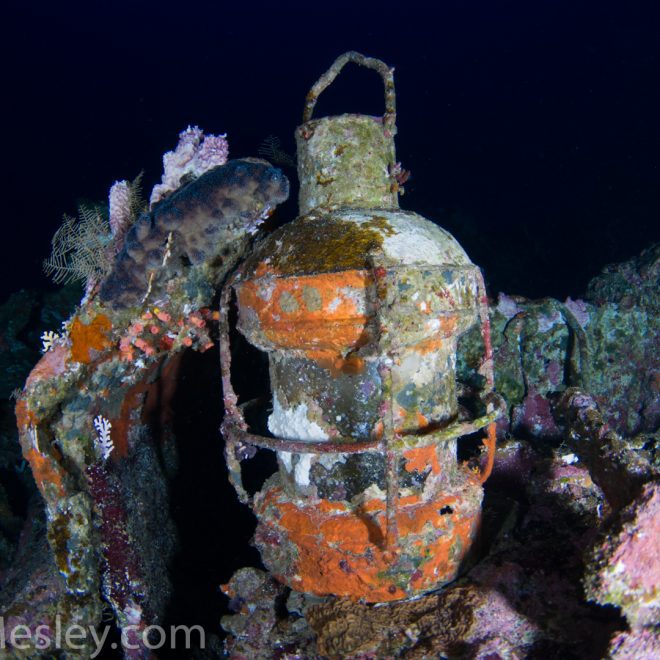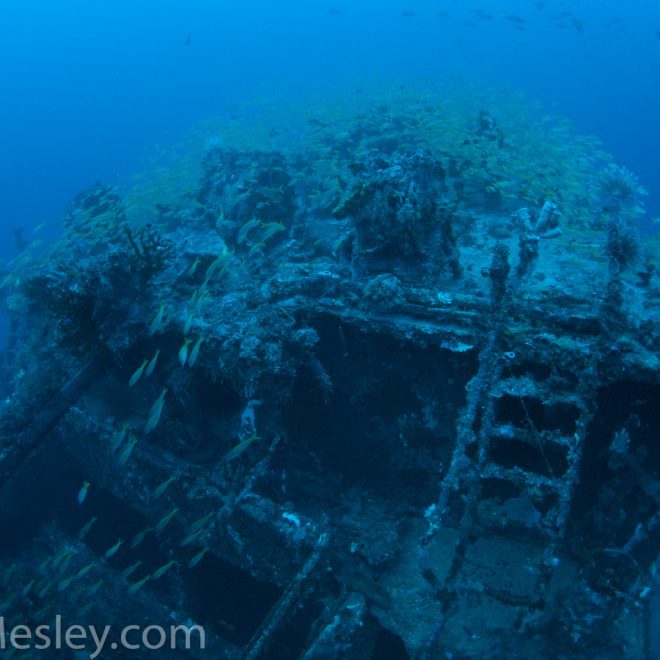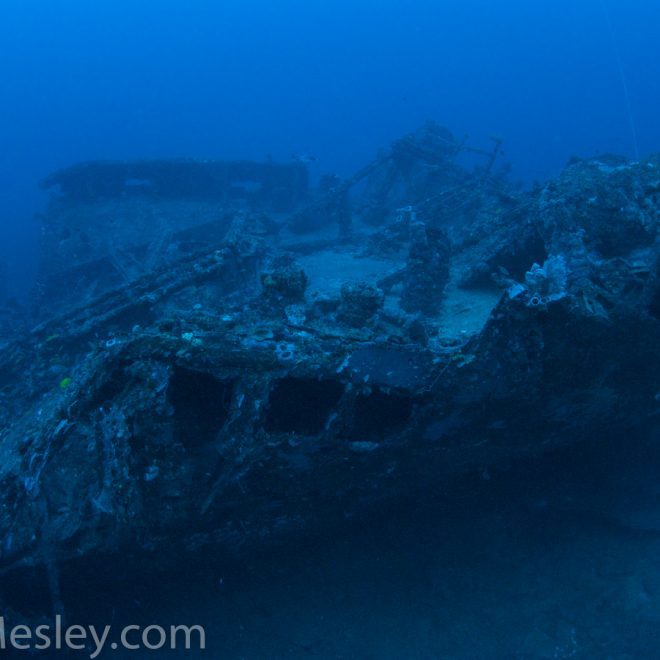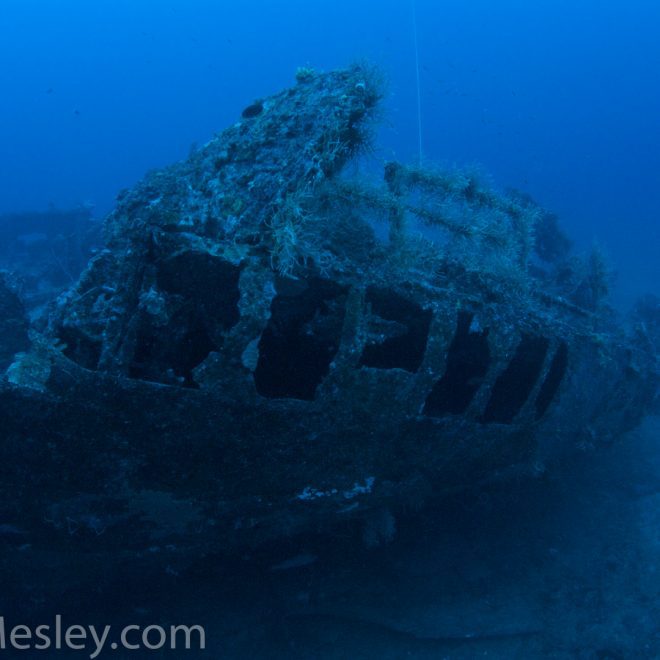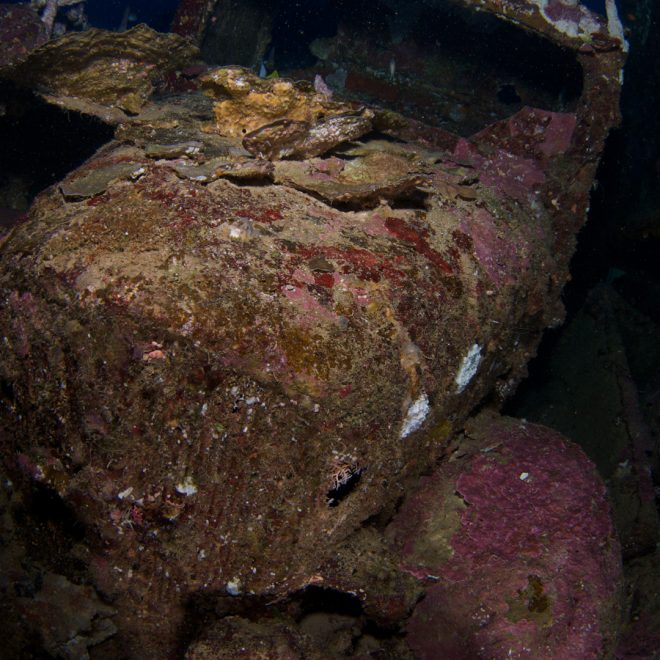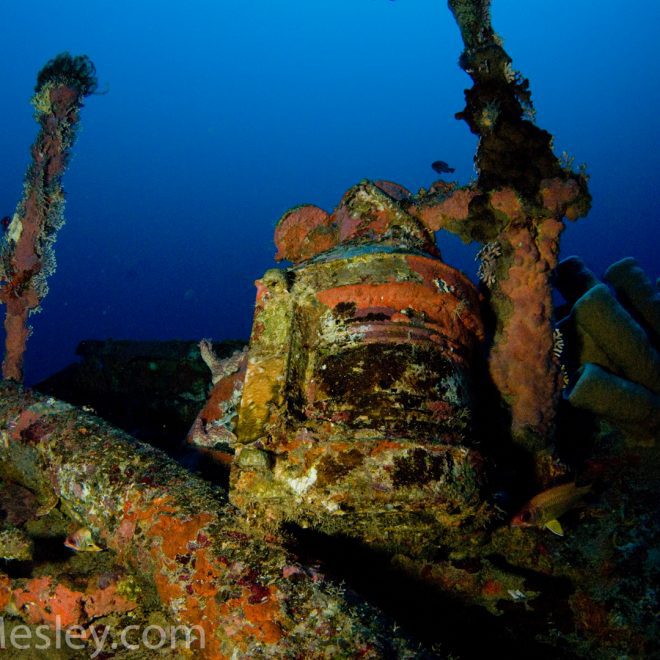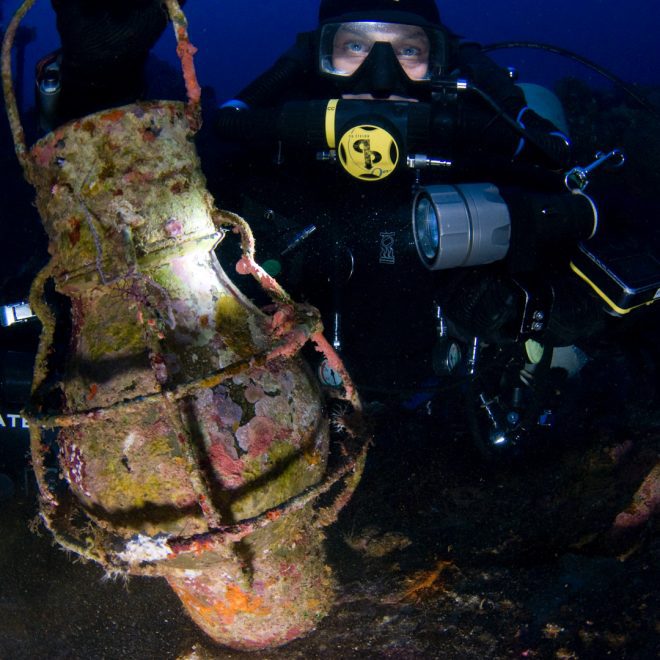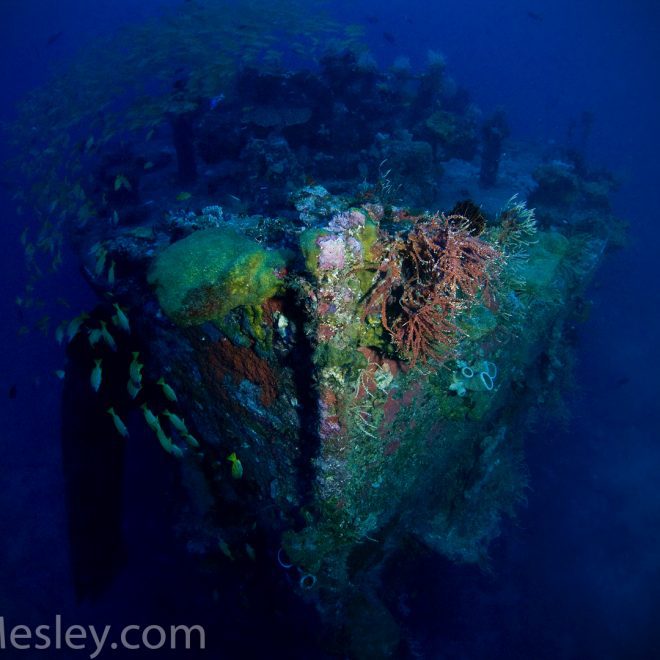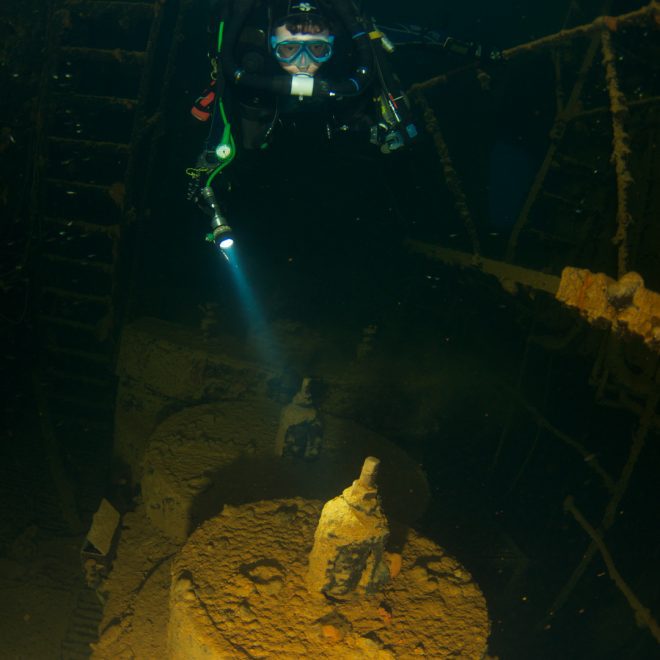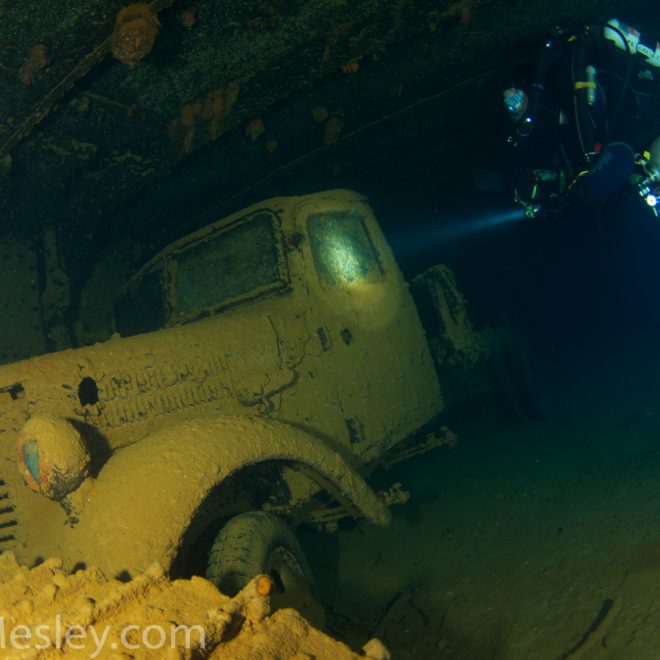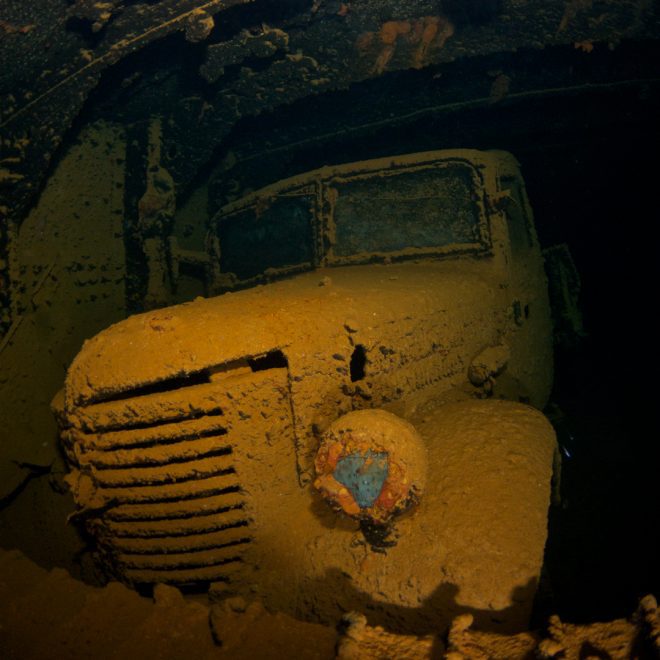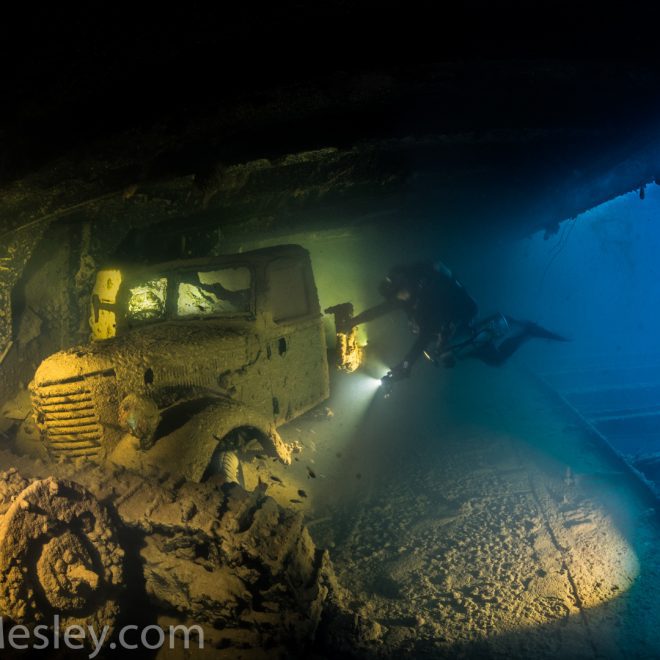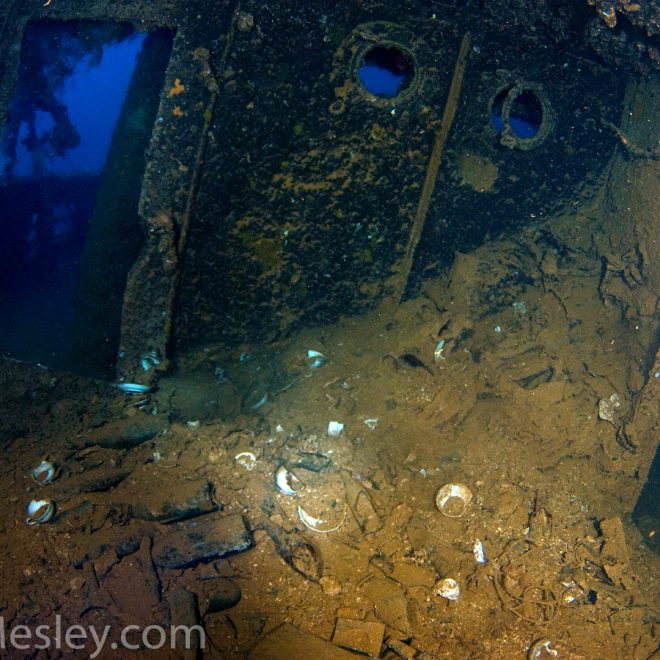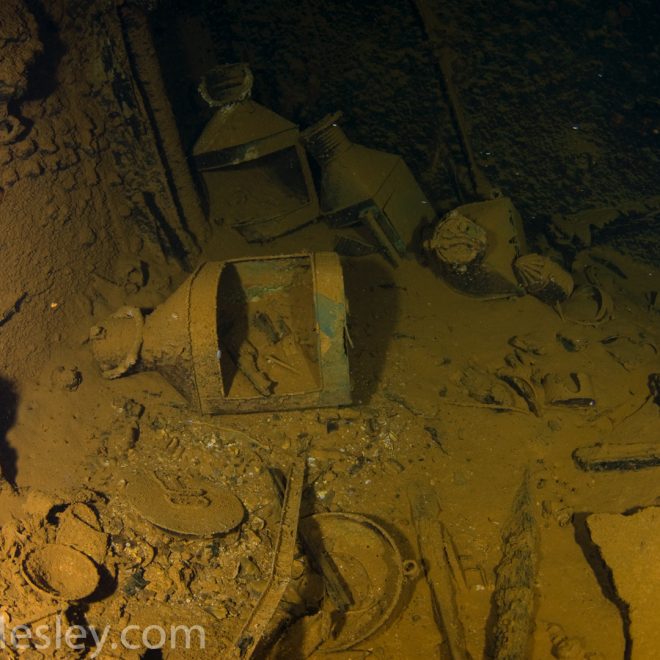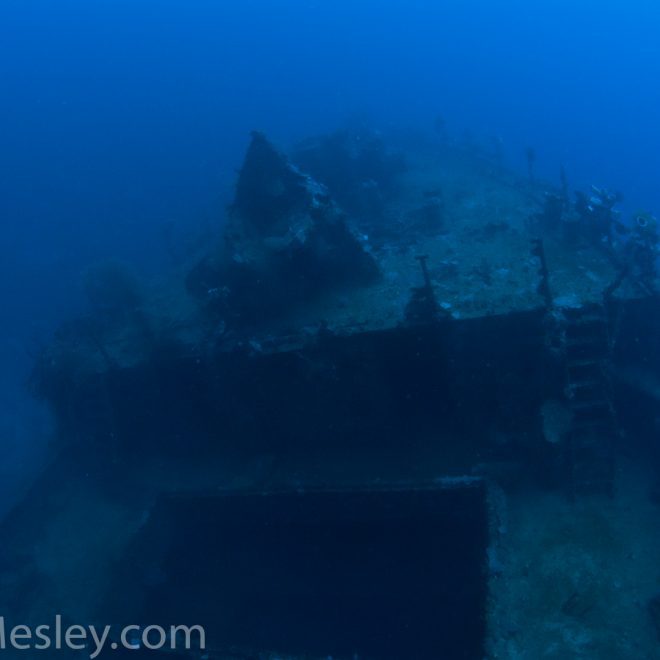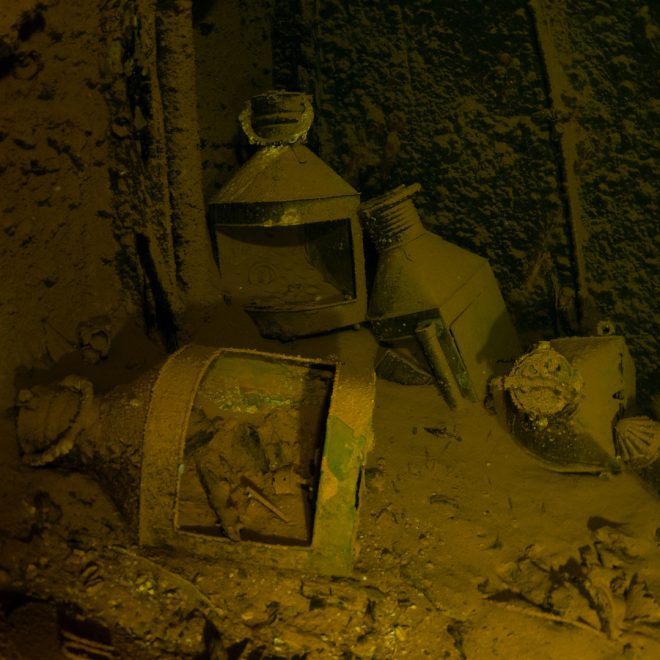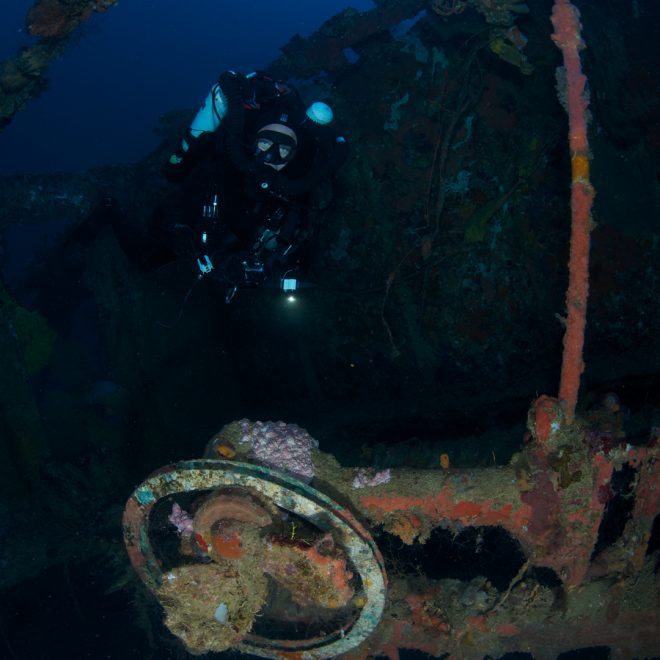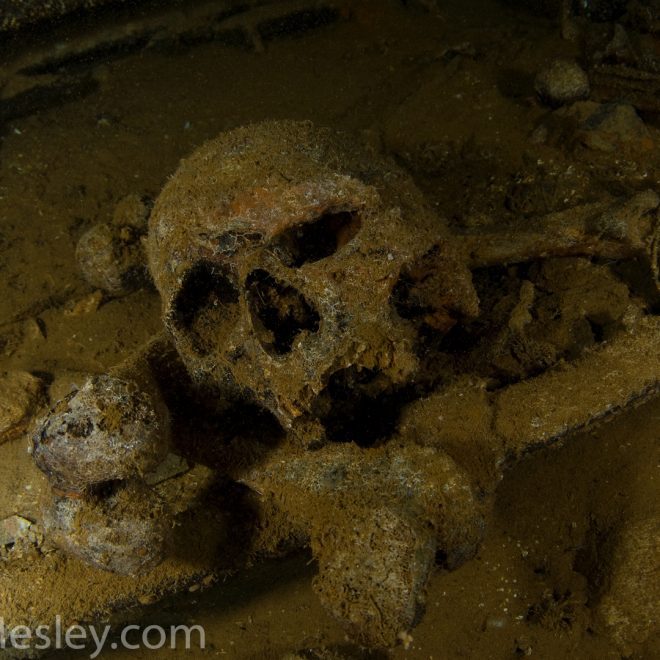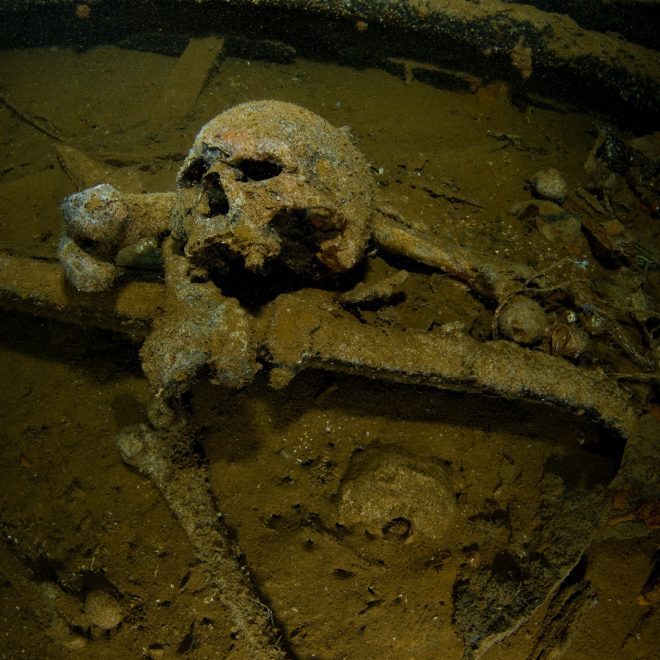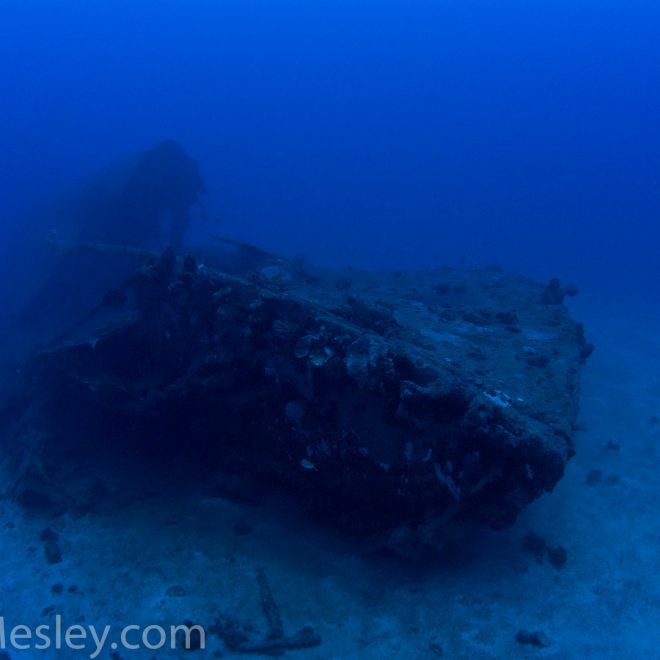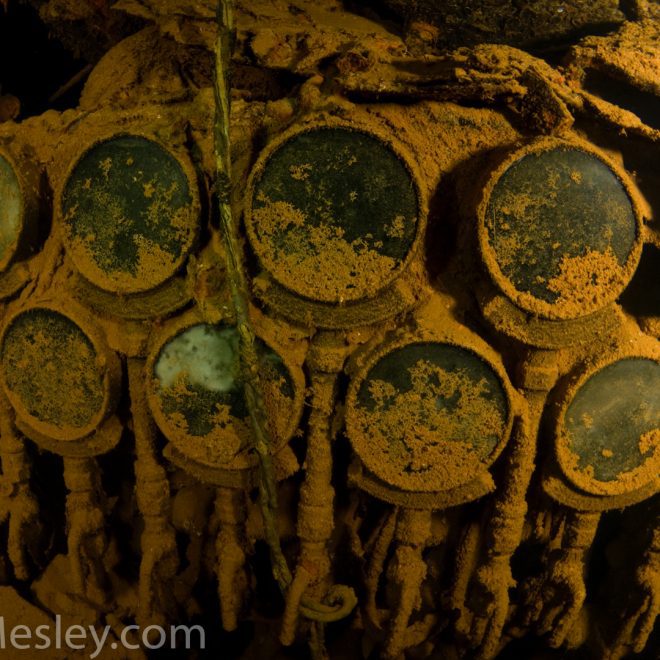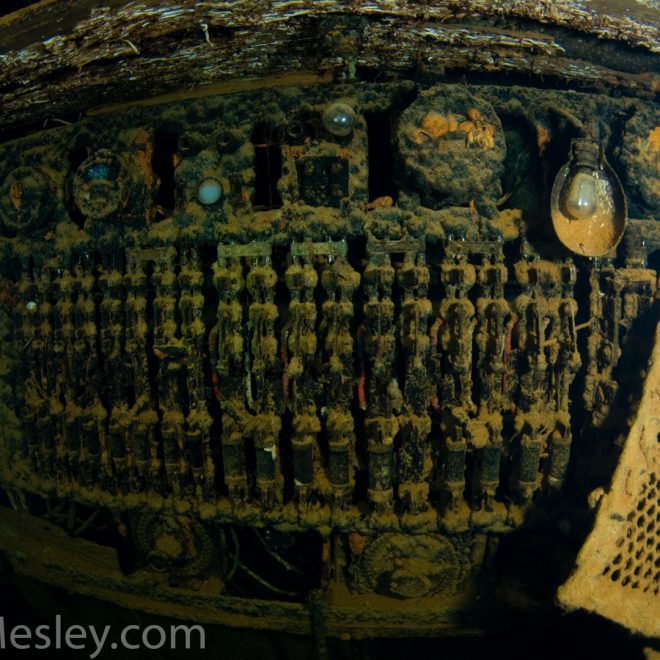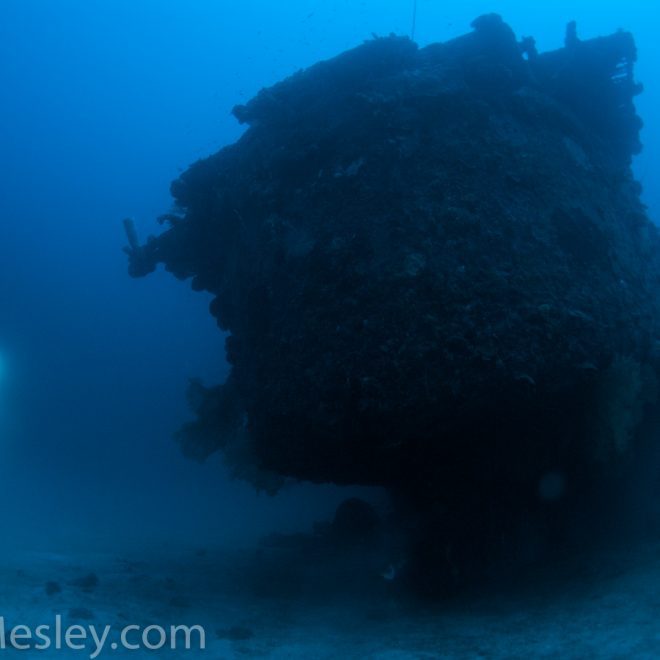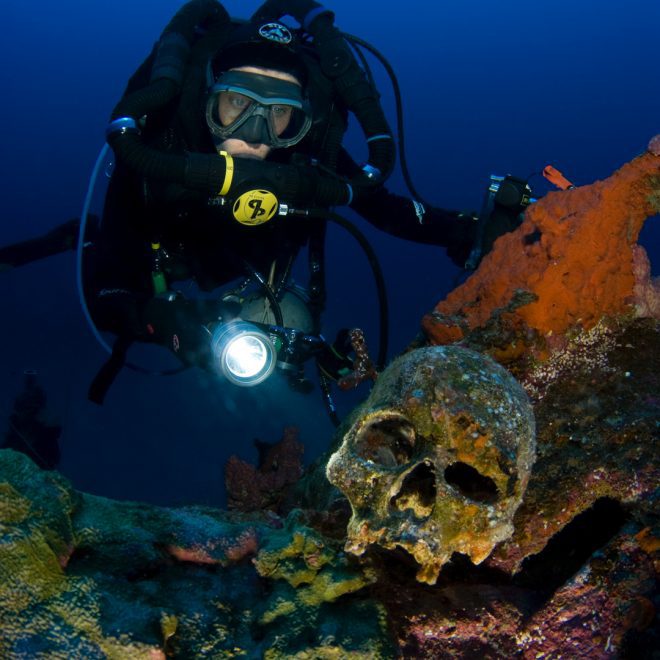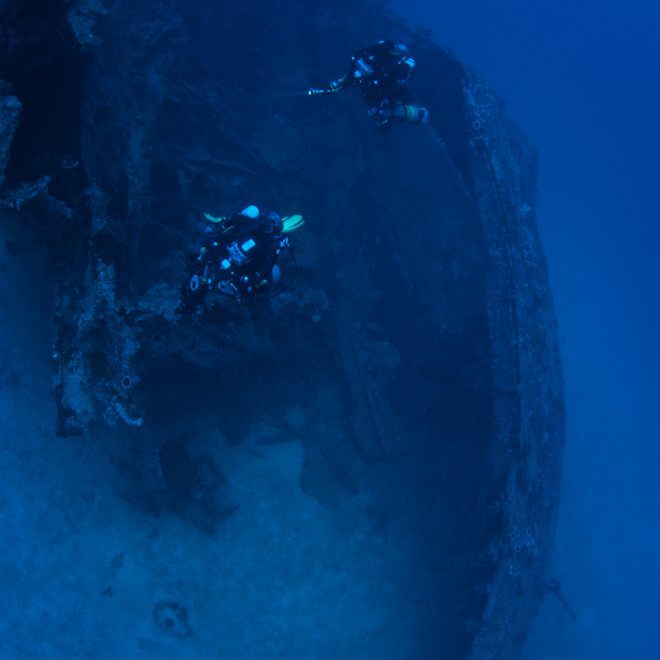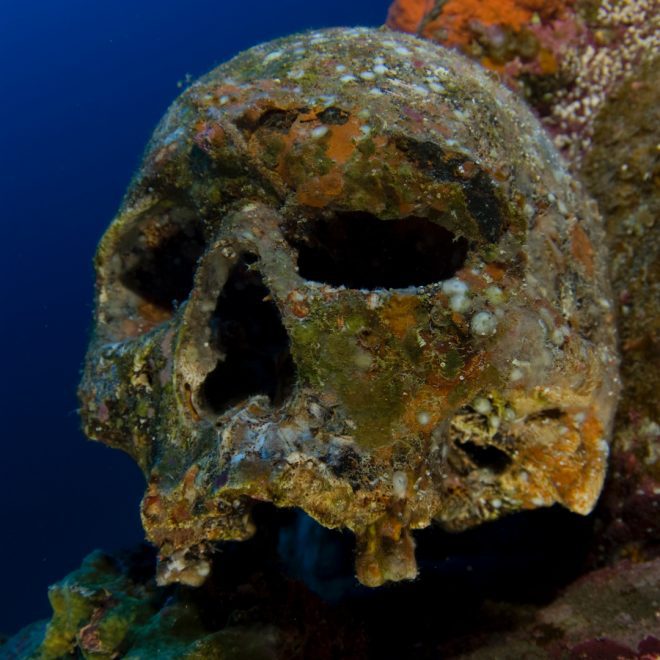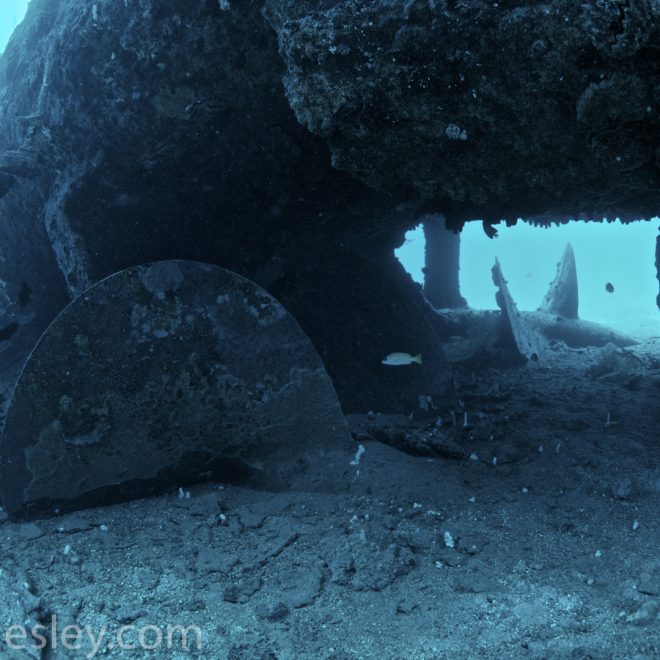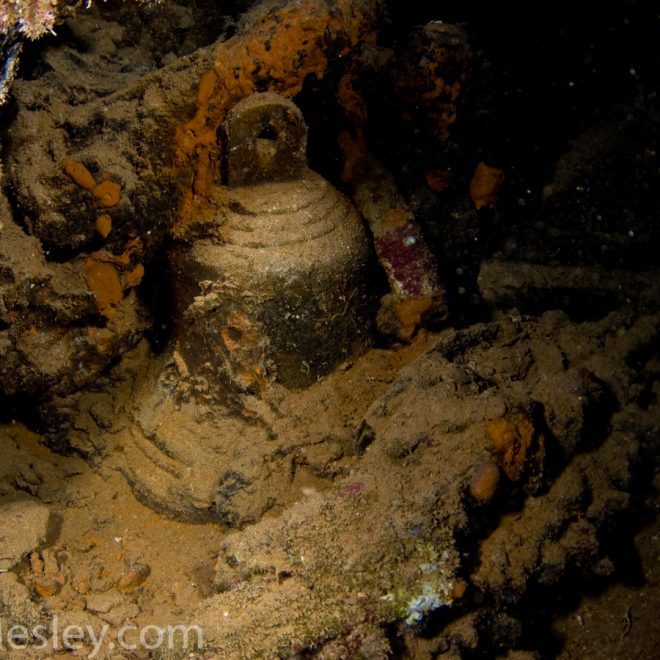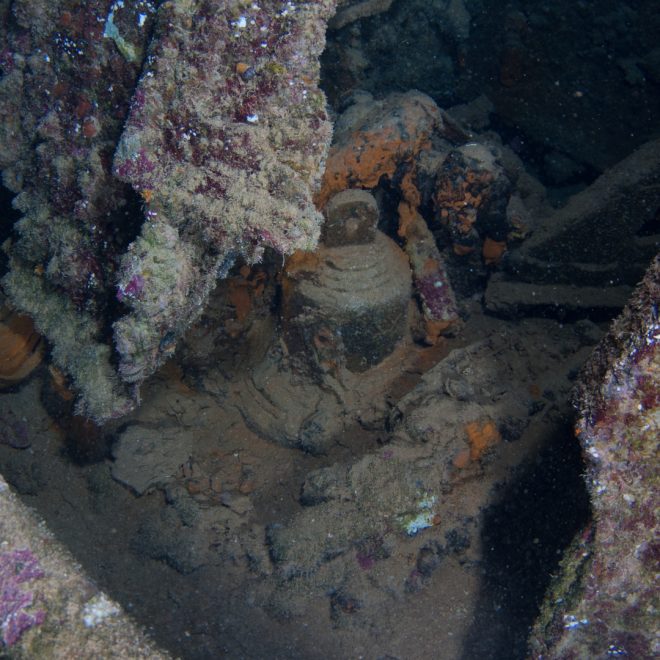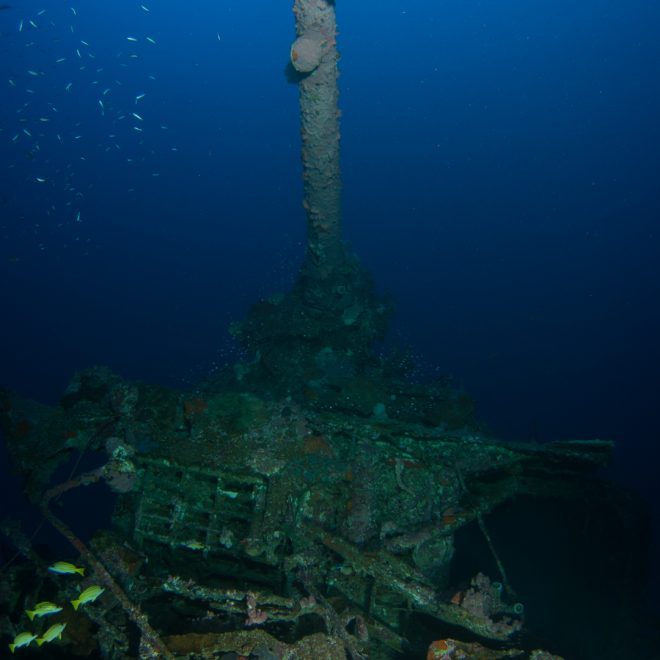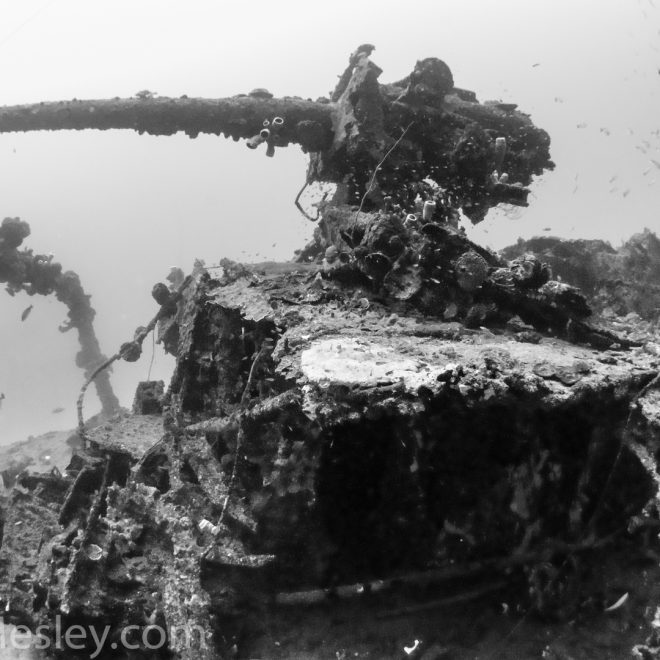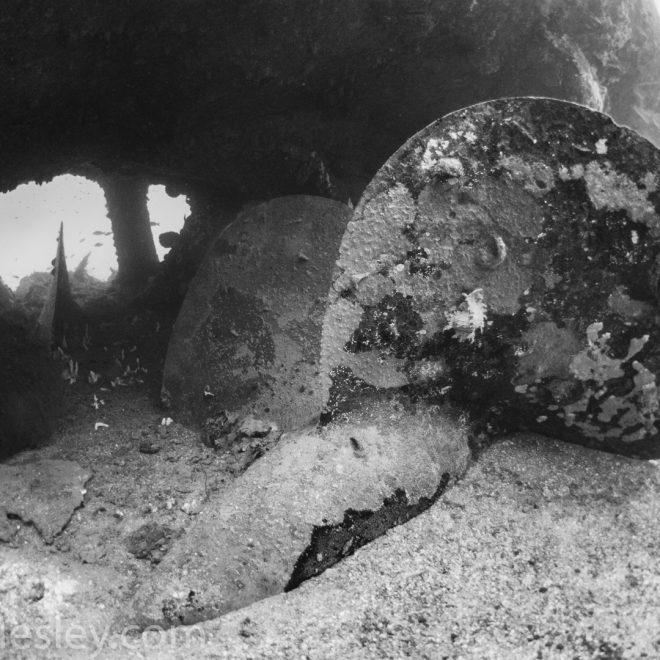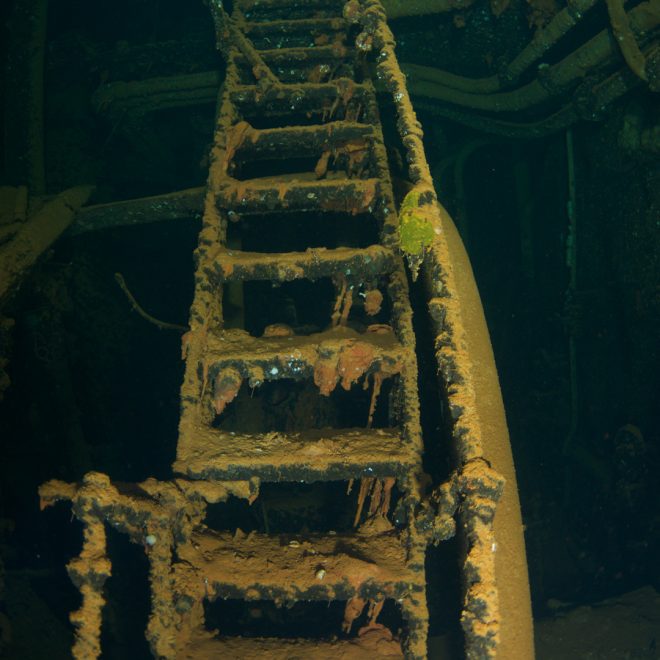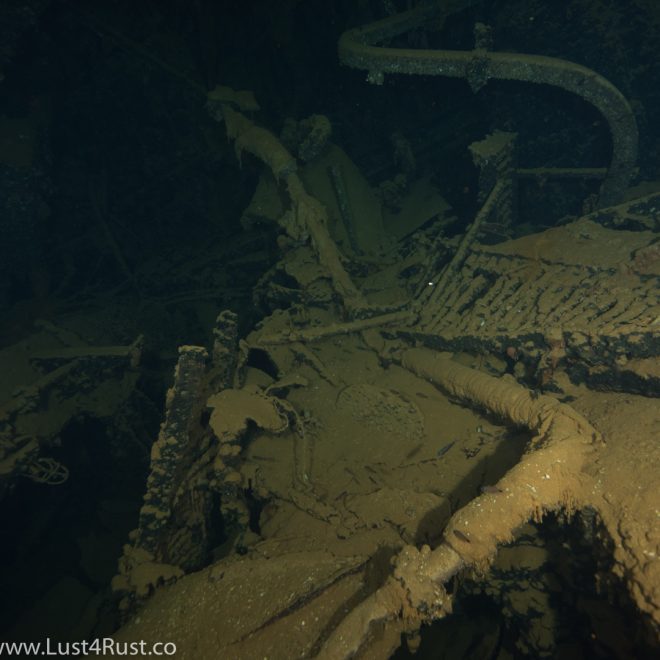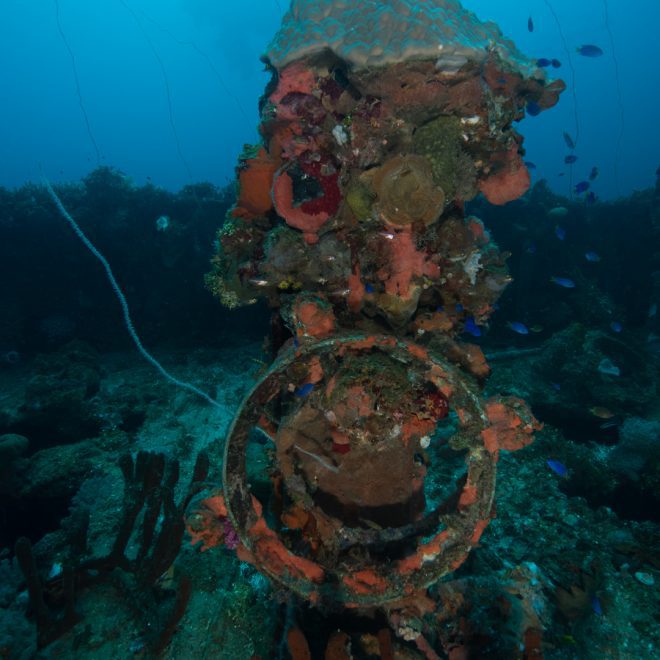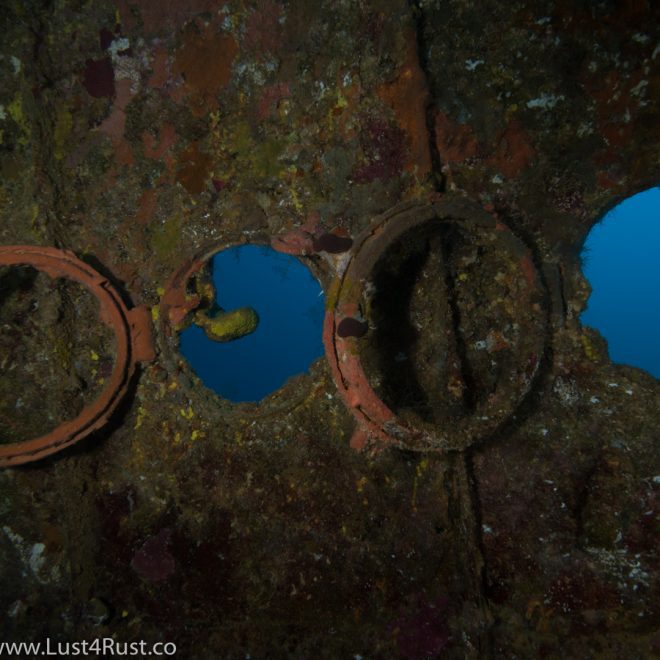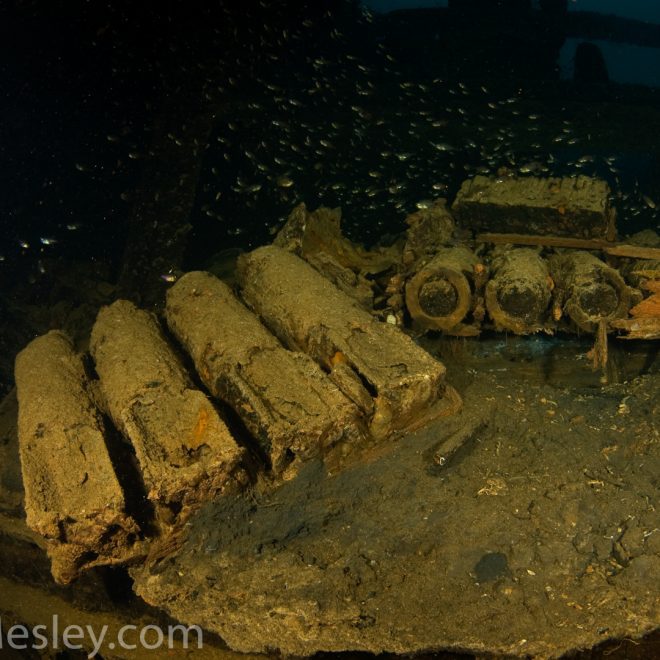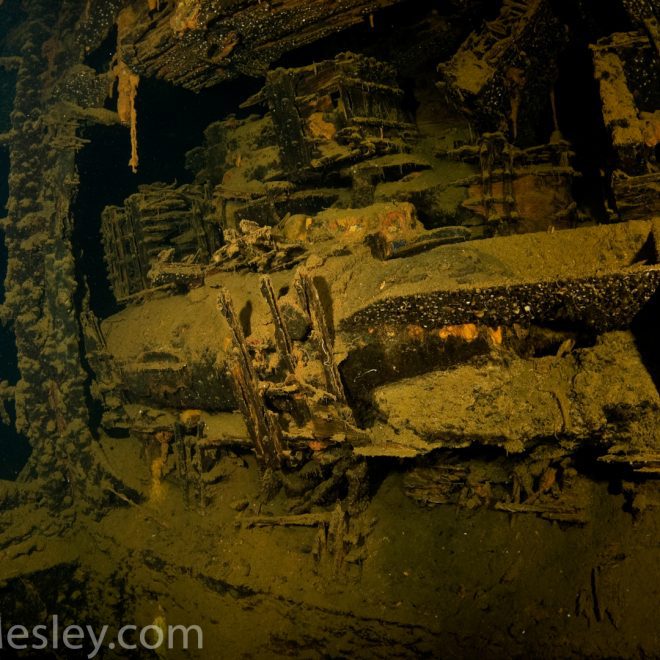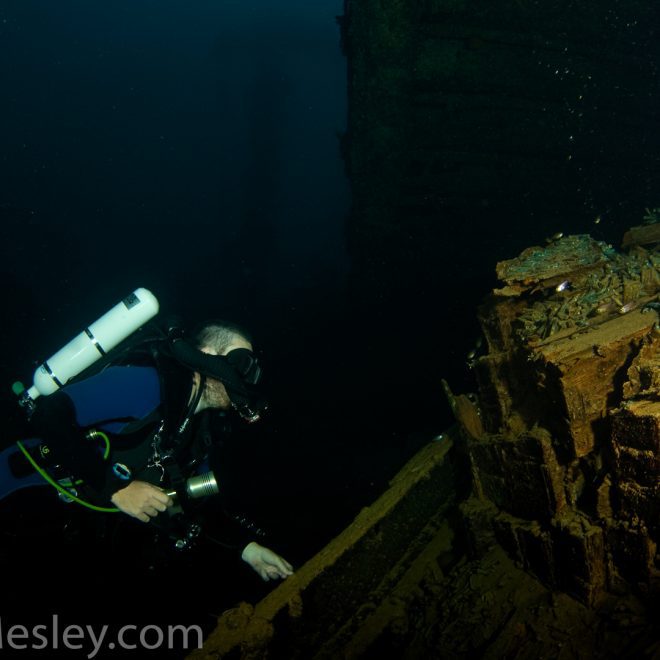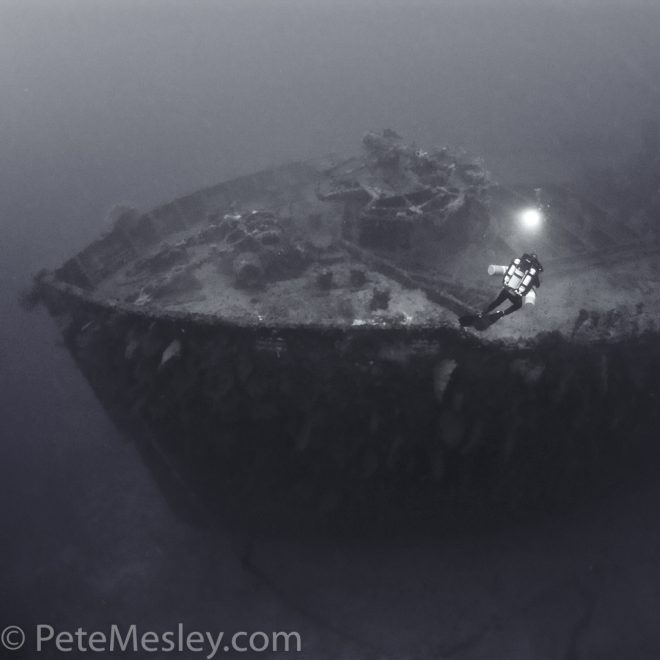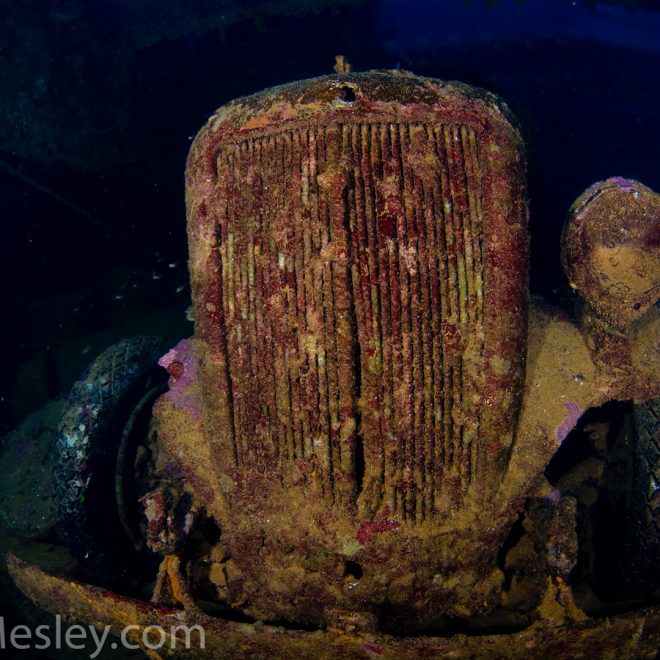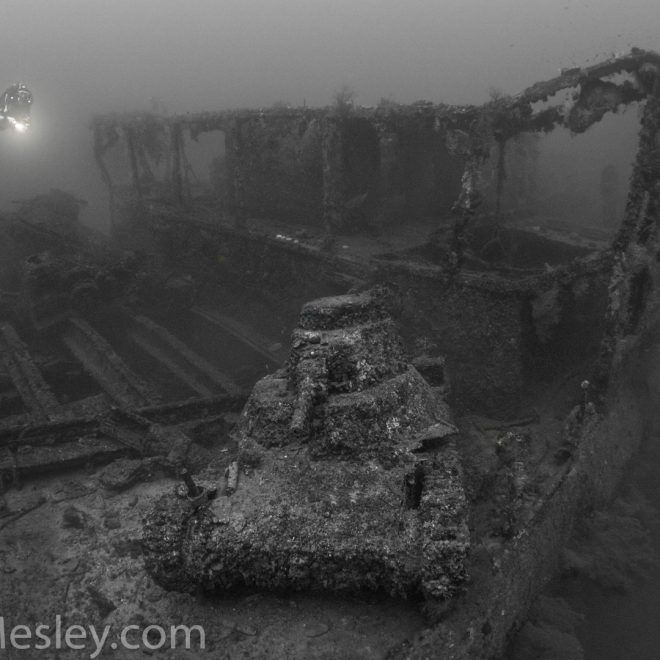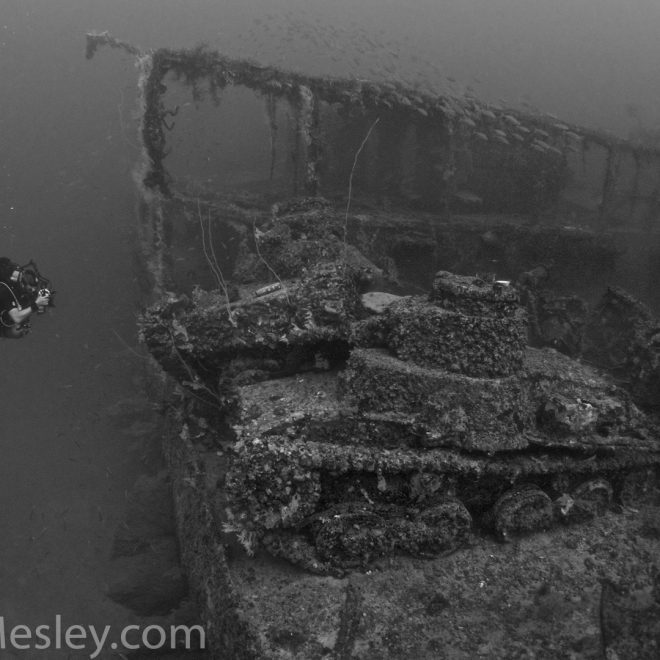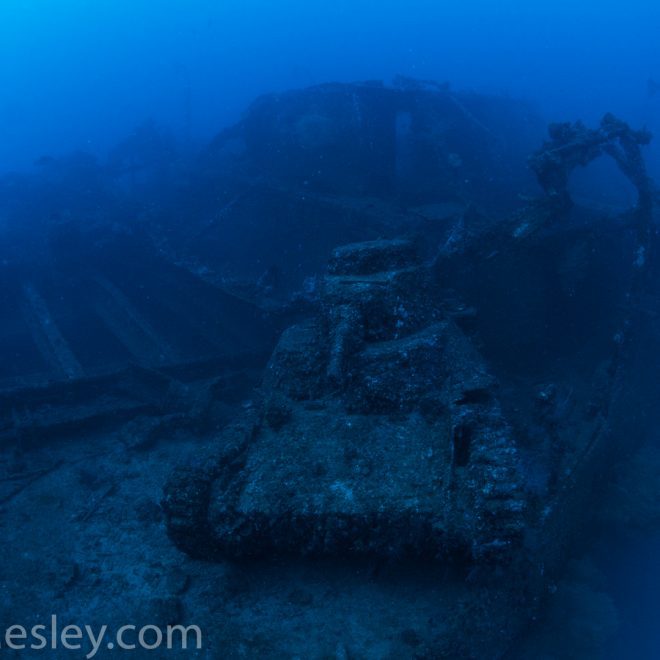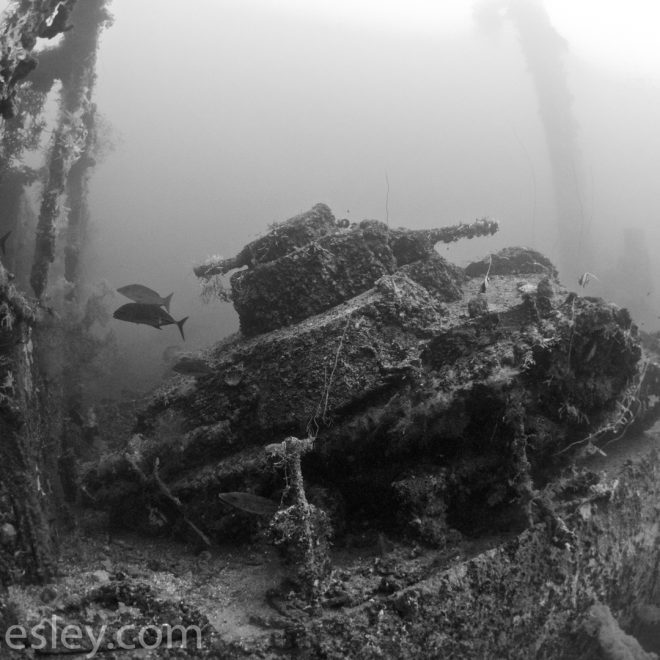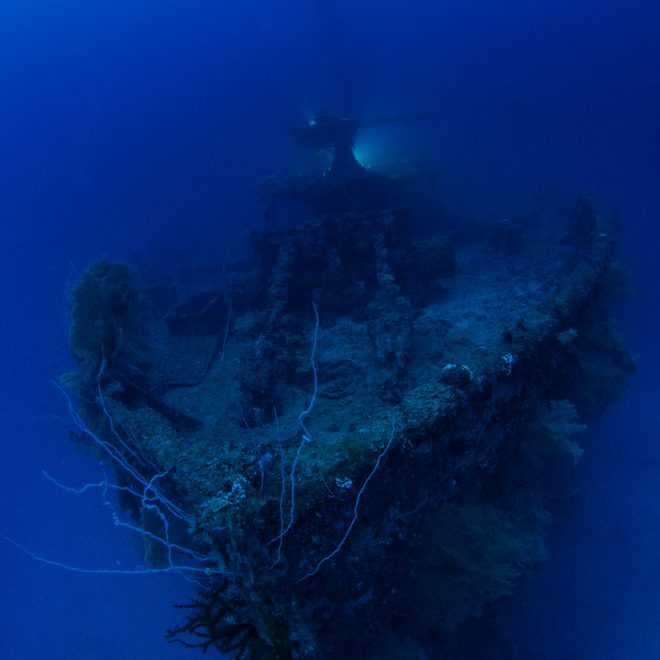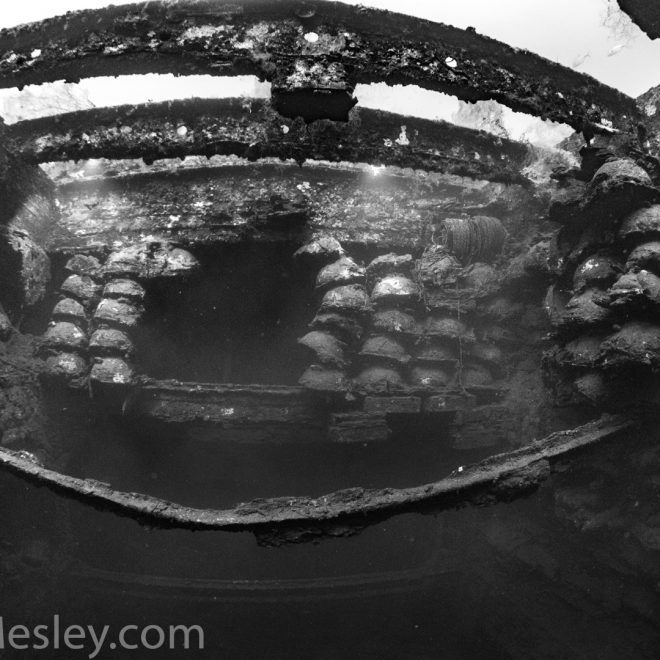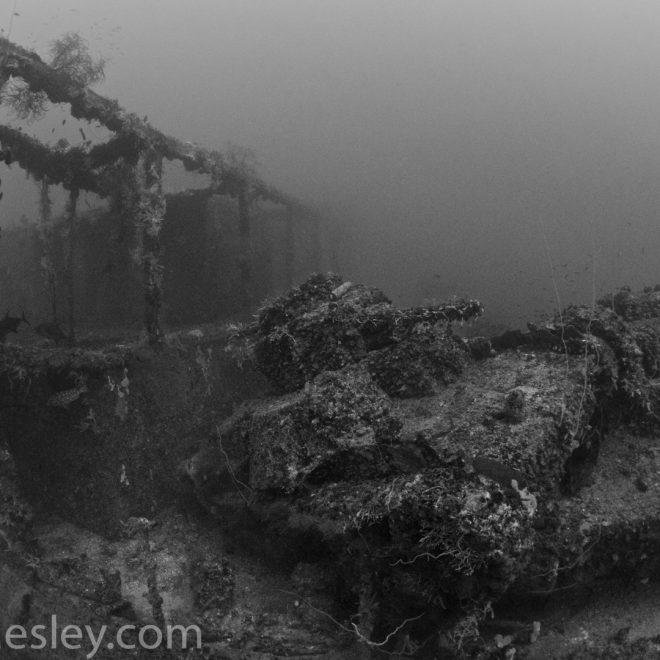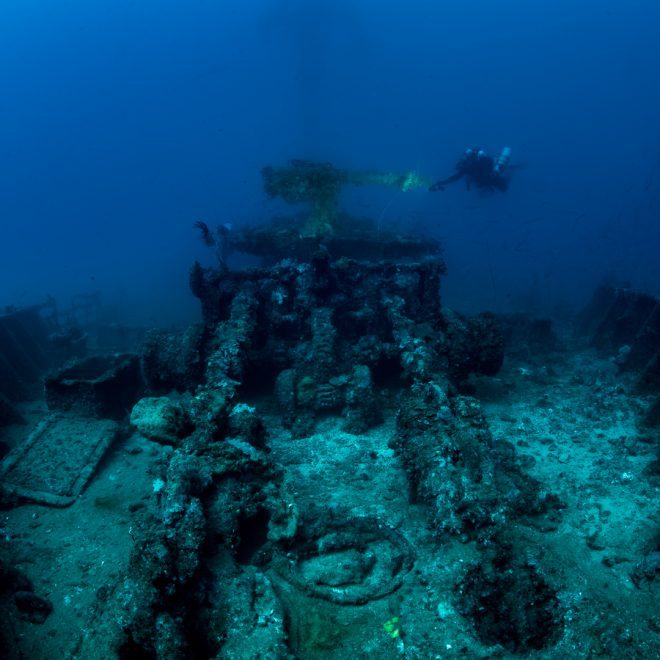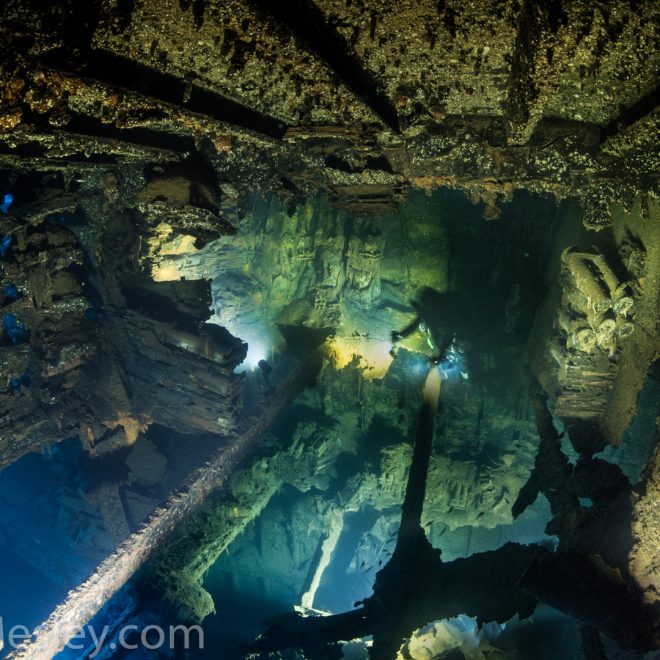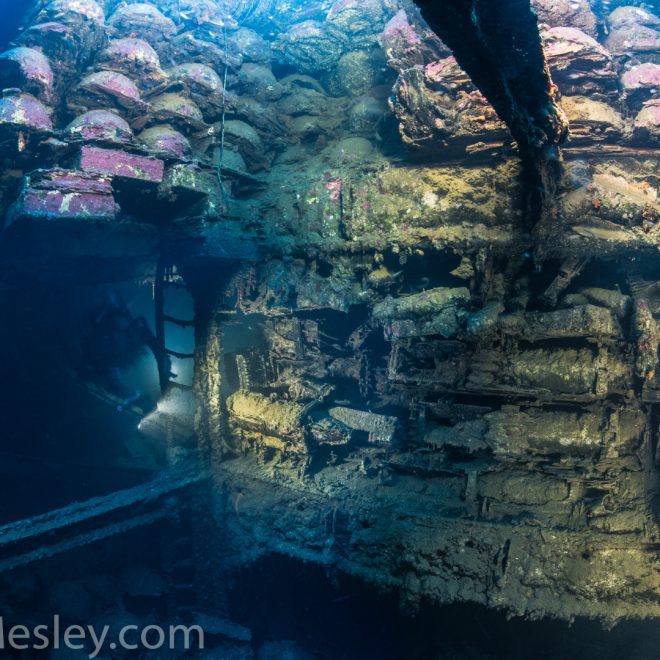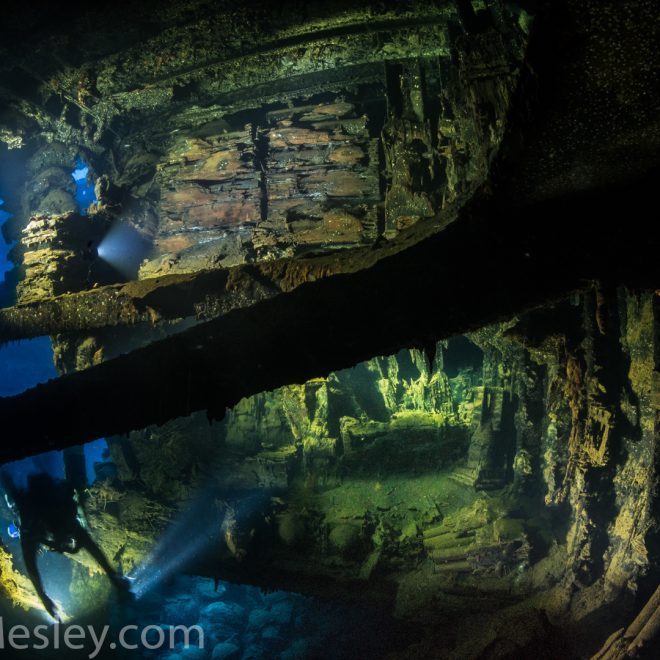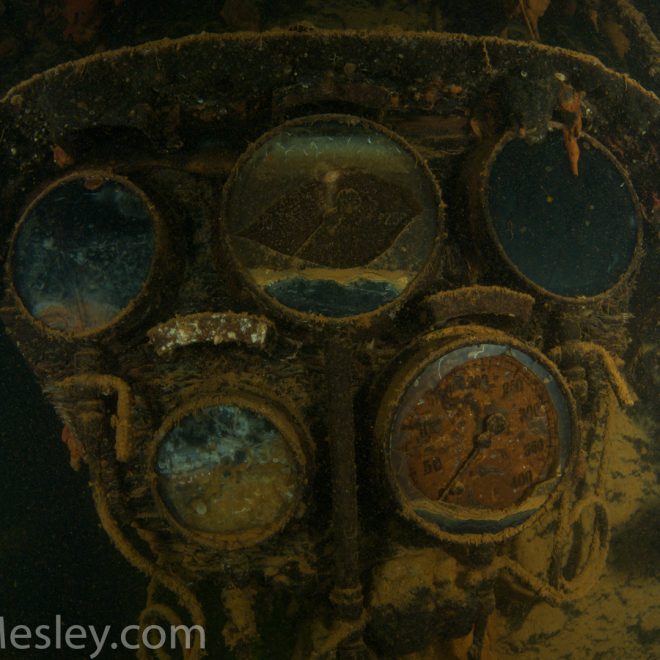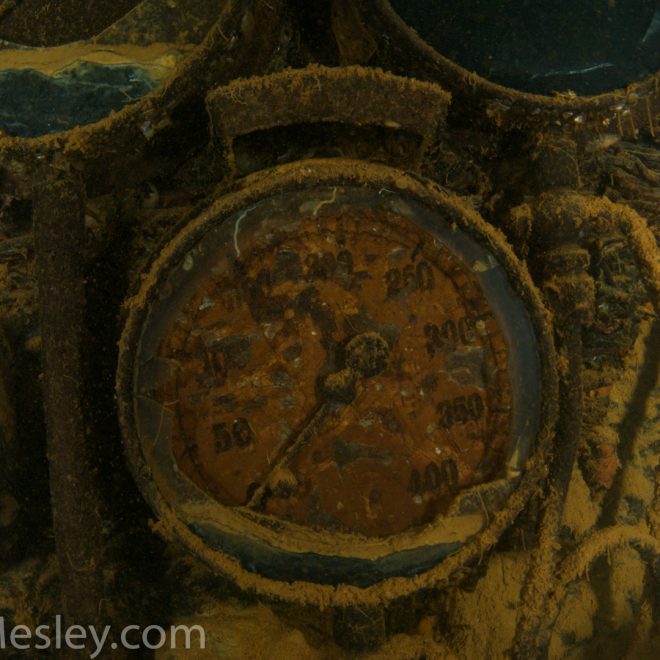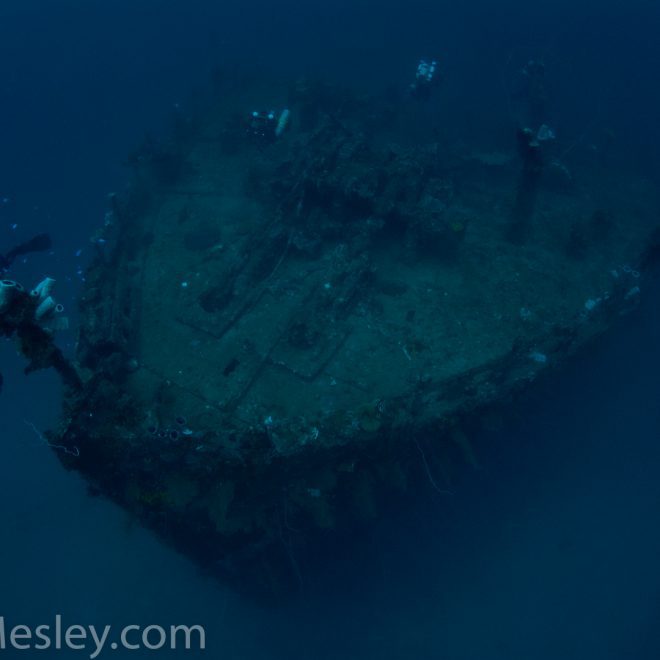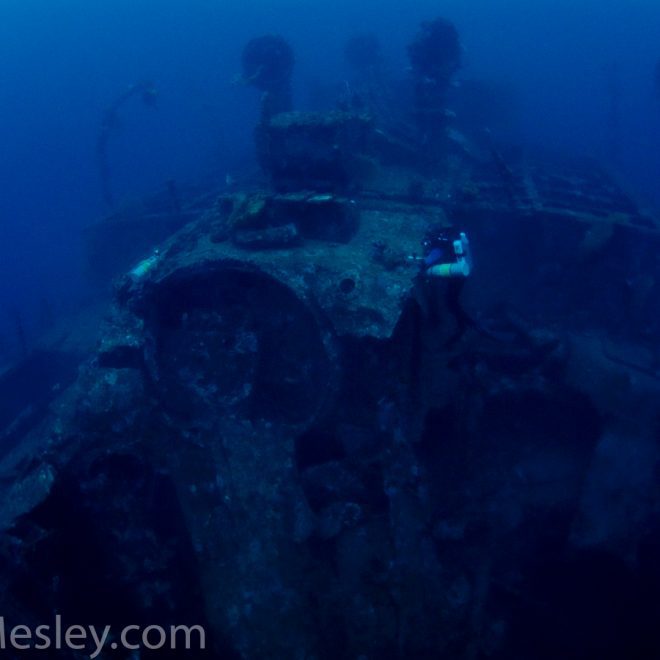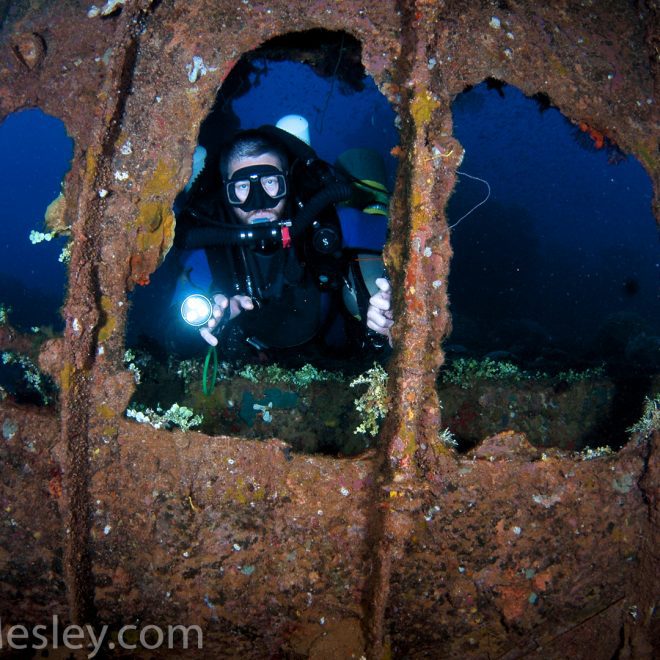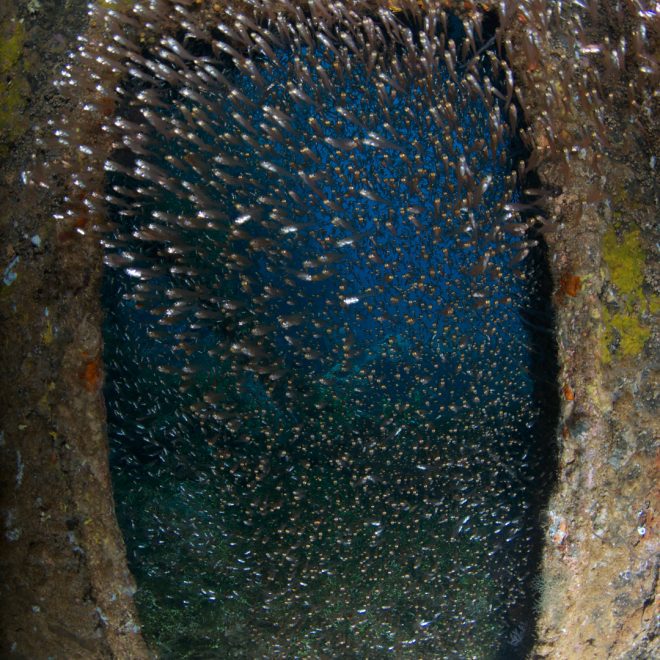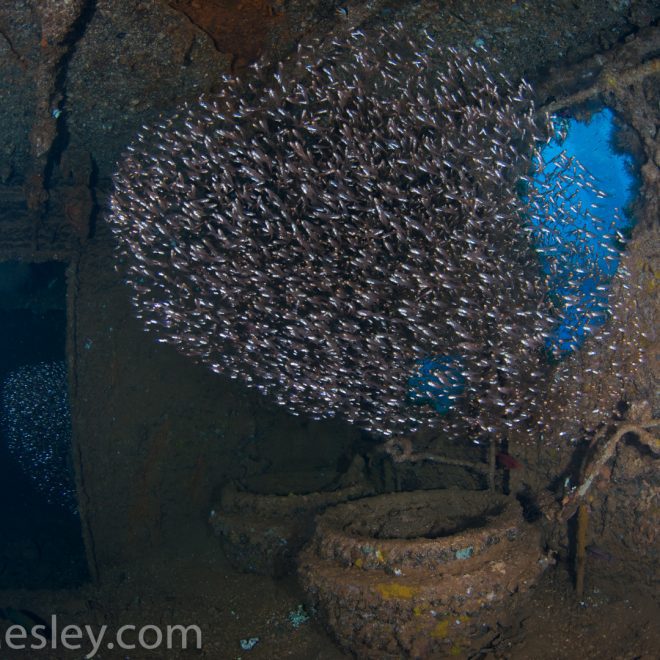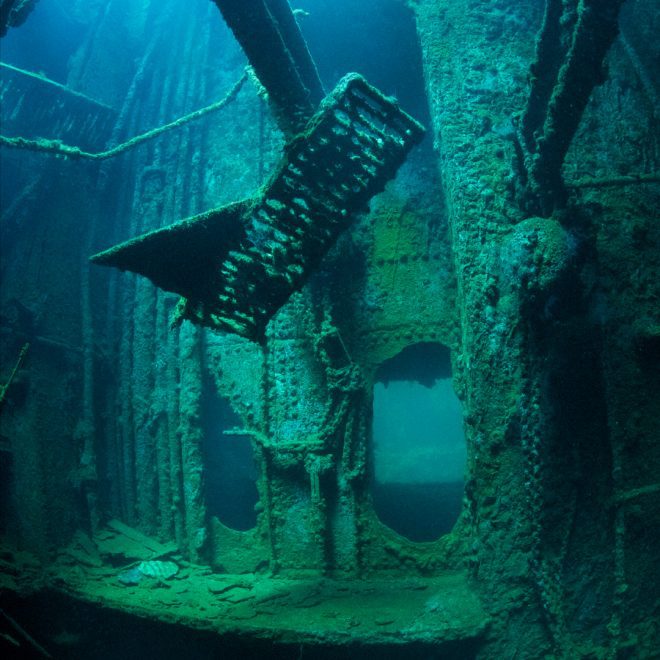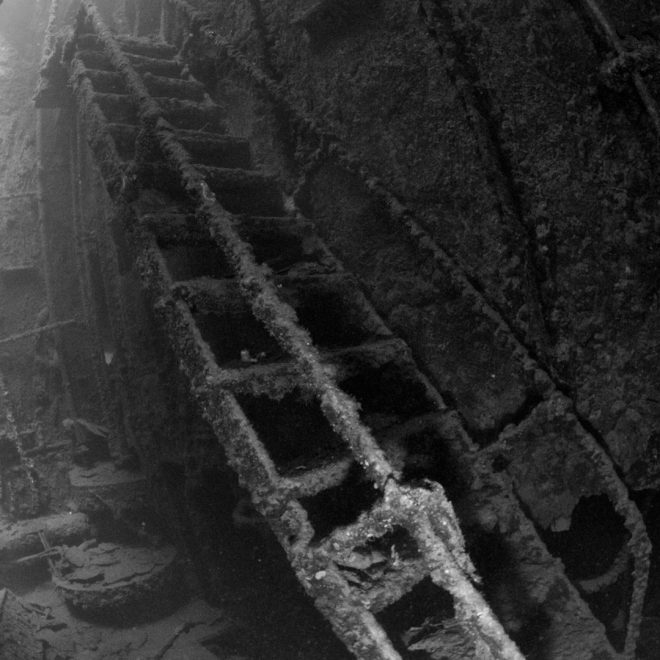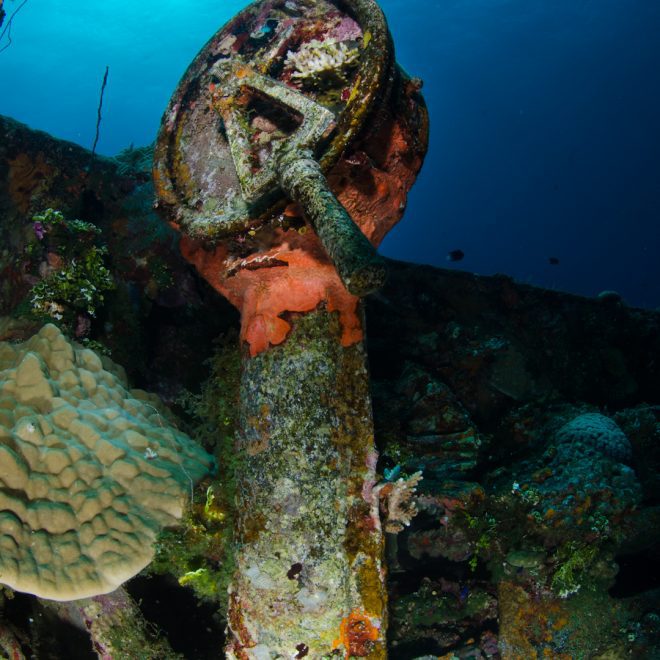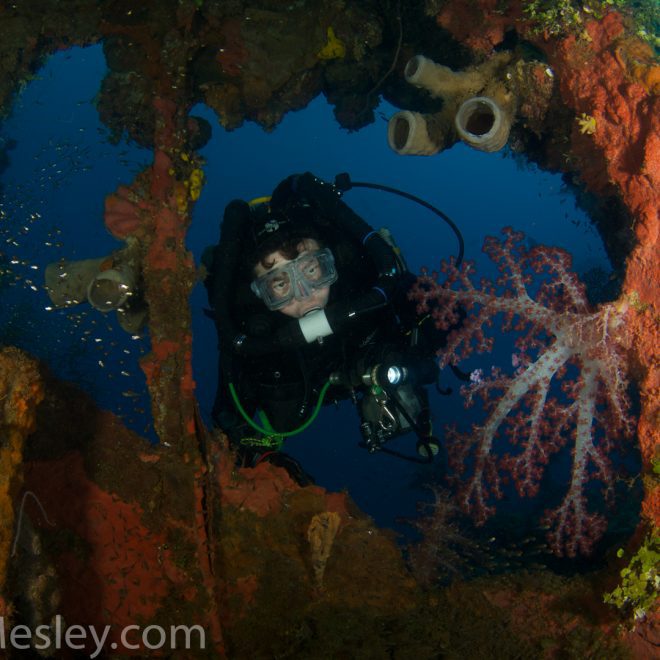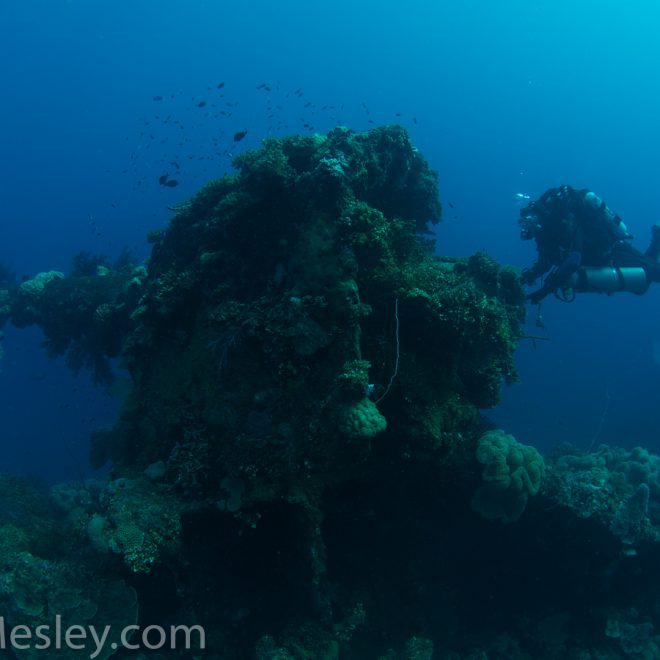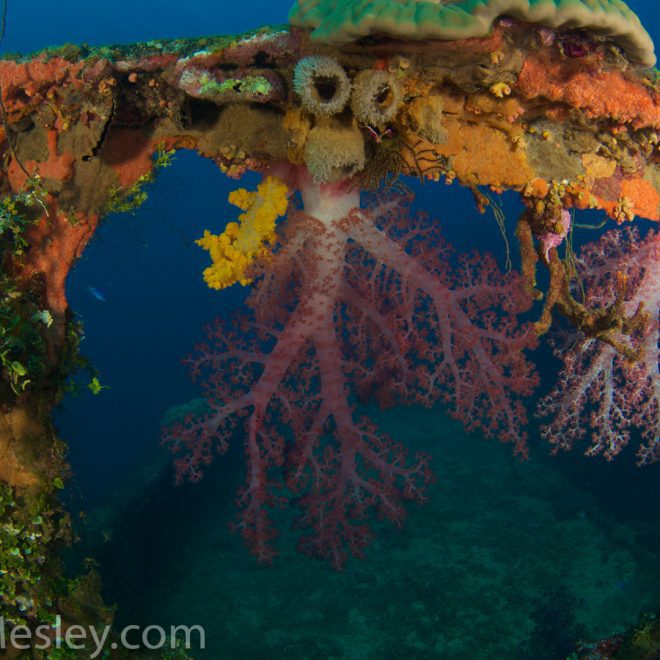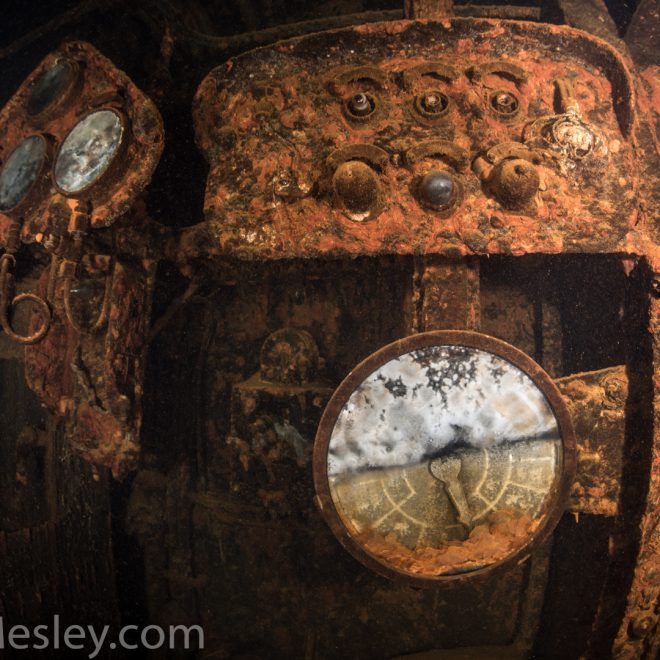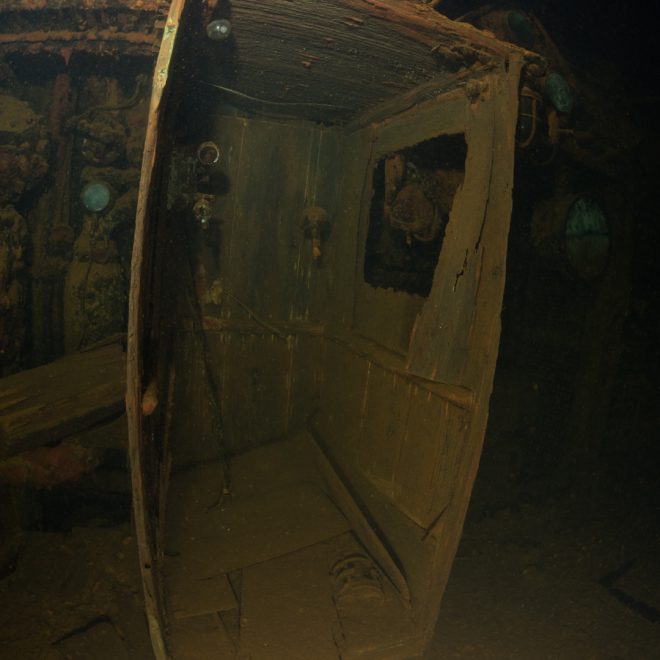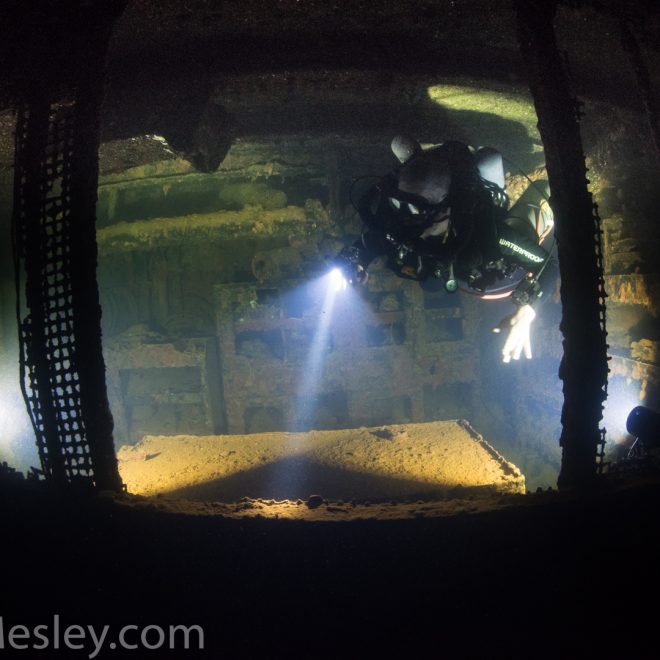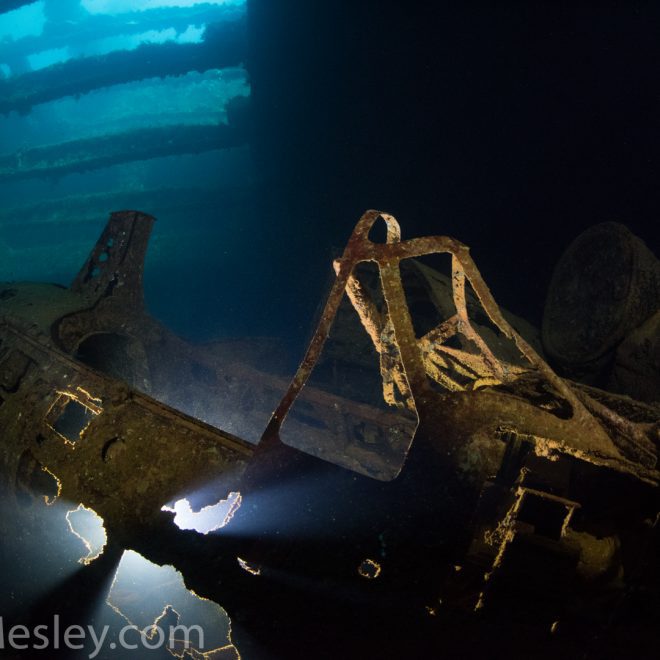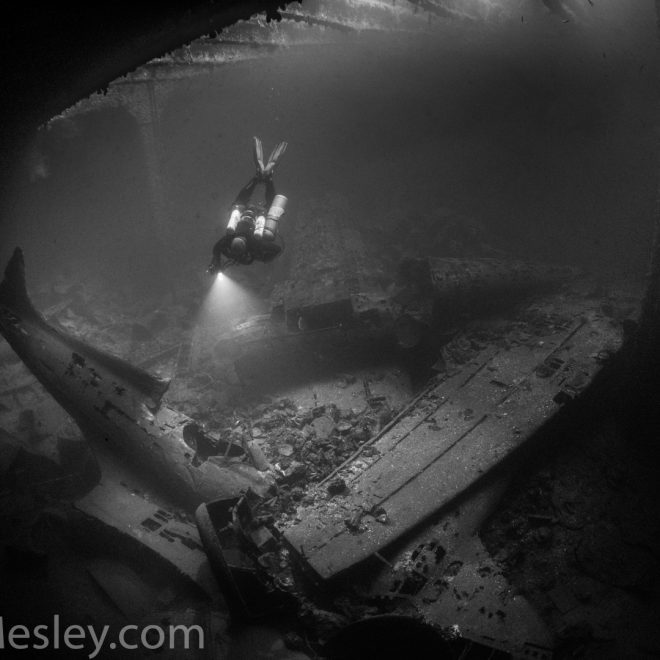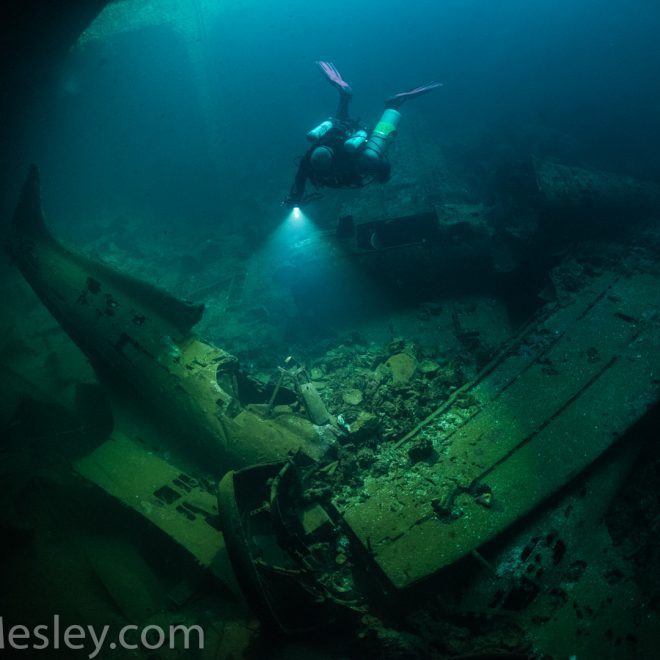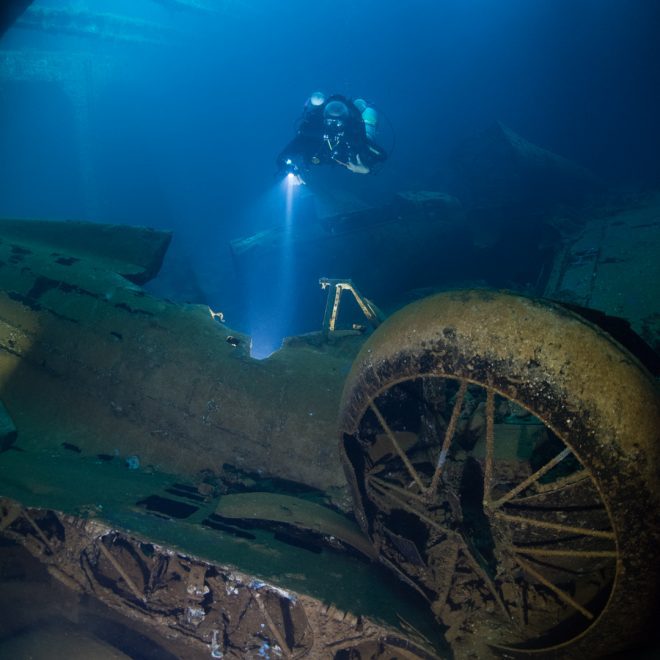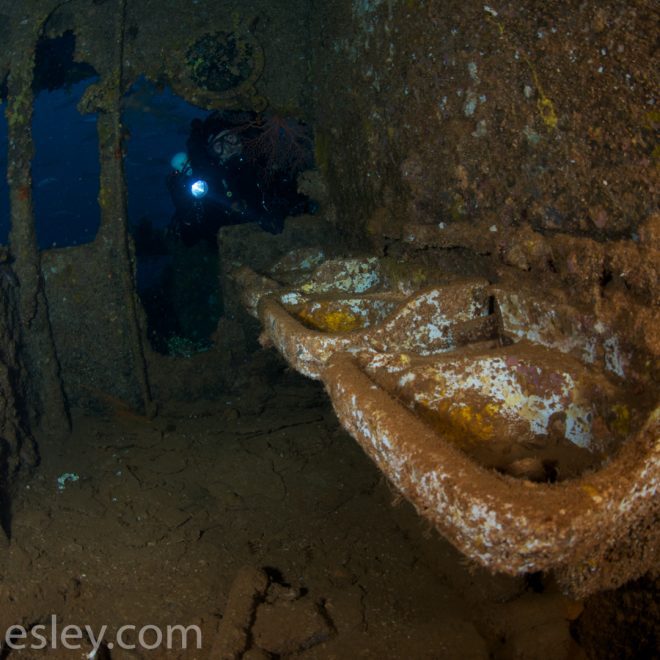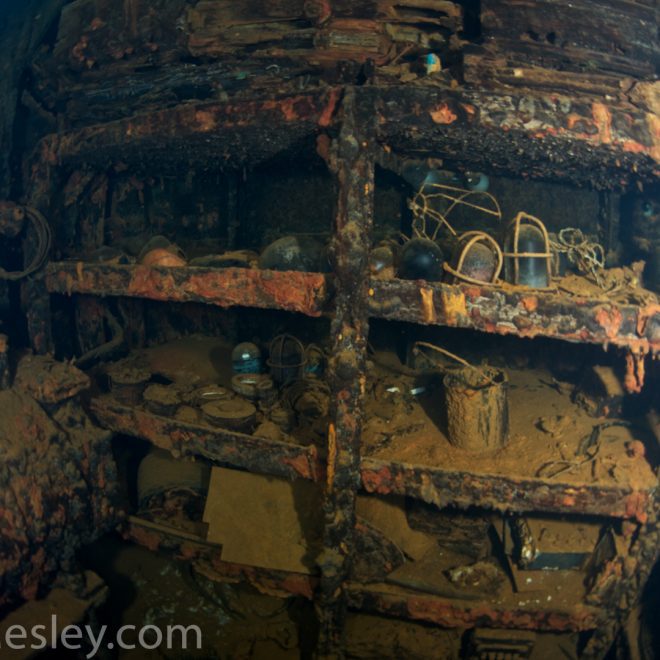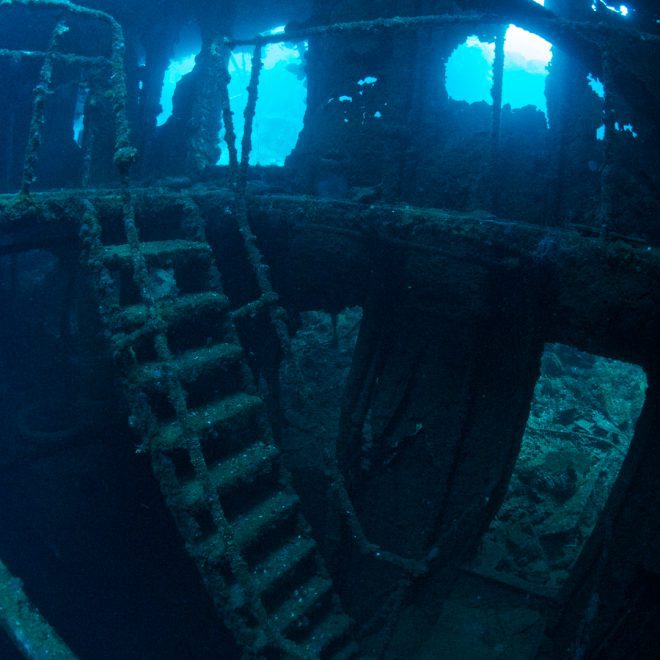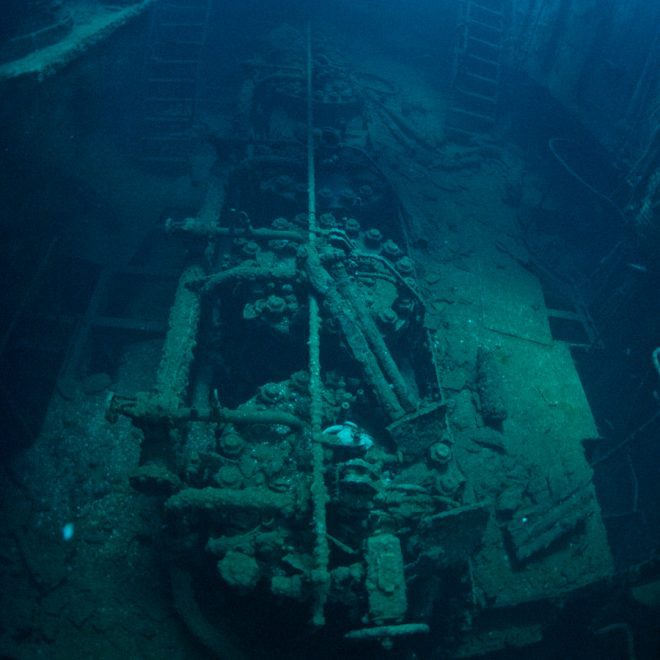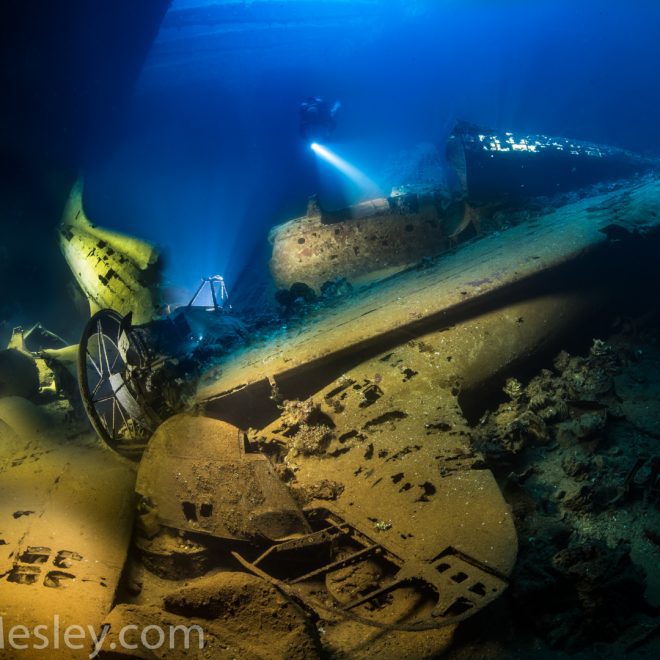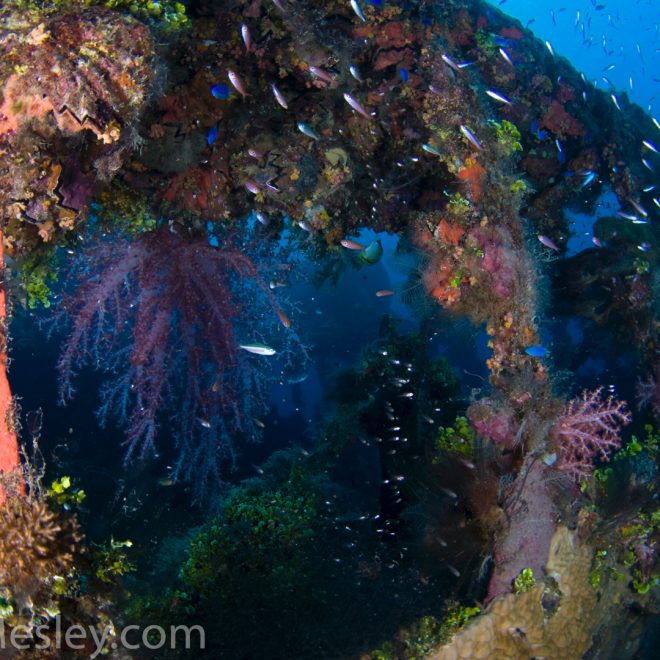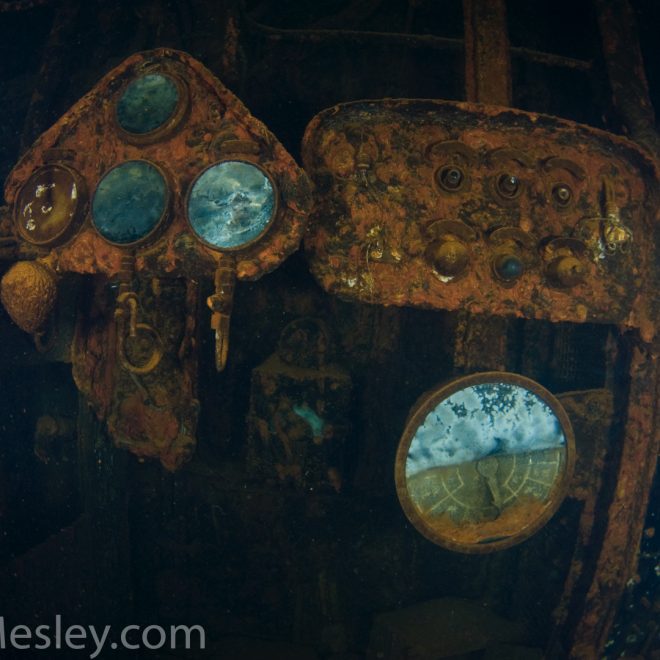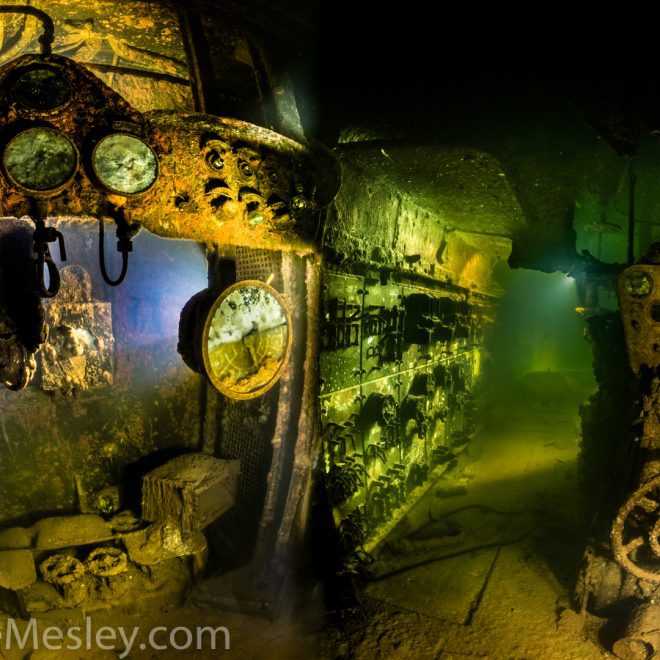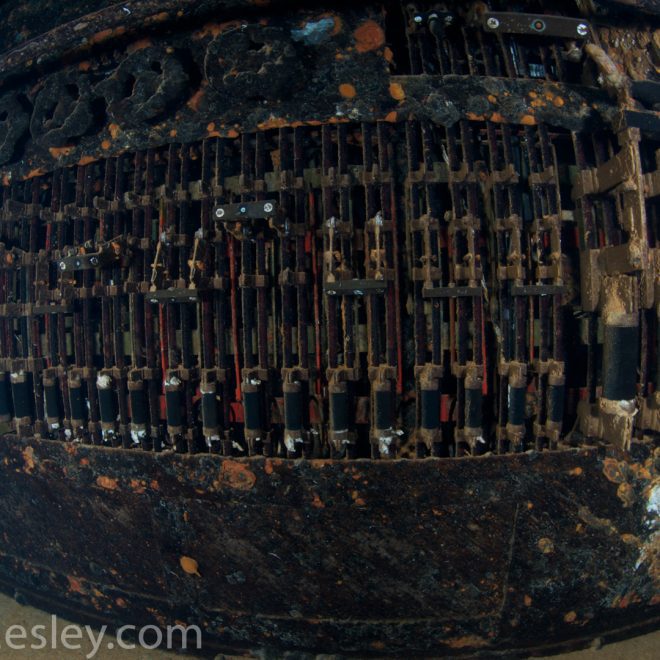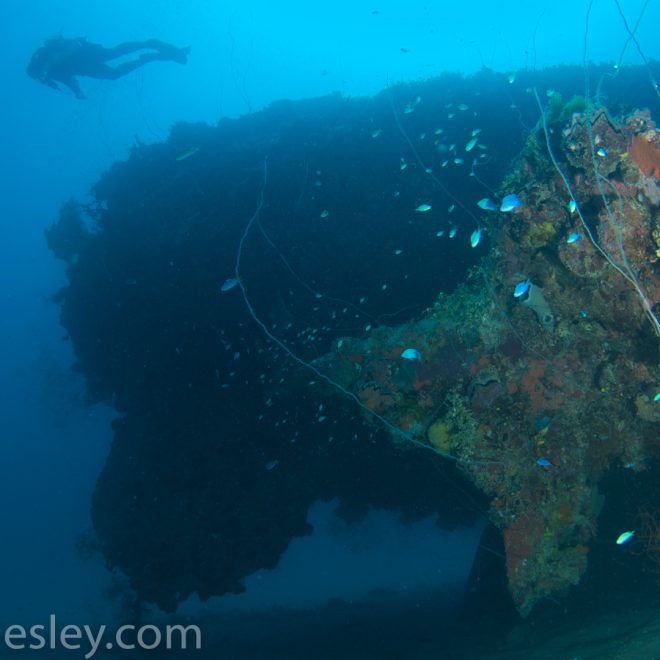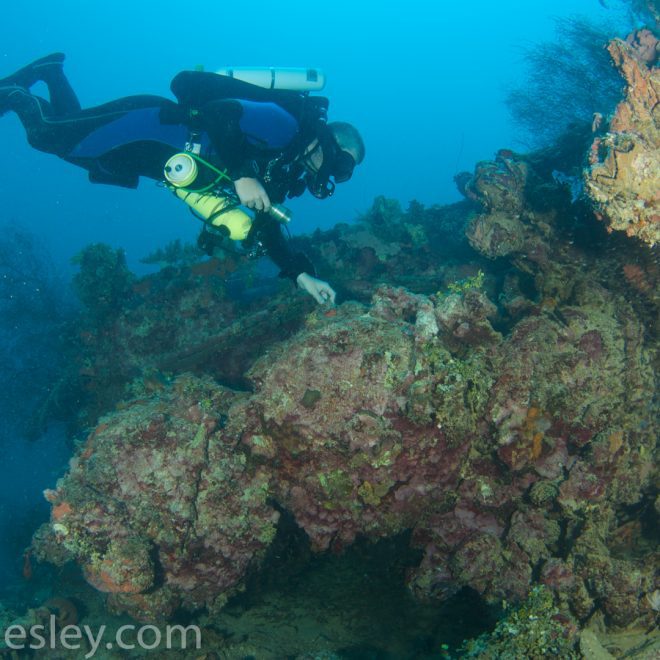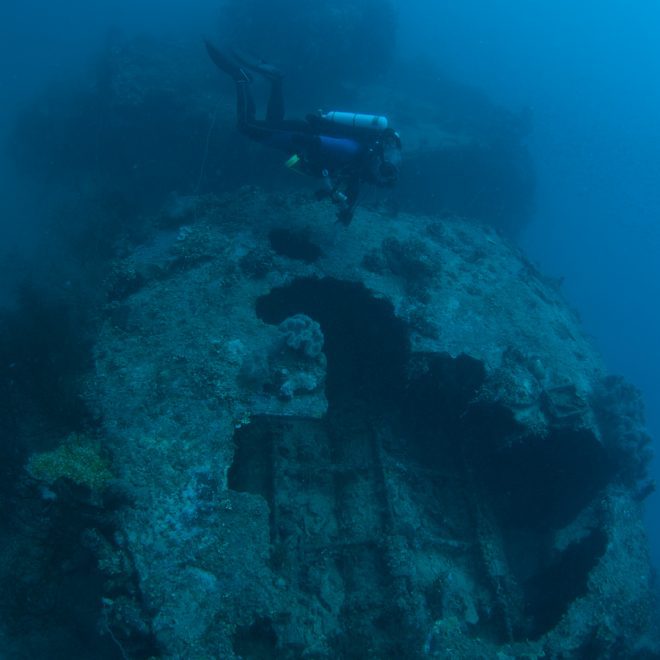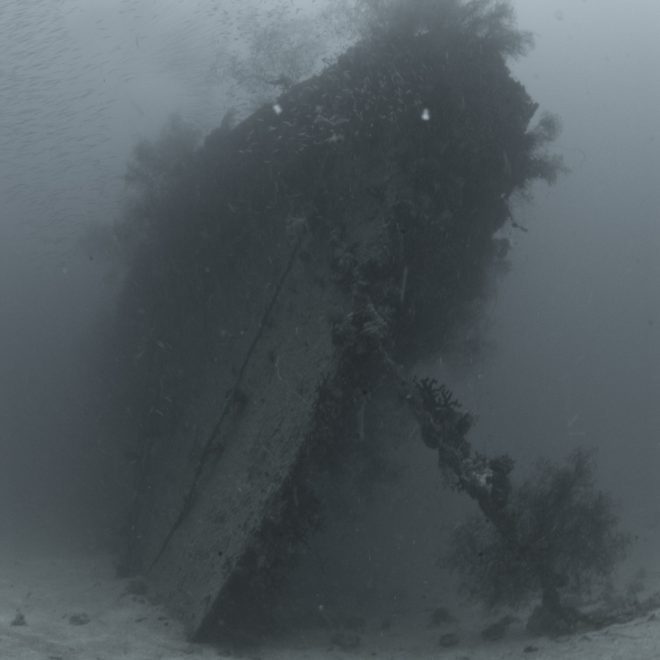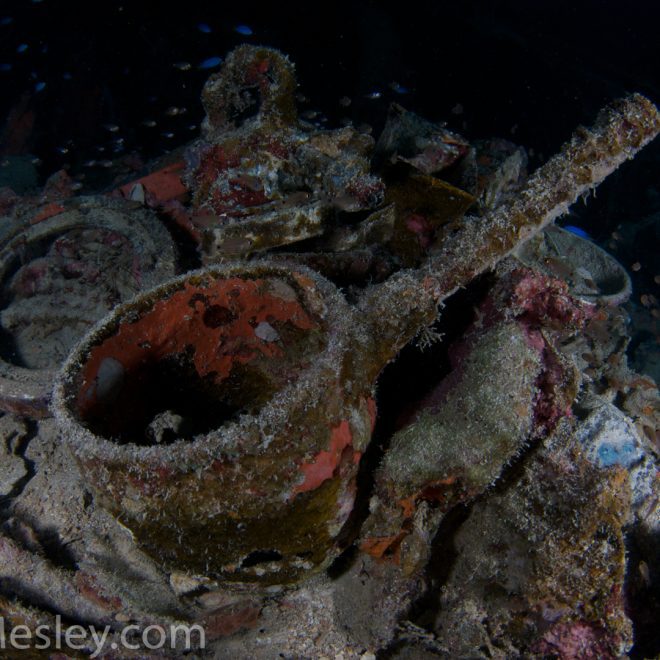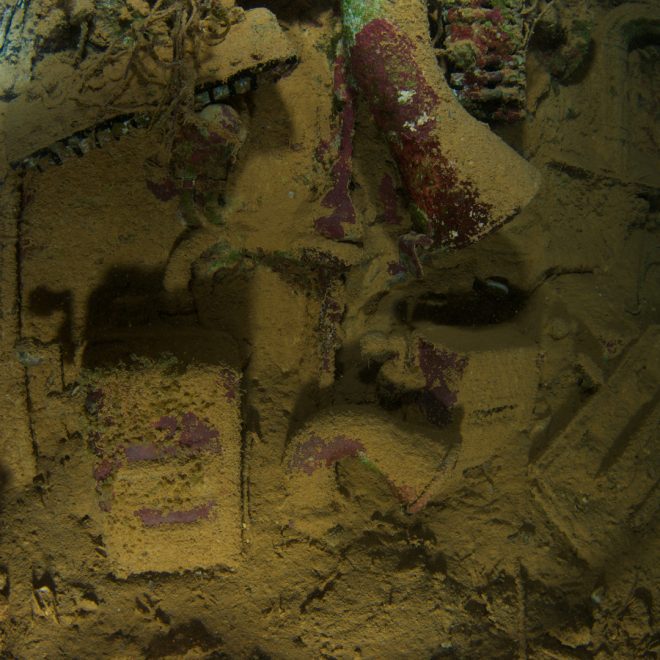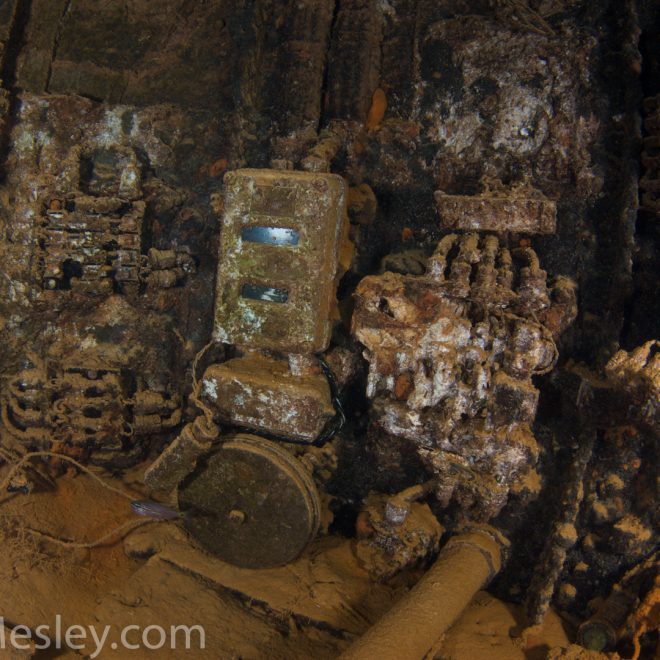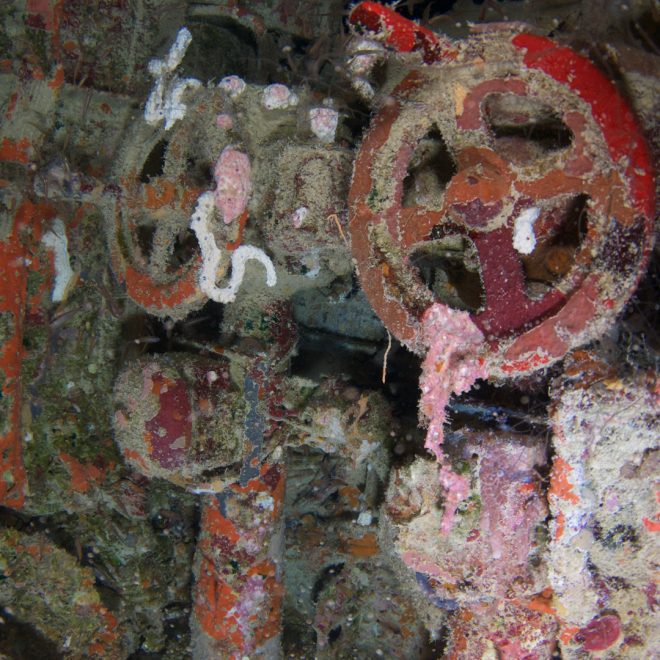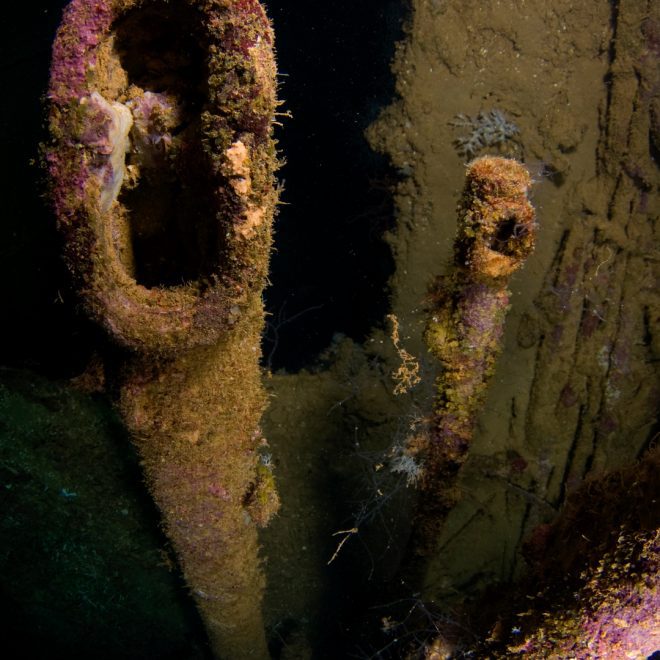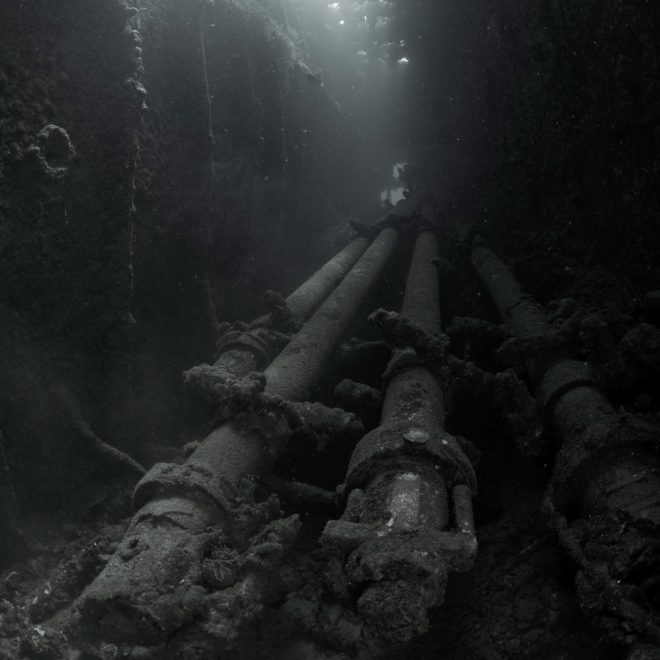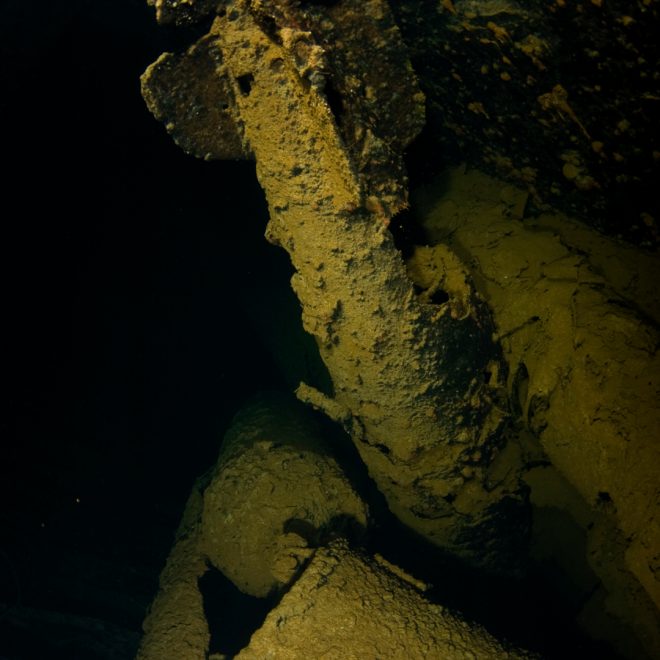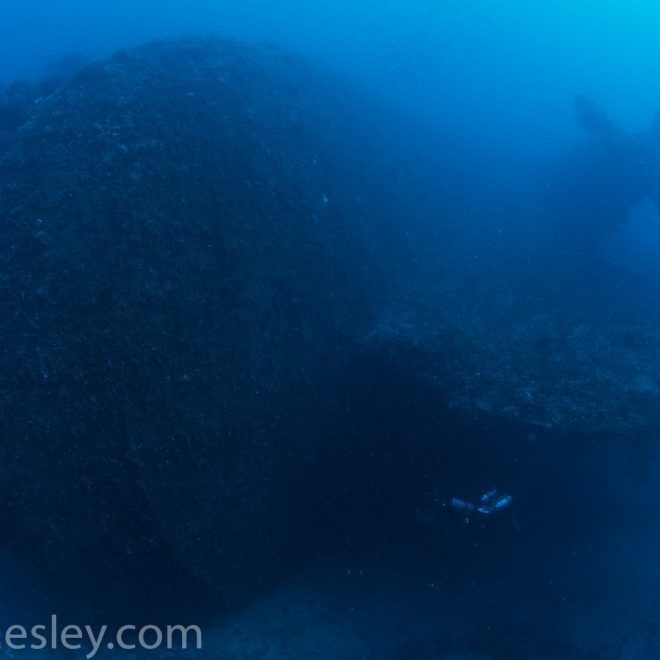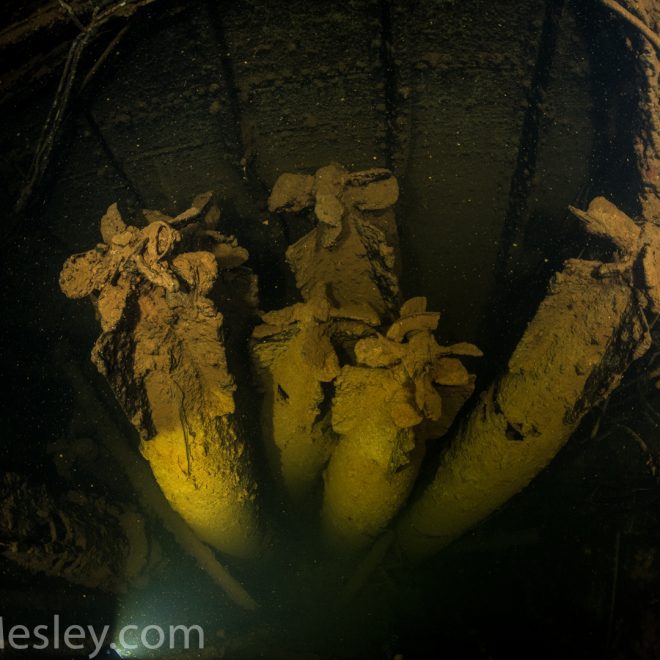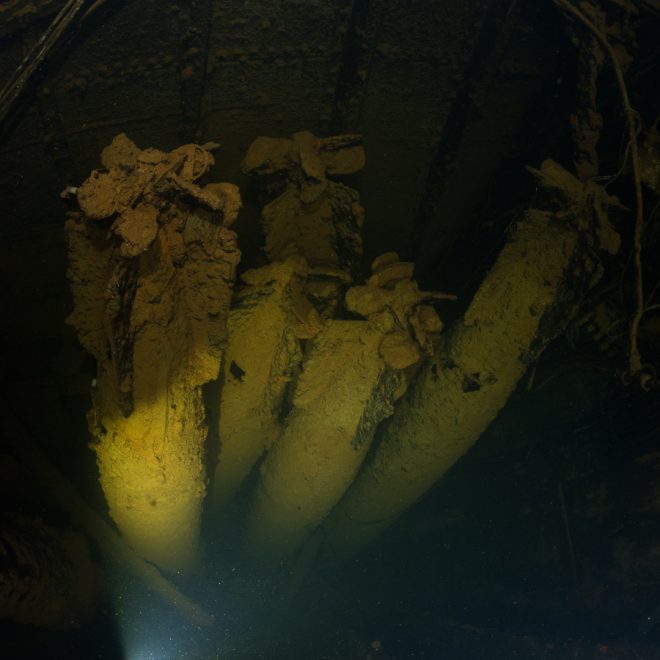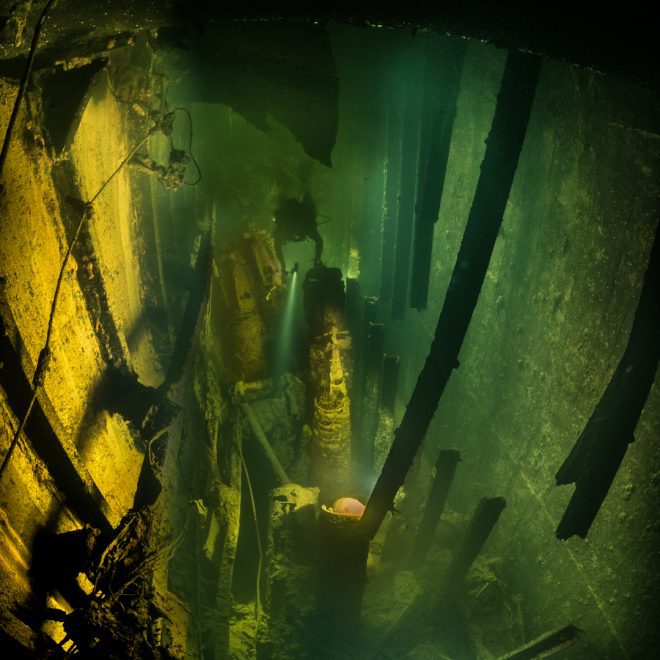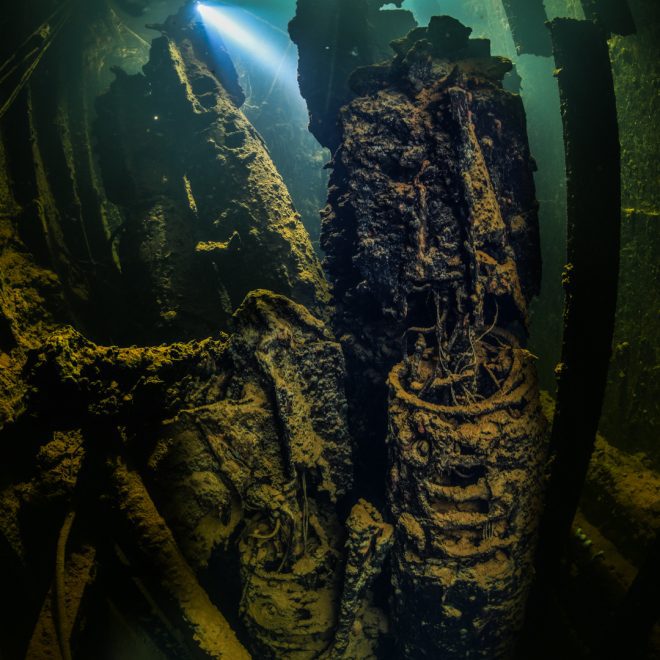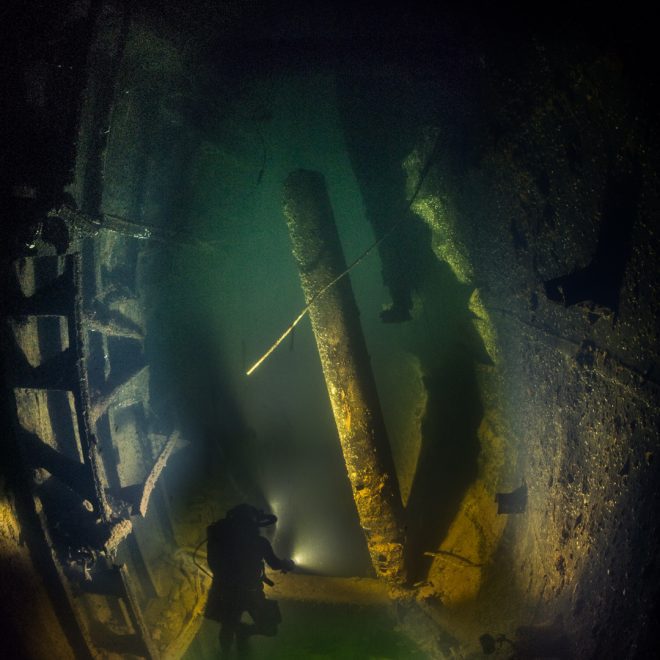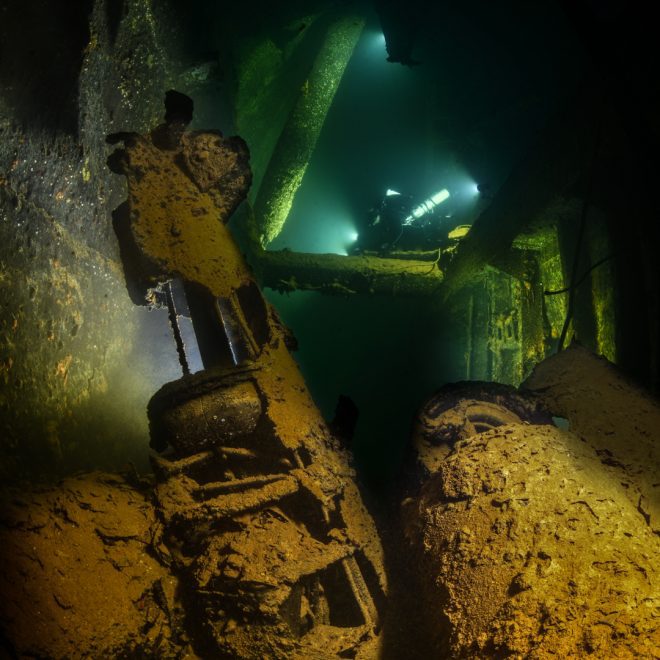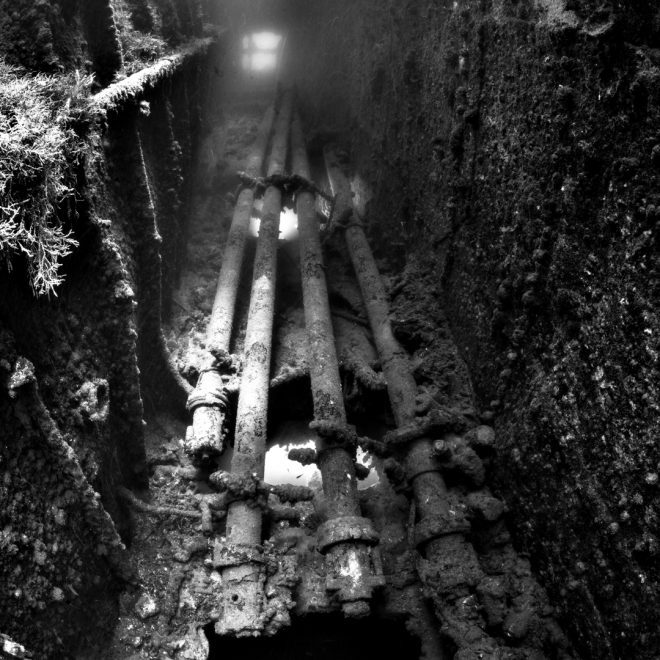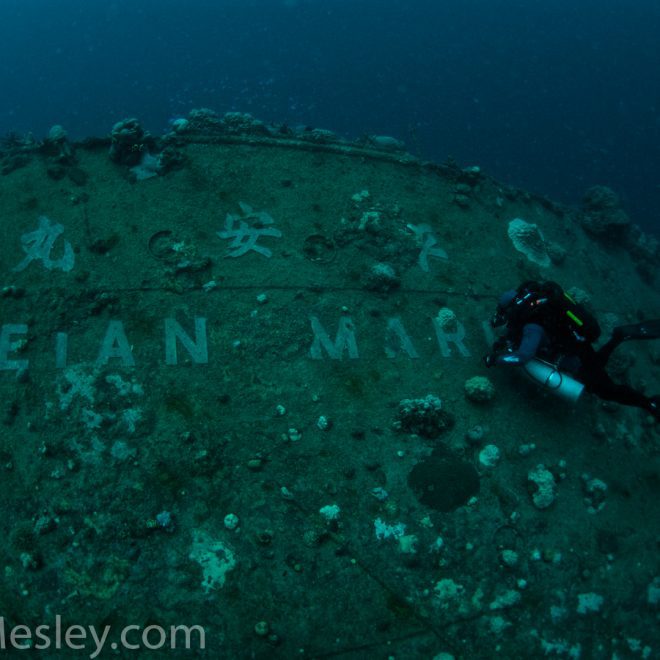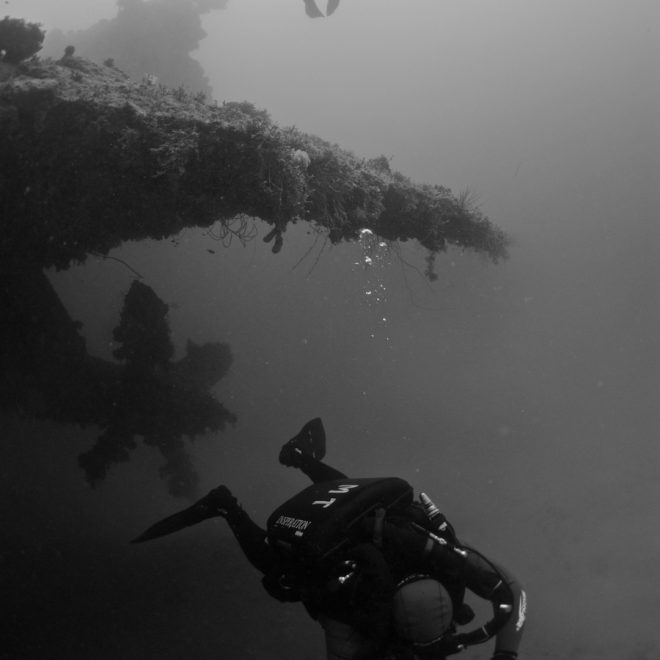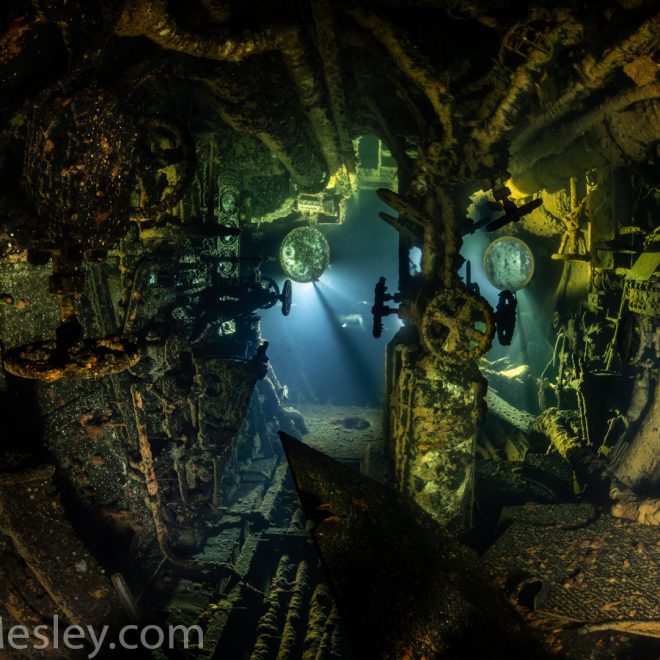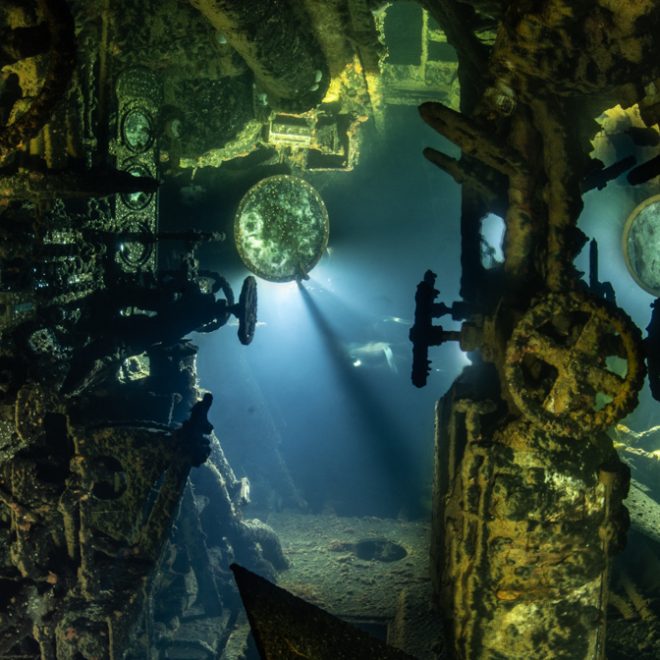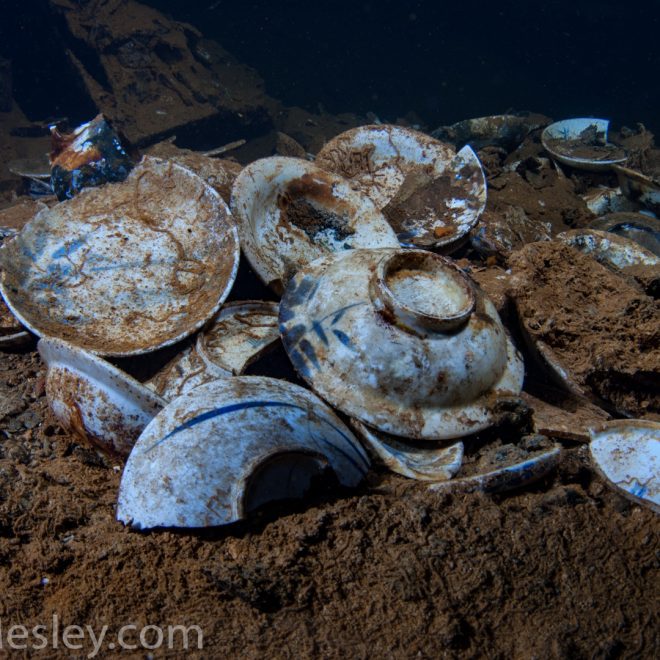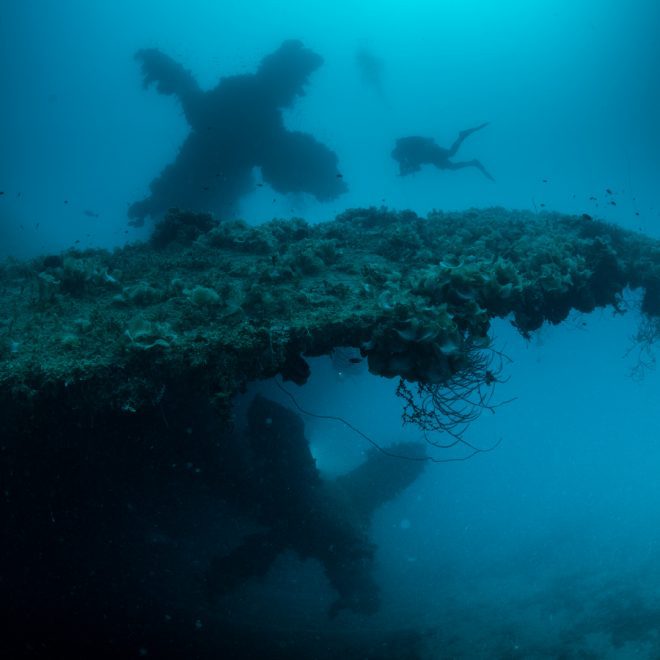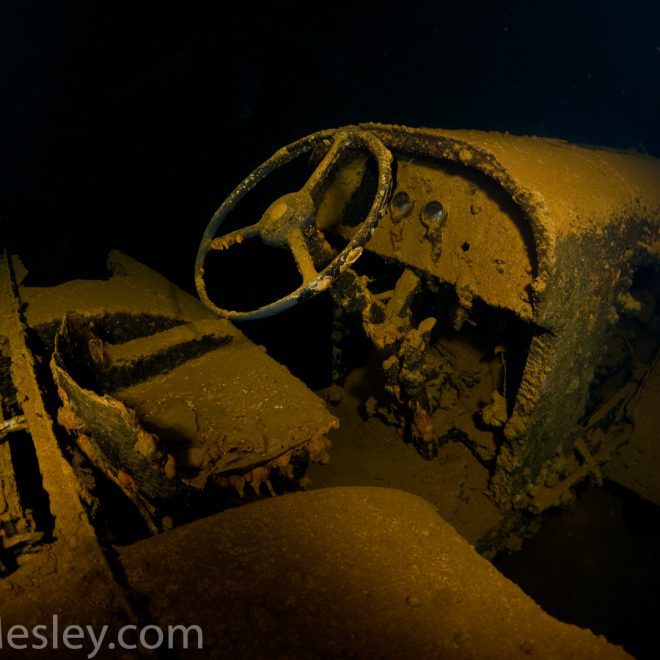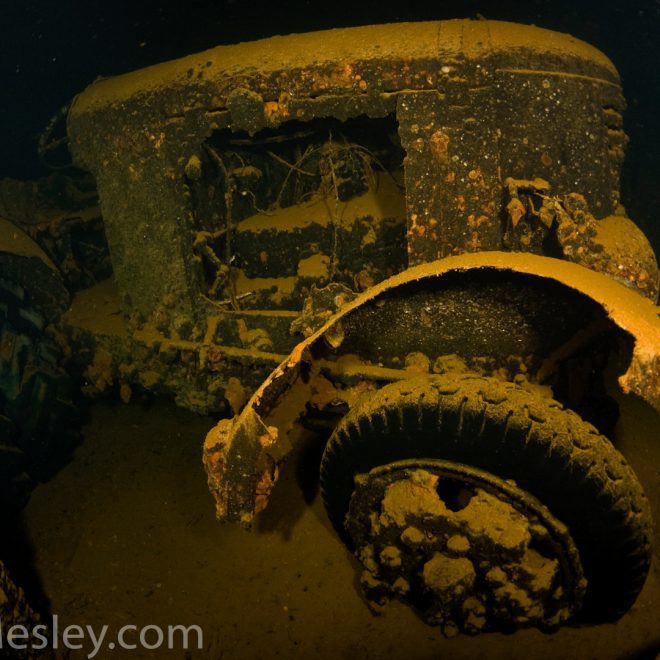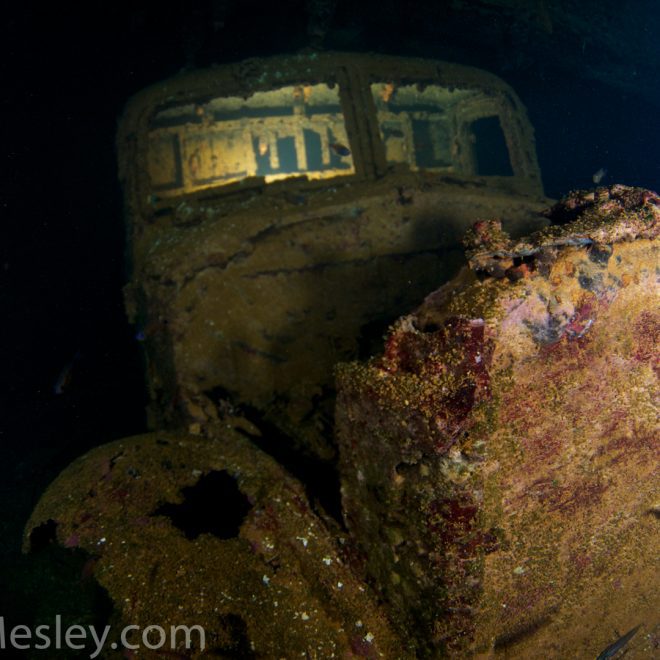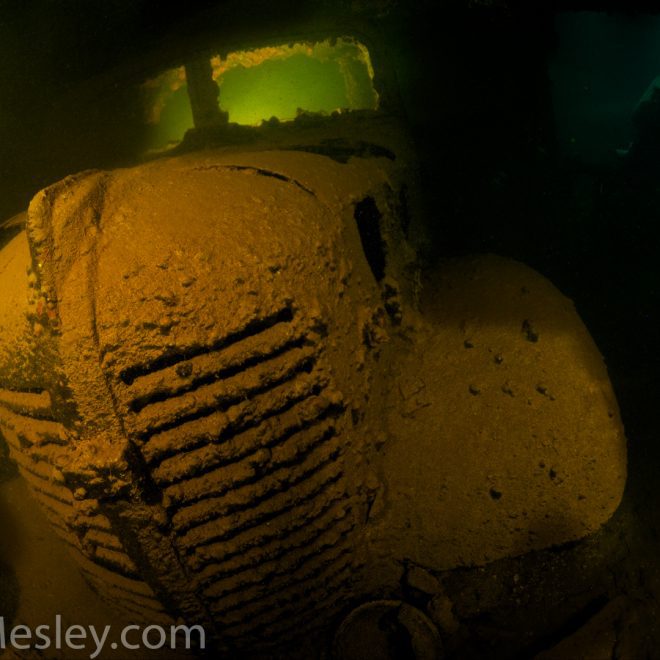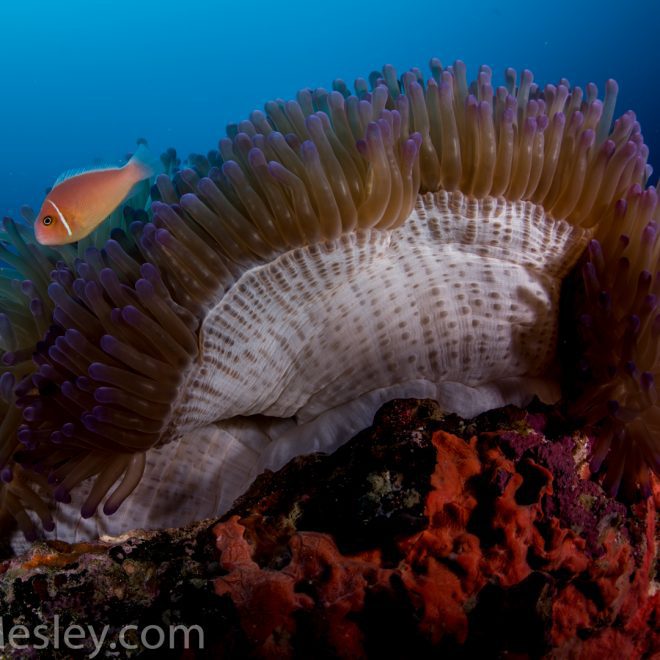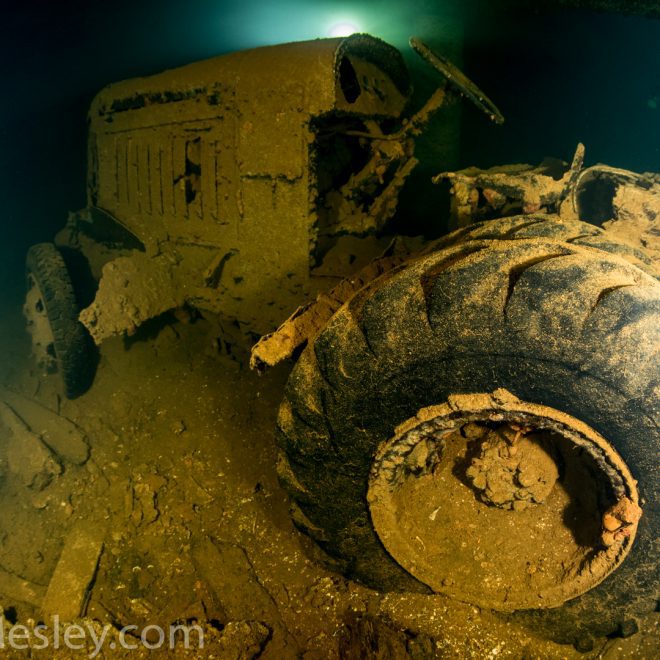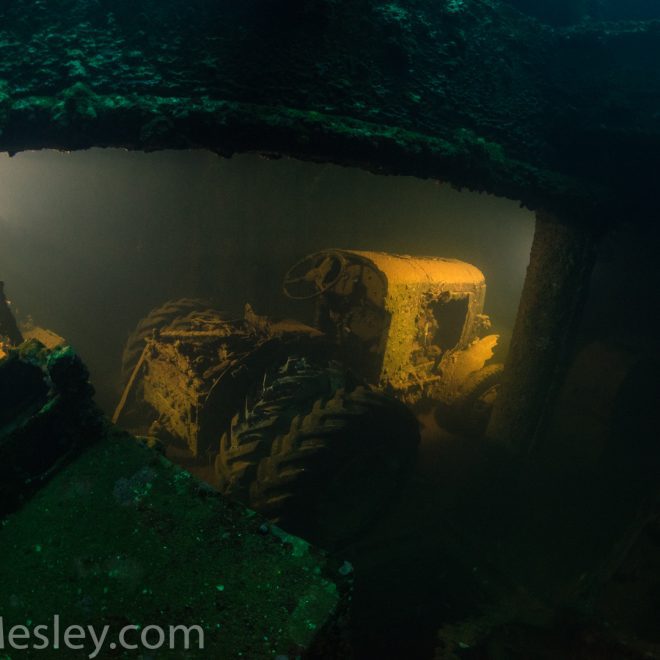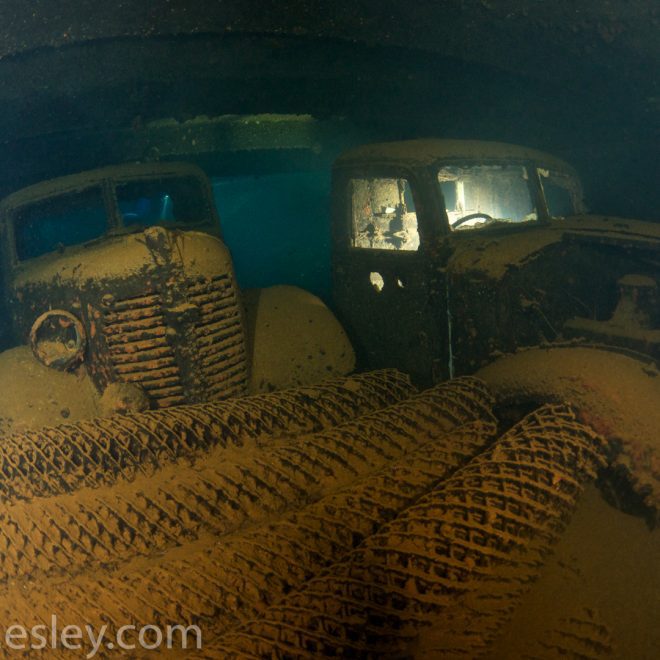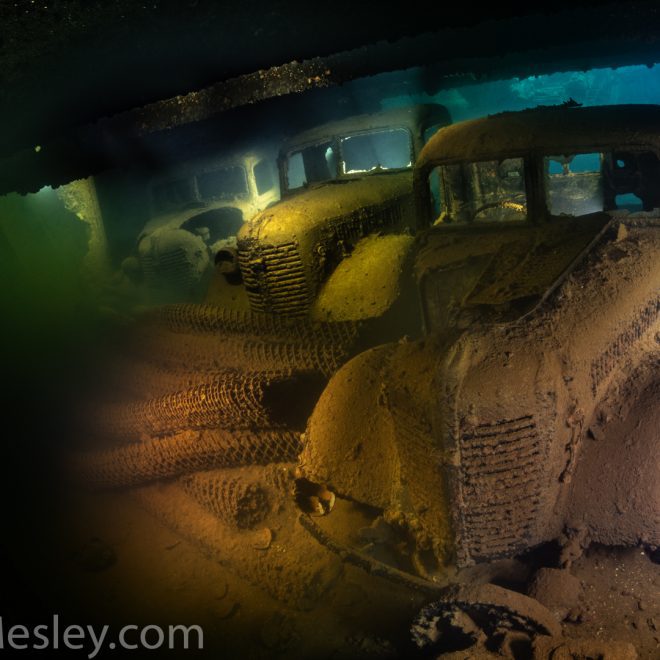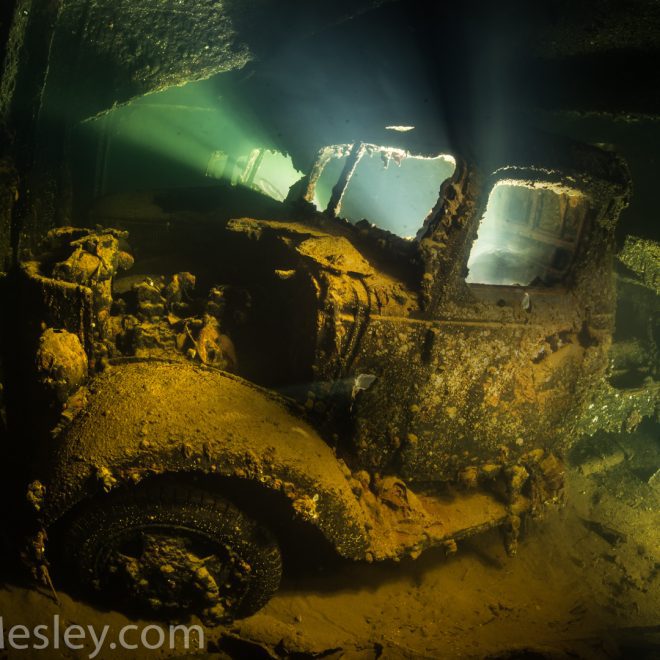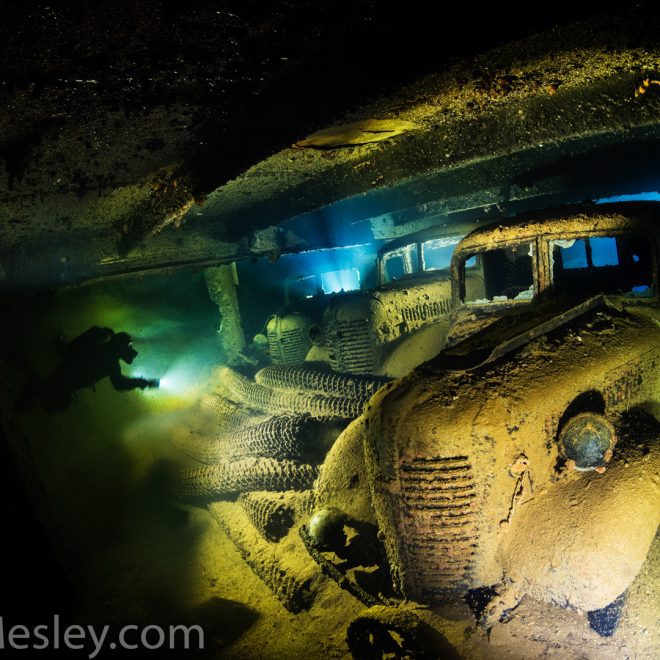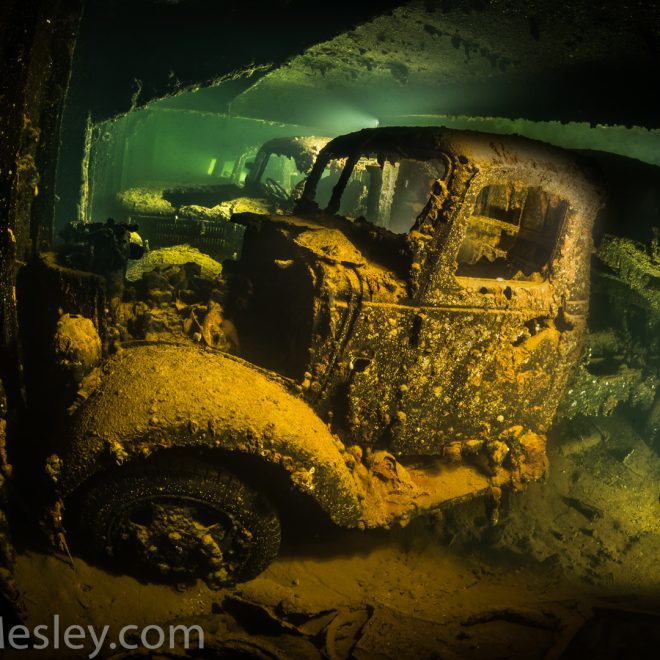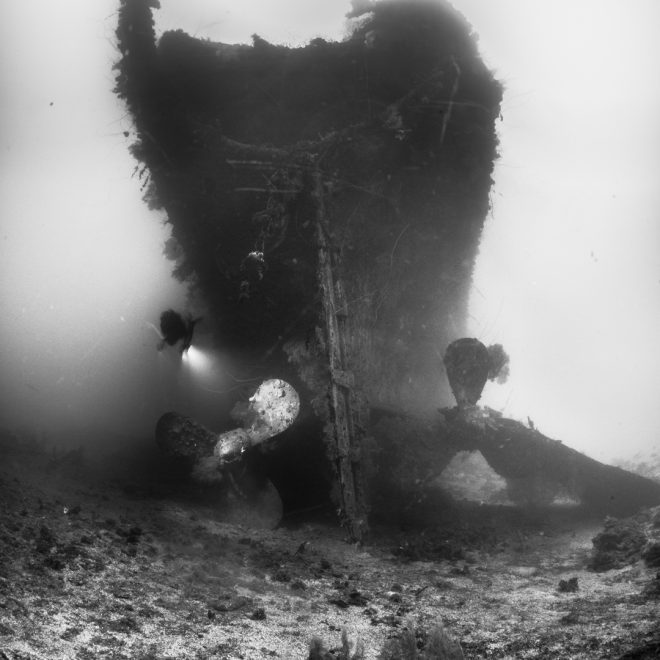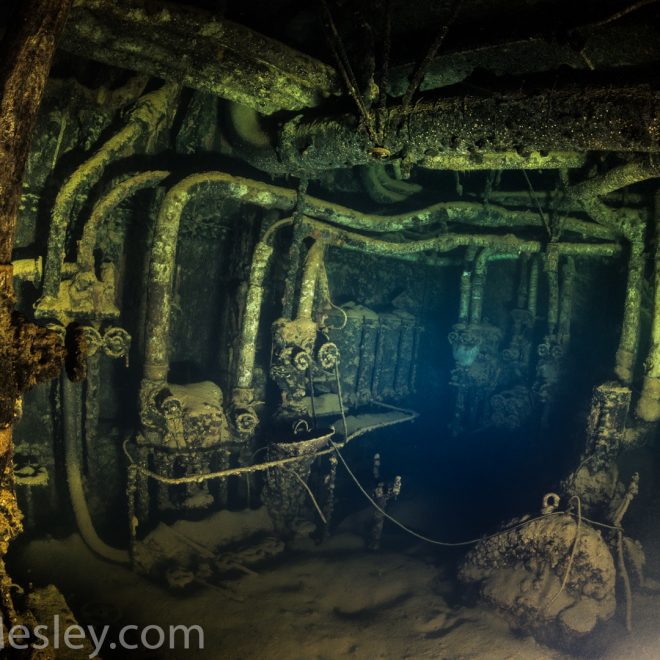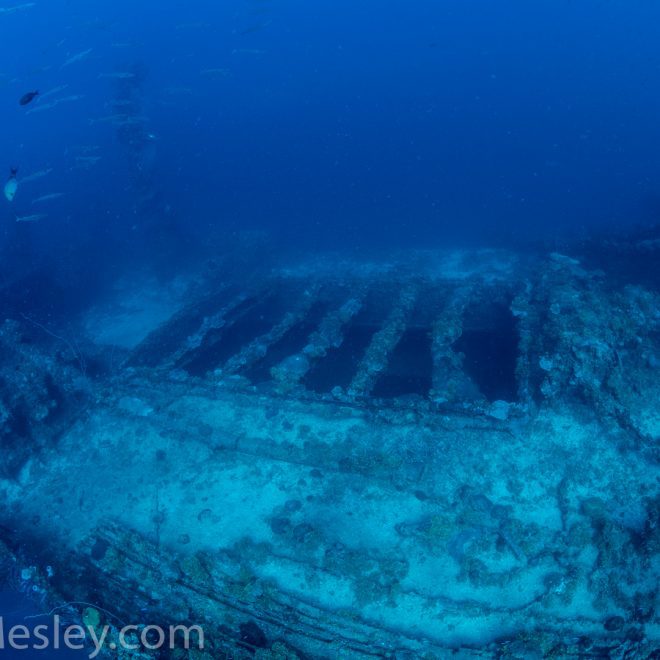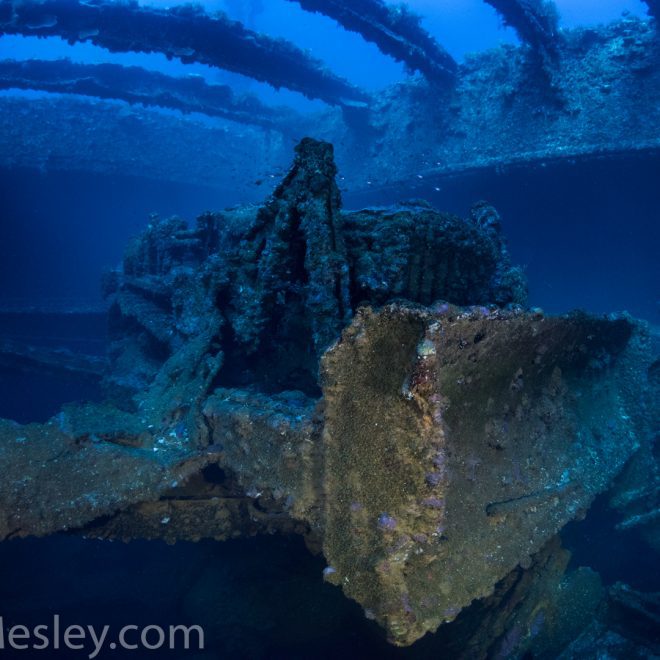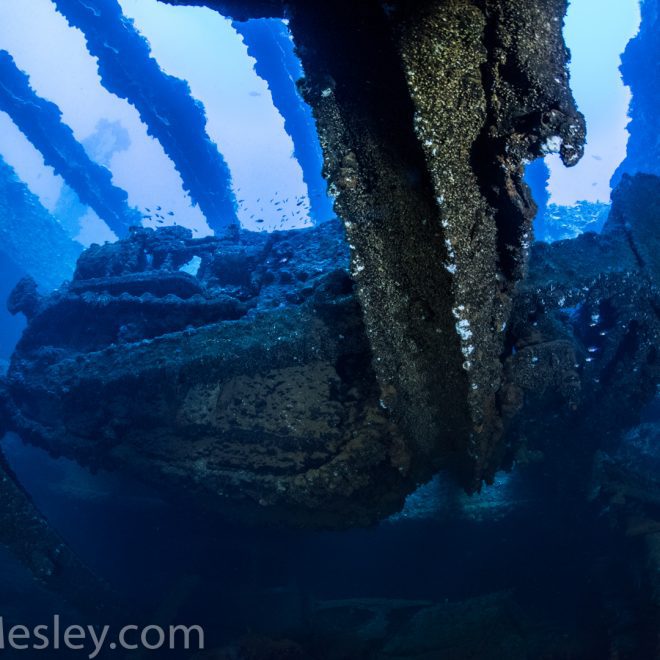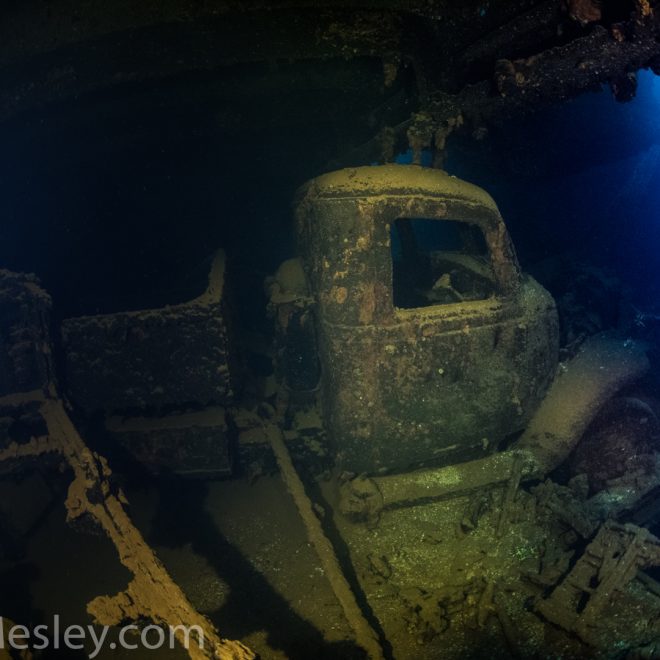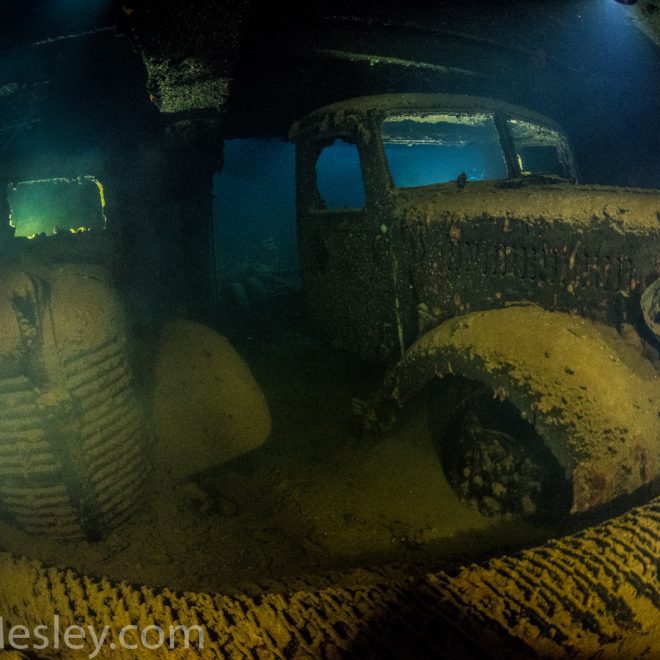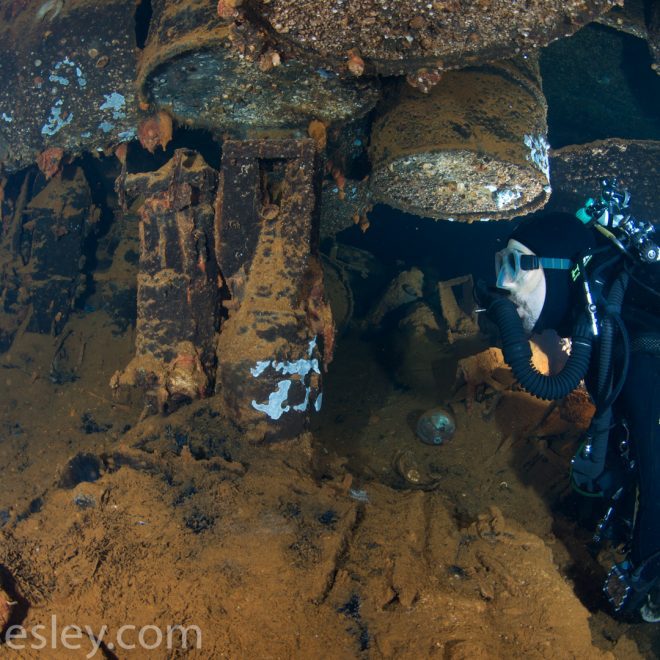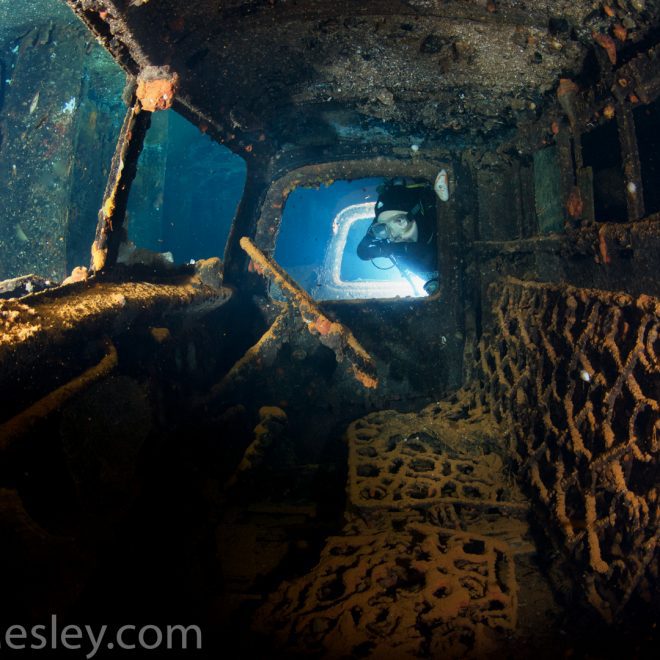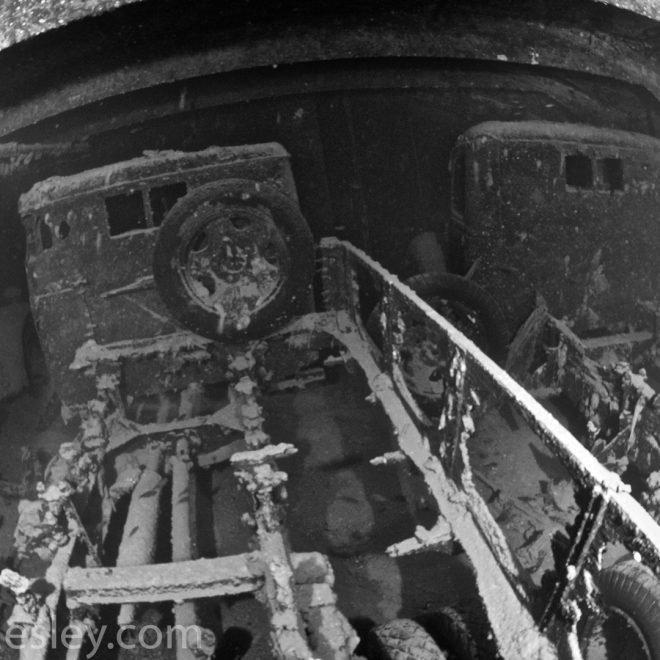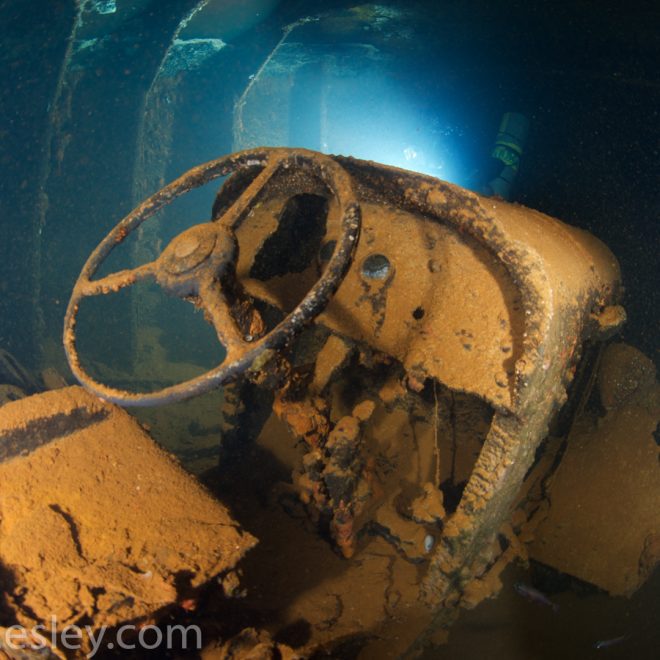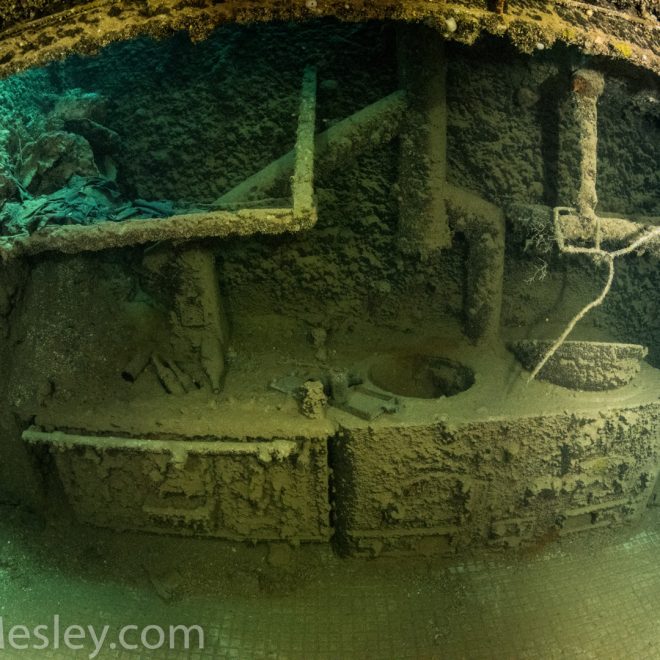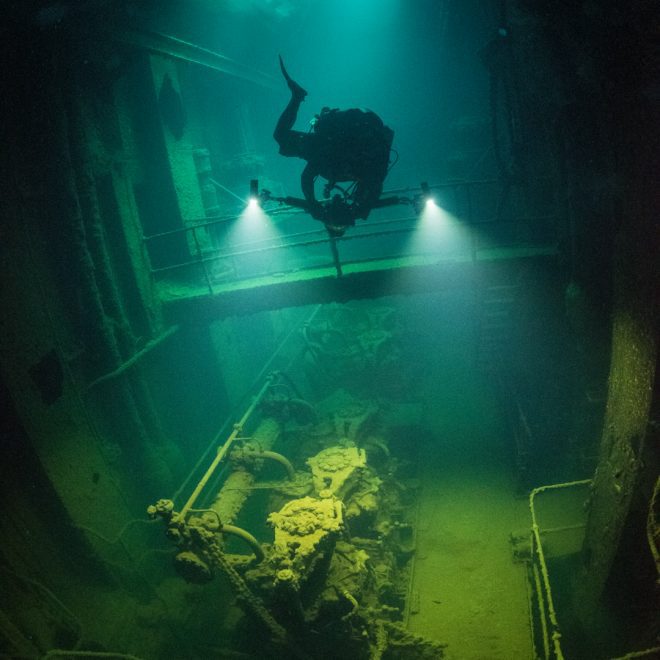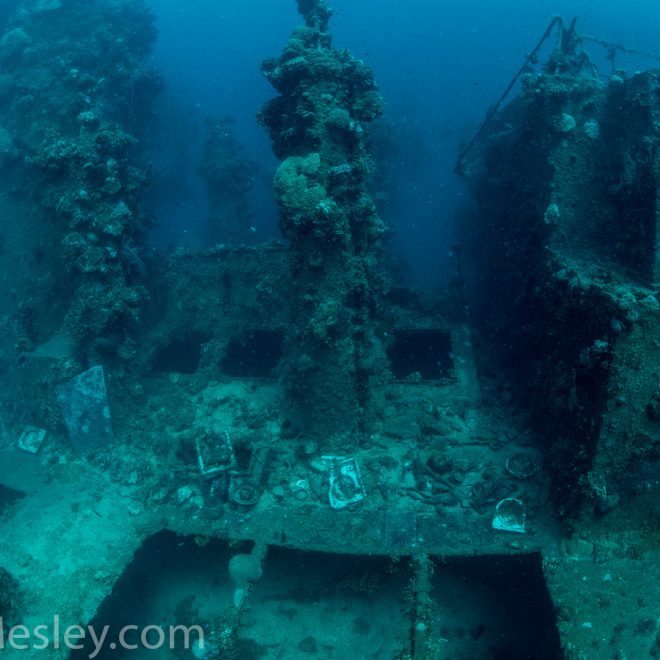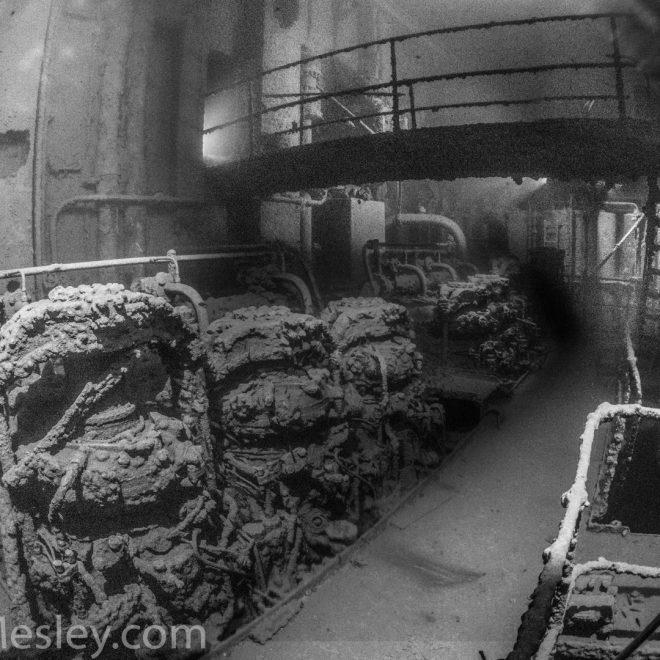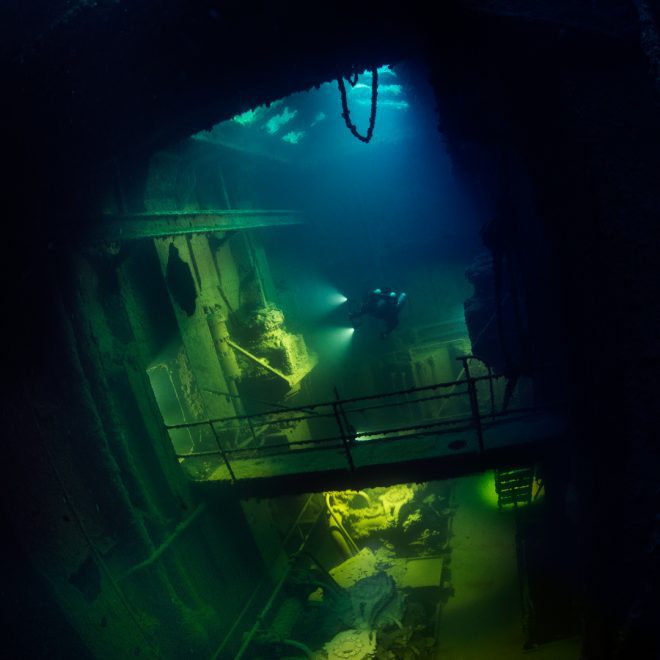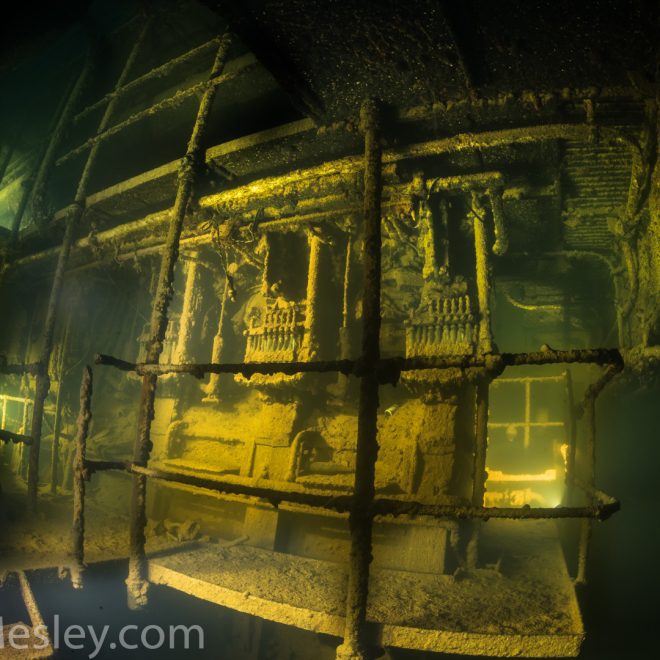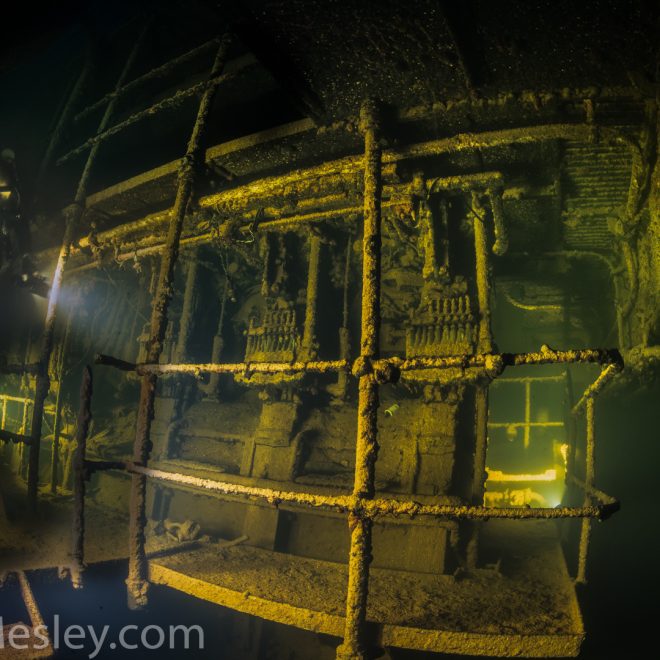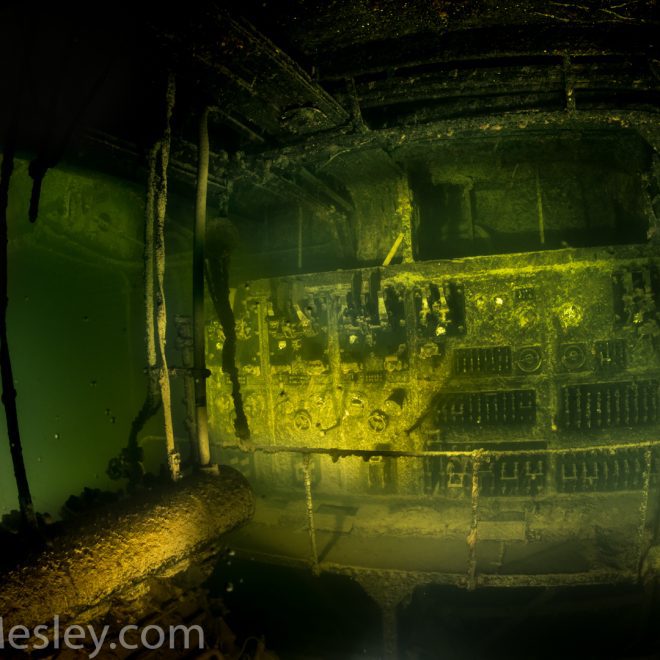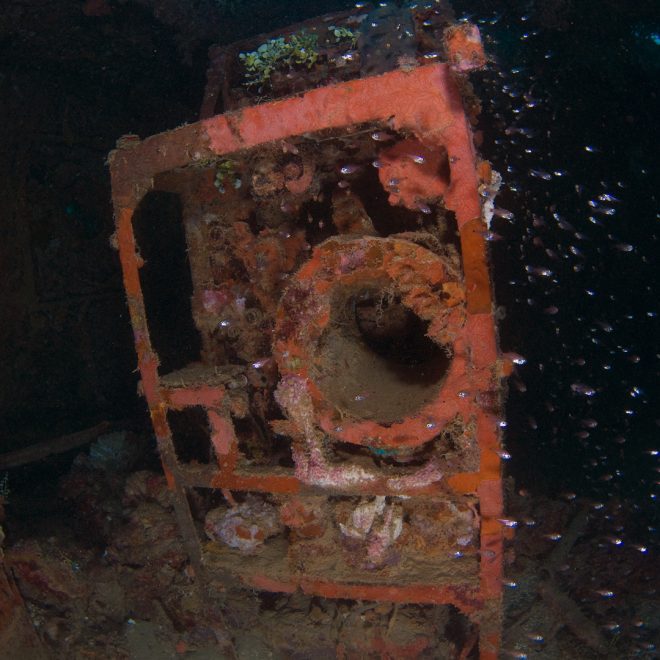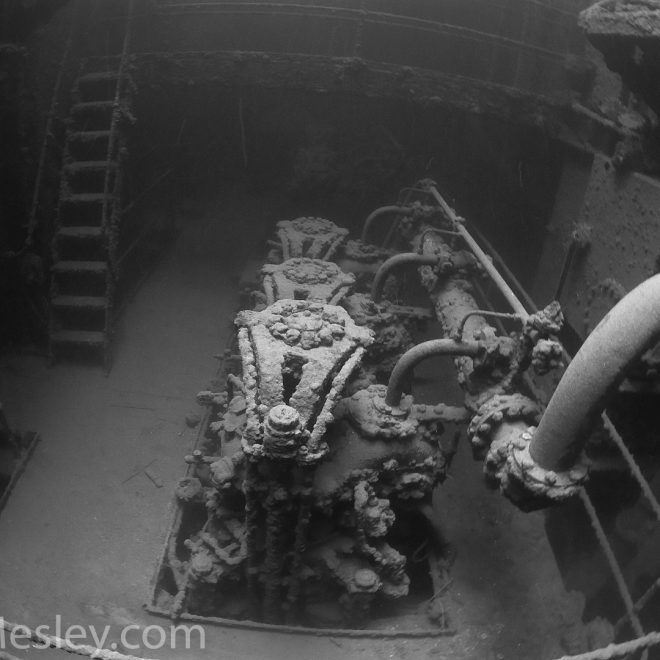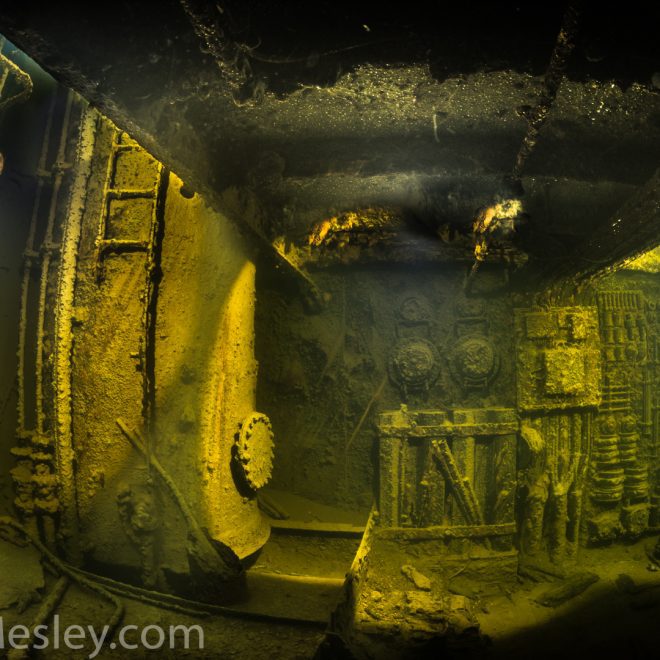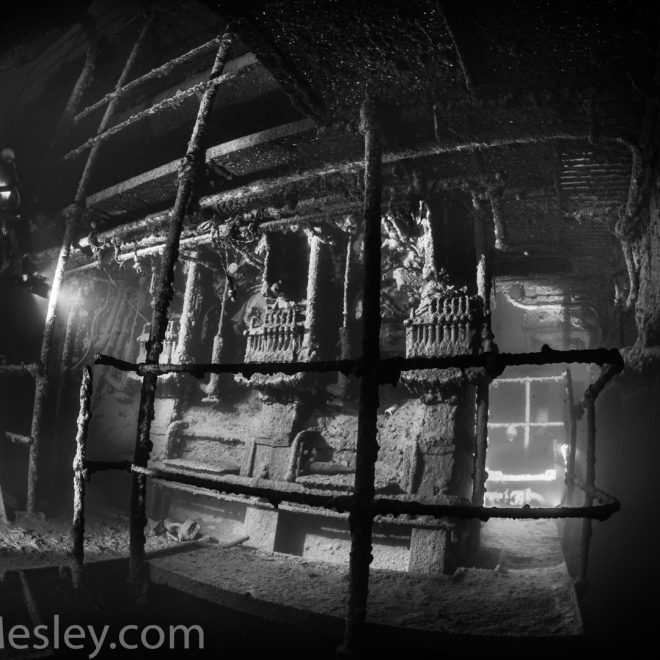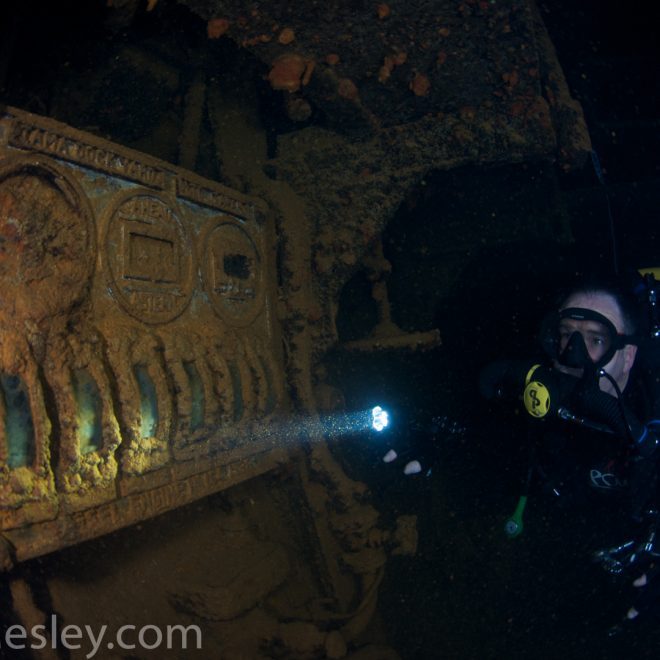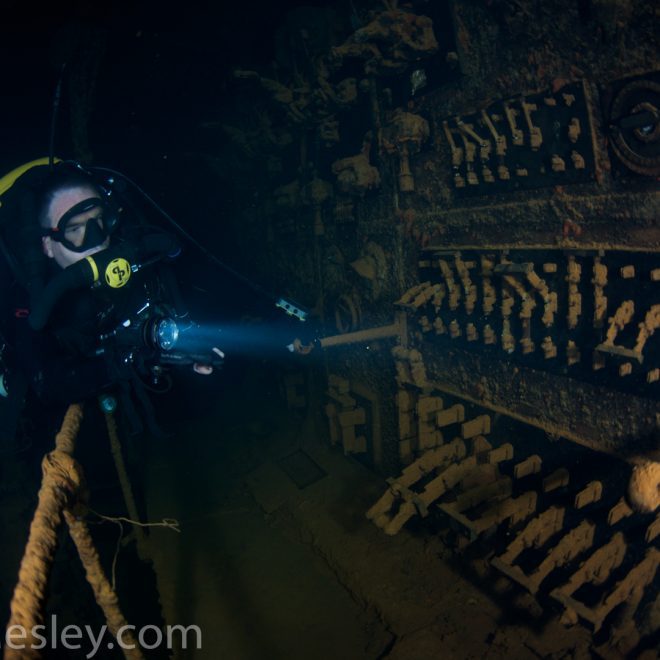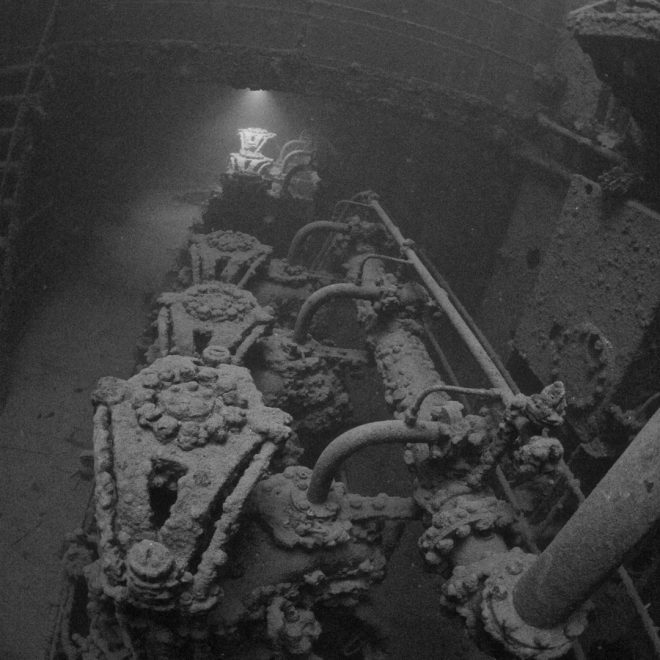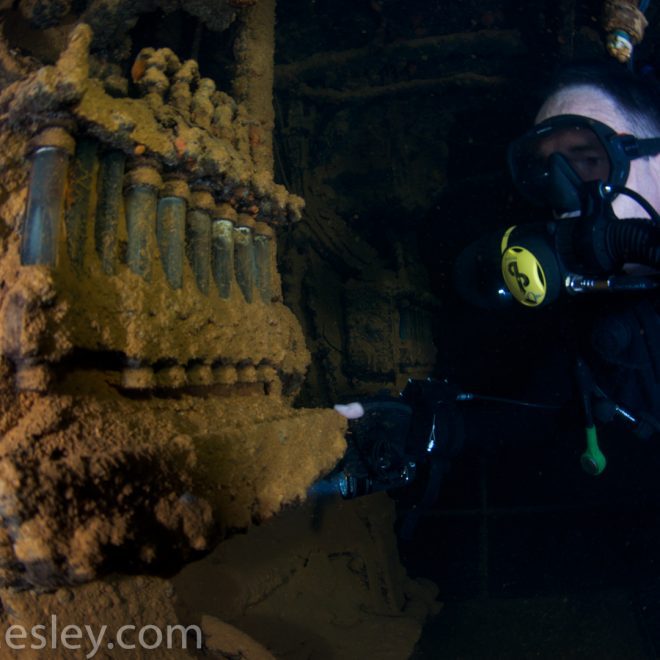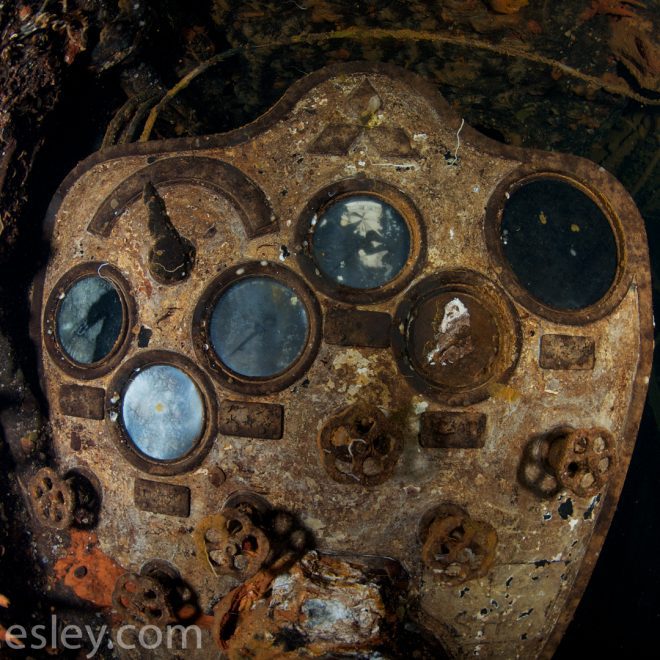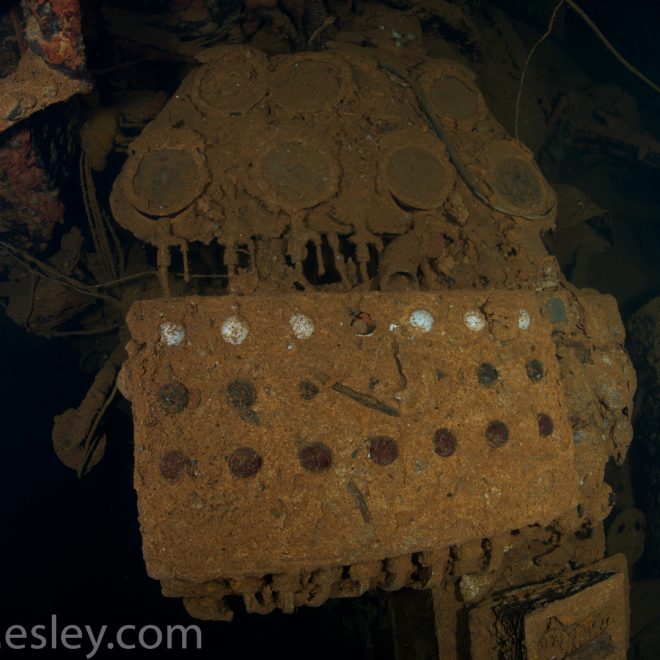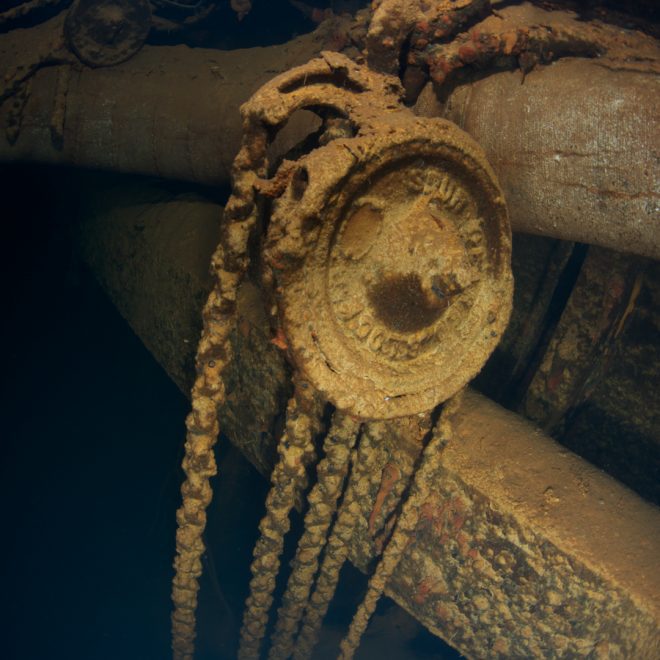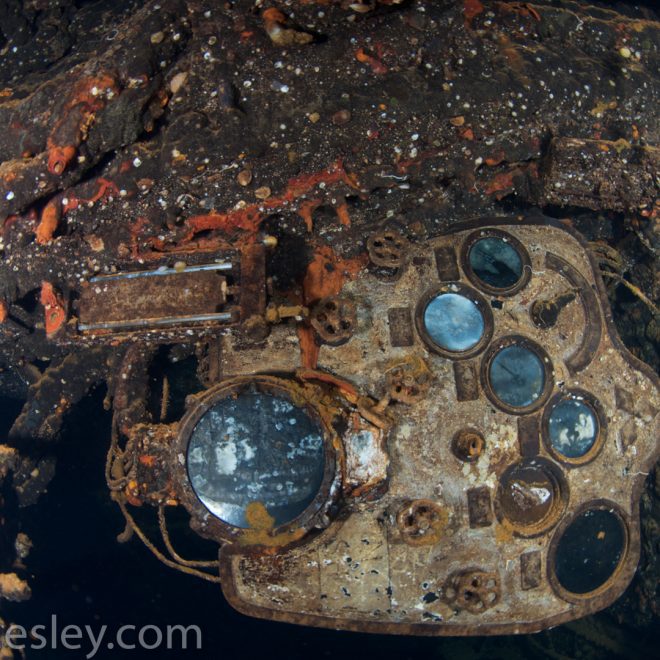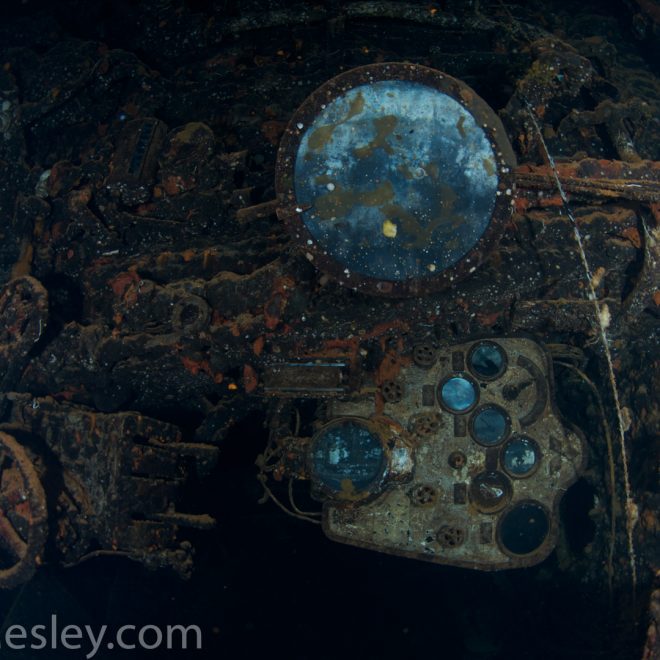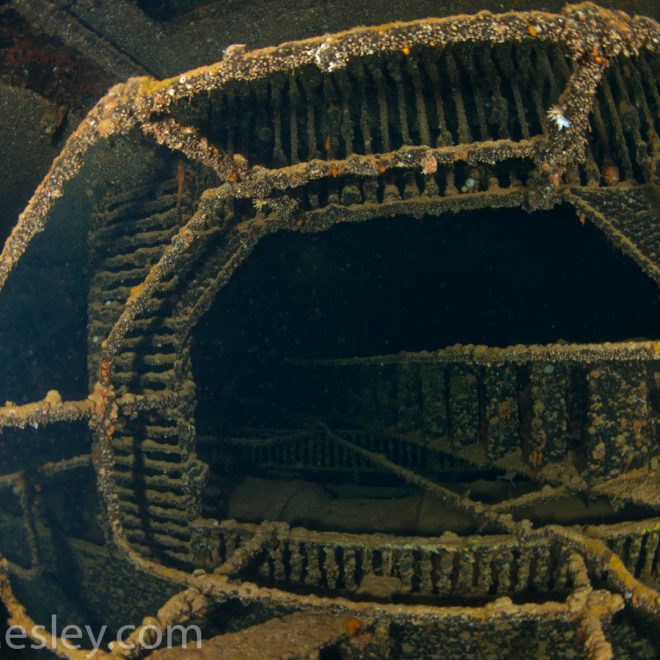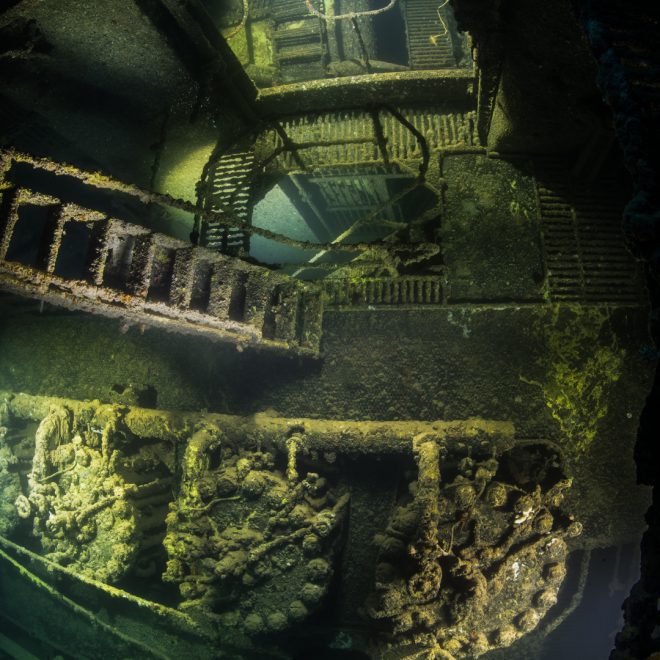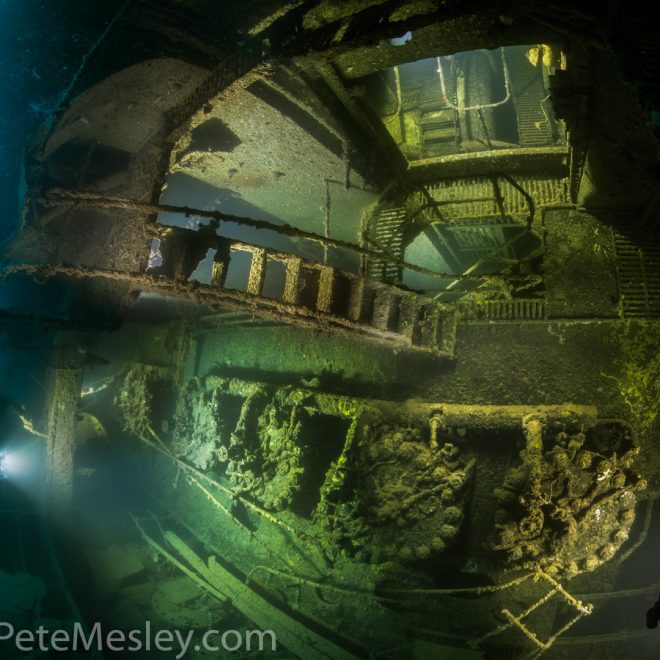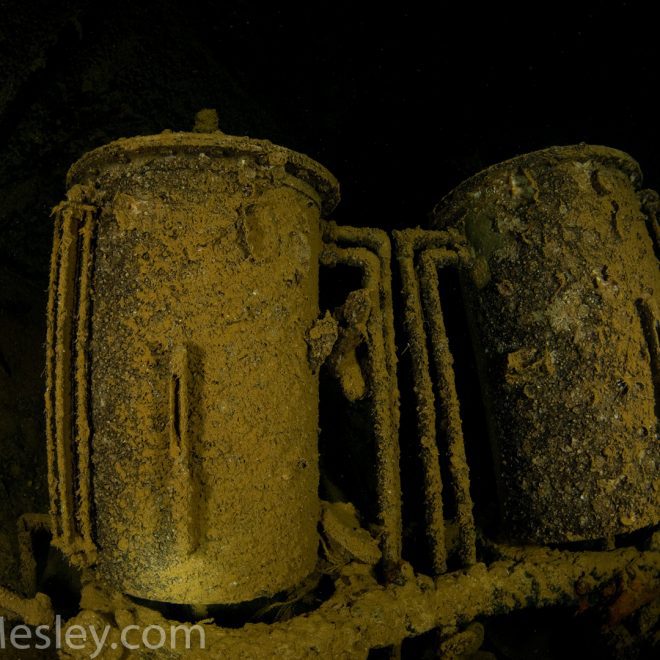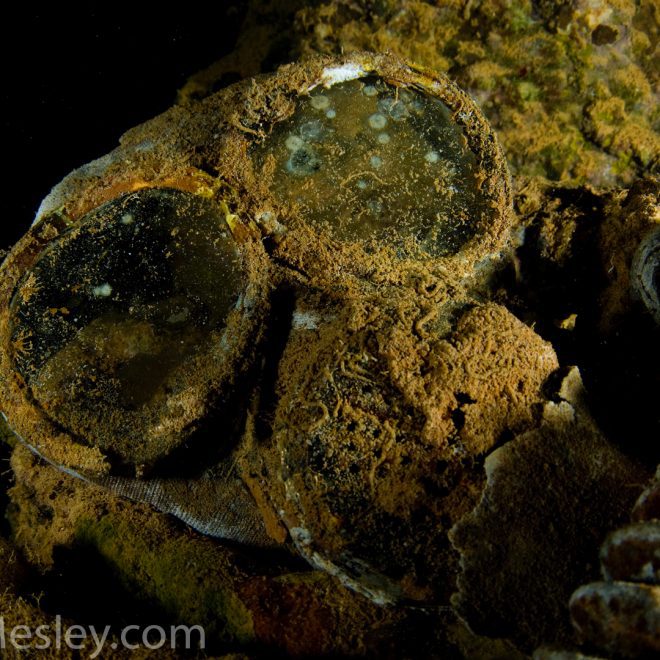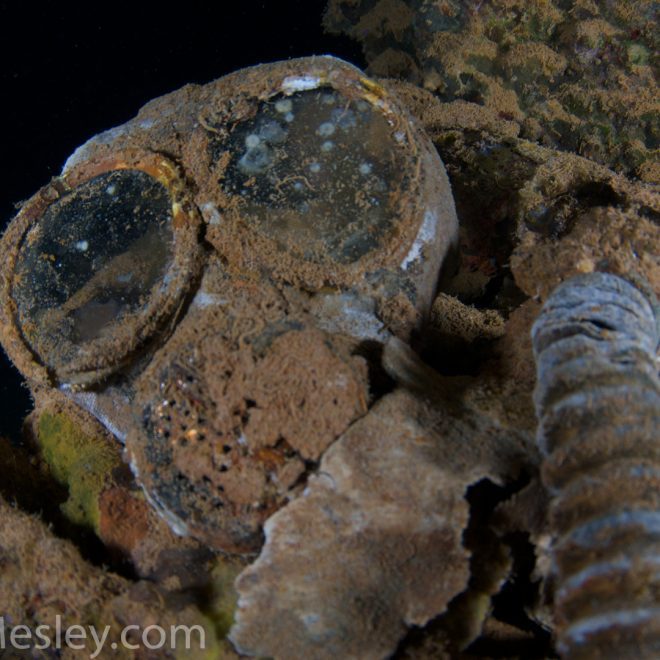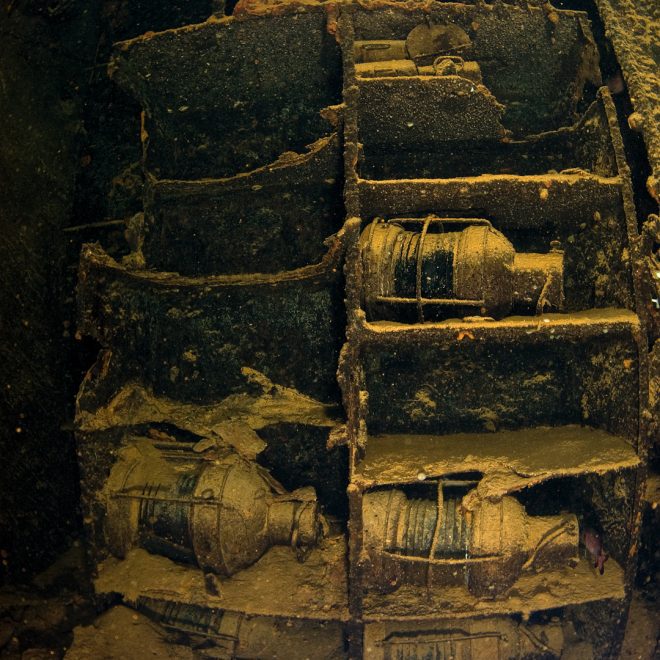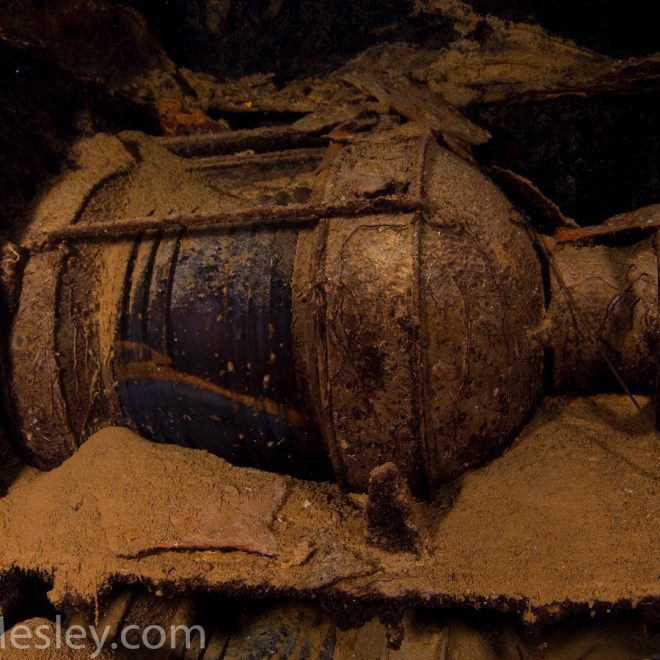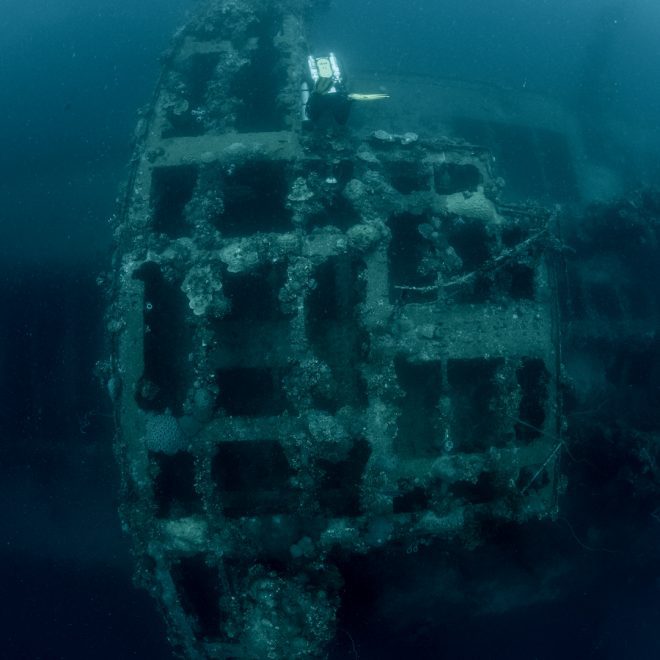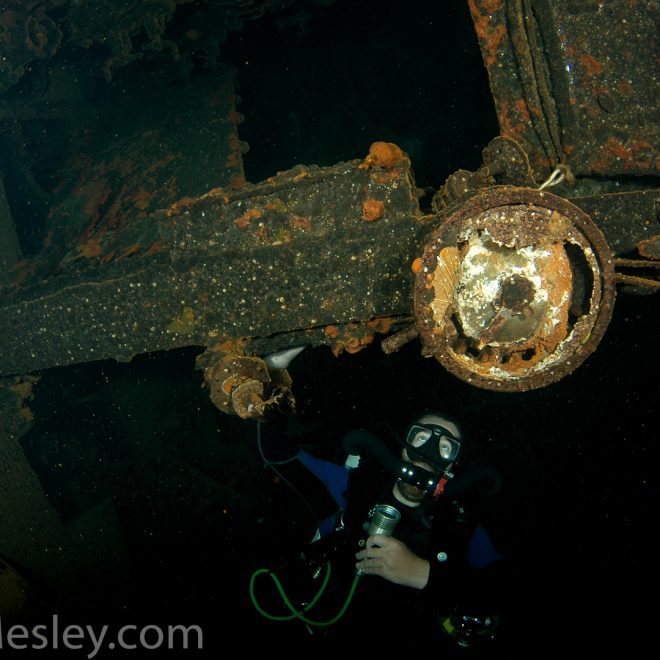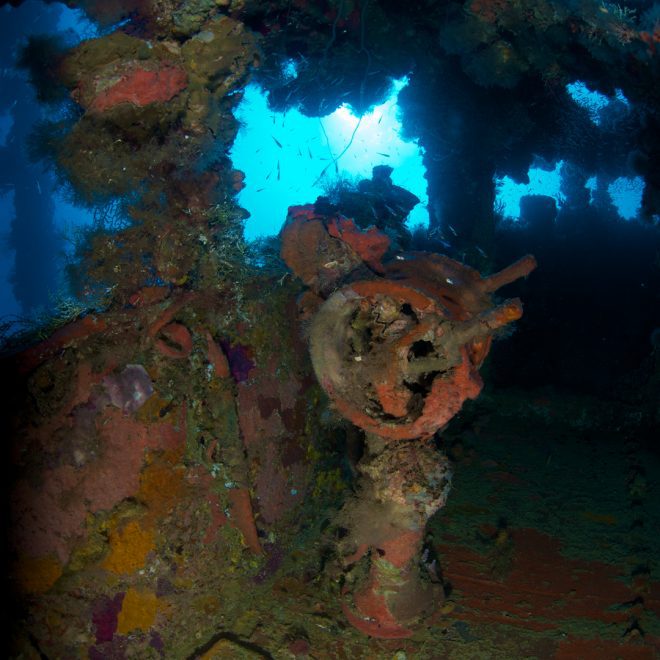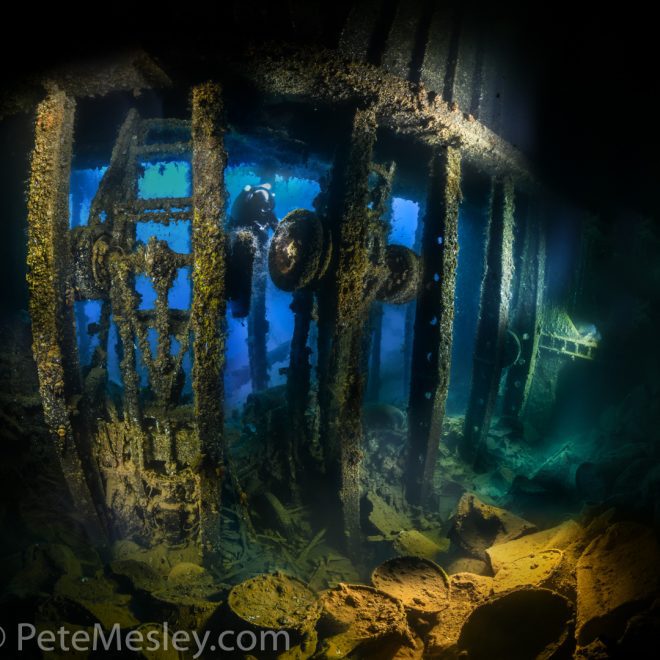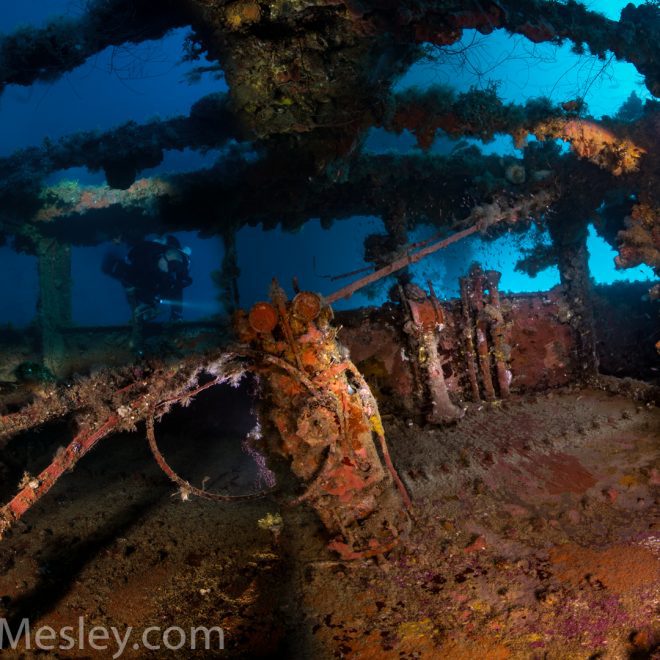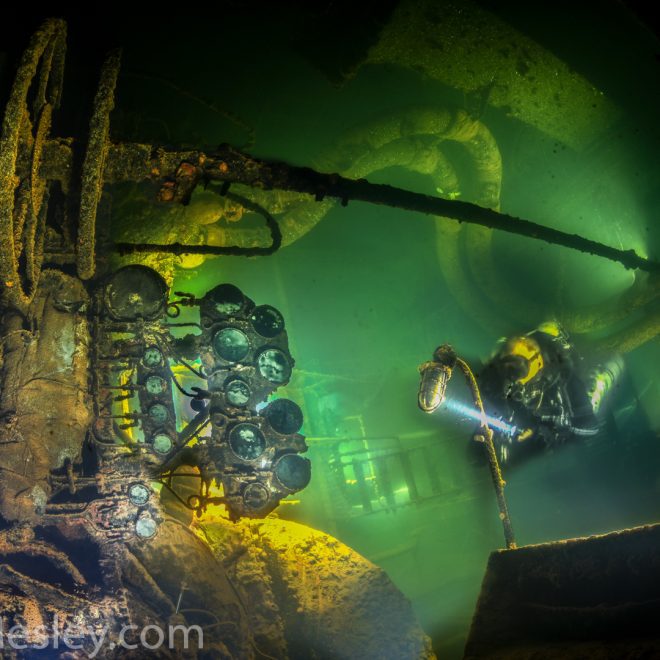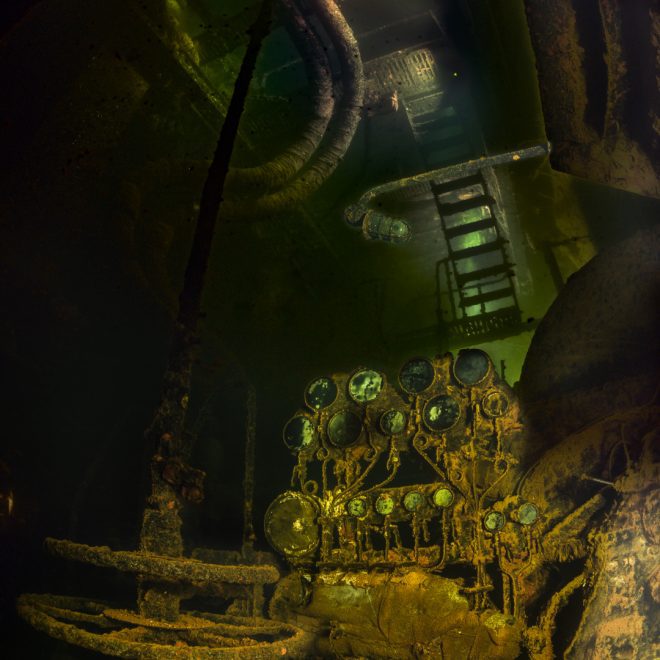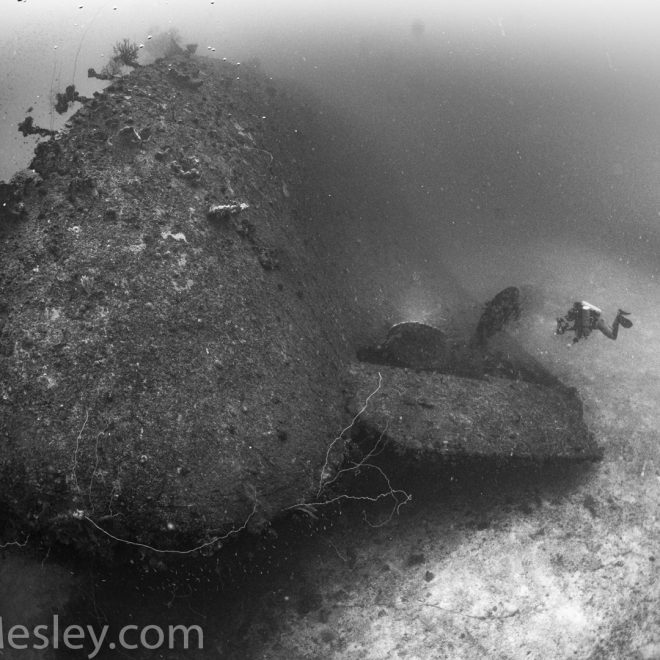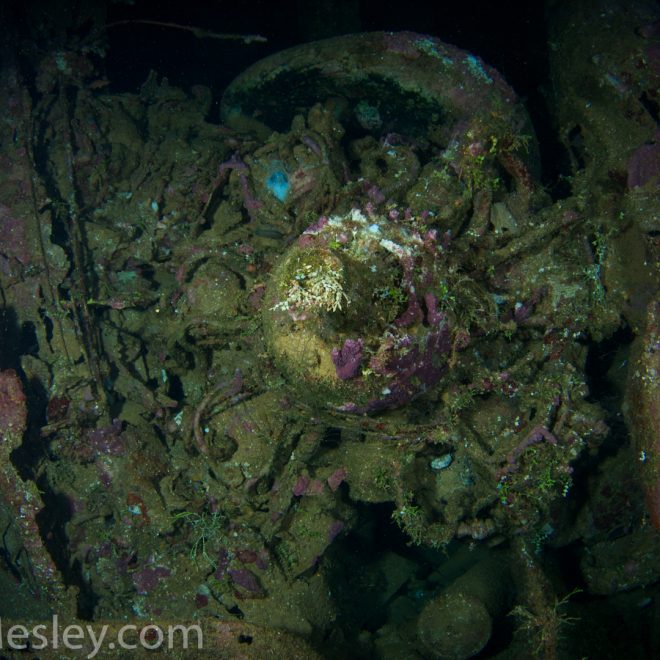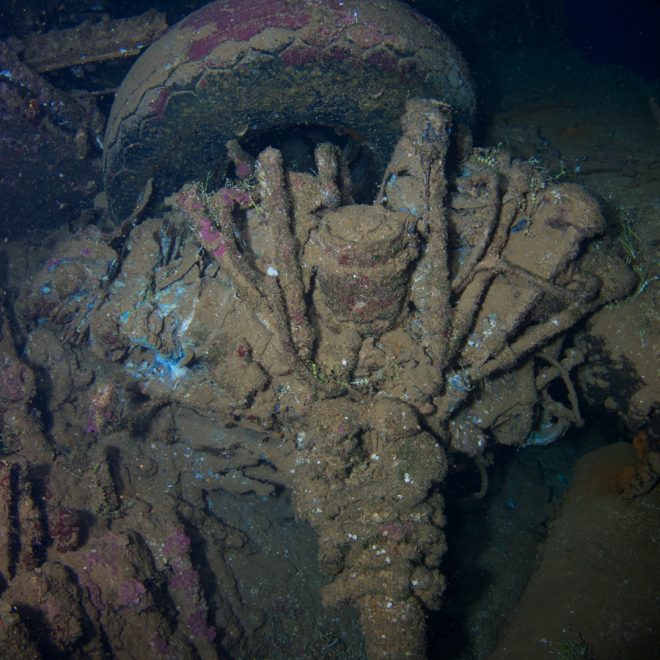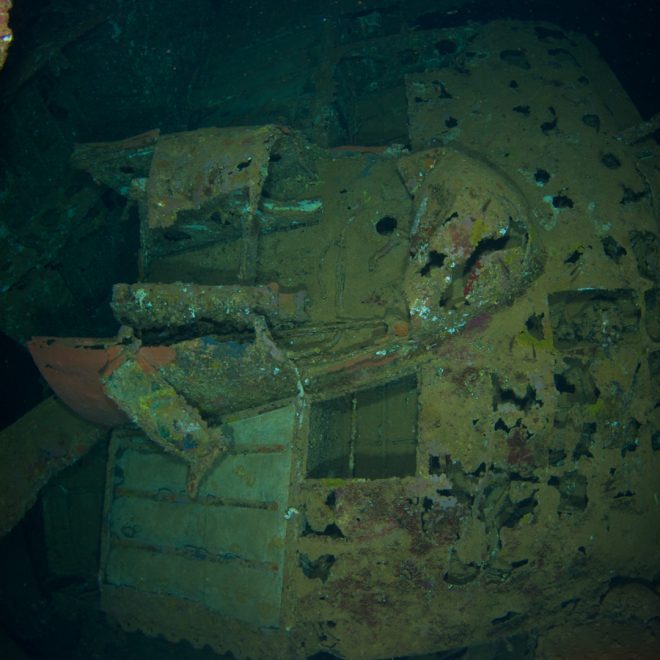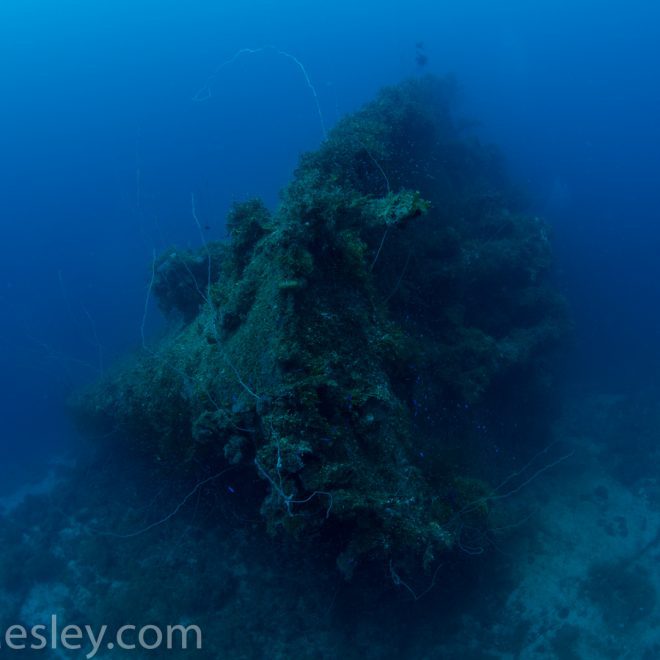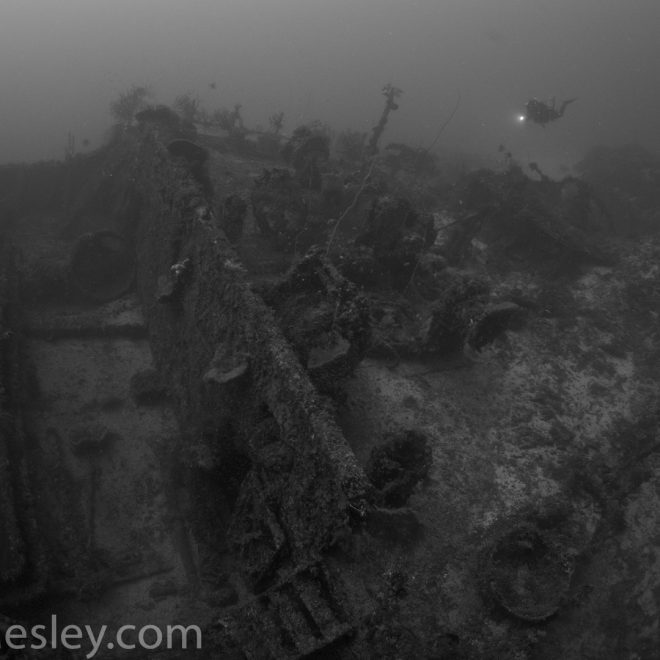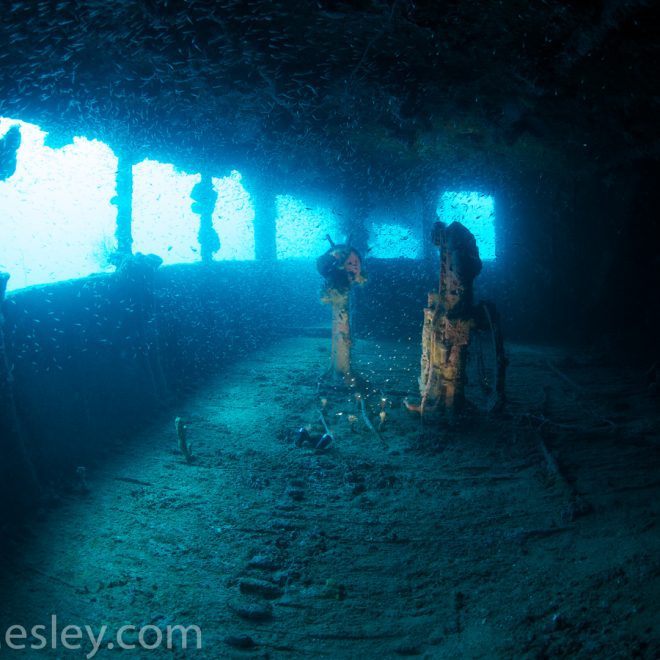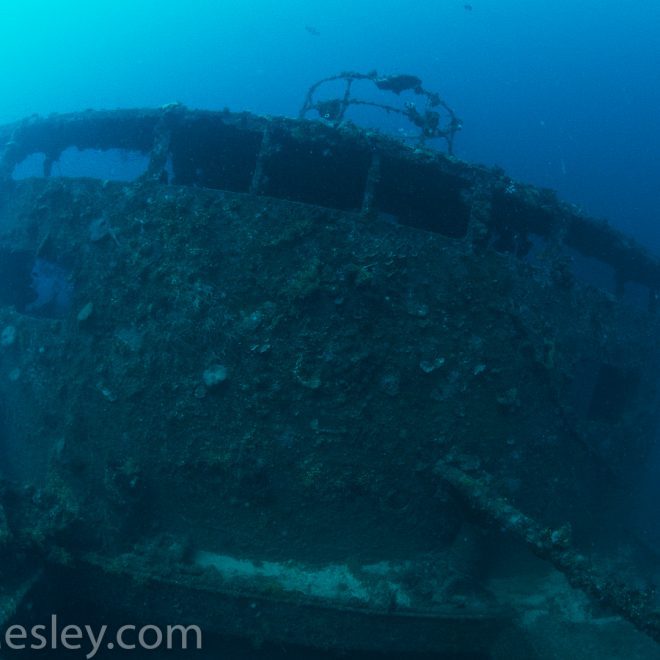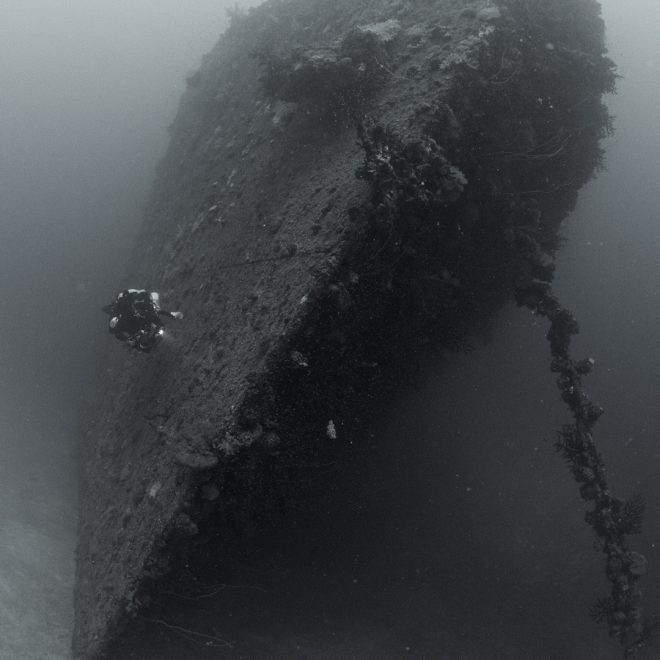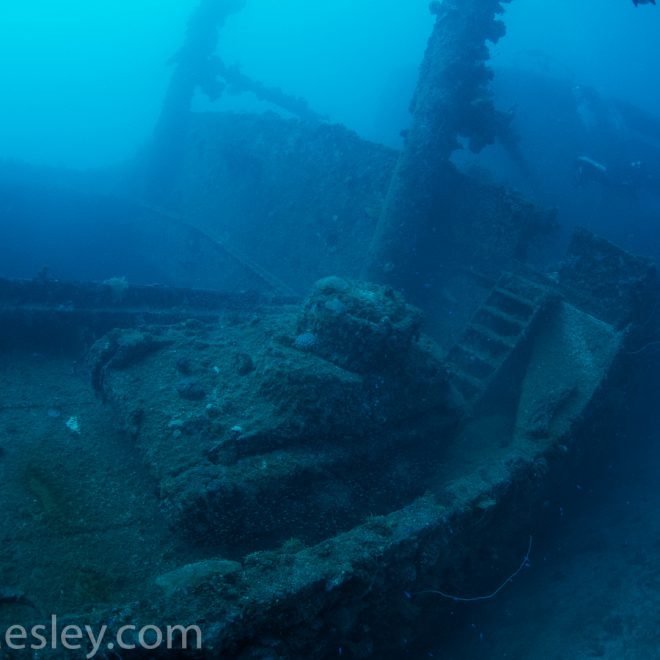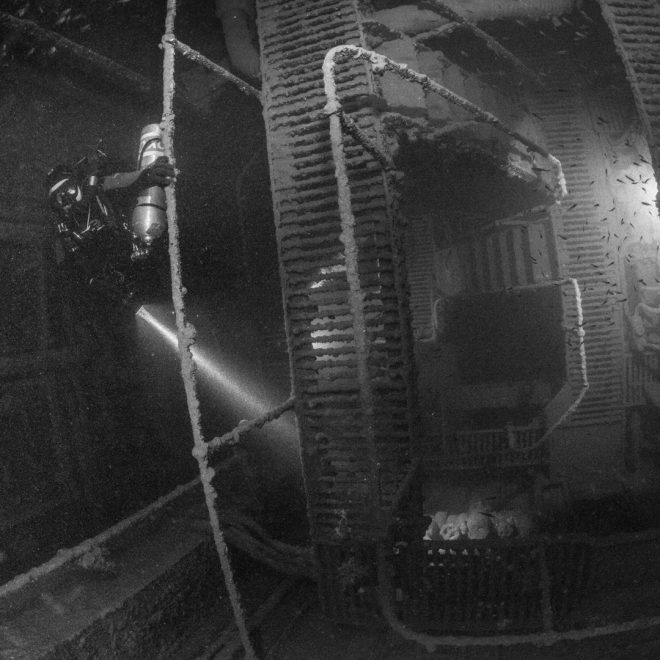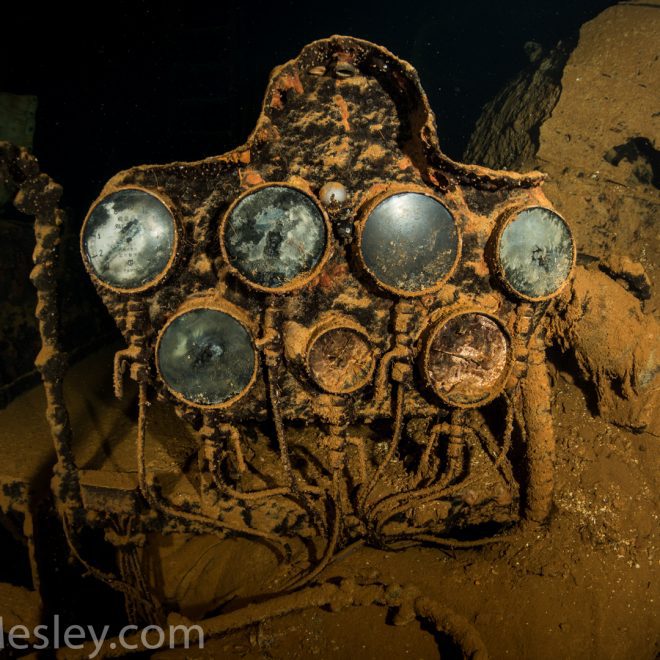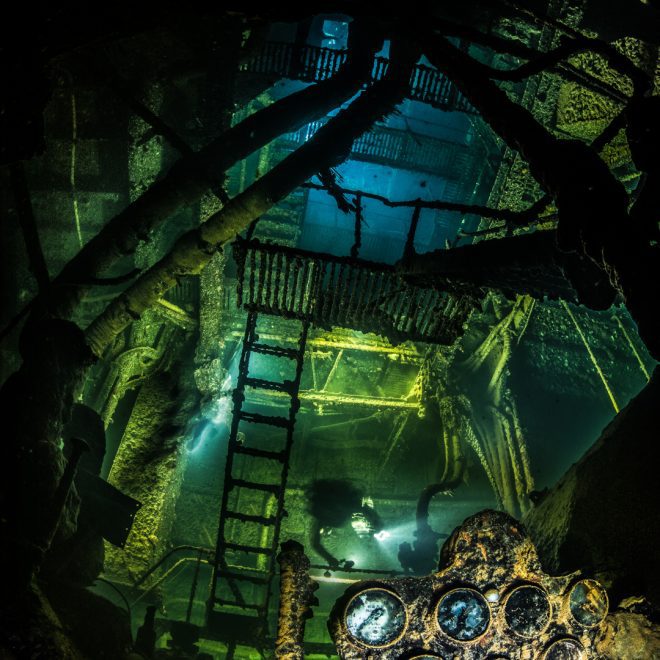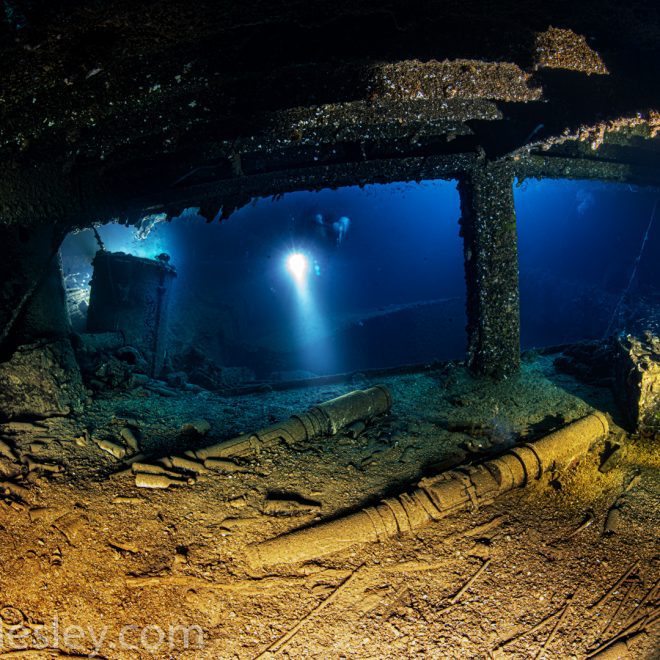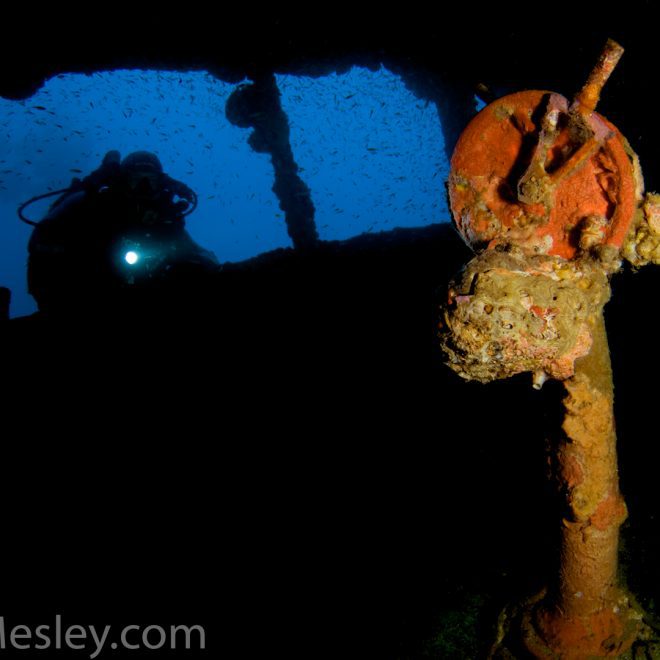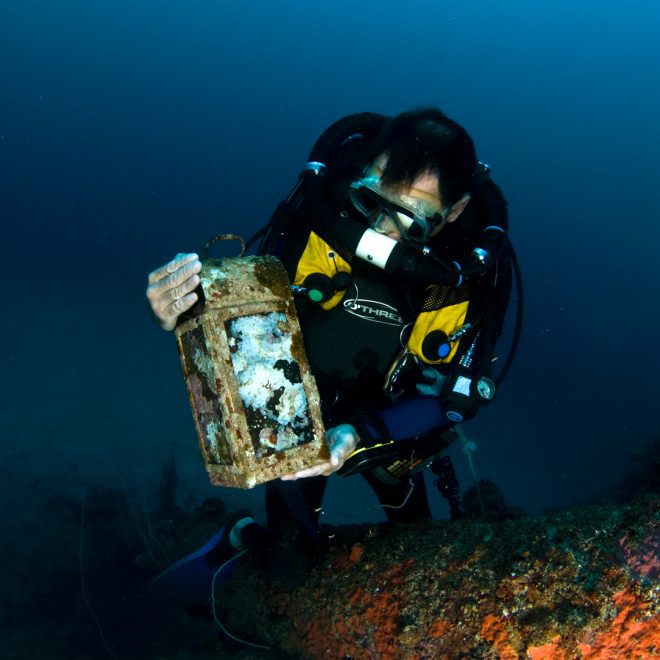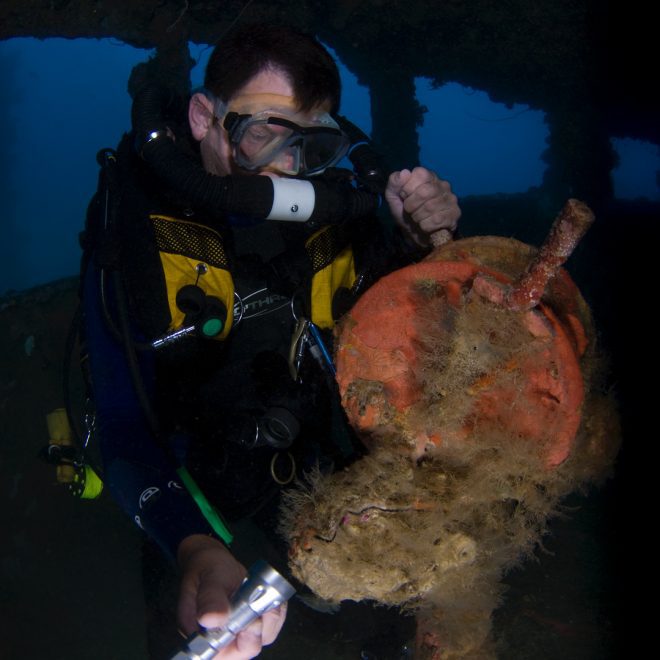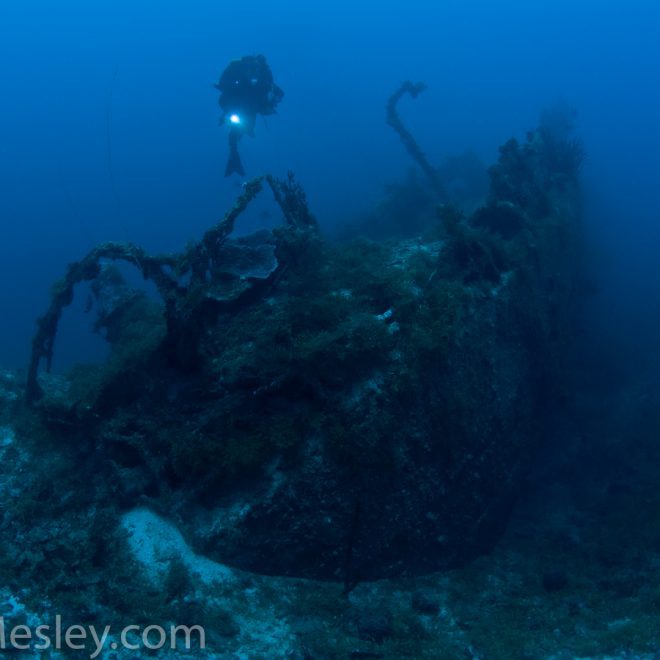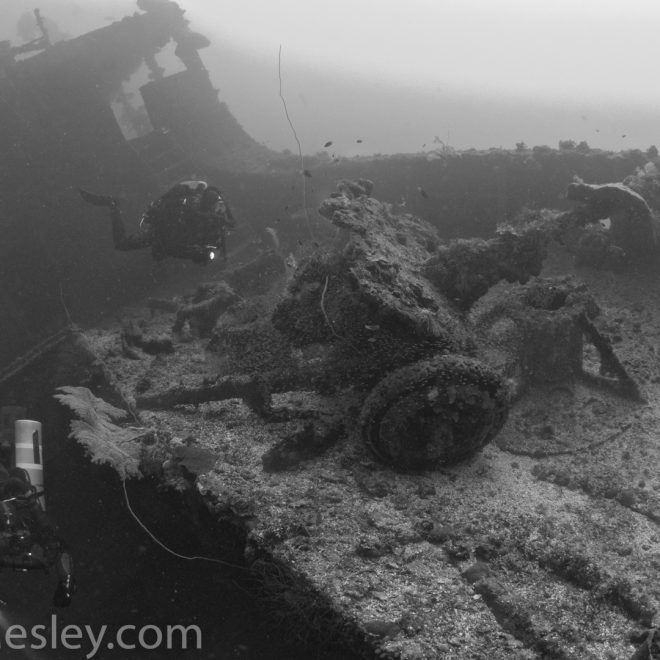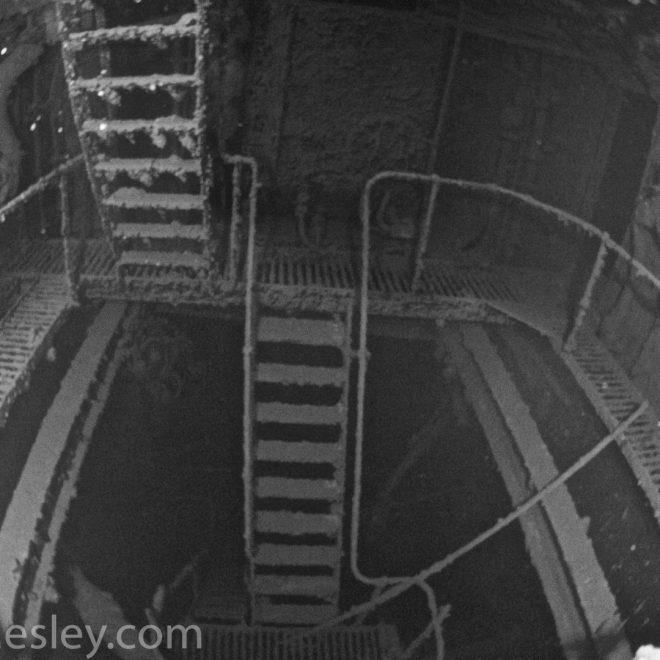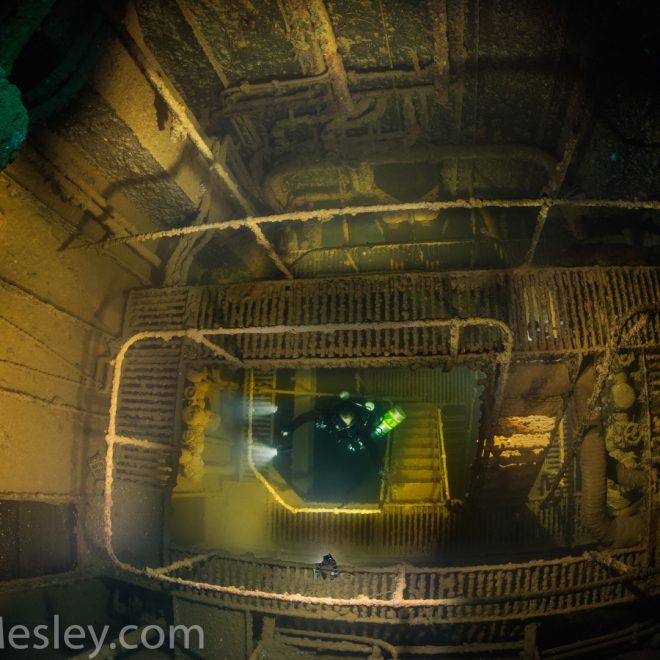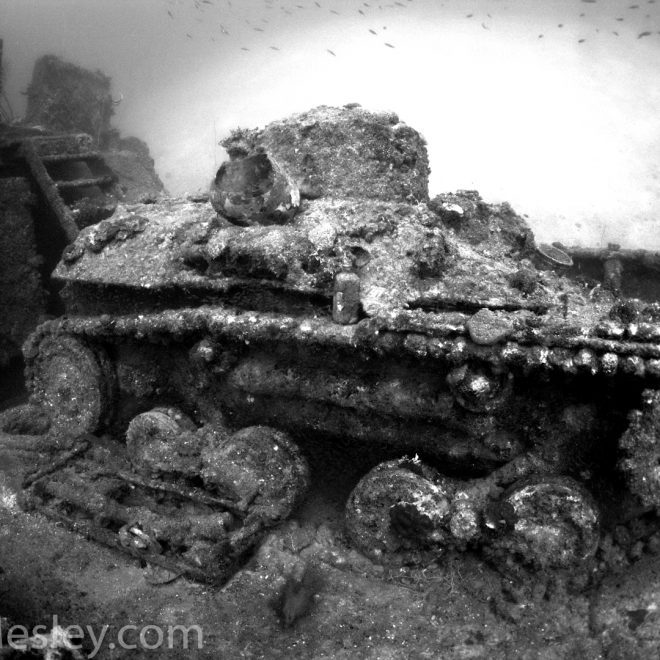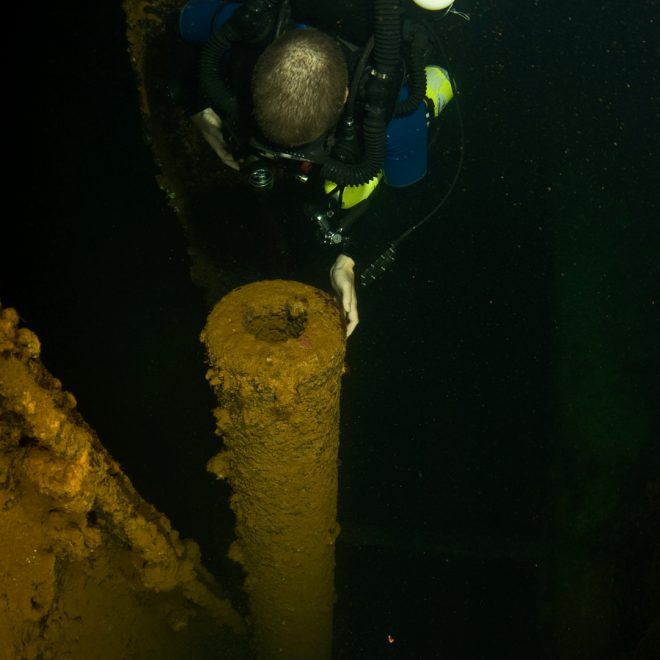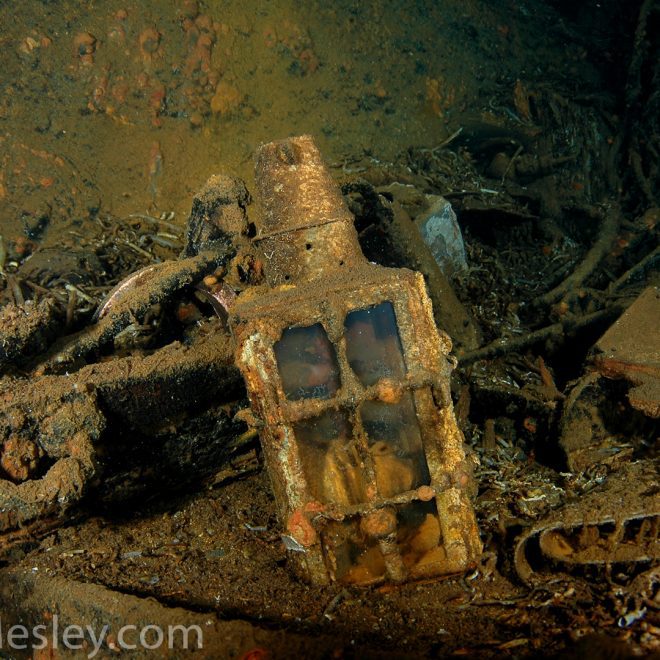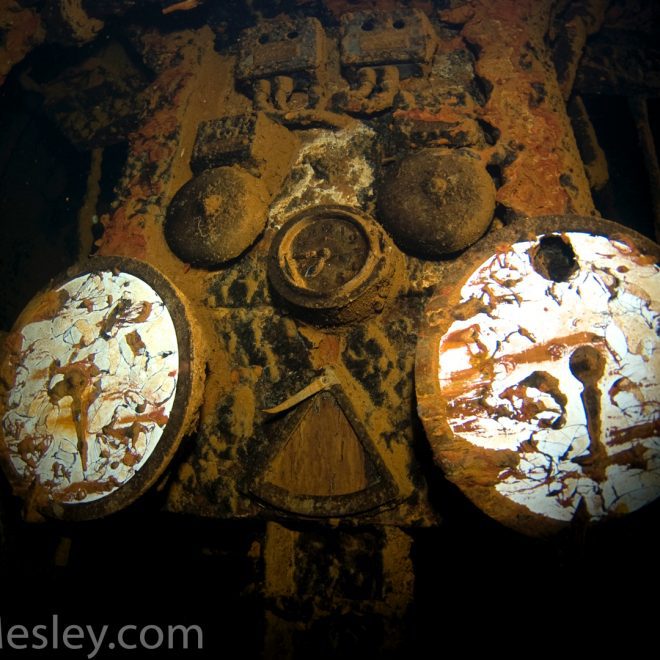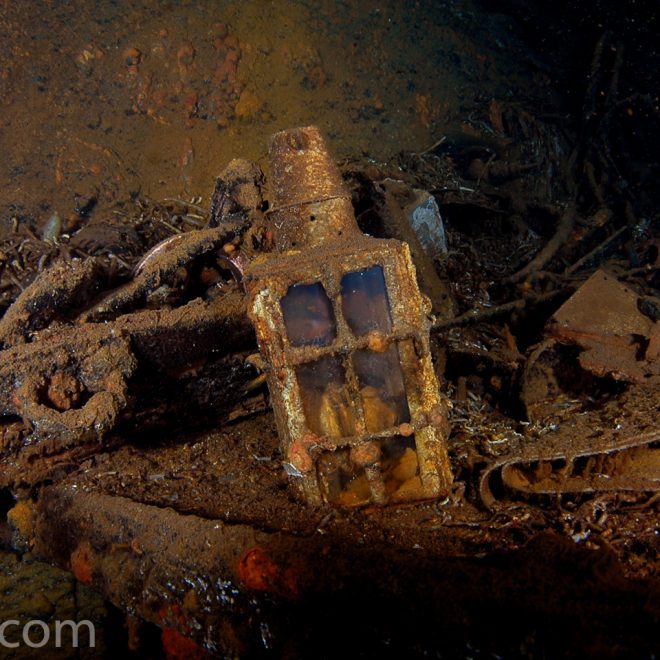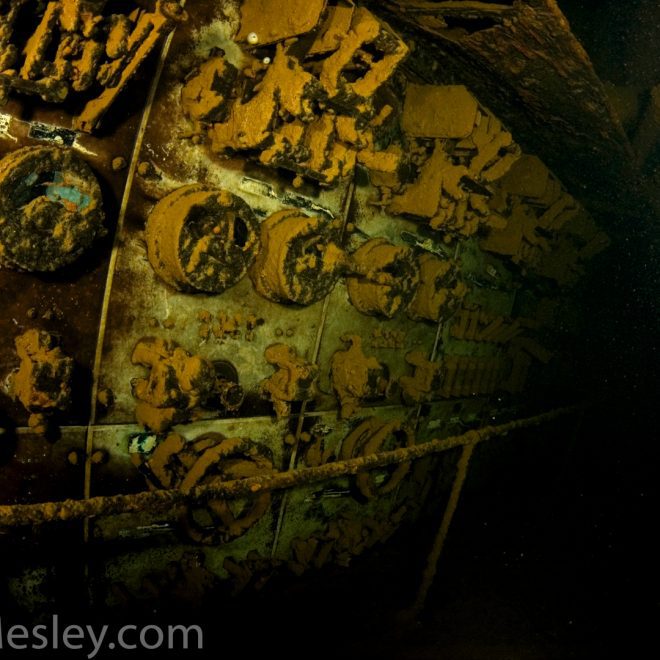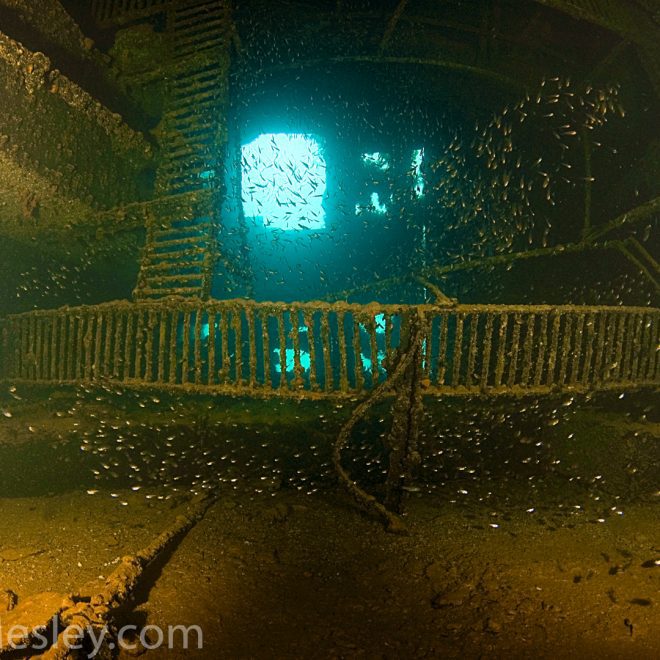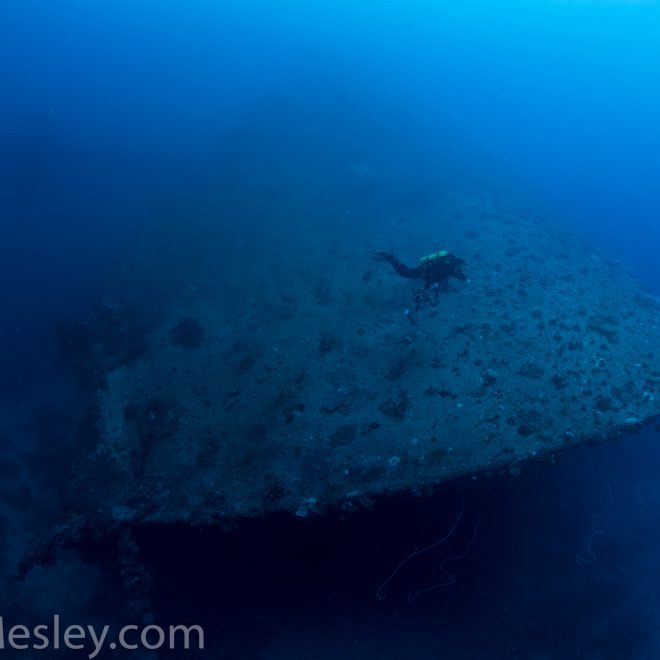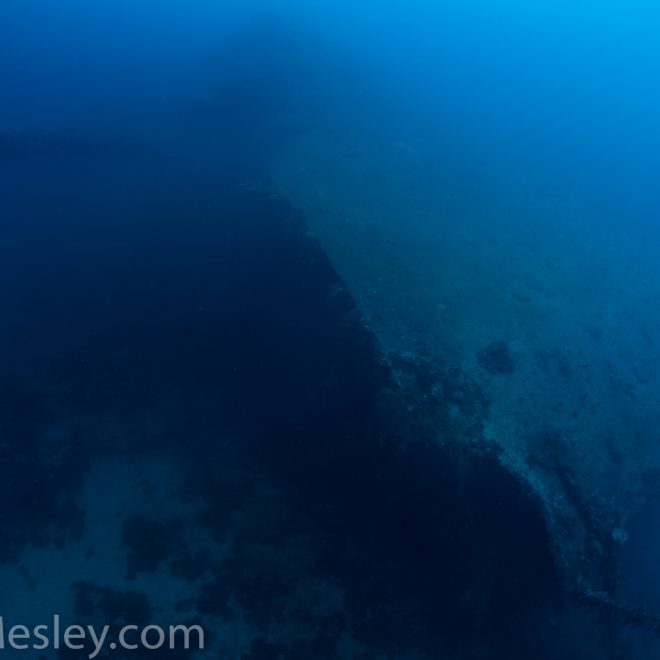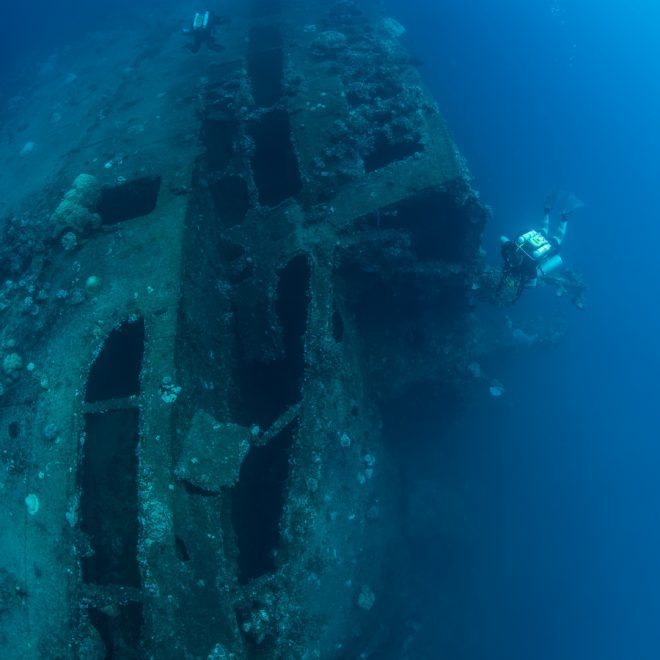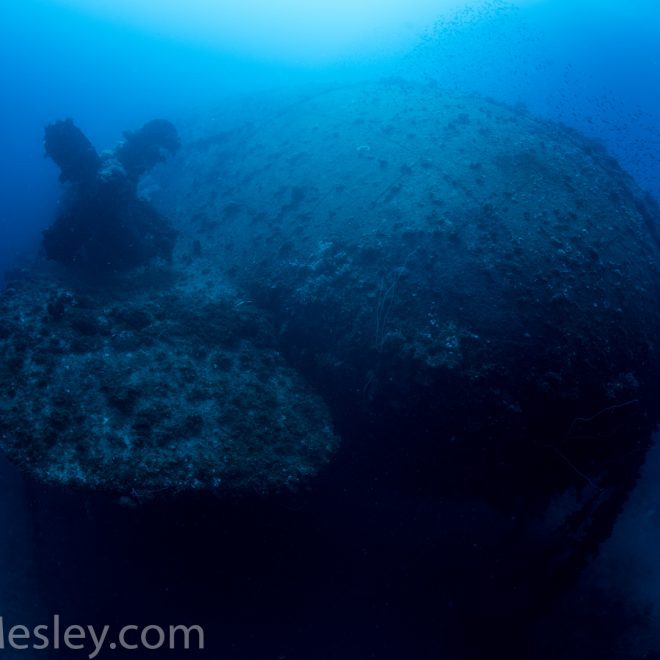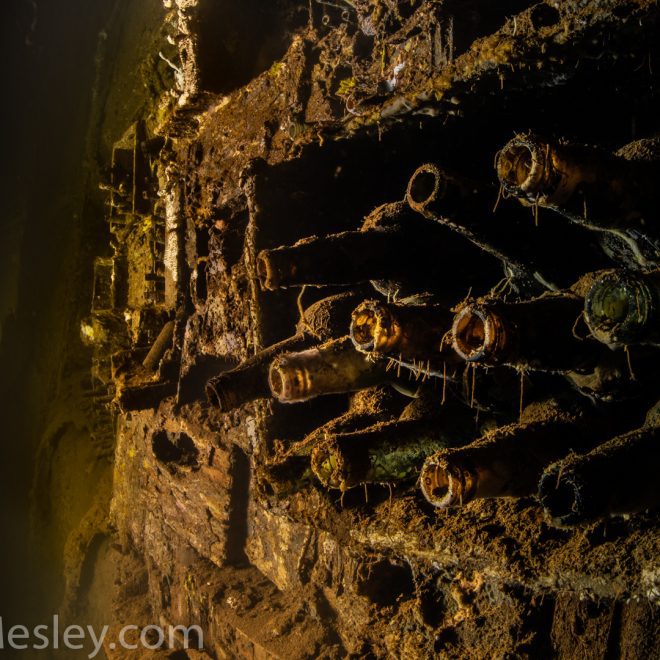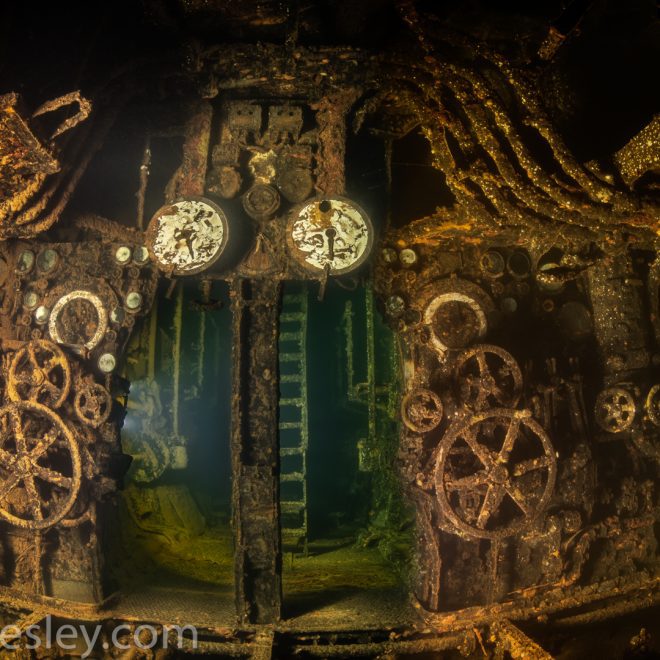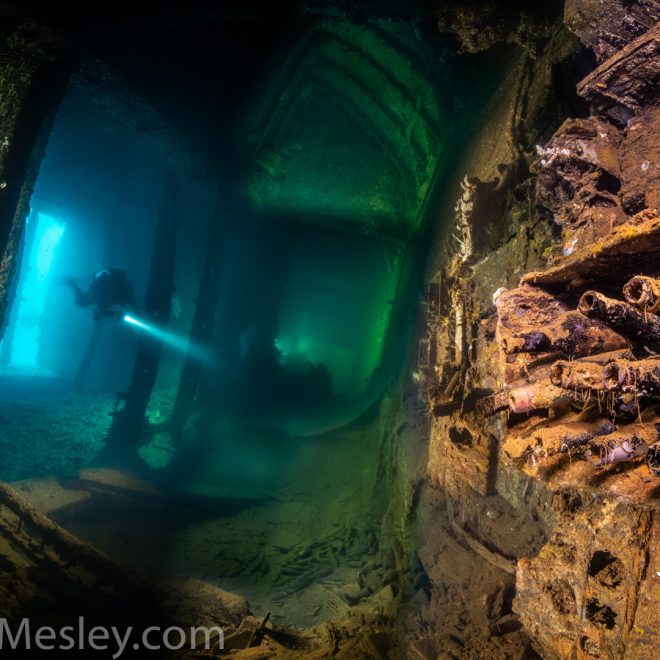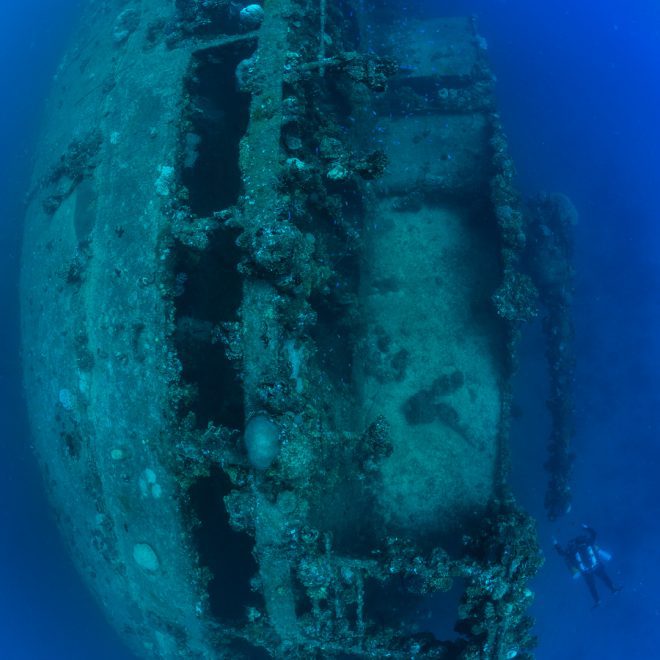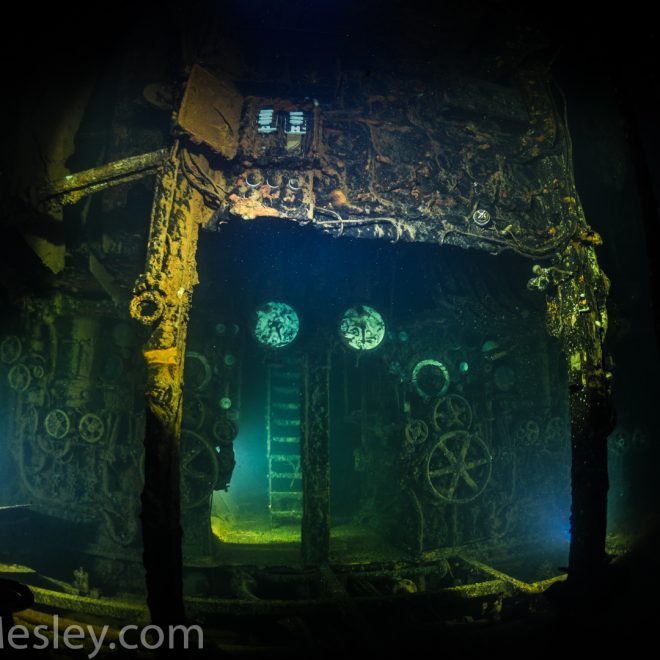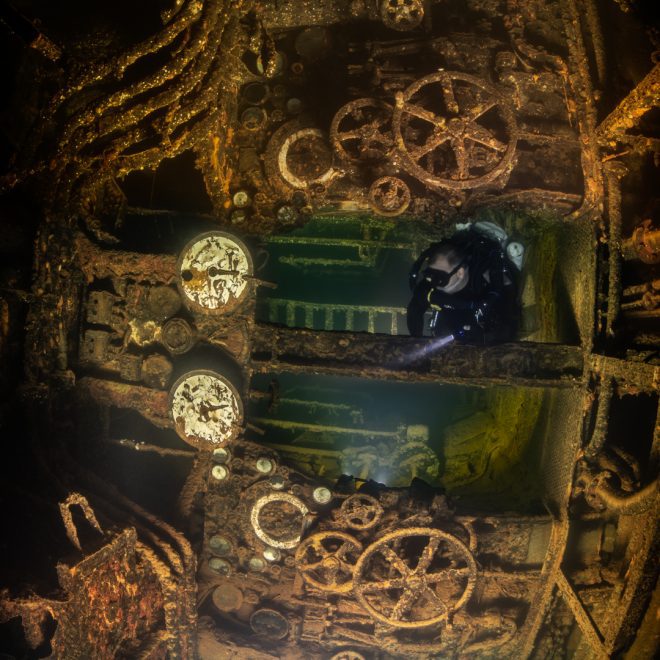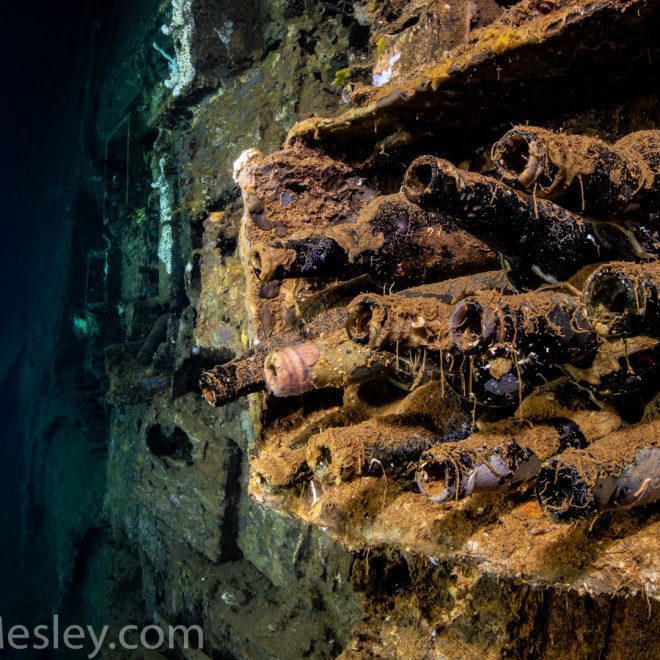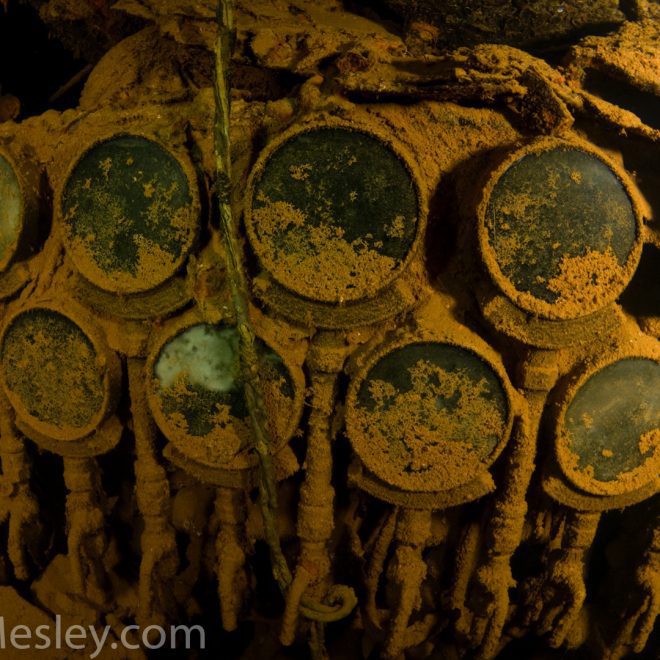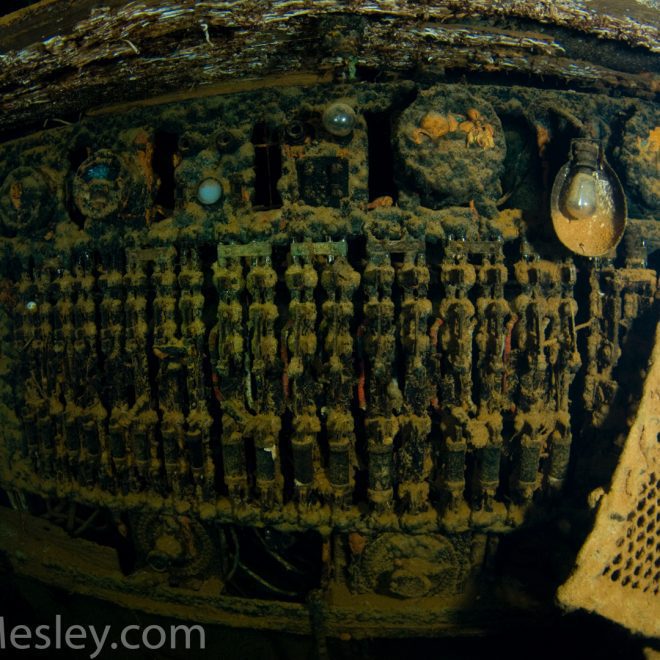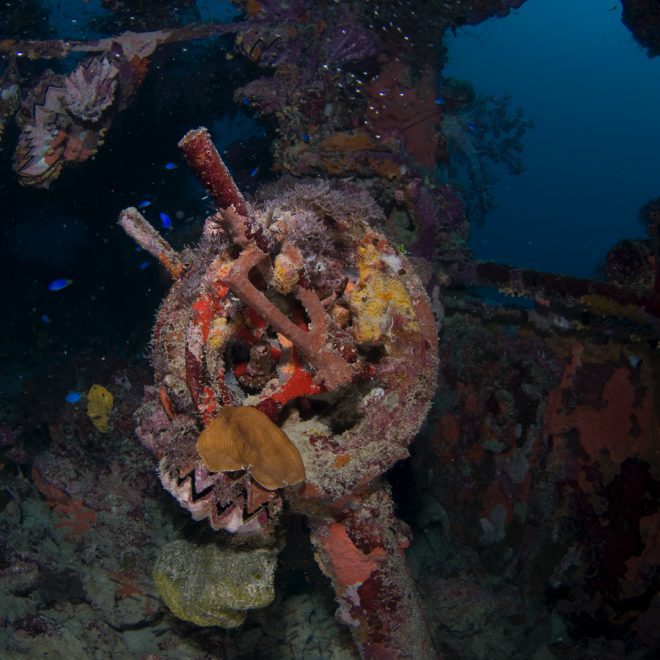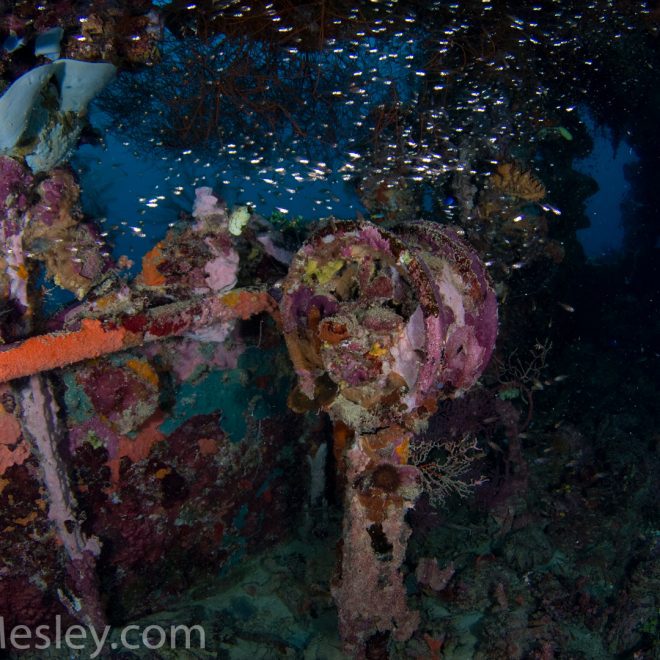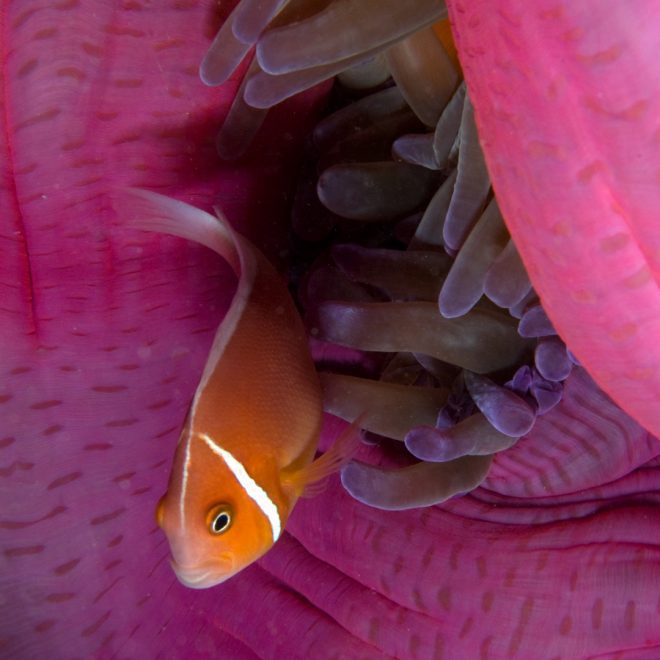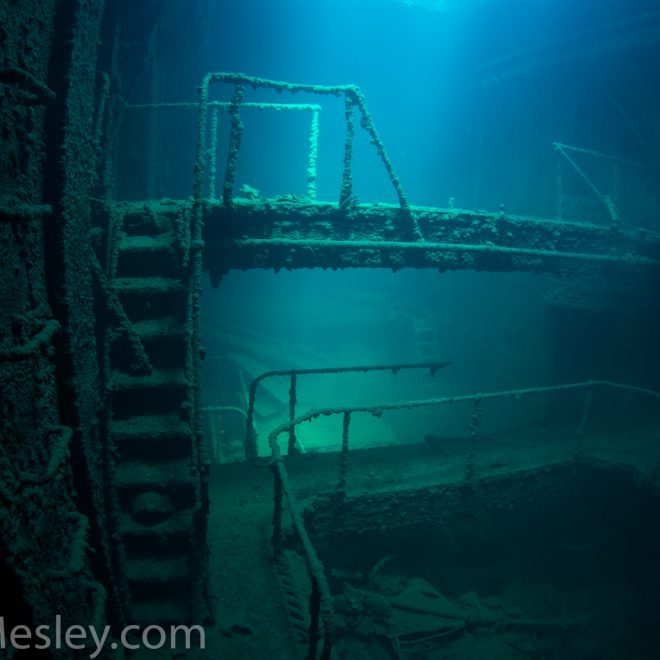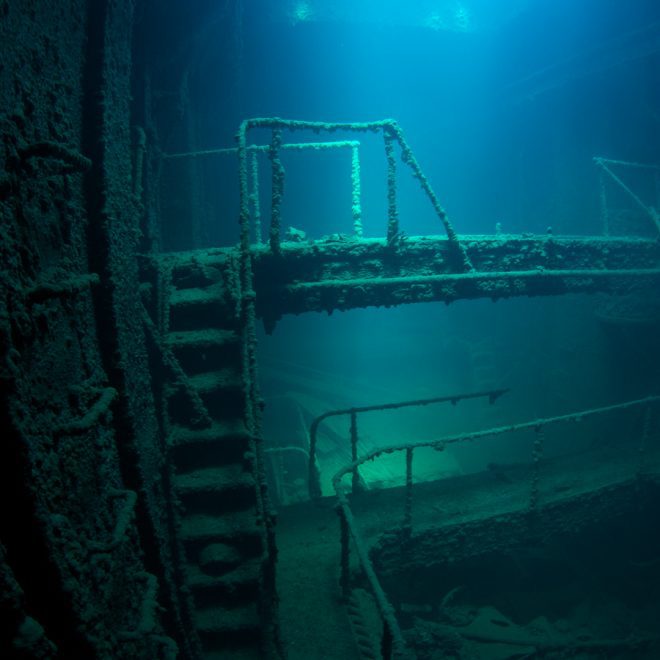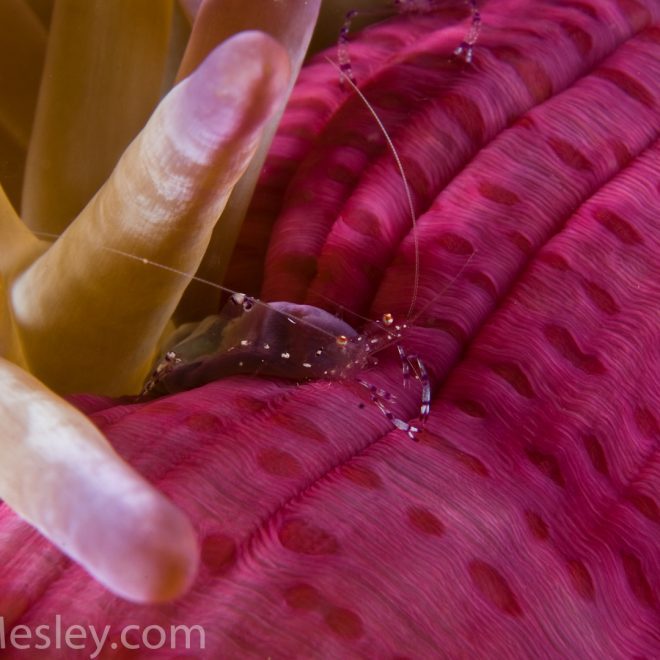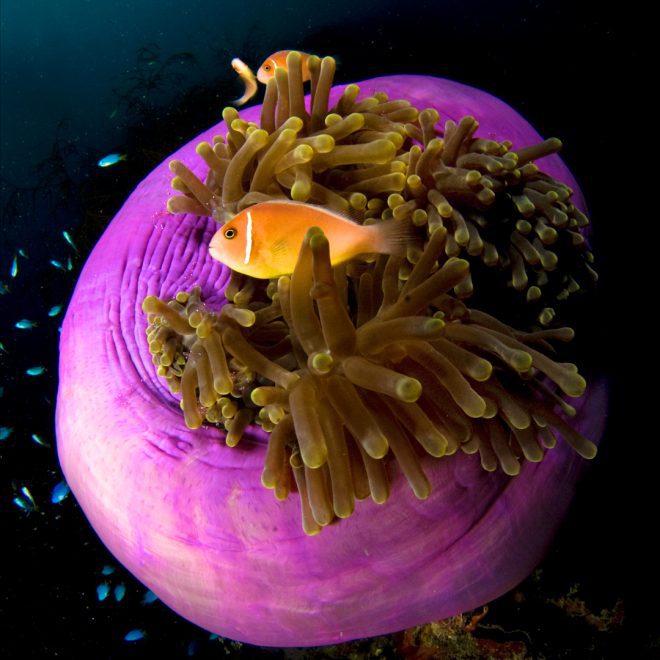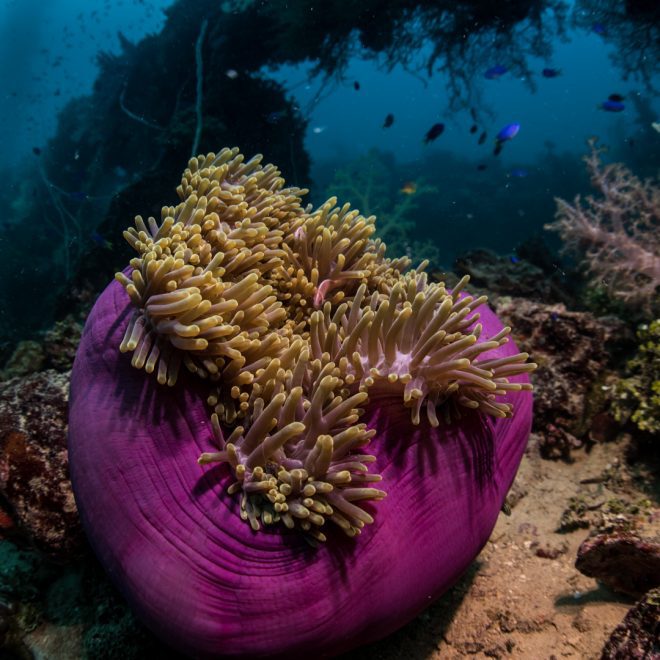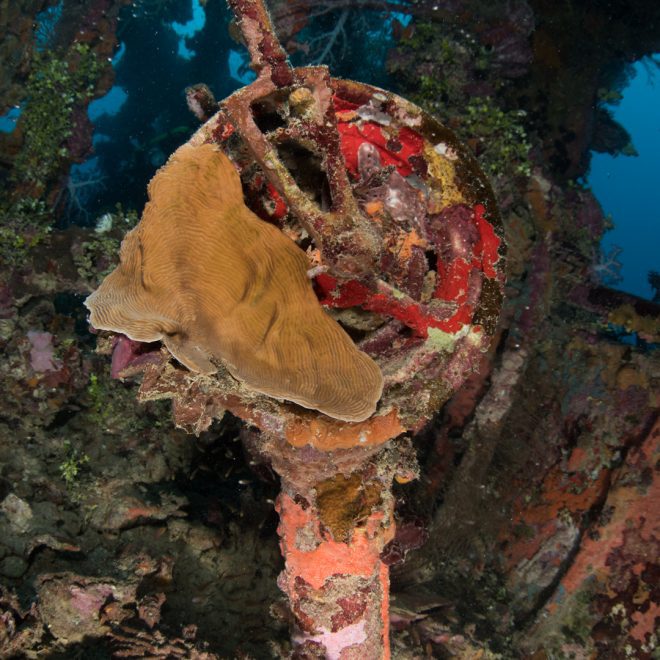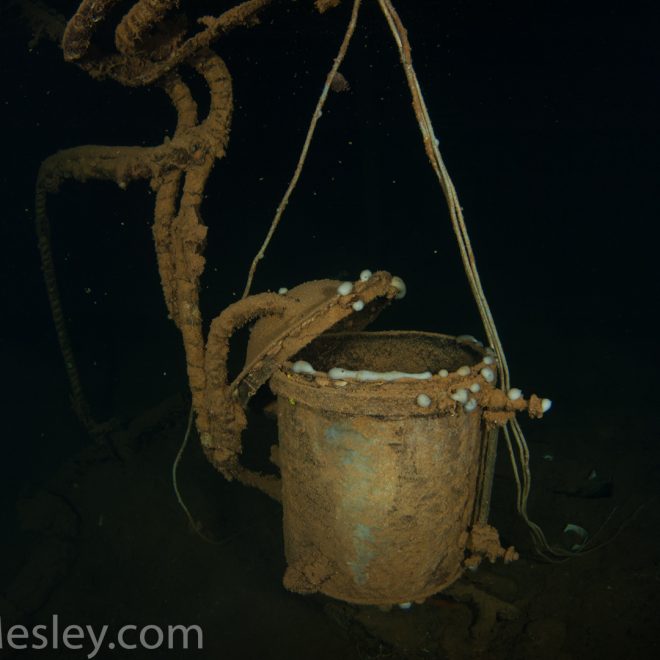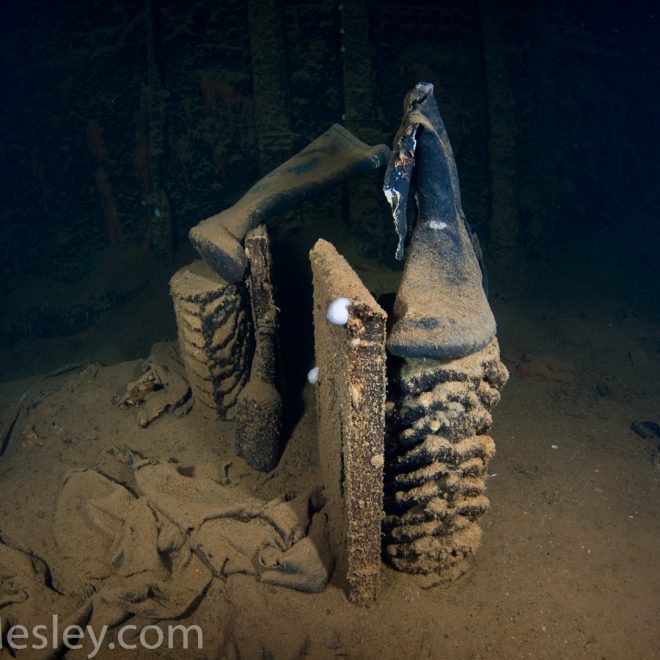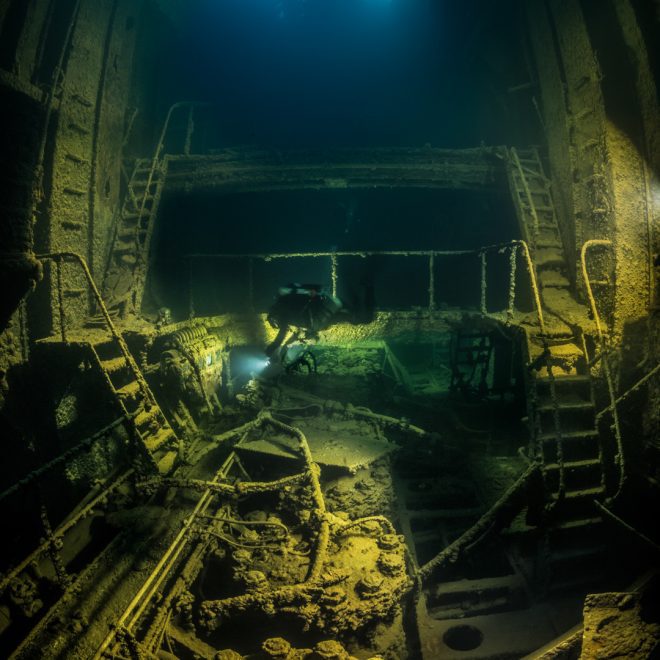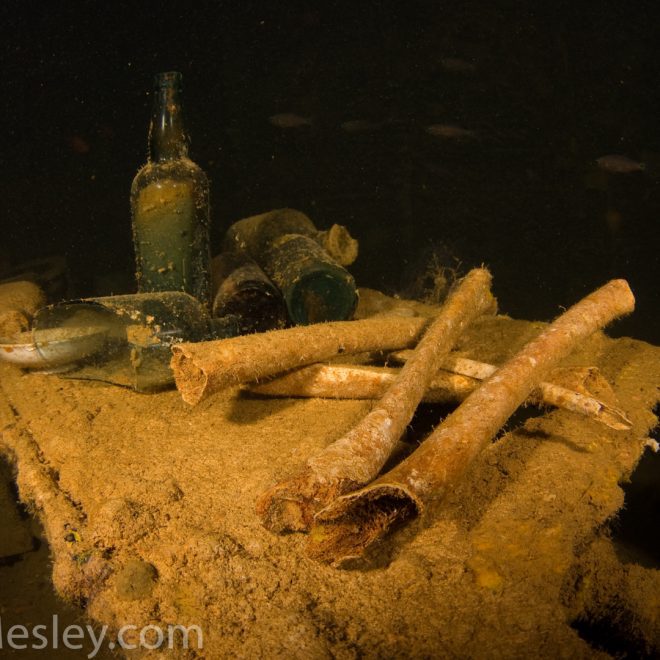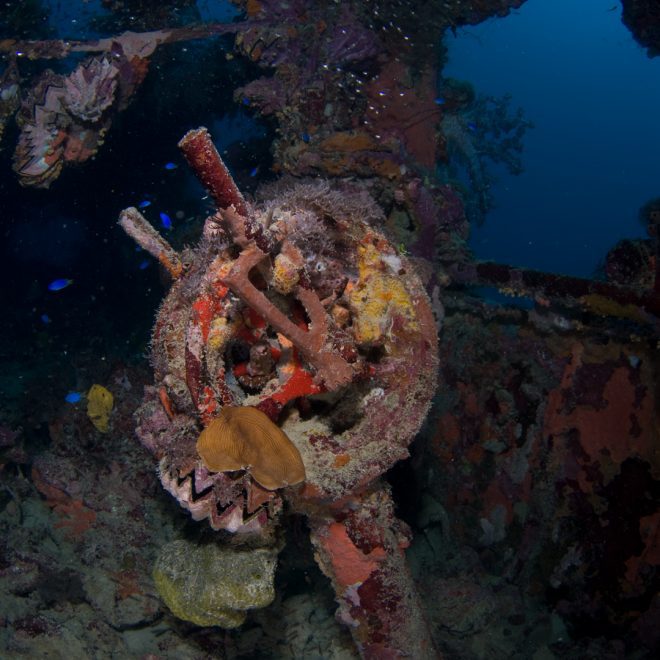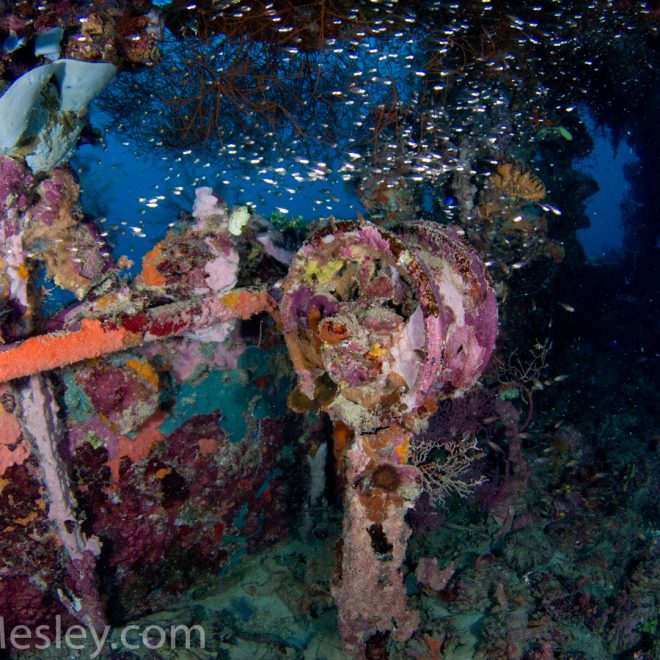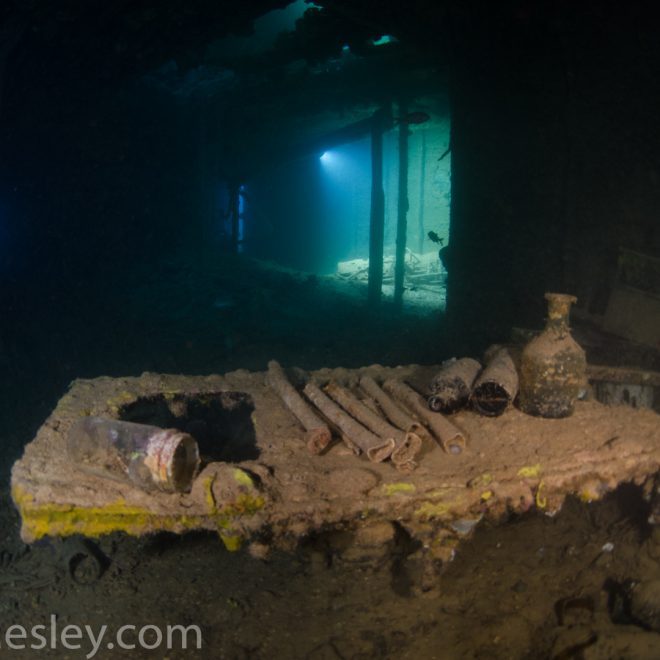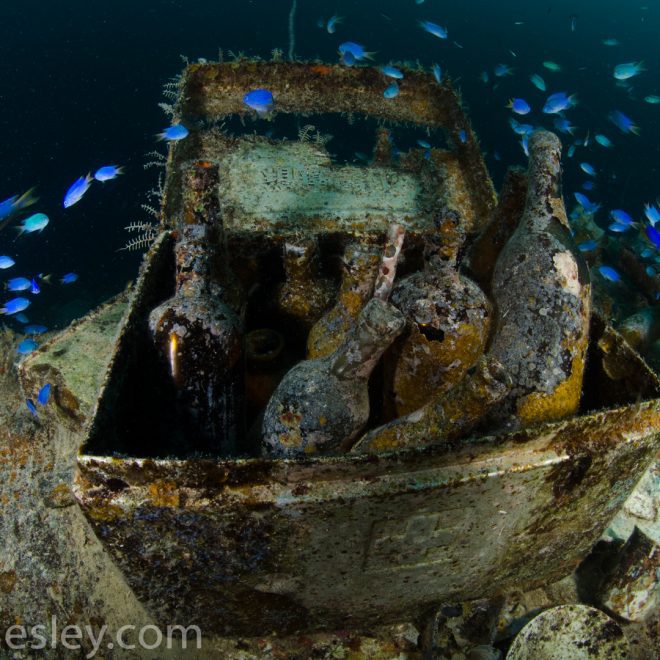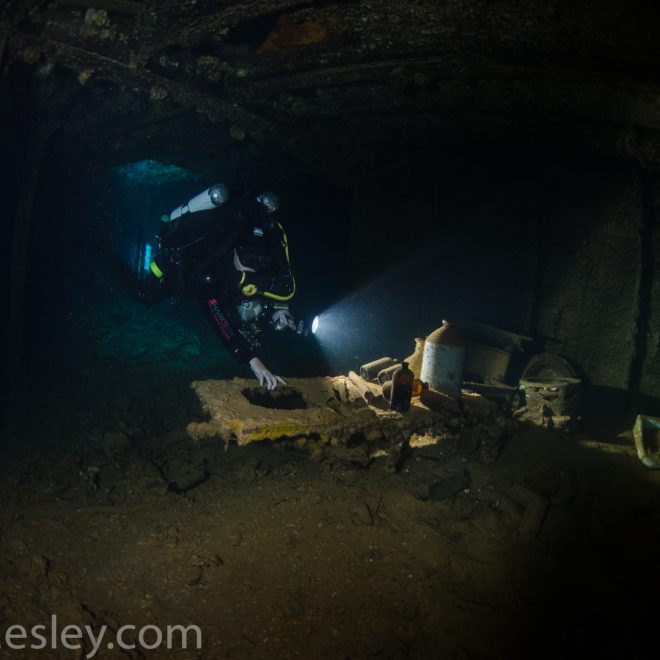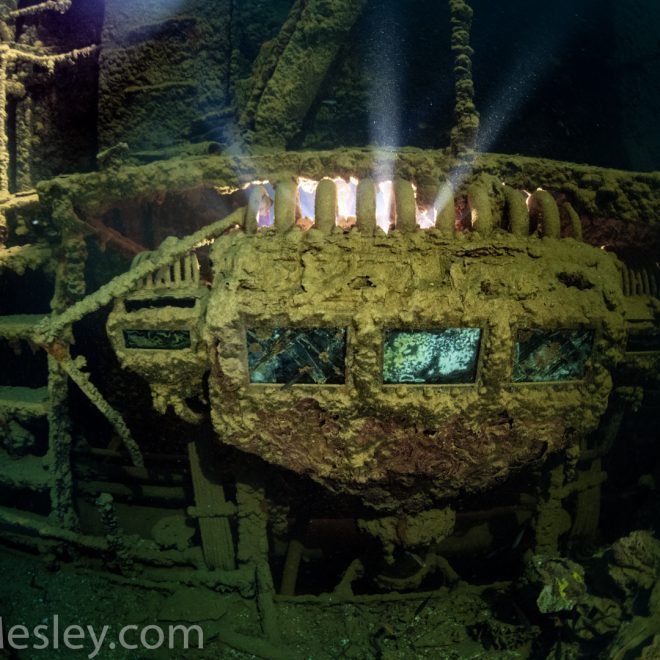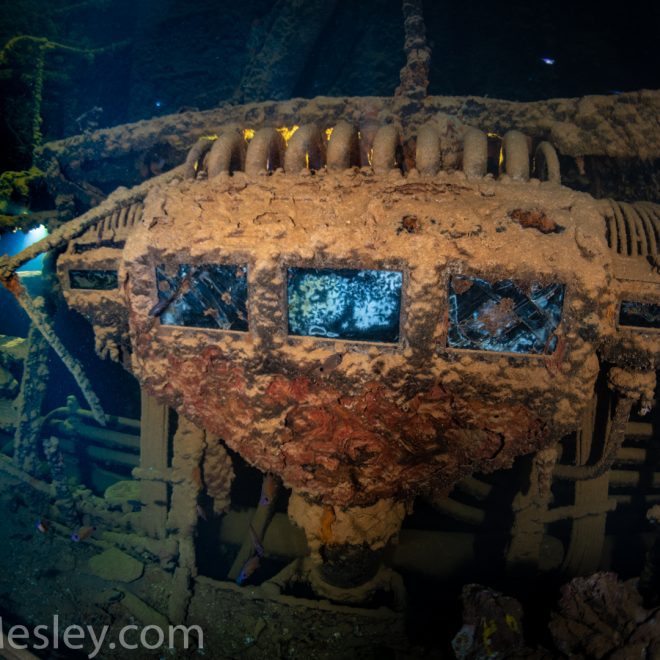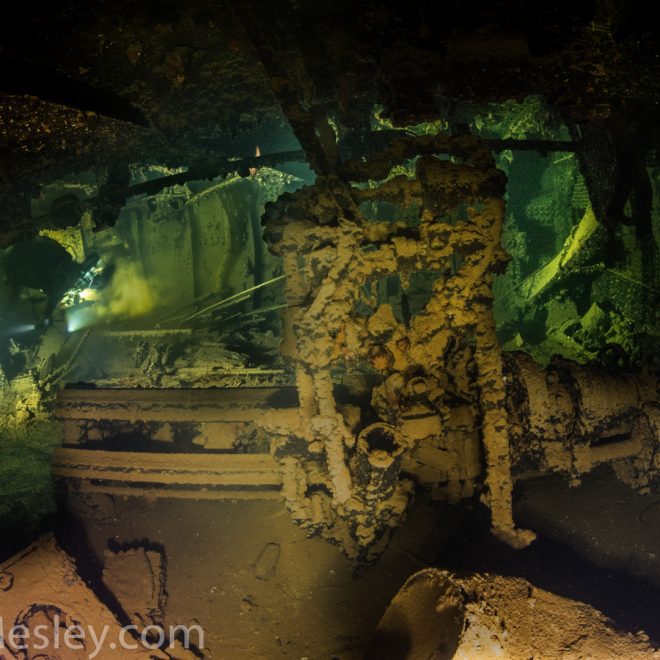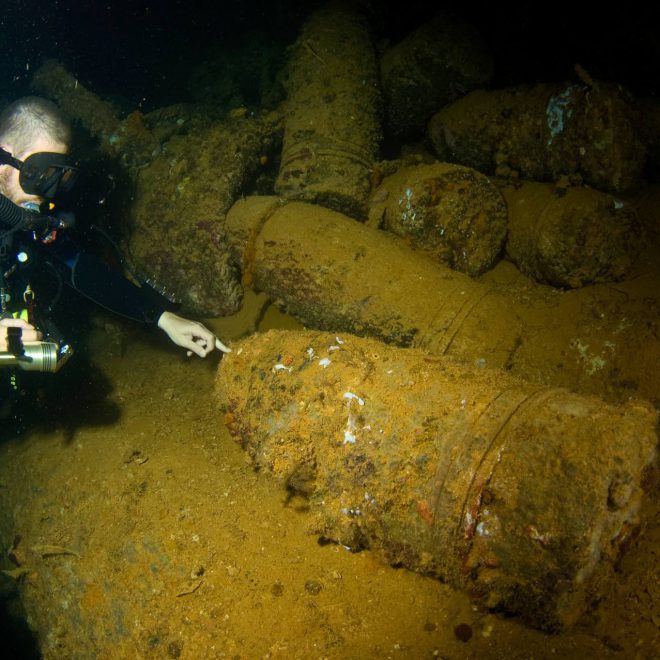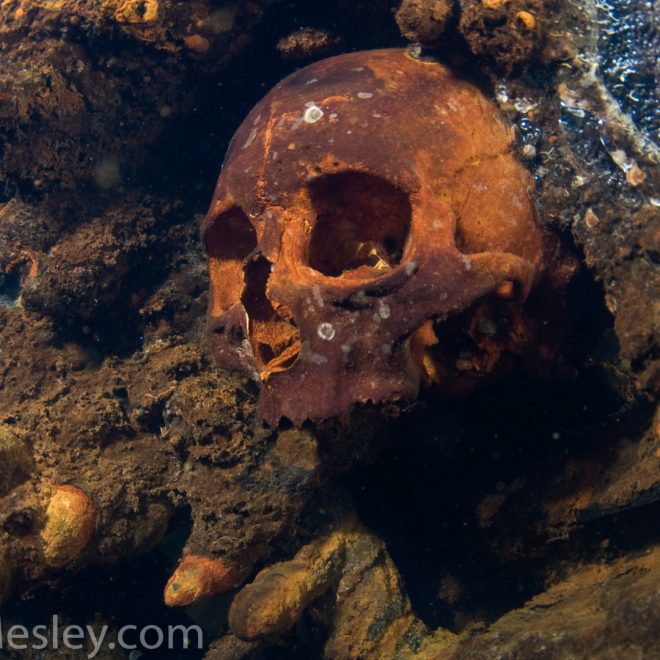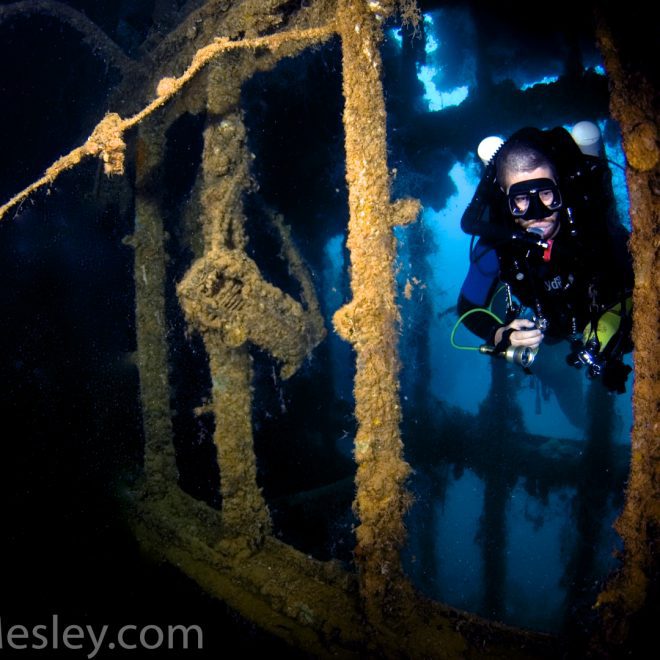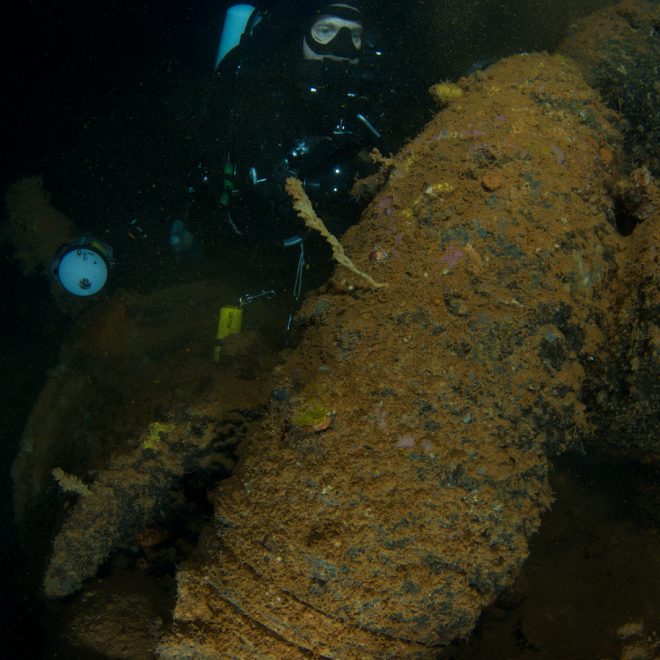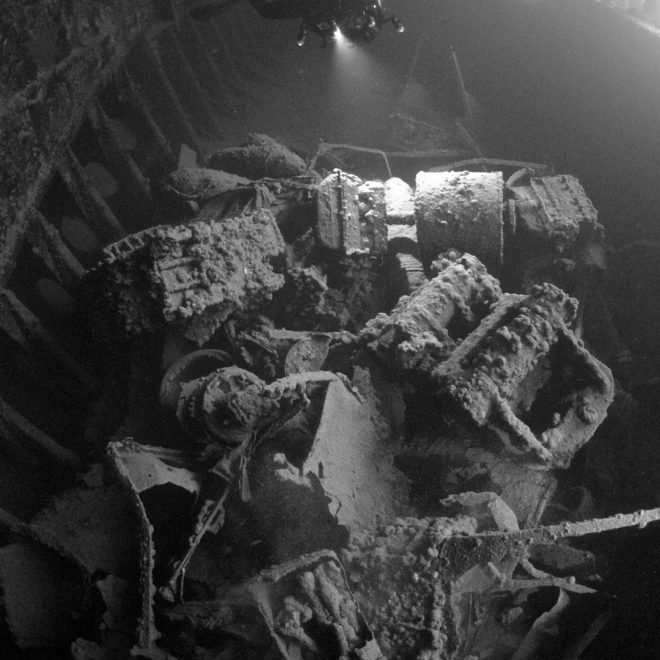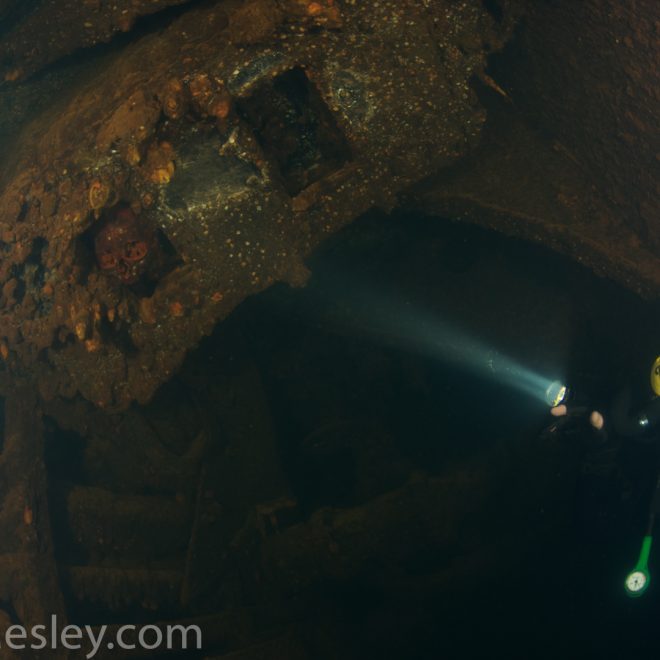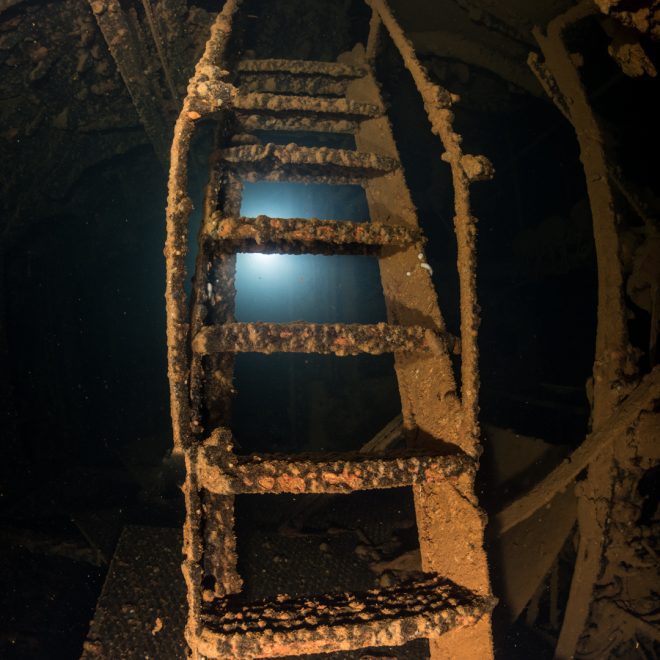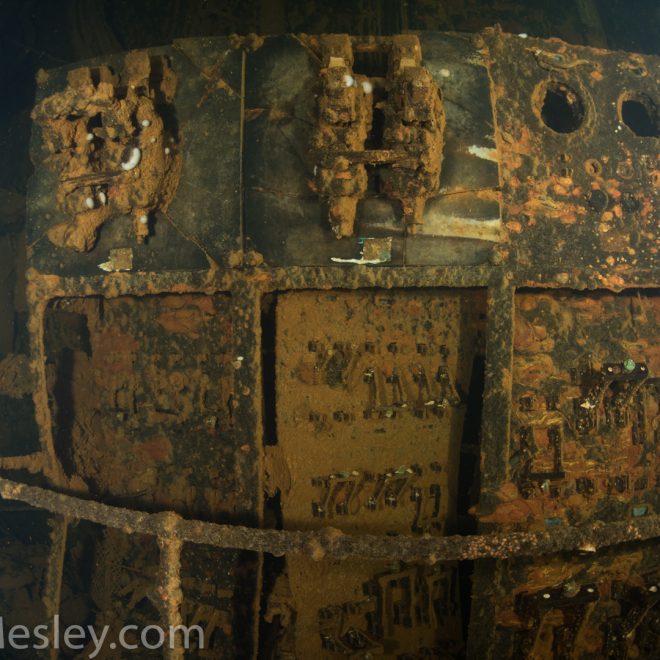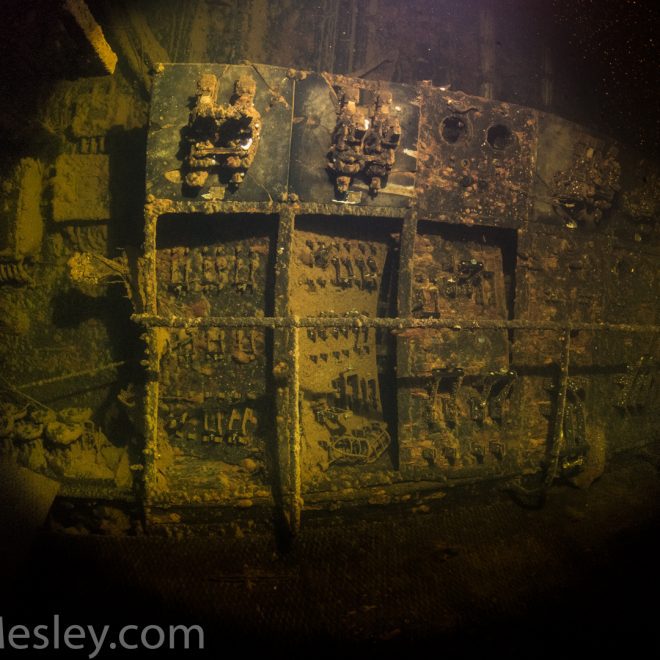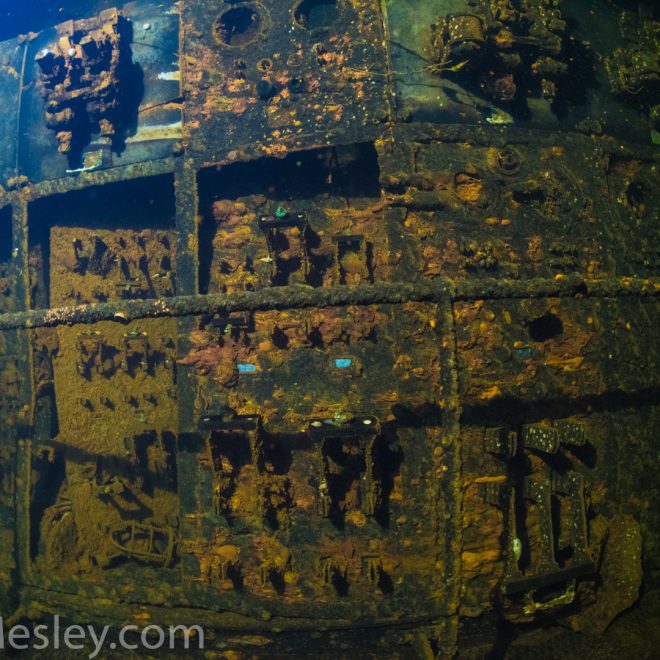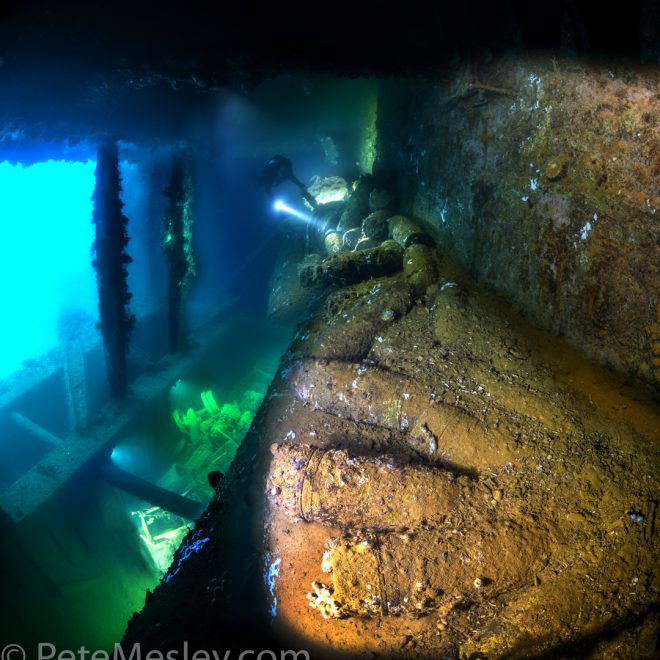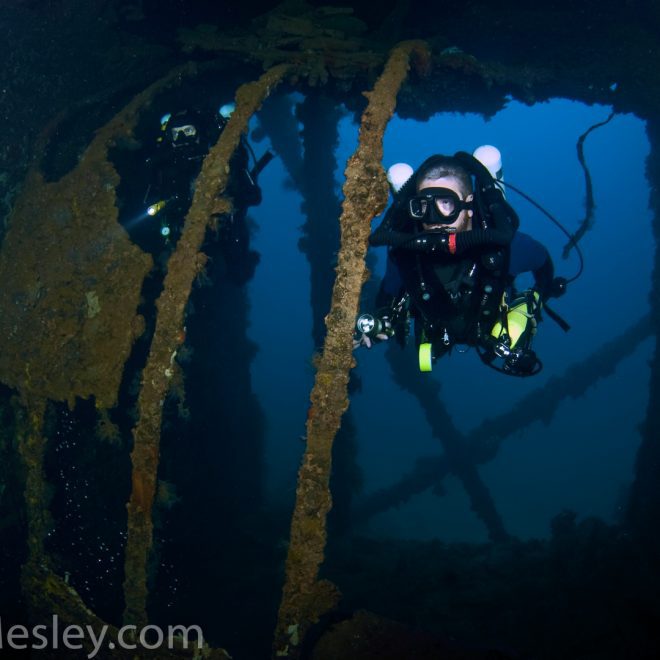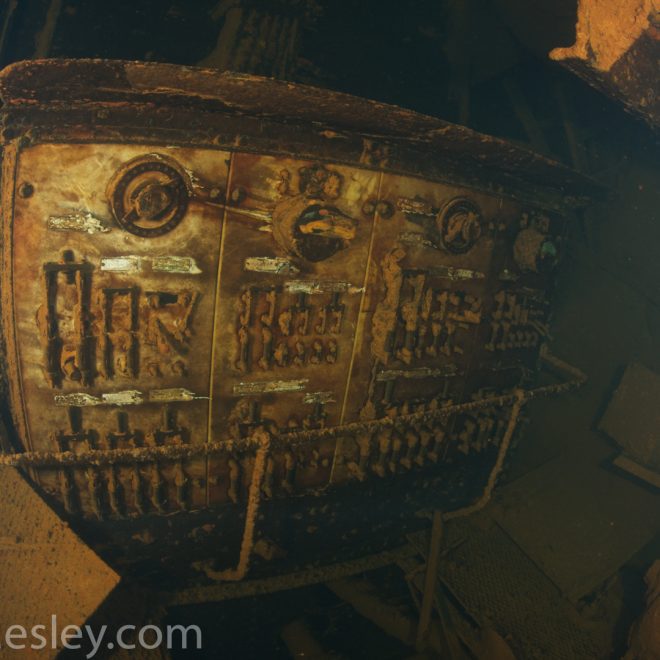Truk Lagoon: Wrecks
Wreck Name: Aikoku Maru (50-60m)
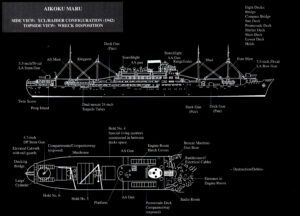

Because this is such a massive ship, you can penetrate quite a few areas within the superstructure and in the holds. But it is discouraged mainly because this ship was blown in two by the sheer force of 1000lb bombs and you can easily see how brittle things are. Personally I did not penetrate into the engine room but people within our group did. Reports was it was extremely difficult and dangerous. Seeing that the entrance is within the mangled debris of the blasted area.
Mostly the boat is moored onto the main superstructure and you swim aft towards the stern. There is a large gun on the stern which is great for taking pictures of. Penetration in the superstructure can be entered from the port bulkhead just forward of hold 4. Props can be seen easily but this is on the sand at 63m.
The engineroom is a fantastic dive. Difficult to locate the entrance, but you access into via the main superstructure at the starboard side of the vessel forward, amongst the mangled wreckage. There are loads of remains down in the lower sections of the engineroom. Much care must be taken not to disturb anything.
Wreck Name: Amagisan Maru (45-60m)


On February 14th 1942 off the island of Davao, she narrowly survived a torpedo attack by the submarine USS Swordfish. On August 17th 1943 while alongside the fueling quay at Balikpapan she survived being strafed and bombed at masthead height by nine B-24’s. The attack reportedly sank four ships and damaged 2 more. However, only one bomb hit the bridge of the Amagisan Maru, killing her Commander and one enlisted man, and severely wounding several others. On October 8th 1943 off Rabaul she was attacked again, this time by a submarine and was hit in the No. 6 hold by a torpedo that caused flooding, but did not explode.
On February 17th 1944, the Amagisan Maru was in Truk Lagoon with a convoy unloading cargo when planes from the USS Bunker Hill were assigned targets at the anchorage between Fefan and Uman Islands. The Amagisan Maru, the largest ship present, was located at the southern end of the anchorage, where five Curtis Helldiver dive-bombers, and Four Grumman Avenger torpedo bombers attacked her. A 1,000 lb. bomb initially hit her, and then she was rocked by one or perhaps two torpedo hits forward and aft, ripping her and igniting her fuel oil. Within 15 minutes of the attack she was burning fiercely and sinking by the bow. She had gone under by the next strike.
She rests with a heavy list to port on a four-degree slope that gets progressively steeper towards the stern. The seabed depth at the bow is 140ft/42m and falls to over 200ft/60m at the stern. Her superstructure starts at 100ft/3om. Guns at both the bow and stern provide excellent photo opportunities, although the stern gun lies at 180ft/55m. A tanker truck rests off the port side, and hold No. 2 contains a car and other interesting cargo.
Wreck Name: Fujisan Maru (37-48m)
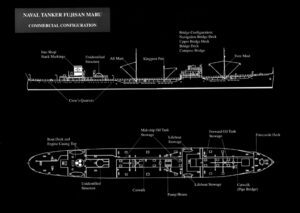

Wreck Name: Hokuyo Maru (41-64m)
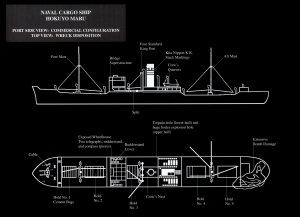

Awesome bridge, which all the walls have collapsed and all that is left is the telegraphs, helm and compas standing there for all to see! But all in all the superstructure is still largely intact
Main funnel has collapsed. A few sharks around the place. Engineroom is amazing
Passenger freighter sitting upright, with interesting bridge and engine room. 368′ (112m), served the Far East until the war, when she became a Naval Miscellaneous Auxiliary Ship. She was carrying cement bags when she was torpedoed to the sea floor during Operation Hailstone. Little is known about this ship or her pre-Truk Lagoon actions.
Wreck Name: Katsuragisan Maru (60-71m)
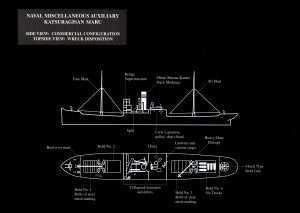

The viz on this dive is some of the best I have seen in Truk. Way out east of the Lagoon currents rip through these narrow passes.
On descent the wreck was quite flat, main superstructure has collapsed completely. Really nice stern gun. We swam towards the bow swimming into Hold 2. Below I have pictured what I found. There was an interesting object lying on the floor. Heaps of Prop blades and other general maintenance cargo, tyres, tracks etc.
Then swam into hold 1 where there was again lots of tyres, gen cargo. Then into the port bulkhead. There was a bath and porcelain baby bath. It interests me that in these fighting ships these sights are common – the baby baths! I wouldn’t have thought that there were much woman let alone babies on board.
In the stern section there is a spare prop sitting against the back section of the wreck. This is where the trucks are situated. In the holds in the stern. There are many lanterns strewn round this wreck. Plenty of sharks so keep an eye out! There is always a bit of current and is difficult to shot the wreck as the ship is lying alongside the prevailing current so you can be 5m away from the wreck and not hook in. Loads of fishlife.
Wreck Name: Nagano Maru (45-60m)
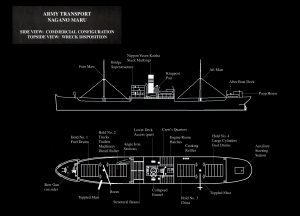

Its a great wreck and worthy of many many dives. I cant wait to get back there. We had more time in the superstructure and had a great time having a dig. Loads of porcelain amongst the rubble and again its amazing how the Japanese were sober during any of the fighting. There were, like I mean, millions of bottles of saki on these ships. (2019 – Main bridge area has collapsed making the whole superstructure impossible to get into. Still limited acess to engineroom)
This wreck is one of Truks best. One of the ways that the locals locate the wreck is to get to the general area of the wreck and smell for oil! Yes smell for oil. I thought – Yeah Right! But sure enough when we got close we could smell the stench of oil. It really is pungent and has been leaking for years.
On the port side of the superstructure at deck level is a small room which contains many brass lanterns.
Wreck Name: Oite (57-63m)
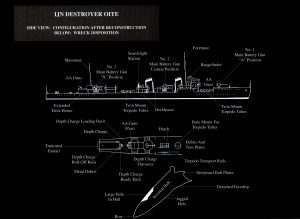

Wreck Name: Seiko Maru (32-57m)
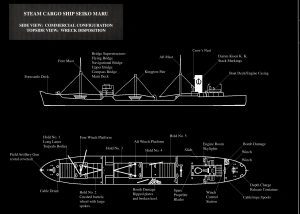

During Hailstone attack, Seiko was hit by dive bobers on the port side resulting in an explosion which set her fuel oil on fire. She now rests upright and fairly intact. Gun on bow which used to have wooded wheels, bridge is intact but no floor at a max depth of 57m. Powered by one coal driven turbine with a max speed of16 knots, displacing 5386 tons. 121m long.
Wreck Name: San Fransisco Maru (42-64m)
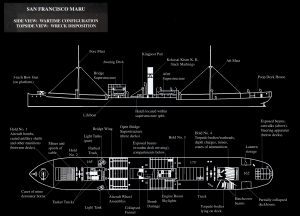

San Francisco Maru – Passenger cargo ship sitting upright. Much to see – bow gun, trucks, tanks, mines, shells, bombs, aircraft engines, ammunition, china and depth charges on stern.
Depth: 140-210ft/42-64m
The San Francisco Maru was a 385ft/117m, 5,831-ton Passenger-Cargo ship built in 1919 for Yamashita Kisen Kabushiki Kaisha as part of its fleet involved in world trade operations in minerals such as coal, bauxite, and phosphate for transportation to the Empire. The word ‘Maru’ designates a merchant vessel. Following requisition by the Japanese Navy, it was assigned to convey Japanese Navy Branch military cargoes between the Japanese homeland and the Inner South Seas.
On May 4th 1943 Allied intelligence intercepted a damage report from the San Francisco Maru’s commander saying that she had received minor damage from attacking aircraft at Wewak, New Guinea. Following repairs, later prisoner interrogations revealed that she arrived at Truk Lagoon on February 5th 1944. Aerial photos show her lying at the 4th Fleet anchorage southeast of Dublon.
Following early bombing attacks against ships in that anchorage on the first day of Operation Hailstorm, the San Francisco Maru was observed on fire with smoke arising amidships. On February 18th 1944 air groups from the USS Yorktown, USS Bunker Hill and the USS Essex attacked her. She was hit by six 500-lb bombs dropped by aircraft from the USS Essex, and was reported to be burning furiously and sinking stern first. Five crew members were killed as a result of these air attacks.
This wreck is loaded with war materials and one of Truk Lagoon’s most fascinating. She lies very deep, and rests on an even keel with the superstructure at 140ft/42m, deck at 165 ft/50m, and the sea bottom at 210ft/64m. There is a beautiful bow gun, and 3 armoured 3-man light tanks and a flatbed truck are located on the main deck. Two large trucks are located in Hold No. 2 and the other holds are filled with interesting war material, such as fuel drums, hose sections, ammunition crates and artillery shells, torpedo bodies, aircraft bombs, depth charges, airplane engines and aircraft wheel assemblies. Hold No 1 is crammed with hemispherical mines, cordite containers, crates of artillery shells and aircraft bombs. Much of this material was brought to Truk Lagoon by the San Francisco Maru in anticipation of expected amphibious landings by U.S. troops.
Wreck Name: Reiyo Maru (46-63m)
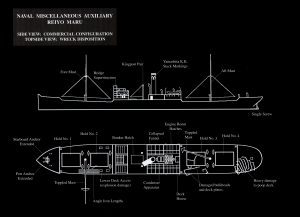

Some really nice gauges in the engineroom. Not much in the holds that I saw but the viz is normally good on this wreck so swimming along the large holds is amazing. A wheel barrow in hold 2 but thats about it! The main points of this dive is the outside, as the holds are empty. Wonderful bow section.
Wreck Name: Fujikawa Maru (5-37m)
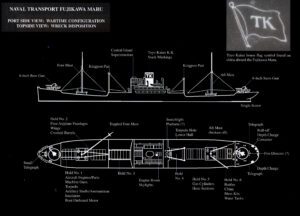

Depth: 15–120ft/5-37m
This 433ft/131m, 6,938-ton Passenger-Cargo Ship was built in 1938 for the Toyo Kaiun Kisen Kaisha headquartered in Tokyo. The word ‘Maru’ designates a merchant vessel. The company had been steamship owners since 1898. It provided cargo and passenger services from the Orient to New York and South China in addition to general tramping in routes to North America, South America and India. In 1940, she was requisitioned by the Japanese Navy for use as an armed aircraft transport or ferry. The Fujikawa Maru was one of 10 merchant ships to be converted for this use and prior to the outbreak of war was based in Indo-China as part of Air Flotilla 22 under the command of the 11th Air Fleet. She was tasked for transportation duty including the delivery of planes and aircraft parts to island bases. She participated in the Midway operation, and also operated in the Aleutians, Rabaul, Tarawa, the Marshall Islands and Yokosuka.
In September 1943, she was nearly sunk heading from Truk to Kwajalein by a torpedo from the USS Permit, but she limped back to Truk Lagoon in three days, and was later repaired and returned to service in January 1944. A torpedo struck the renovated ship during Operation Hailstone Strike 3E-1 at 1420 hours by aircraft from the USS Bunker Hill. Photographs show the ship still afloat the next morning. Dive bombers from the USS Essex scored a direct hit with a 1,000 lb. bomb on the port quarter, and three near misses before the ship was reported to be on fire and smoking. The final attack was by two USS Monterey planes that reported a huge explosion from one or two of their torpedoes launched against the ship. The Fujikawa Maru finally went down early the next morning.
For years, this wreck has been known as the “showcase wreck” and is associated with the best diving attractions. She rests on an even keel with a superstructure depth of 30ft/9m, deck at 60ft/18m and sea bottom at 110/33m. An encrusted prominent bow gun on a raised platform above the forecastle deck can be readily seen. This deck gun was produced by the British manufacturer, Elswick Ordnance Company for the Japanese Navy following the 1895 Sino-Japanese war. The builder’s plaque on the gun is still visible indicating its British manufacturer, serial number (12469) and the date it was made – 1899. The superstructure is readily accessible with pilothouse, baths, staterooms and galley. There are several Zero fighter plane fuselages and many other plane parts (belly tanks, propeller blades, wheels) in the forward holds along with large artillery shells. There is excellent access to the engine room and storage/work areas. Overall, there is an abundance of rich multi-colored corals and schools of reef fish that can be seen by divers.
Wreck Name: IJN Fumitsuki (30-40m)
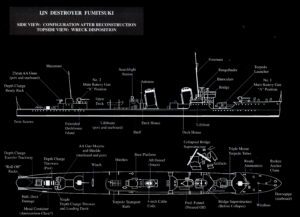

The Fumitsuki was a Mutsuki Class Destroyer built in 1926, 320ft/97m long with a gross tonnage of 1,913 tons normal, and 1,590 tons light after reconstruction. She was driven by 2-shaft Parsons geared turbines and 4 Kampon boilers. She could carry a complement of 150 officers and crew. She was one of only two real Japanese Navy combat ships sunk in Truk Lagoon. She was capable of over 33.5 knots fully loaded, but was under repair at the time of her demise. The name translates as “the 7th month of the moon calendar when rice/flowers ripen.”
The Fumitsuki was one of 12 vessels ordered under the new Reinforcement Program of 1923 as part of the third ‘Minekaze’ group. These new Kamikaze type destroyers were also rated as minesweepers and minelayers. Following the outbreak of war on December 7th 1941, new Fubuki class destroyers would take over the front line duties as Fleet destroyers and the Fumitsuki was retrofitted as a Mutsuki class fast transport destroyer.
Over the next 3 years, the Fumitsuki played a very active role in Japan’s war effort. She participated in the Apparri and Lingayen (Philippines) invasion forces, the Western Java invasion force, the ‘Tokyo Express’ troop evacuations runs from Guadalcanal, the assault on Rendova Island, landings near Torokina in Bougainville, and numerous troop transport roles in support of various Japanese operations. She suffered numerous attacks and damage from aerial attacks in 1942 and 1943, including April 2, 1942 near Kavieng, October 8th 1942 off Buka, and November 2nd 1942 at Rabaul. On January 4th 1944 together with a fellow destroyer, the Fumitsuki shot down 10 enemy planes while receiving only light damage off Rabaul with a loss of 4 men killed and 20 wounded. On February 6th 1944 she arrived in Truk for repairs.
At approximately 1430 hours on February 17th, a USS Enterprise TBF plane piloted by Ensign Jewell dropped four 500-lb bombs on her as she tried to evade. The TBF crew reported 2 direct hits and a probable third hit. The ship was engulfed in flames and began to sink and list to port. She dropped anchors, but went down by the next morning. She rests on an even keel with a slight list to port, with the deck being at 100ft/30m and the sea bottom at 125ft/38m. There is a bow gun near the forecastle, Long Lance torpedo launchers between the forecastle and bridge, and aft gun and winches, cables and depth charge throwers are on the stern. With a beam of just 30ft/9m it’s easy to imagine this sleek fast Japanese attack warship cutting through the ocean.
Wreck Name: Heian Maru (12-34m)
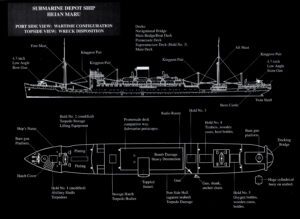

This 510ft/155m, 11,614-ton Passenger-Cargo Ship was built in 1930 at a cost of $15,000,000 by Nippon Yusen Kaisha (NYK), perhaps the greatest and best known of all Japanese companies. The word ‘Maru’ designates a merchant vessel. The Japanese government requisitioned more vessels from the NYK fleet for wartime service than any other shipping organization. The interior decoration was designed in the “old English” style and this theme was carried out in the ship’s lounge, reading room, writing room, and dining salon. Such decoration was considered a major innovation in ships at the time. On her maiden voyage, she set a trans-Pacific speed record on a trip to Seattle. Seattle shippers spread the word through the media that the arrival of the new ship might be regarded as a gesture of friendship from the business interests of Japan. Following this theme of friendship, the ship’s owners opened up the Heian Maru to the public, letting nearly 15,000 people tour the vessel. The crowds were so great that hundreds had to be turned away. She was converted into a Navy submarine tender in 1941, and was an integral part of the 6th Submarine Fleet initially based in Kwajalein, and subsequently stationed at Truk.
On February 17th 1944 the Heian Maru was anchored 500 yards offshore of Dublon with its hull painted a dazzle camouflage design. A dive-bomber from the USS Yorktown hit her near the bow exploding the superstructure into a fiery inferno. Two SB2Cs from the USS Bunker Hill attacked the ship with two 1,000 lb. bombs and one 1,600 lb. bomb, but all three missed. Photos taken mid-day show the ship smoking very heavily with its superstructure enveloped in flame. On the February 18th two torpedo bombers from the USS Bunker Hill scored near misses, but damaged the ship. Later that day, the Heian Maru was hit by Avenger torpedo bombers from the USS Bunker Hill, which caused an explosion and large fires, sinking the ship. Fourteen officers and men were killed, and twenty-eight wounded.
She rests on her port side with the side hull beginning at 40ft/12m and the sea bottom at 120ft/36m. She is one of the largest ships remaining in Truk Lagoon, and has large passageways with an expansive bridge and engine room. The second hold has many torpedo bodies recognizable by the twin propellers together with a winch apparatus, pulleys and chain that were part of the system used to move the torpedoes in and out of the storage space. Along the promenade deck level companionway aft of the bridge superstructure there are a total of nine 50-foot long submarine navigational and attack periscopes lying side by side.
Wreck Name: Hoki Maru (22-51m)
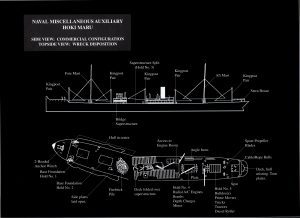

Hoki Maru – Captured NZ cargo ship ‘M/V Hauraki’ sitting upright. Aft holds packed – trucks, bulldozers, tractor, steamroller, depth charges and radial engines. 80-165ft/24-50m
The Hoki Maru was built in 1921 by William Denny and Brothers of Dumbarton, Scotland for the Union Steamship Corporation of New Zealand, Ltd. for trans-Pacific trade, mostly to Australia. Originally christened the M/V Hauraki, she was 450ft/136m long with a gross tonnage of 7,112 tons. The Hoki Maru was driven by twin screws and her engines were of the very latest Diesel eight-cylinder four-stroke type. She could carry a complement of 50 men and 12 passengers. She was the first of her kind to be propelled by power rather than steam. Her oil bunkers held enough fuel to take the vessel halfway around the world. The word ‘Maru’ designates a merchant vessel.
In 1940 she was requisitioned by the British Ministry of War Transport, and continued in her normal company trade service. In July 1942, she was sent out from Sydney to Port Said with primarily a crew of 50 new Zealanders. She was captured by the Japanese armed merchant raiders Hokoku Maru and Aikoku Maru and taken to Singapore where the Japanese decided that her engines were in poor condition owing to poor maintenance. They were unaware of the sabotage efforts by the New Zealand crew who had also thrown overboard all tools, spare parts and blue prints for operating these unique diesel engines. The New Zealand crew ultimately was sent to several POW Camps; 2 of them were later given the OBE for bravery. In January of 1944 following 18 months of engine overhaul, she was recommissioned the Hoki Maru, and classified as a “special” transport. She arrived in Truk on February 15th 1944 and was the only ship sunk at Truk Lagoon that had been captured by the Japanese.
On February 17th 1944 she was repeatedly attacked by USS Essex and USS Yorktown bombers and torpedoed by planes from USS Bunker Hill. She burned and sank before the next day’s attack. She rests on an even keel east of Eten Island with a slight list to port. Her superstructure lies at 80ft/22m, deck at 120ft/36m, and sea bottom at 165ft/50m. The holds contain many types of cargo, bombs, ammunition, and vehicles, including a Diesel roller, 4 Isuzu Type 94 trucks, 2 tractors (one similar to a John Deere, the other is a Komatsu), 2 small bulldozers and a prime mover. The midship was devastated by bomb damage, and the foreship opened up by gasoline explosions. Due to the wide variety of cargo and equipment, she provides an excellent diving experience.
Wreck Name: Kensho Maru (12-40m)
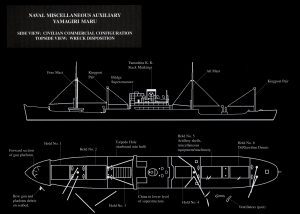


Intercepted radio messages indicated that the Kensho Maru was present at Truk in December of 1943, at Kwajalein in late December of 1944, at Roi in January of 1944 prior to arriving in Truk on January 6th 1944. The captured diary of a Japanese on Kwajalein stated that in the fourth attack on December 24th 1943, 20 heavy bombers appeared over Kwajalein with one bomb hitting the Kensho Maru setting it afire. To avoid having her sunk, she was run aground and the fire was put out after three hours.
On February 17th 1944 the Kensho Maru was at anchor north of Fefan and west of Dublon Islands undergoing repairs next to the repair ship Akashi. The ships were attacked by planes from the USS Yorktown and the Kensho Maru may have been hit by a 1,000-lb bomb on her stern. Shortly thereafter, planes from the USS Essex scored a direct hit on her with a 1,000-lb. bomb amidships, leaving her afire. On February 18th 1944, aircraft from the USS Enterprise, USS Monterey and USS Bunker Hill attacked the Kensho Maru with planes from the USS Bunker Hill reporting hitting her with a torpedo causing heavy damage. The Kensho Maru also may well have been the ship on which one pilot dropped his partially full belly tank causing a large fire amidships. However, none of the aircraft reported seeing her sink before they left the area. On March 6th 1944 a fragmentary radio message was intercepted from Palau to Hiroshima indicating that the Kensho Maru was one of the many ships sunk at Truk Lagoon during Operation Hailstone.
She rests upright on an even keel with a 20-degree list to the port. The superstructure is at 60ft/18m, the deck at 80ft/24m, and the sea bottom at 105-130ft/32-40m feet. She has a well-preserved pilothouse, cabins and galley, and a readily accessible engine room. The engine room is one of the best to explore of all the wrecks in Truk Lagoon. Two anchor chains extend from each side of the bow. Because of its relatively shallow depth the Kensho Maru is one of the most popular for divers since it allows both good exterior and interior exploration and sightseeing.
Wreck Name: Kiyosumi Maru (12-33m)
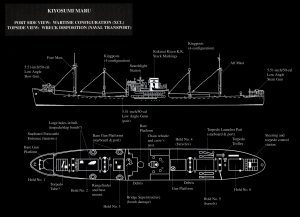

Following her requisition for war-time use by the Japanese Navy in August of 1941, she was converted into an armed auxiliary cruiser with four low-angle deck guns, several light anti-aircraft guns and two pairs of twin-mount torpedo launchers. The Kiyosumi Maru was to have a distinguished wartime career serving as: (1) a coordinator for German and Italian merchant cruiser raiding operations in the Java-Indian Ocean; (2) in the Japanese offensive to take Midway Island; (3) in Solomon Islands operations one time carrying as many as 2,931 infantrymen, 119 soldiers of a mountain gun battery, 153 soldiers of a engineering battalion, and 78 communication officers; and (4) numerous troop carrying responsibilities to China, Palau, Singapore and Rabaul. On November 4th 1943 she was bombed and strafed by 19 Liberators while enroute from Truk to Rabaul. On January 2nd 1944 the USS Submarine Balao attacked the Kiyosumi Maru with a half dozen torpedoes, three of which hit her, but she didn’t go down. A sister cruiser, the Oyodo Maru, towed her to Truk Lagoon with 71 injured crewmen, where she was being repaired at the time of Operation Hailstone. Douglas dive-bombers from the USS Yorktown scored a direct hit on the bow by the no. 2 hold SE of Fefan Island. SBDs from the USS Enterprise scored two direct hits both sides of her bridge. Planes from the USS Yorktown made the final attacks against the ship. 43 of her complement of 62 crewmen died in the attacks.
Following the air attacks she took on water with a list to the port, and ultimately sank resting evenly on her port side in 120ft/36m of water approximately 600 yards from Fefan Island. The bow rests at 70ft/21m, the deck starts at 40ft/12m with the sea bottom ranging between 100-120ft/30-36m. The super structure has several staterooms, baths and a large galley; there are shells packed inside metal boxes and remains of a bicycle to be found inside the holds.
Wreck Name: Momokawa Maru (27-40m)


The Momokawa Maru was a 354ft/107m, 3,829-ton passenger cargo ship built in 1941 by Kawasaki Dockyard Co. Ltd., Kobe, for the ‘K Line’ shipping company. They provided cargo services from Japan to European ports via the Suez canal, and to the US via the Panama canal.
In 1943 the Momokawa Maru was requisitioned by the Japanese Navy to serve as a Navy auxiliary, with ties to the Yokosuka Transportation Section. During 1943 she transported cargoes of concrete, fuel drums, bunker coal, aviation fuel drums, sampans and landing barges between Japan and Micronesia.
On February 17th 1944, the Momokawa Maru was anchored at the northern end of the 4th fleet anchorage. She sustained light damage from plane attacks (Bunker Hill, Yorktown and Essex). The following day Bunker Hill SB2Cs attacked a cargo ship ¼ mile off the SE tip of Doublon. The 1000lb bomb hit amidships causing a huge fire and explosion, leaving only the tip above water by the time the planes retired. Japanese reports describe the ship burning for a long time before finally sinking. Only one crewman was listed as killed.
The Momokawa Maru lies on her port side in 130-150ft/40-45m of water only ½ mile from Tonoas (Doublon). Inside the forward holds you can find fuel drums, aircraft parts such as radial engines, wings, propeller blades, wing/belly fuel tanks as well as a disassembled entire plane! At least 3 trucks can be found in the second hold, with more trucks and plane parts in hold No 3.
The telegraph, speaker tubes and rudder stand can still be found in the bridge. Very colourful. The aft holds are mostly empty, and up on the poop deck there’s a 75mm field gun. The engineroom is spectacular. Very nice set of pressure gauges and walkways making this area very photogenic.
Wreck Name: Nippo Maru (18-48m)
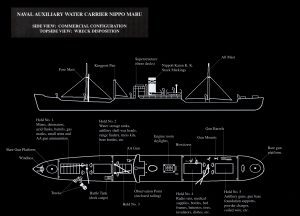

354′ (107m), 3,764-ton Passenger-Cargo Ship was launched in Kobe, Japan in 1936. In 1941 Nippo Maru was requisitioned by the Japanese Navy for transport. On February 17, 1944 she was at anchor, carrying water, firewood, troop armaments, a battle tank and a truck to various Pacific Islands. She was set ablaze and sunk by a trio of 500-pound bombs from TBF Avengers from the Carrier Essex.
The Nippo Maru was modern 5-hold Passenger-Cargo ship built in Kobe, Japan in 1936 for Okazaki Honten Steamship Co. Ltd. She was 354-foot long with a 3,764-ton cargo carrying capacity. All ships associated with this company were given names that began with the letter ‘N’.
In 1941 the Nippo Maru was requisitioned by the Japanese Navy as an auxiliary transport under the jurisdiction of the Sasebo Naval District. She was fitted out to carry water container tanks with a general mission to supply water, ordnance and ammunition to naval forces in the Mandated Islands. In 1942 she was associated with the 6th Base Force at Jaluit, and made repeated trips between the islands of Jaluit, Ponape, Kusiae, Saipan and Kwajalein. On December 7th 1943 she left Kusiae for Ponape carrying Army troops of the 52nd Division. She arrived at Truk Lagoon on February 10th 1944.
On February 17th 1944, the Nippo Maru was at anchor at the northern extreme of the 4th Fleet anchorage east of Dublon Island. During the first strike of Operation Hailstorm, she was attacked by TBF Avengers from the USS Essex that scored three hits in the mid and aftship areas causing heavy damage and starting fires. She went under within 2 hours of that attack.
She rests on an even keel with a 20-30 degree list to port with the superstructure at 90ft/27m feet, the deck at 120ft/36m feet and the sea bottom at 155ft/47m. This one of the most exciting wrecks in Truk Lagoon, and it is often visited. There are 3 anti-tank Howitzer guns on the starboard deck, a battle tank sits on the port main deck by Hold No 2 and the last hold has a full battery of 5-inch guns. There are very picturesque helm and engine telegraphs providing excellent photo opportunities. There is also a fallen anti aircraft gun on the main deck, and the remains of a truck hanging partly overboard forward with another lying on the bottom underneath. The Nippo Maru has such an interesting cargo of war materials (shells, detonators, rifle ammunition), equipment (water tanks, gas masks, mess kits, shoes), and other artifacts (beer bottles) that it has become one of the most popular wrecks in Truk Lagoon.
Wreck Name: Rio De Janeiro Maru (10-33m)
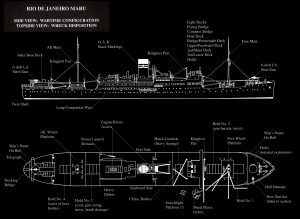

When built in 1930, the Rio de Janeiro Maru was constructed as an eight-deck passenger liner for one of the largest Japanese shipping companies, the Osaka Shosen Kabushiki Kaisha (O.S.K. Line). Widely known internationally since its founding in 1884, the company provided passenger and cargo service throughout the world. At the outbreak of World War II, the O.S.K. Line operated a fleet of 20 motor driven passenger ships.
In preparation for the war, the Japanese Navy requisitioned the ship in 1940 and converted her to a submarine depot ship (sub-tender). At war’s outbreak on December 7th 1941, the Rio de Janeiro Maru was posted to Submarine Squadron 5 of the 1st Battle Fleet, Southern Force based in Hiroshima Bay, Japan. The ship was active in the role of a sub-tender in the Southwest Area of operations until September 1943 when she was returned to the Empire and re-converted into a transport ship.
On July 27th 1942 it was reported that she was attacked by a submarine while enroute to Cam Ranh Bay, Vietnam and reportedly on fire and in danger of sinking. The U.S.S. Spearfish reported that the ship had been hit by two of its four torpedoes launched during a nighttime periscope attack. However, the Rio de Janeiro Maru was able to remain underway, and complete repairs in Hong Kong. Between January 13th and February 17th 1944, she was primarily engaged in the transportation of ordinary military supplies, material and personnel. On February 17th while at the Truk Atoll, she was bombed during Operation Hailstone and sunk at approximately midnight on February 18th. The attack by U.S.S. Yorktown SBDs and U.S.S. Bunker Hill SB2Cs scored direct hits with one or two 1,000 lb. bombs at 1200 hours on the first day of the air strike.
She rests 450 yards from the shore on the east side of Uman Island on her starboard side with the superstructure between 40-80ft/12-24m, and the sea bed at 110ft/33m. There are excellent exterior exploration opportunities with a large stern gun, large propellers, kingposts, long companionways and several explosion holes extending outward indicating internal explosions at the bow. Inside the wreck divers can explore the engine room and holds where they can find crates of beer bottles, gun barrels and 15ft/5m machined wheel turrets.
Wreck Name: Shinkoku Maru (12-40m)
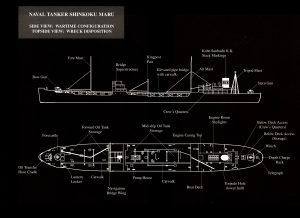

The Shinkoku Maru arrived at Truk on February 14th 1944 just 3 days prior to the carrier air strikes of Operation Hailstone. On February 17th 1944 while anchored northwest of Fefan Island she received a direct bomb hit amidships by a Dauntless dive-bomber from the USS Yorktown that opened a huge hole into her engine room. Later that day planes from the USS Bunker Hill attacked her with six torpedoes, but they all missed. The next morning Grumman Avengers torpedoed her from an unknown air attack group, and she sunk later that afternoon.
She sank upright and rests on an even keel with a superstructure depth of 40ft/12m, deck at 70ft/20m and sea bottom at 125-130ft/38-40m. The Shinkoku Maru is one of the “must dive” wrecks at Truk Lagoon primarily for its luxurious corals, anemones, gorgonian fan corals, sponges, and halos of juvenile fish. It is a spectacular living artificial reef – ideal for exploration and a perfect candidate for multiple dives as well as night dives. Bow gun and all exposed structures have excellent coral growth, together with large schools of small reef fish. The ship has many interesting features, including a photogenic bridge with 3 telegraphs; the superstructure has good bathrooms and a medical table and the engine room is also well worth a visit.
Wreck Name: Unkai Maru (24-40m)
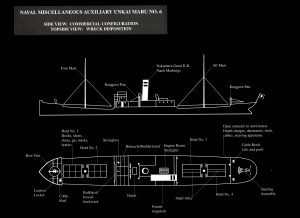

This relatively old coal fired steam ship was requisitioned by the Japanese Navy late in the war, on January 5th 1944, and she was sent from Tokyo to Yokosuka and then onto Truk, arriving there on 30th January 1944.
The Unkai Maru was attacked on the first day of Operation Hailstone initially by planes from USS Essex. After being hit on the port side and port quarter she was seen to be listing to starboard. Later that day she was attacked by planes from USS Bunker Hill and USS Yorktown. A 1000lb bomb from a Yorktown plane hit amidships causing a large fire to breakout. This fire was still burning the next morning when planes from the Essex scored hits around the bow, lifting it out of the water. Still afloat when the planes left, Japanese reports indicate she sank shortly afterwards. Three crewmen died during these attacks.
The Unkai Maru is the oldest ship in Truk Lagoon and she rests upright on an even keel close to the N tip of Uman Island at 130ft/40m. The deck is at 100ft/30m while the superstructure comes up to 80ft/25m. The 3 inch bow gun still has the builder’s plate, and there are many lantern pieces scattered around the foredeck. The holds are empty, except for Hold 1, which contains many personal items including boots, drinking flasks, bottles, gas masks and china (with the 5 point star of the Japanese Infantry).
The bridge area was destroyed by raging fires; the funnel is fallen and lies on the deck. The engine room has a steering engine located aft; with chains and rods that connect along the aft deck to an old type steering mechanism up on the poop deck, and there are depth charges at the stern.
Wreck Name: Yamigiri Maru (12-33m)



While en route to Palau in August 1943, the Yamagiri Maru was located by the submarine USS Drum, which fired two torpedoes. The ship was heavily damaged and was taken to Rabaul, New Guinea for repairs. Since Rabaul was under almost daily attack by Allied bombers, she sailed or was taken under tow to Truk for repairs. She would remain under repair for two months until Operation Hailstone.
On February 17th 1944 planes from the USS Yorktown west of Dublon apparently damaged the Yamagiri Maru with aerial reconnaissance showing her with her stern lying low in the water. She reportedly suffered two close misses and one direct hit. The next day she was struck by one 1,000-lb and one 500-lb bomb from an altitude of 500 feet by Curtis Helldivers from the USS Bunker Hill, resulting in a huge explosion and a large fire with black smoke rising up to 4,000-5,000 feet. The spreading fires probably caused secondary explosions, and she sank rapidly. Twelve of her crew perished.
She rests on her port side with the side of the wreck at 40ft/12m and the sea bottom at 110ft/33m approximately one mile from shore NNW of Fefan Island. The superstructure and pilothouse are accessible and interesting with a very large engine room. The main attraction of the Yamagiri Maru is the large artillery shells found in Hold No. 5. These 3 ½ feet long, 14-inch diameter projectiles were being carried as replacement ammunition of the main-armament guns of battleships. There are also air compressors, loading equipment for the she;;s and construction equipment located at the bottom of this hold, and the engine room is well worth a visit

